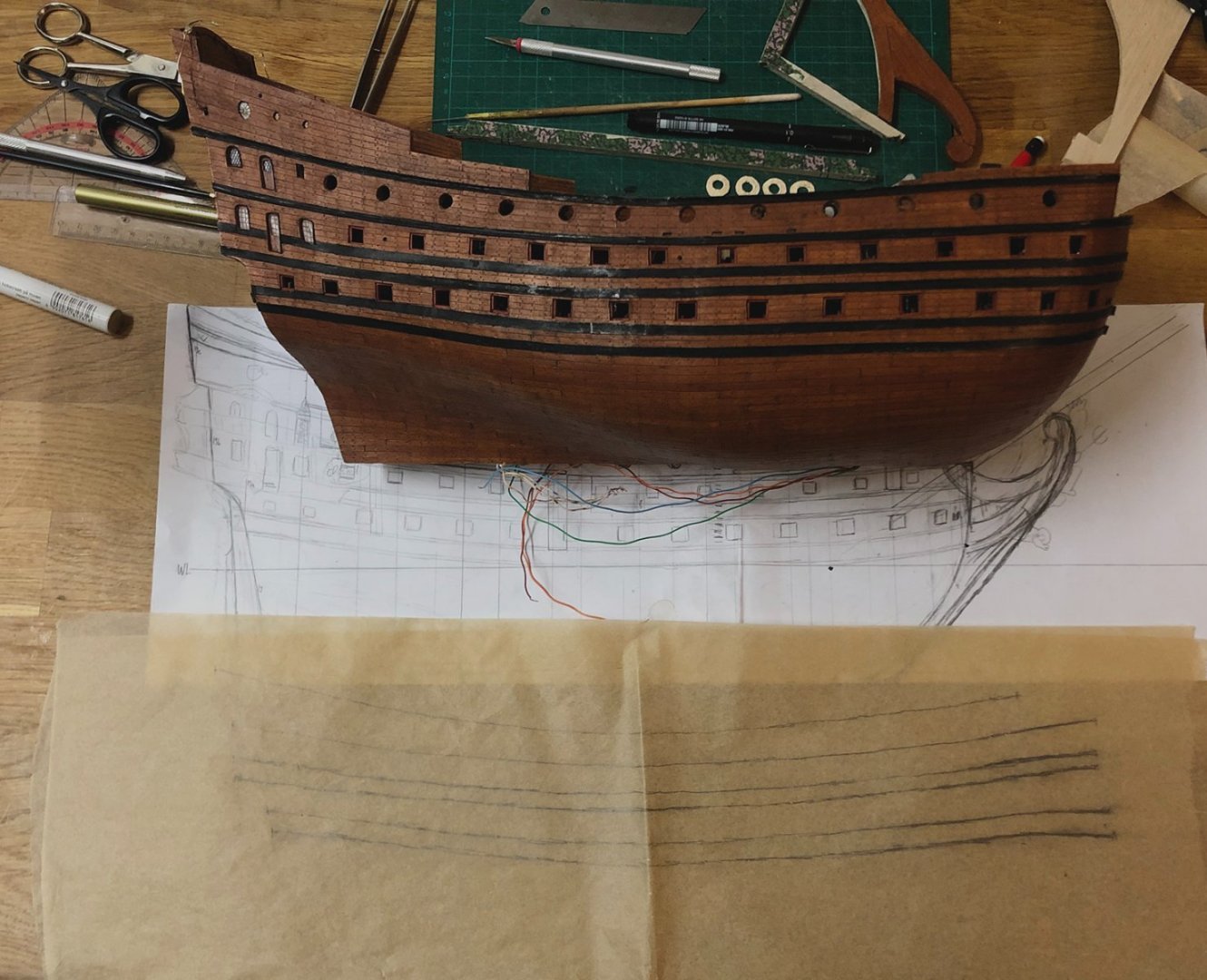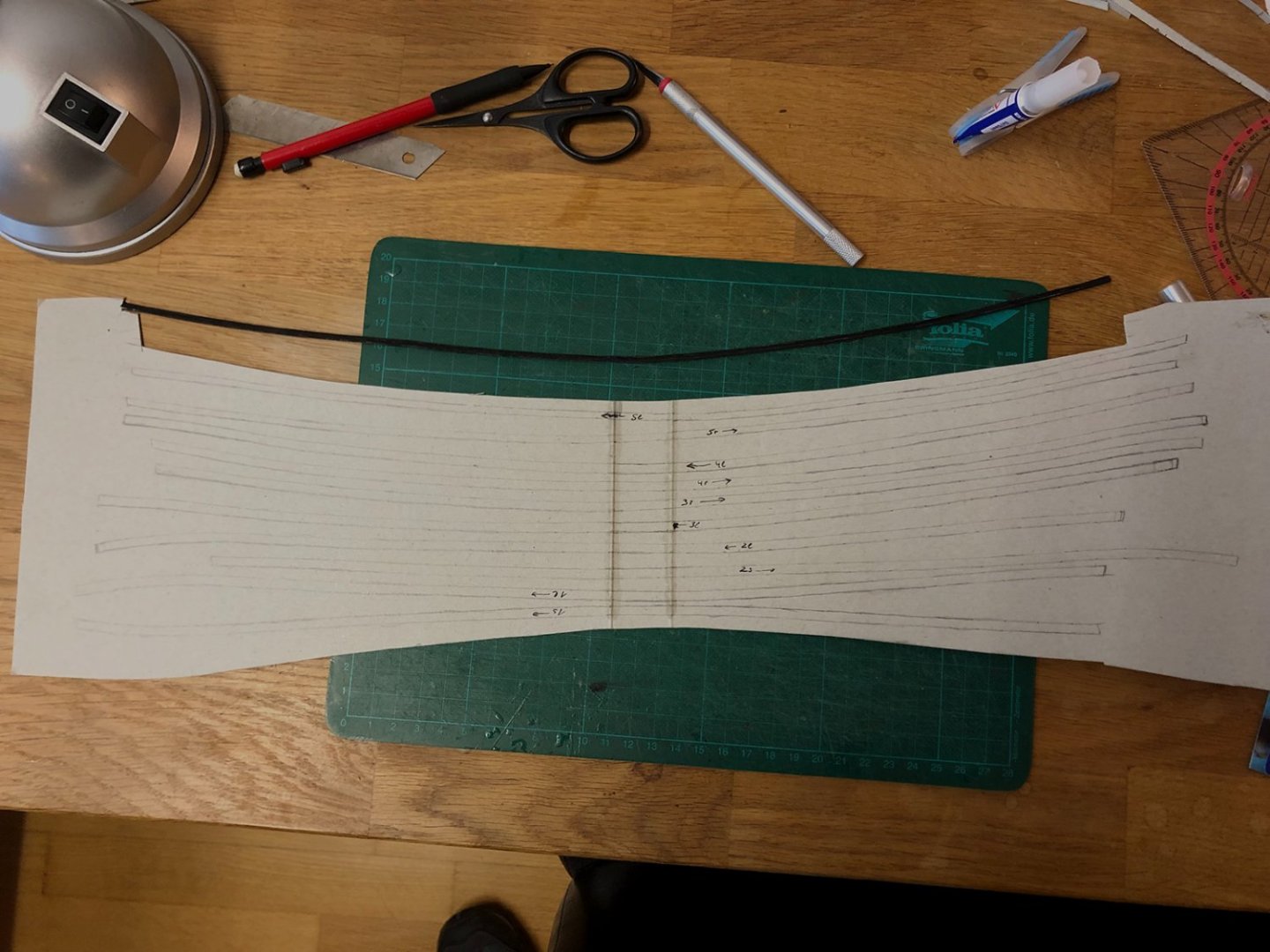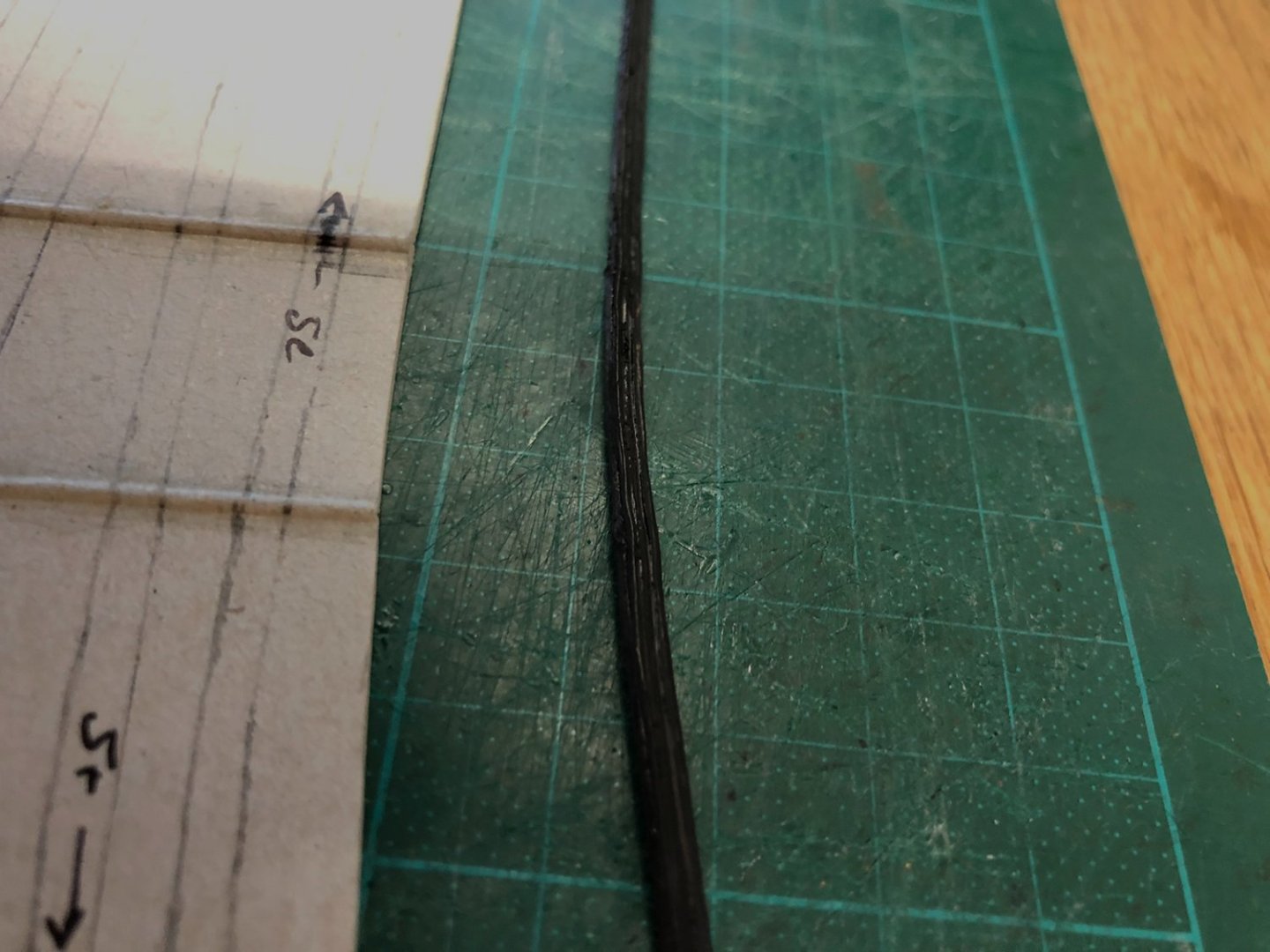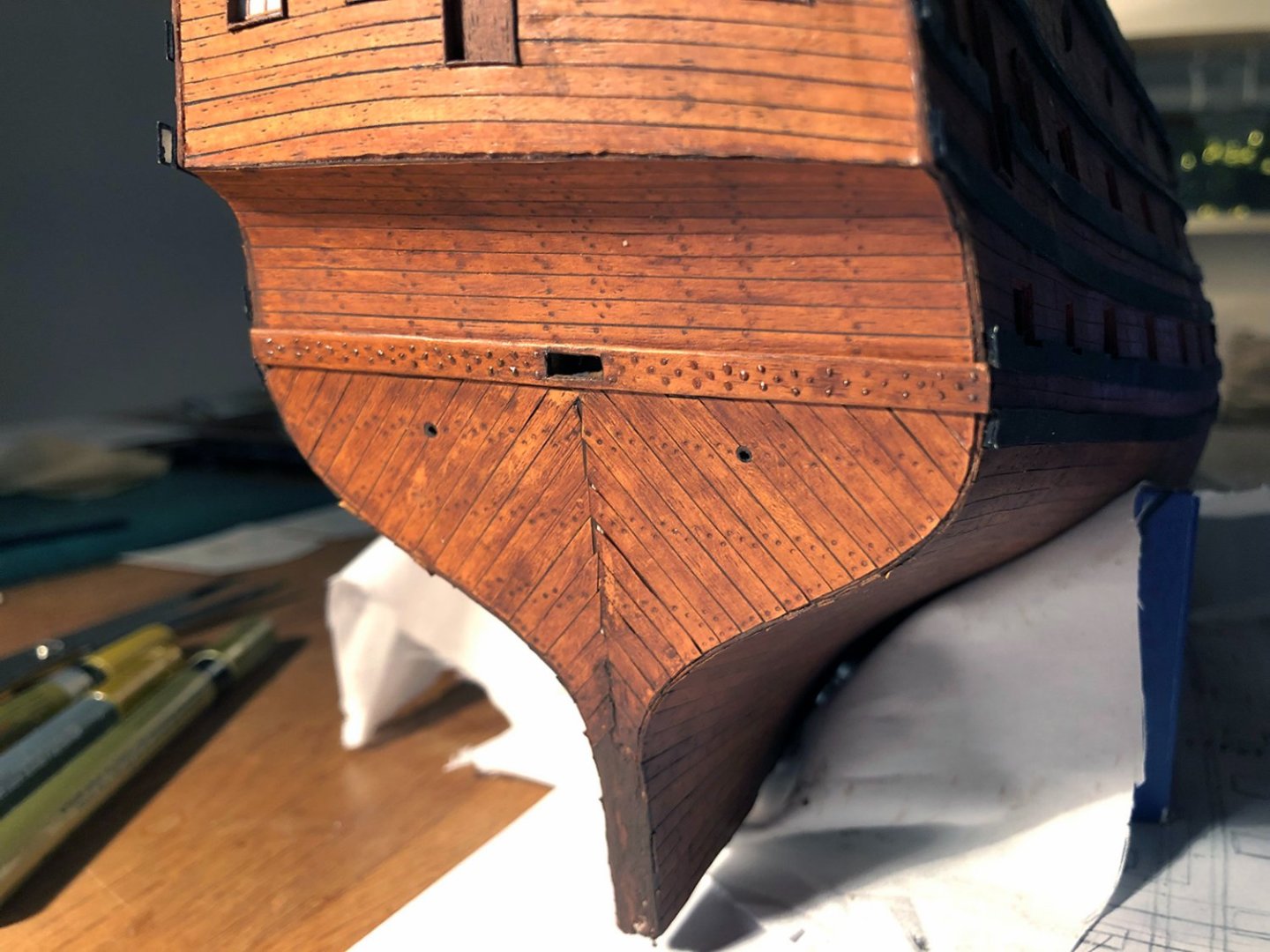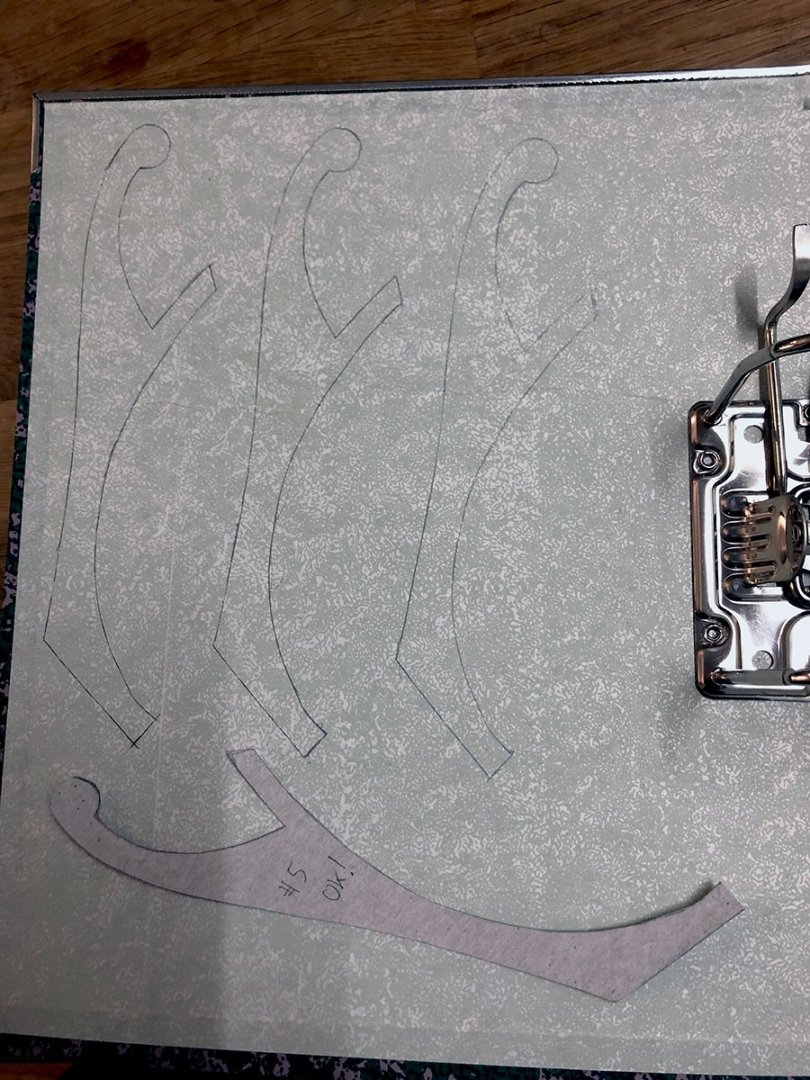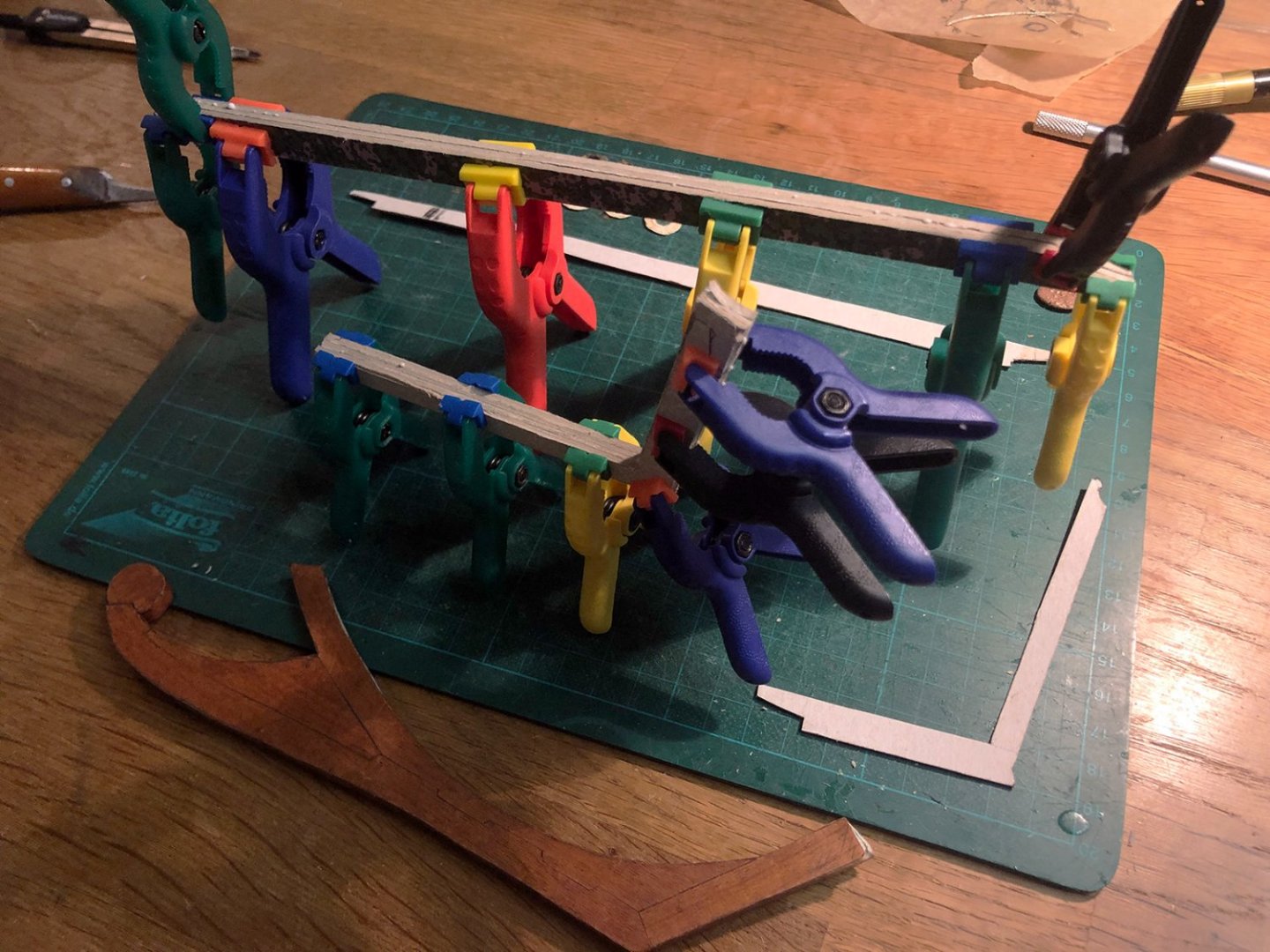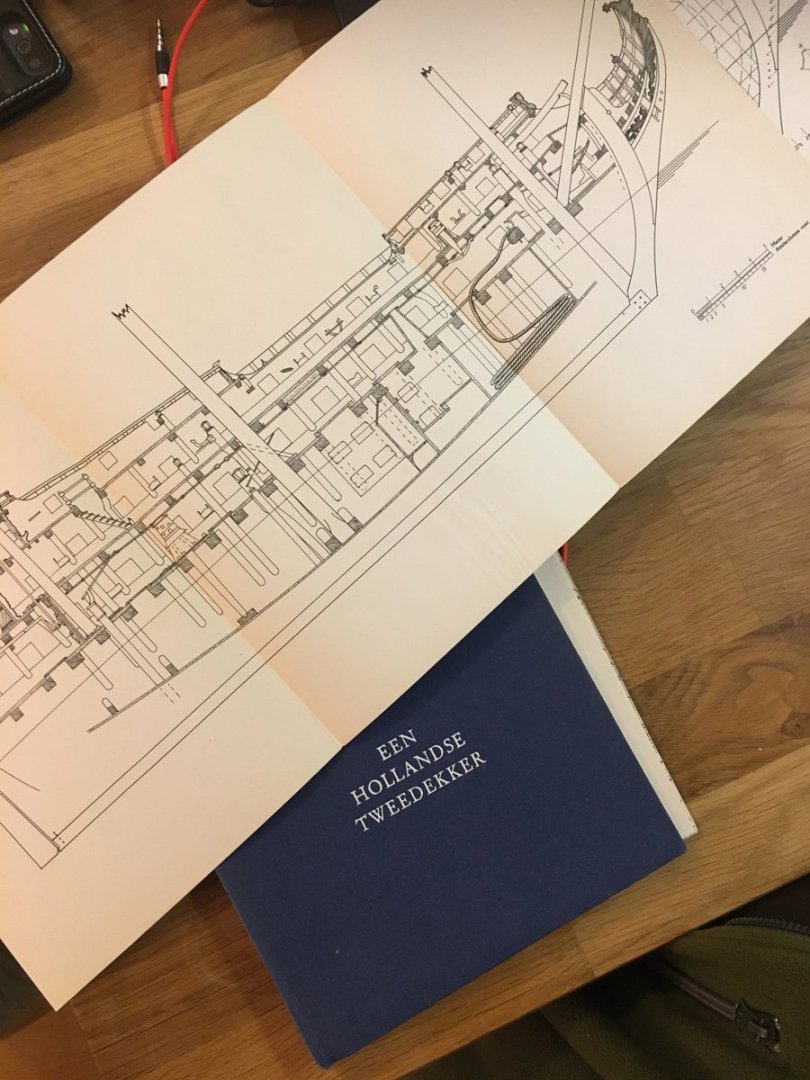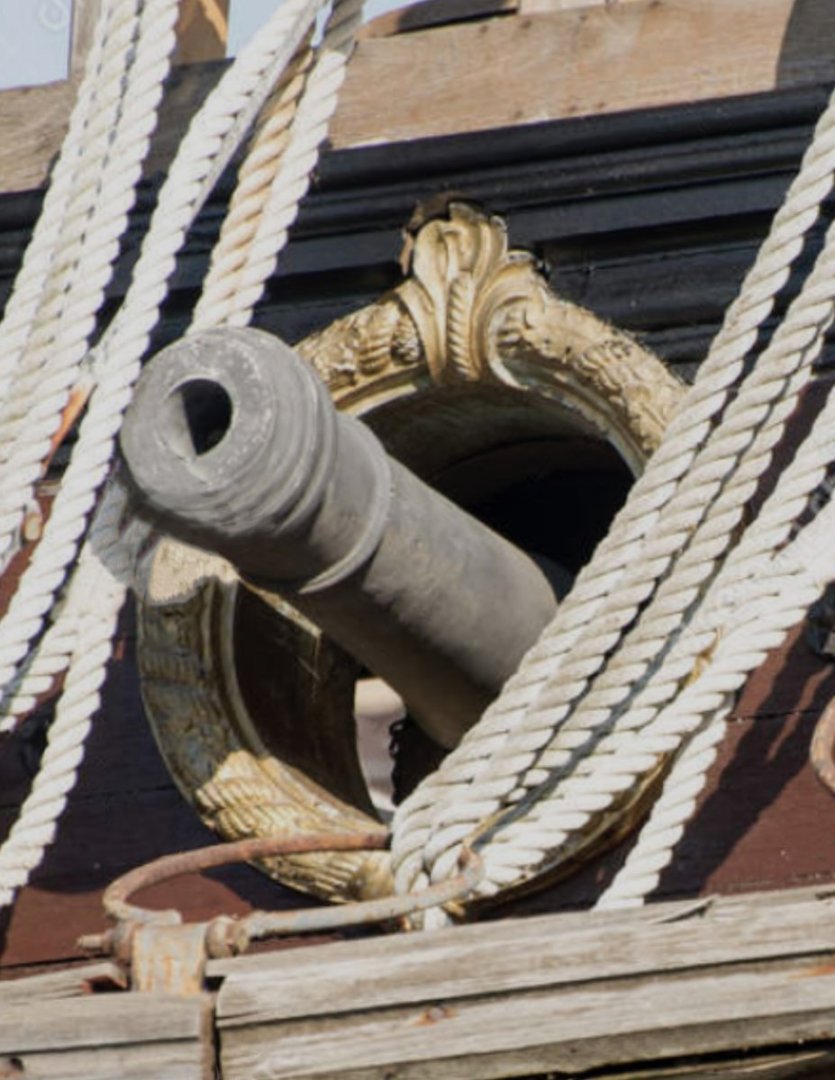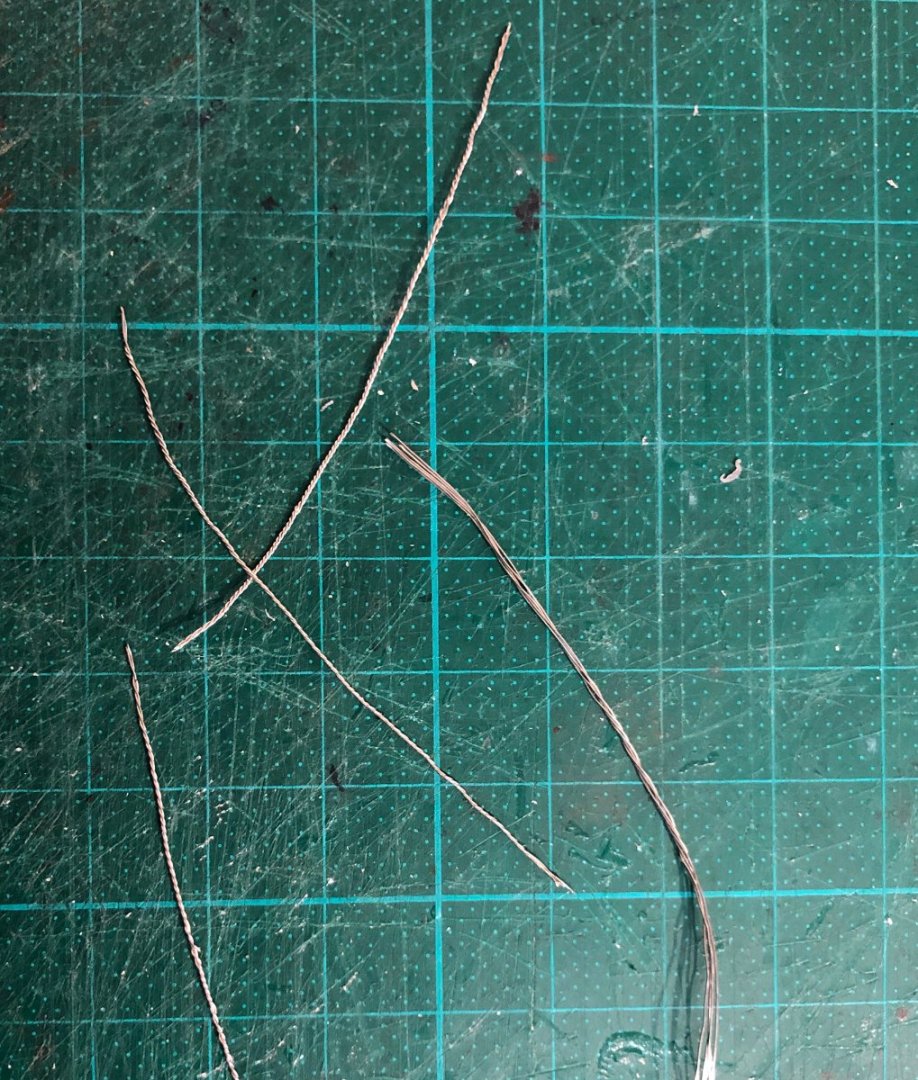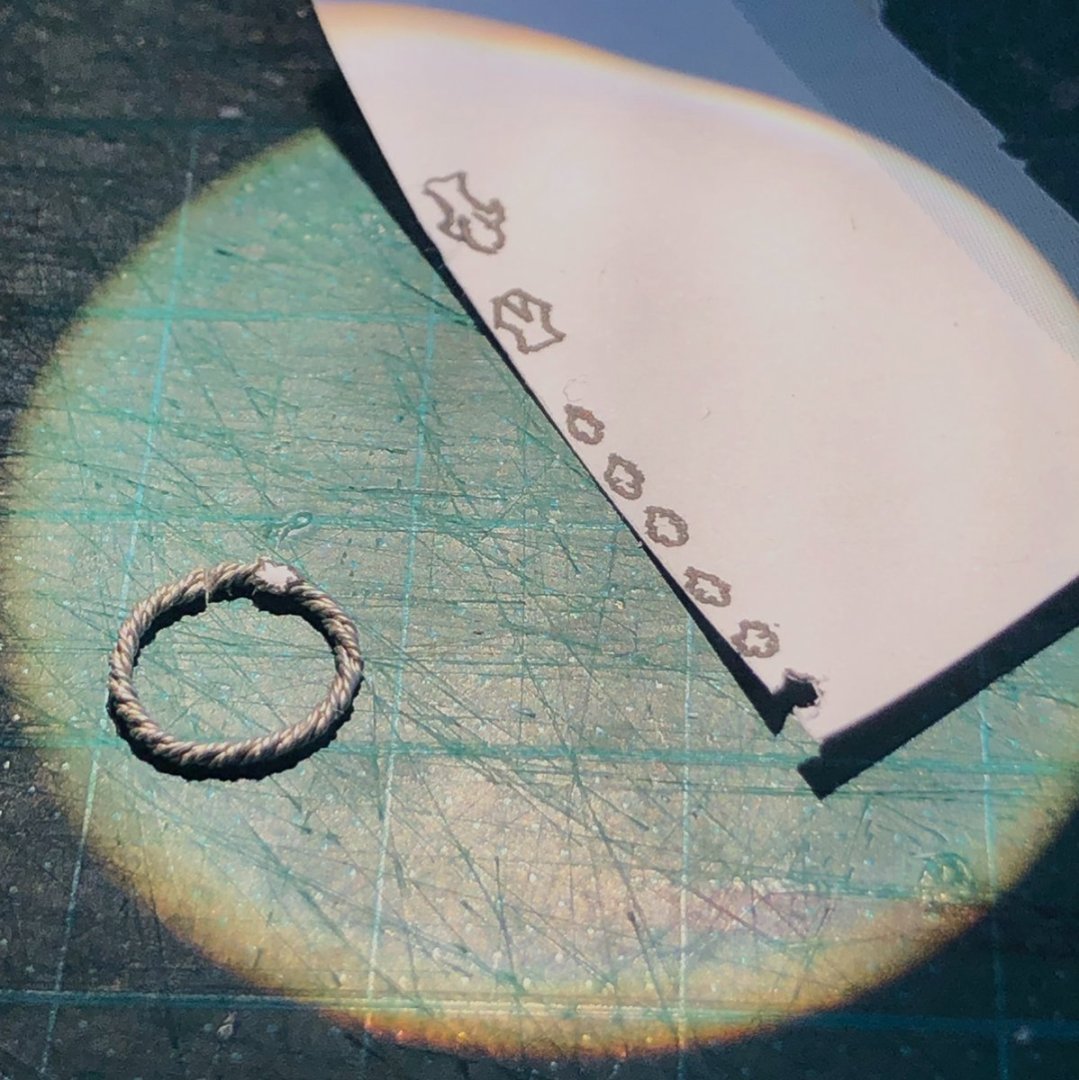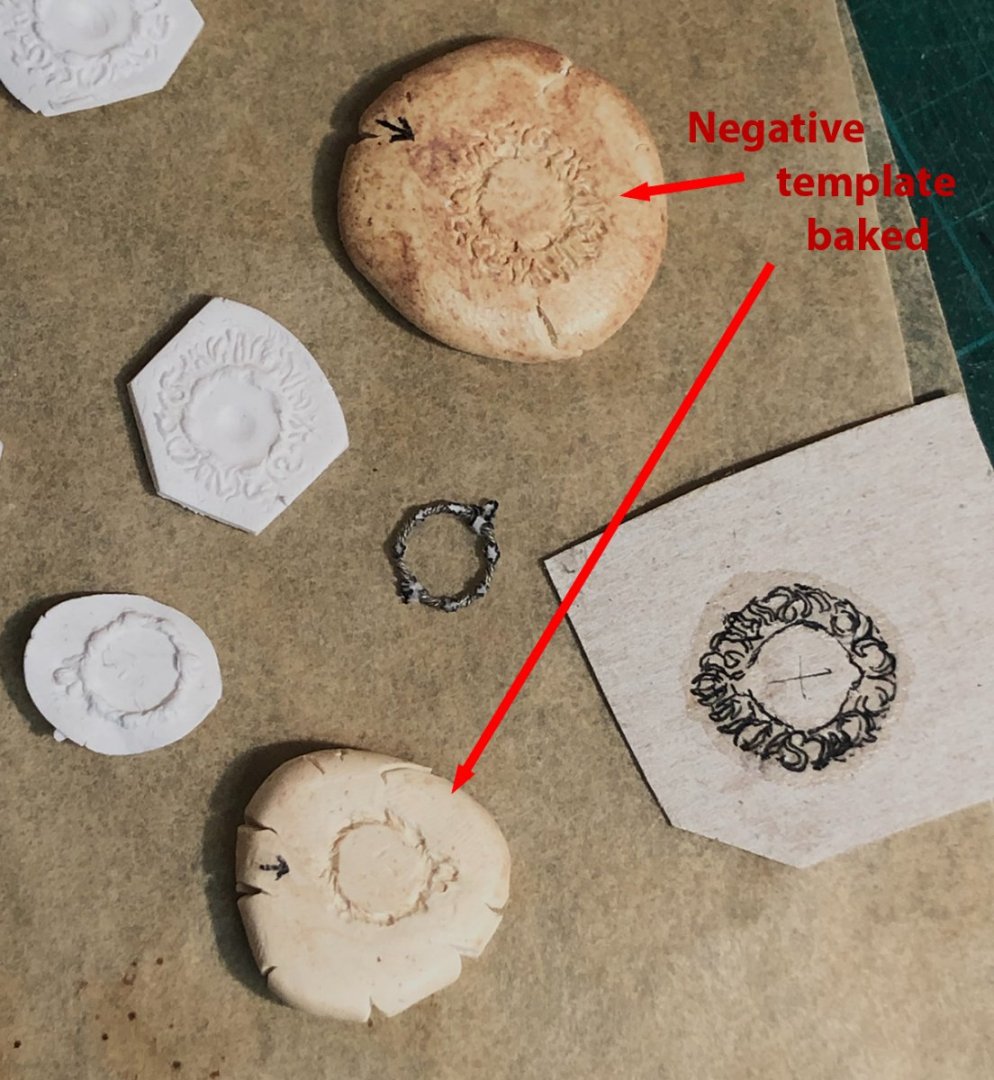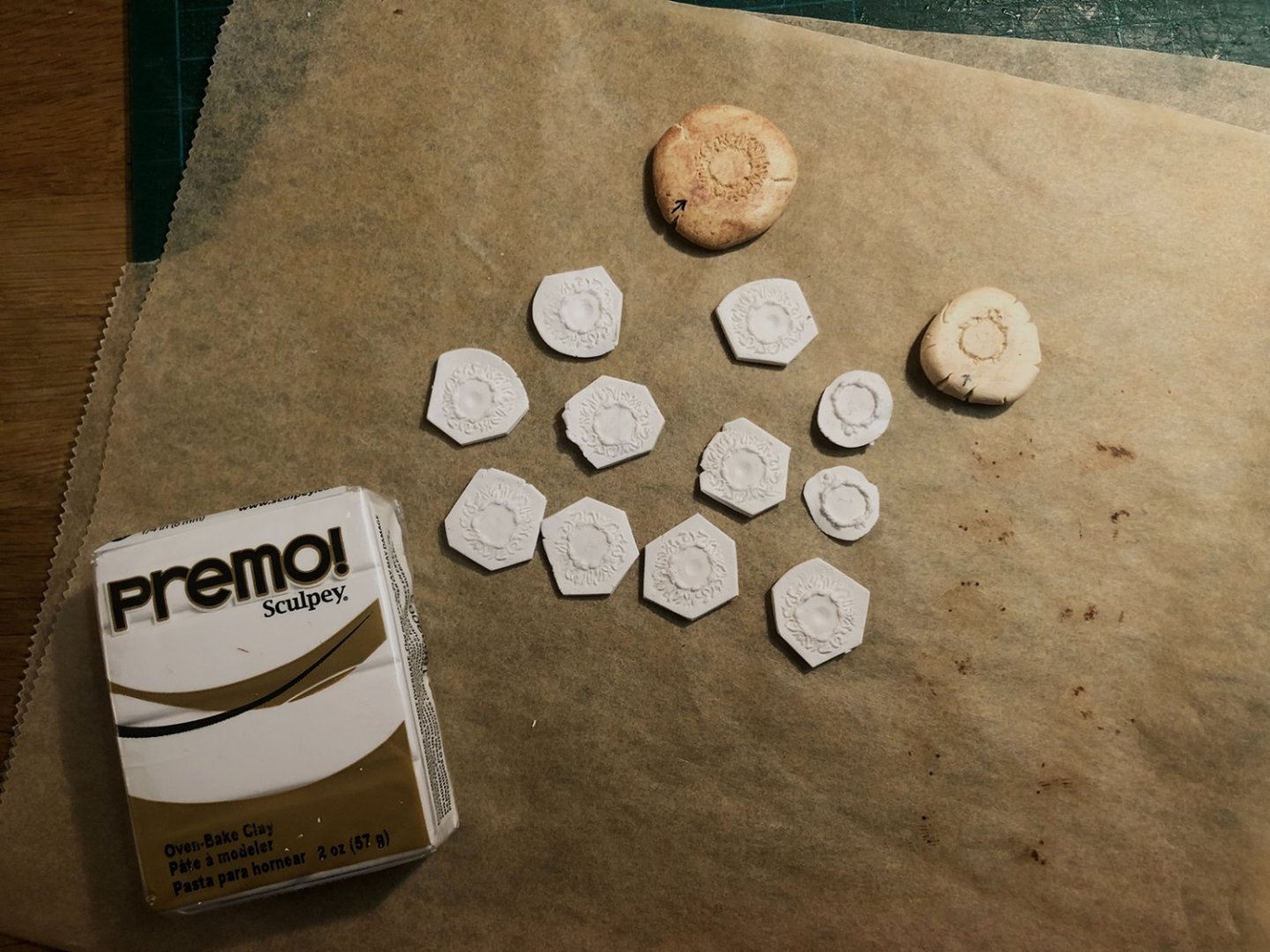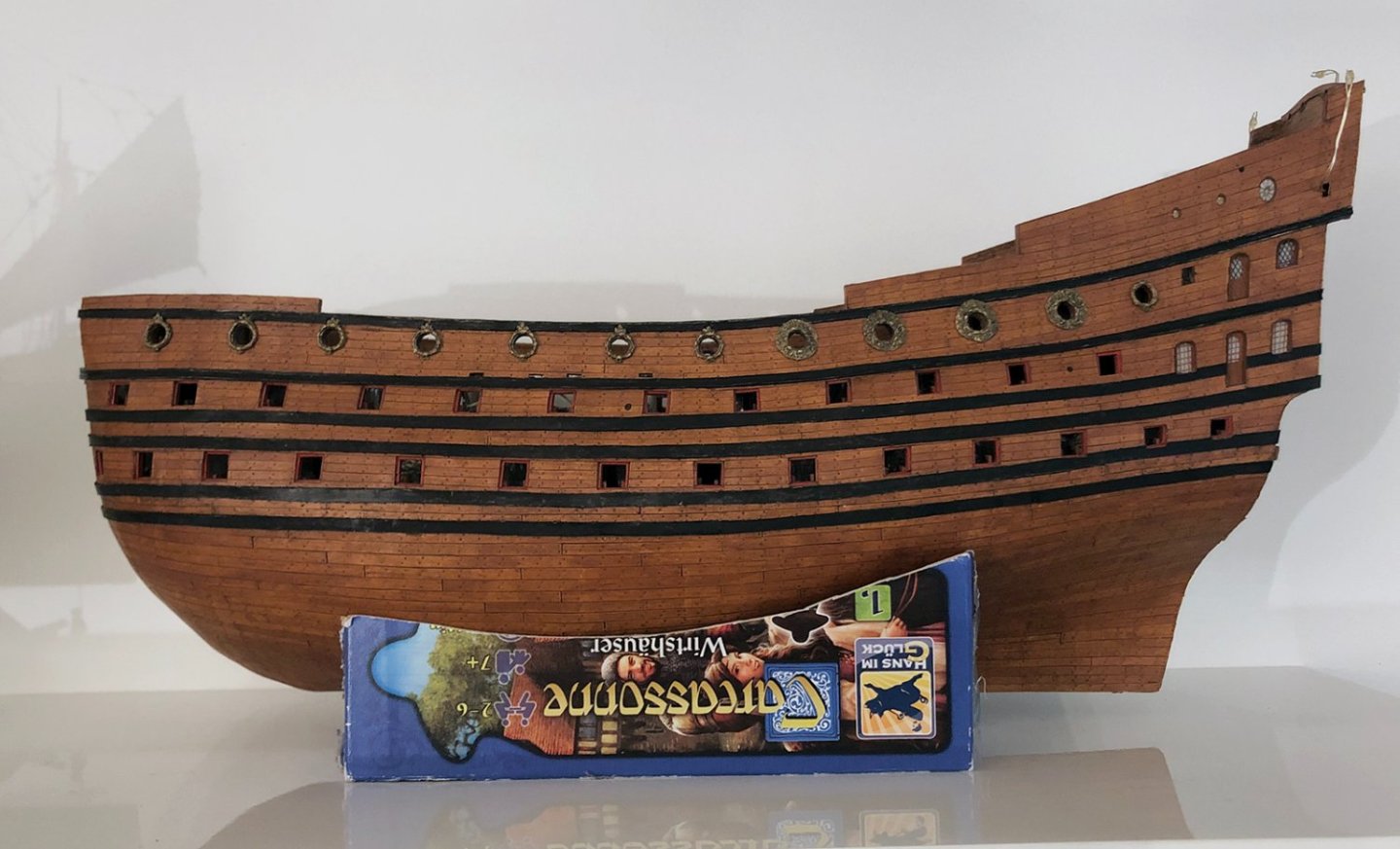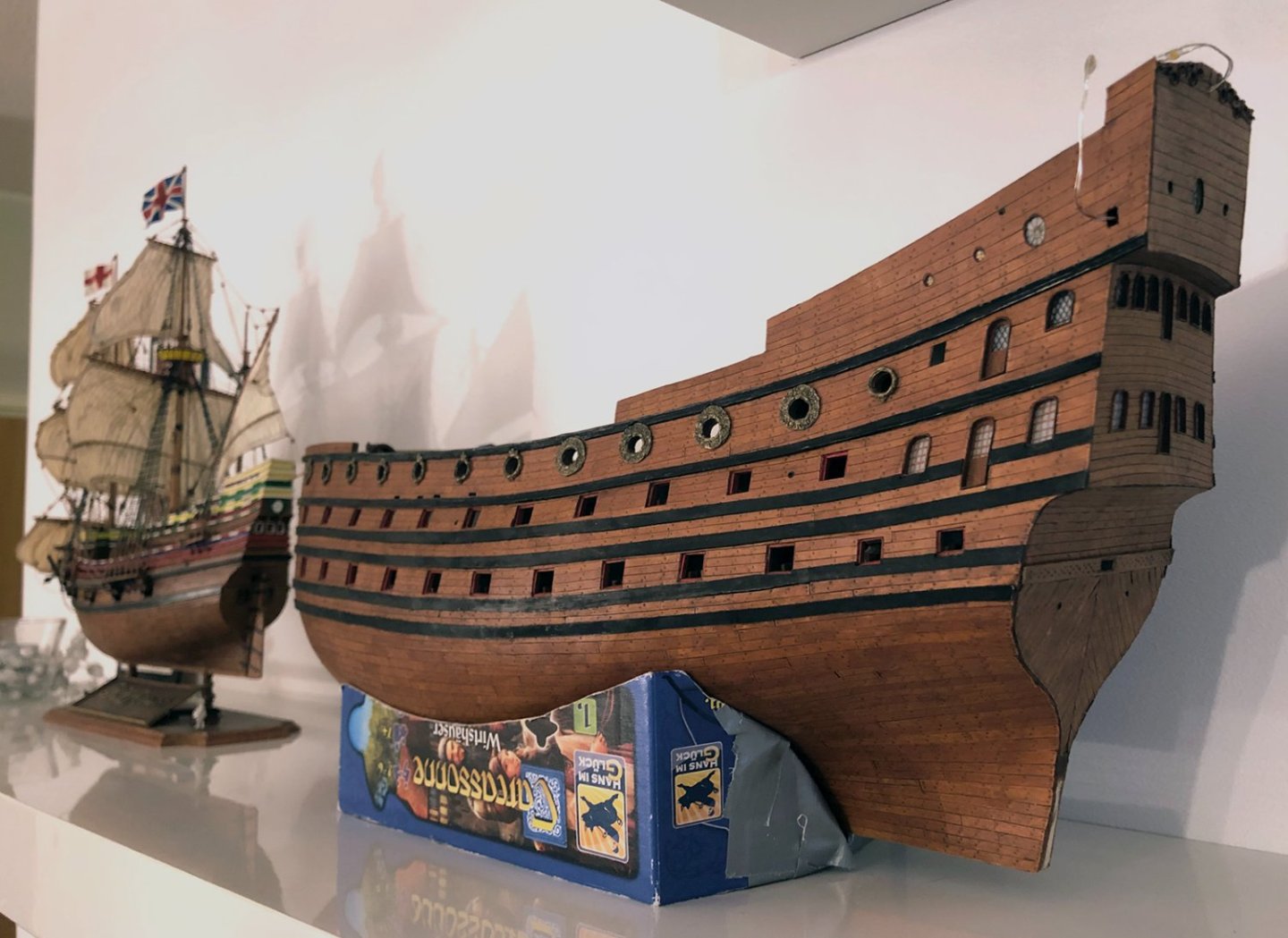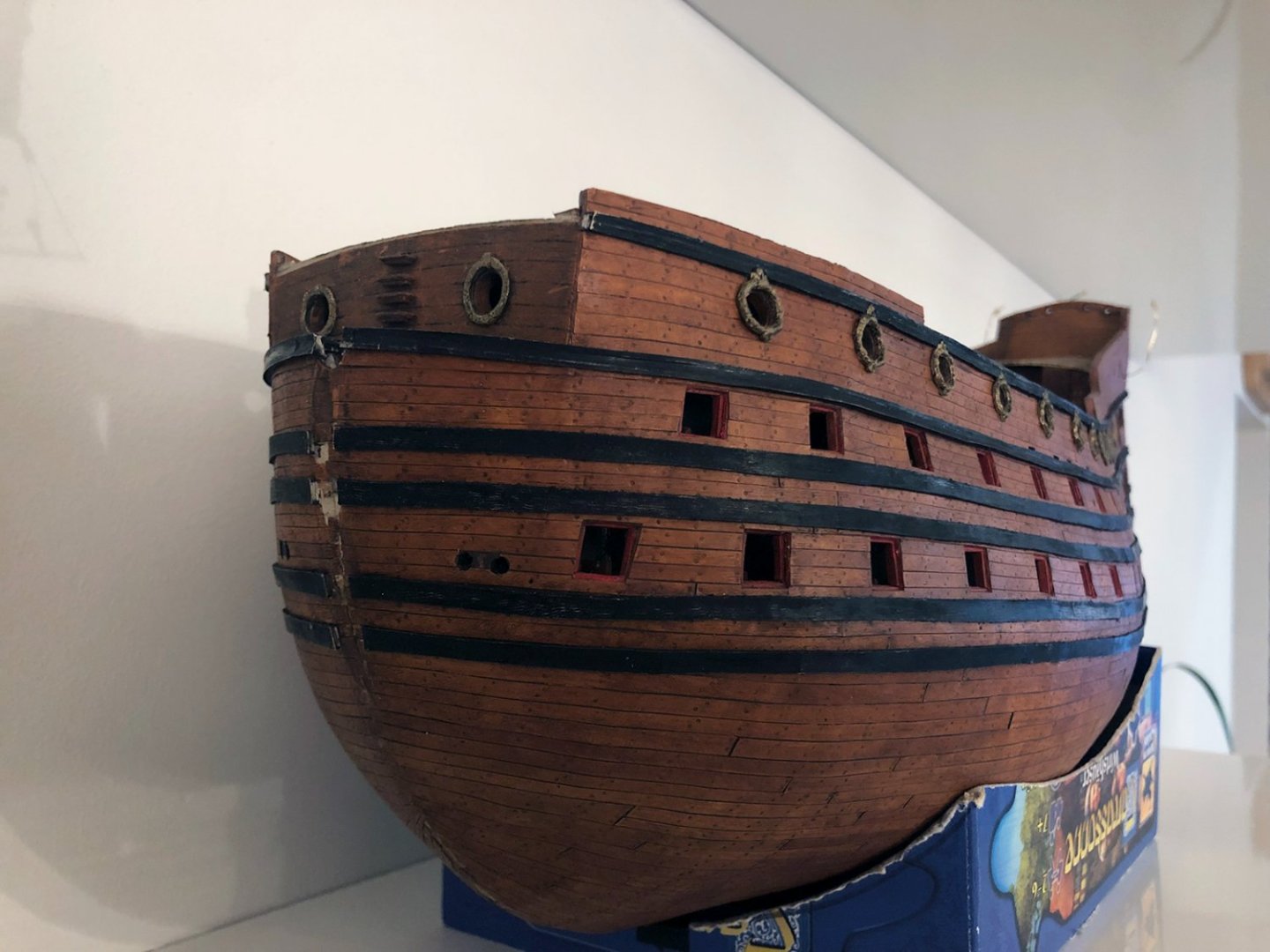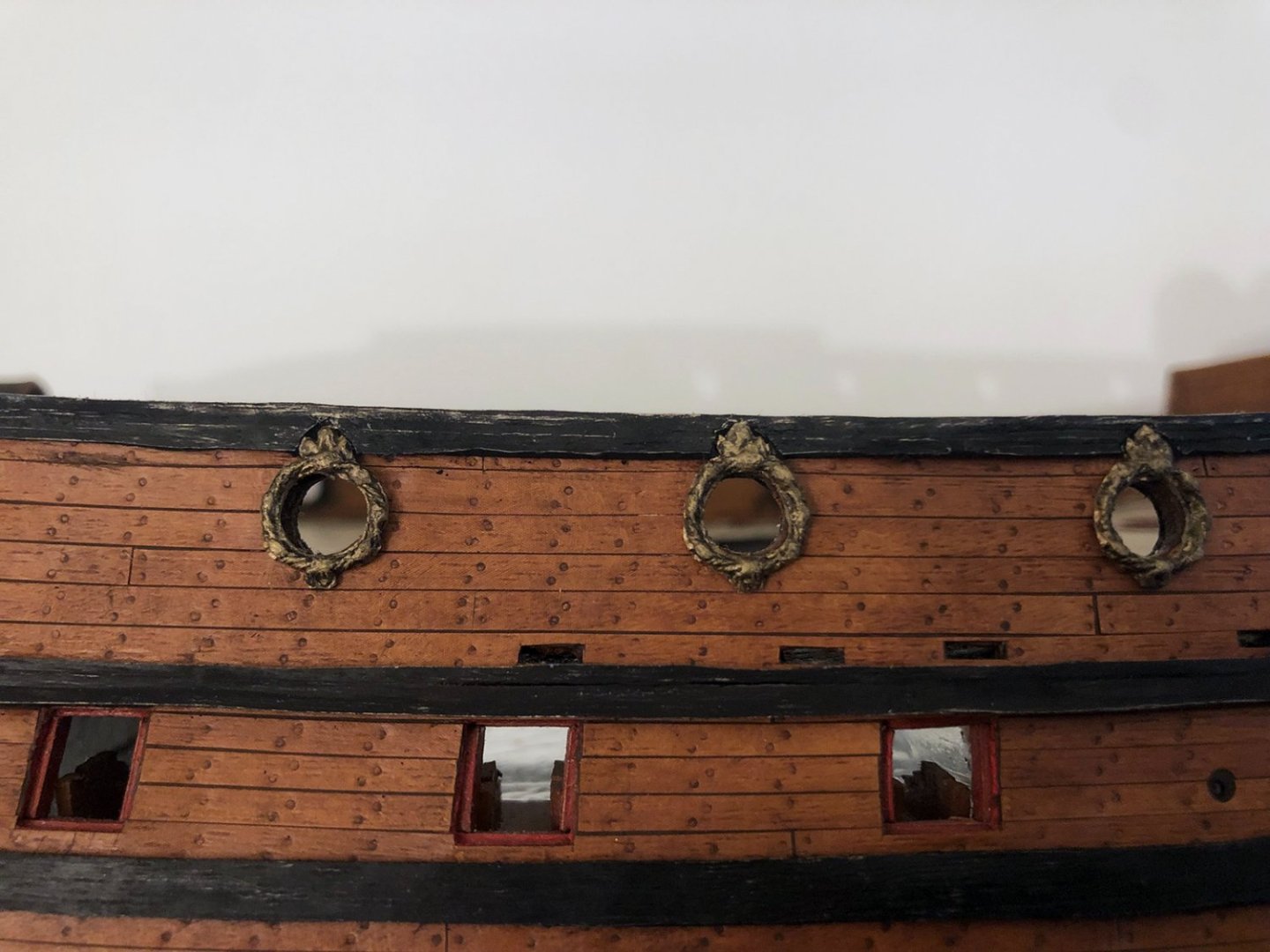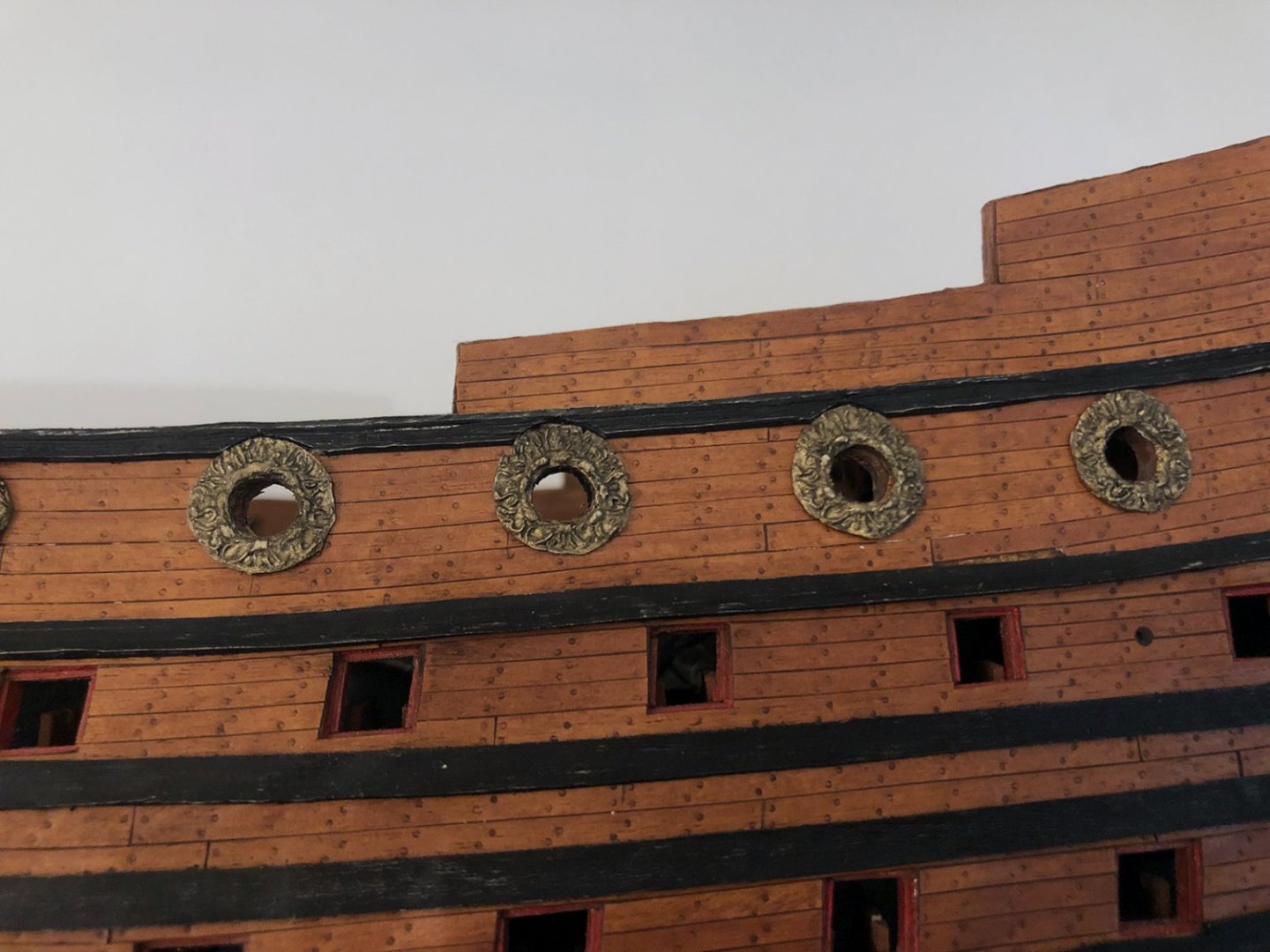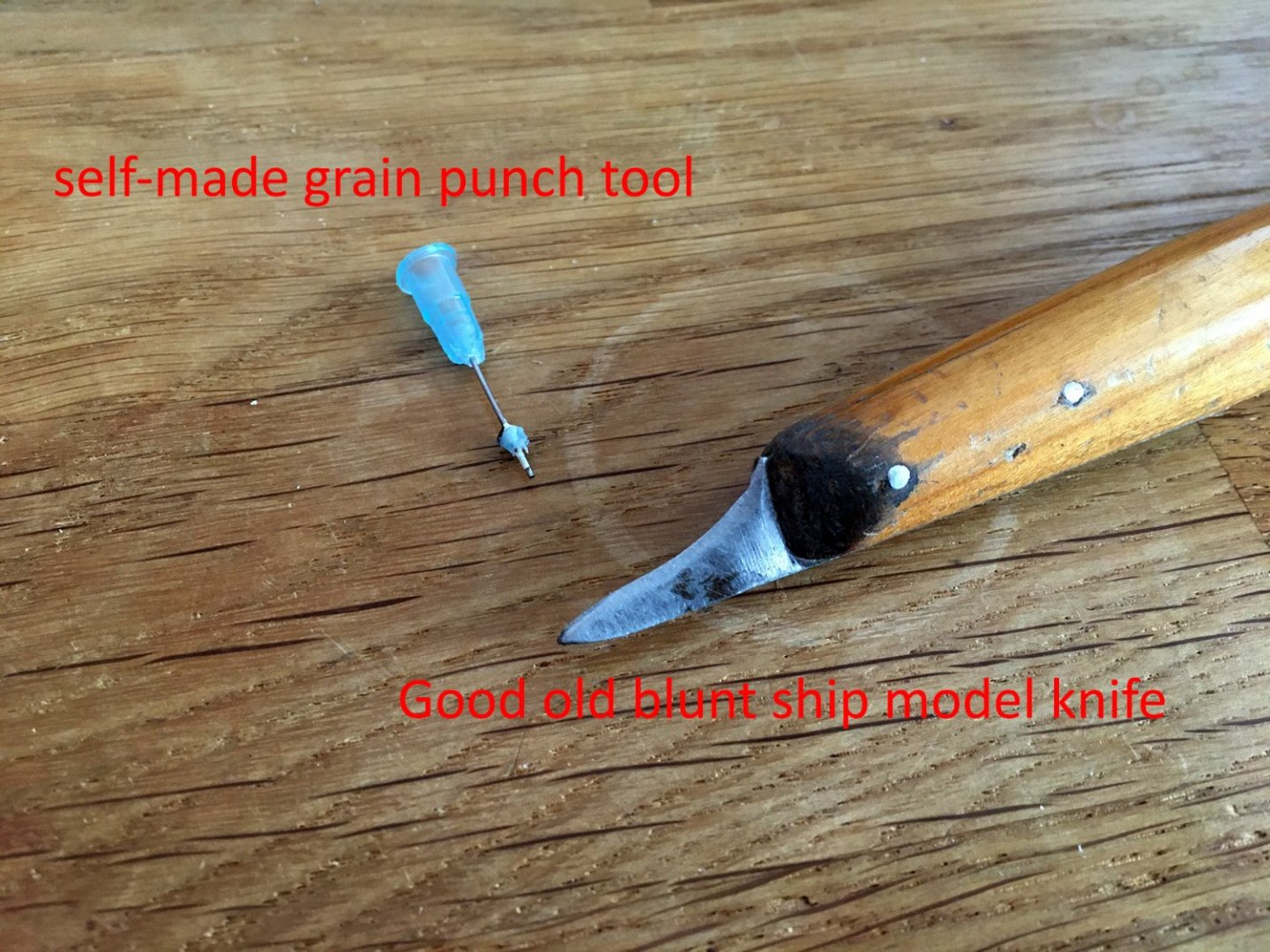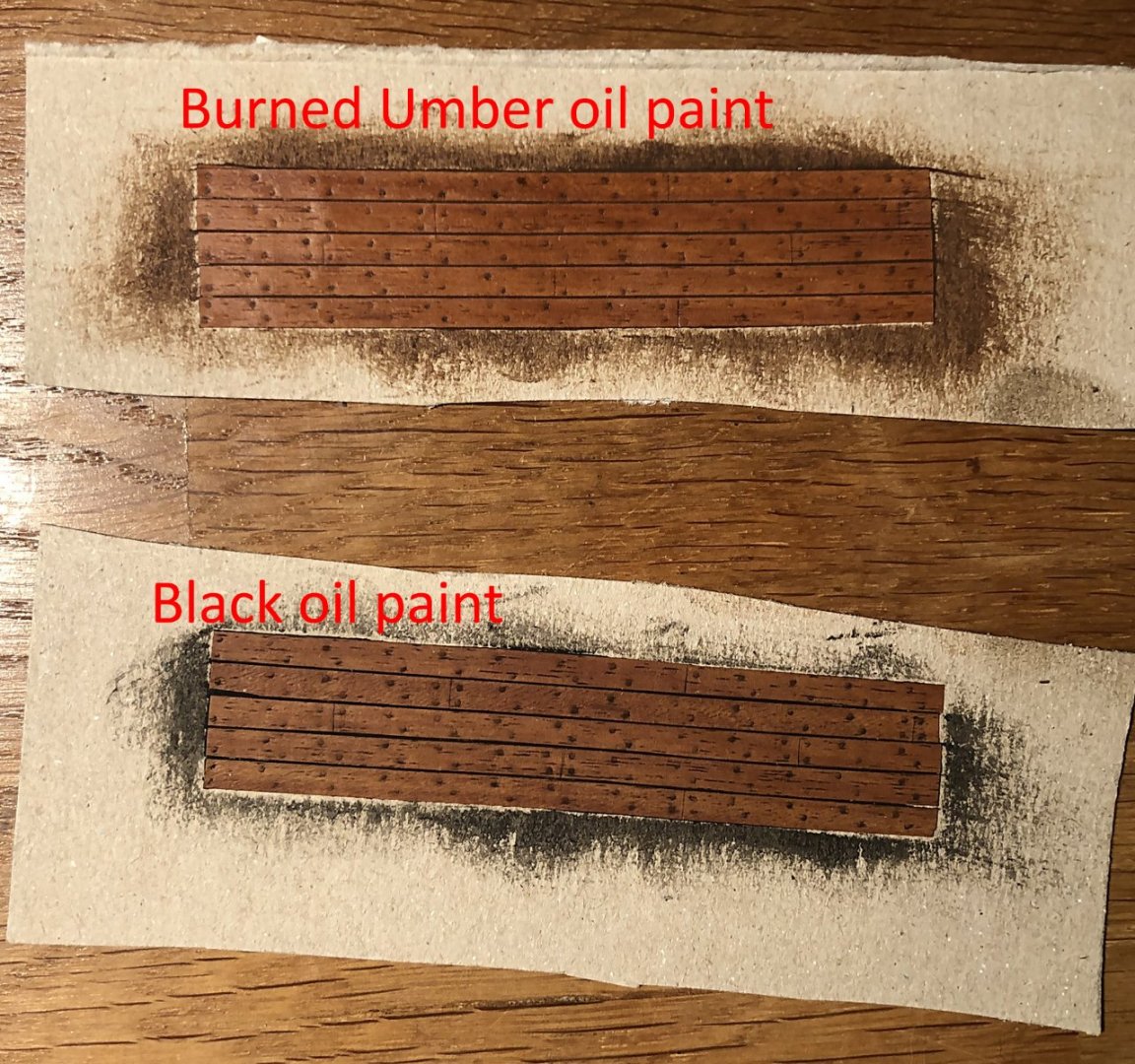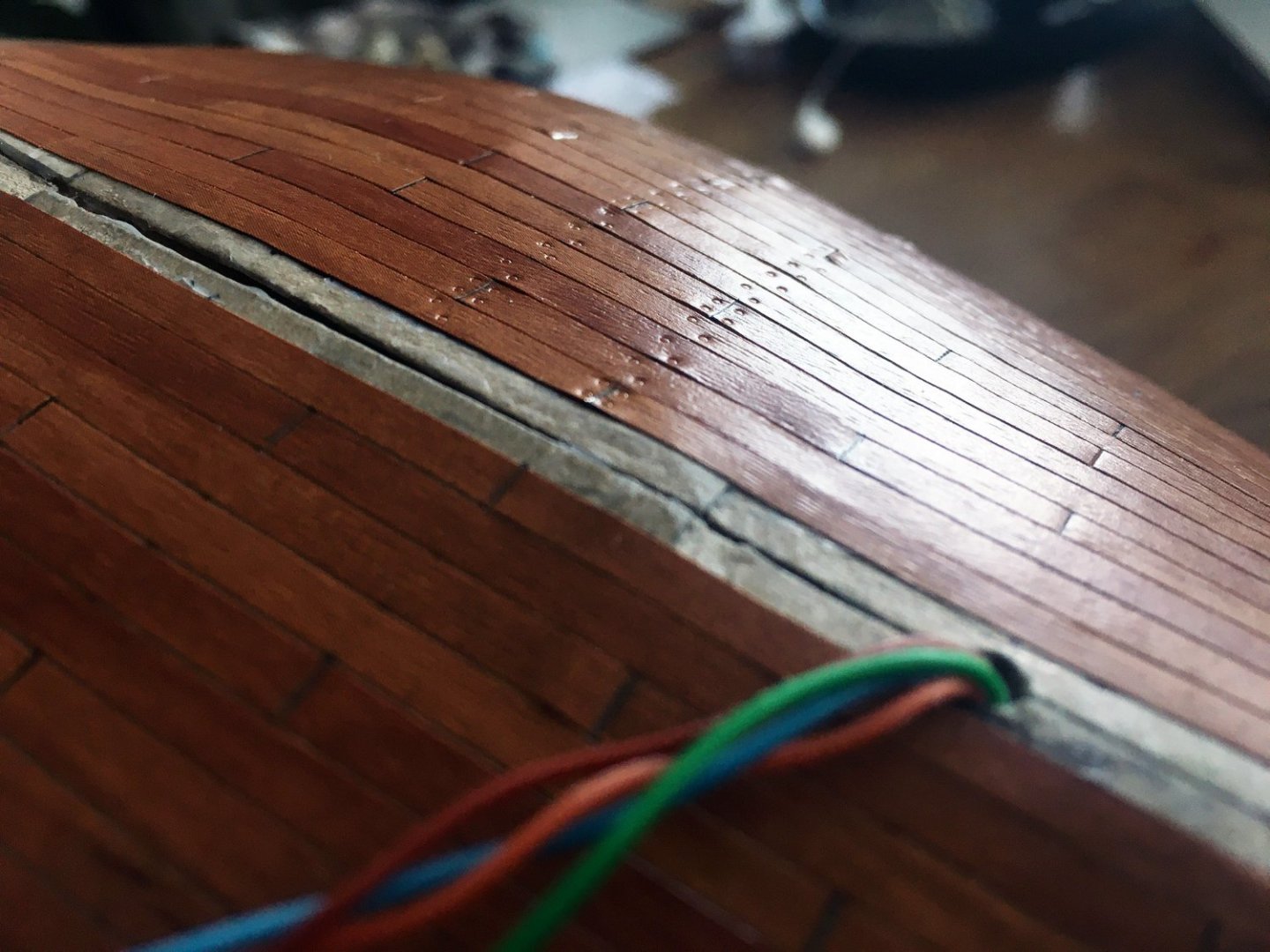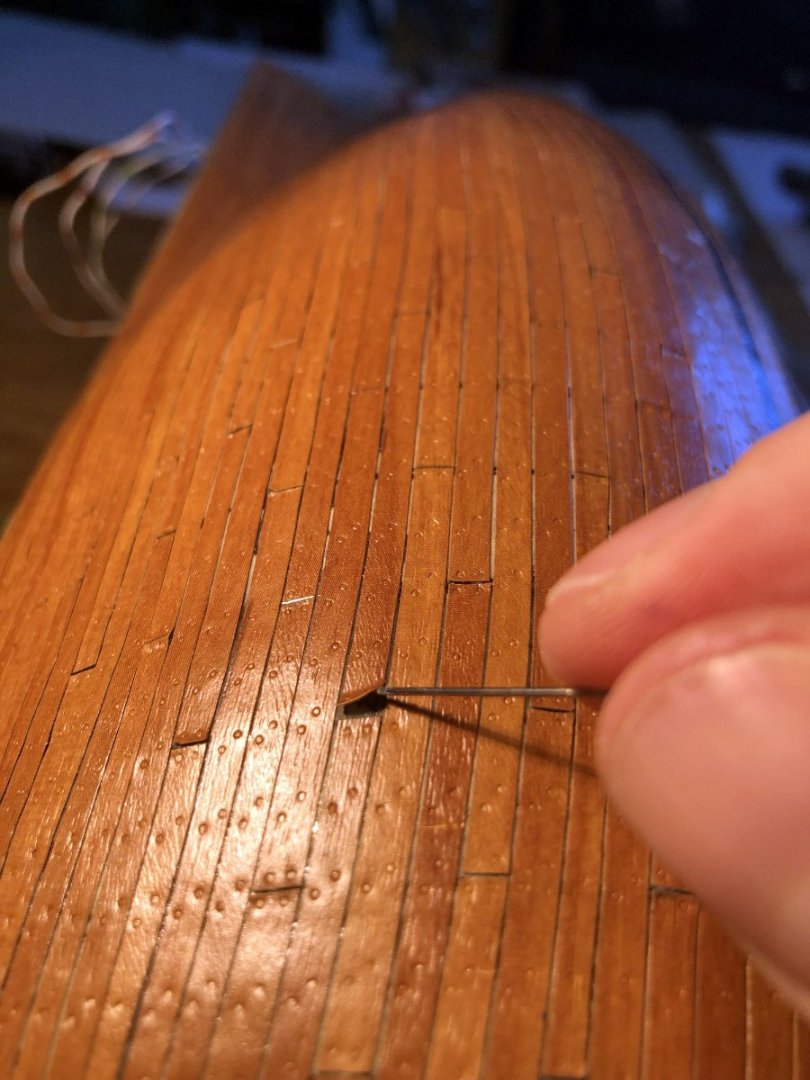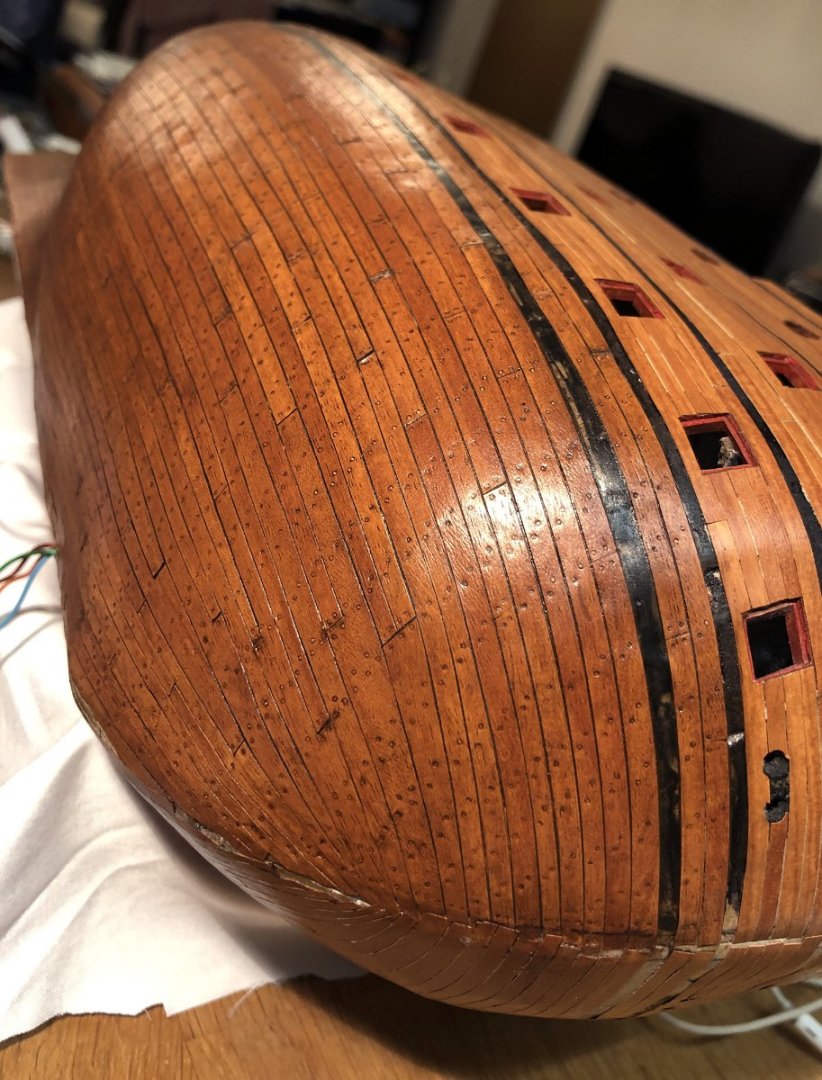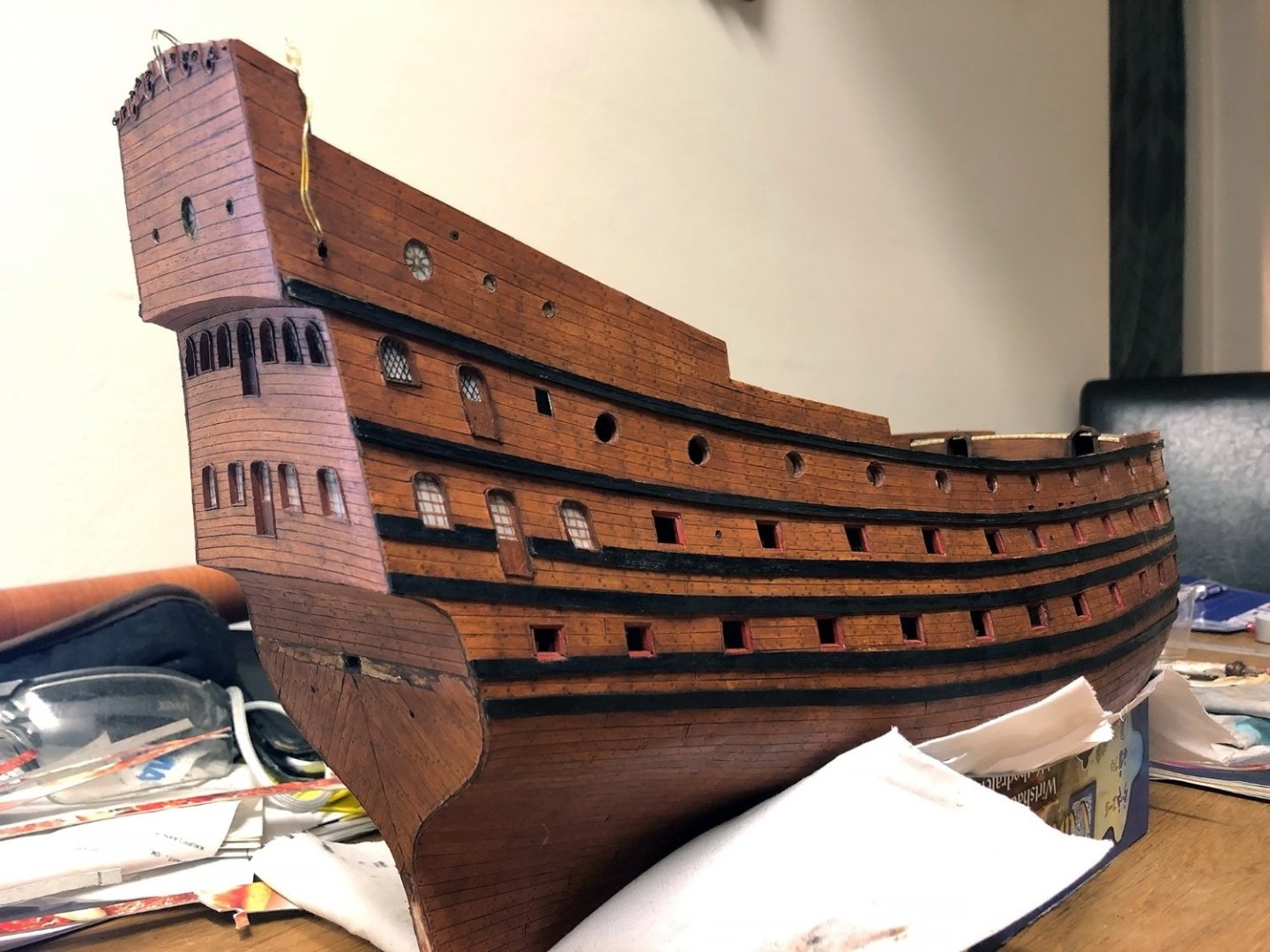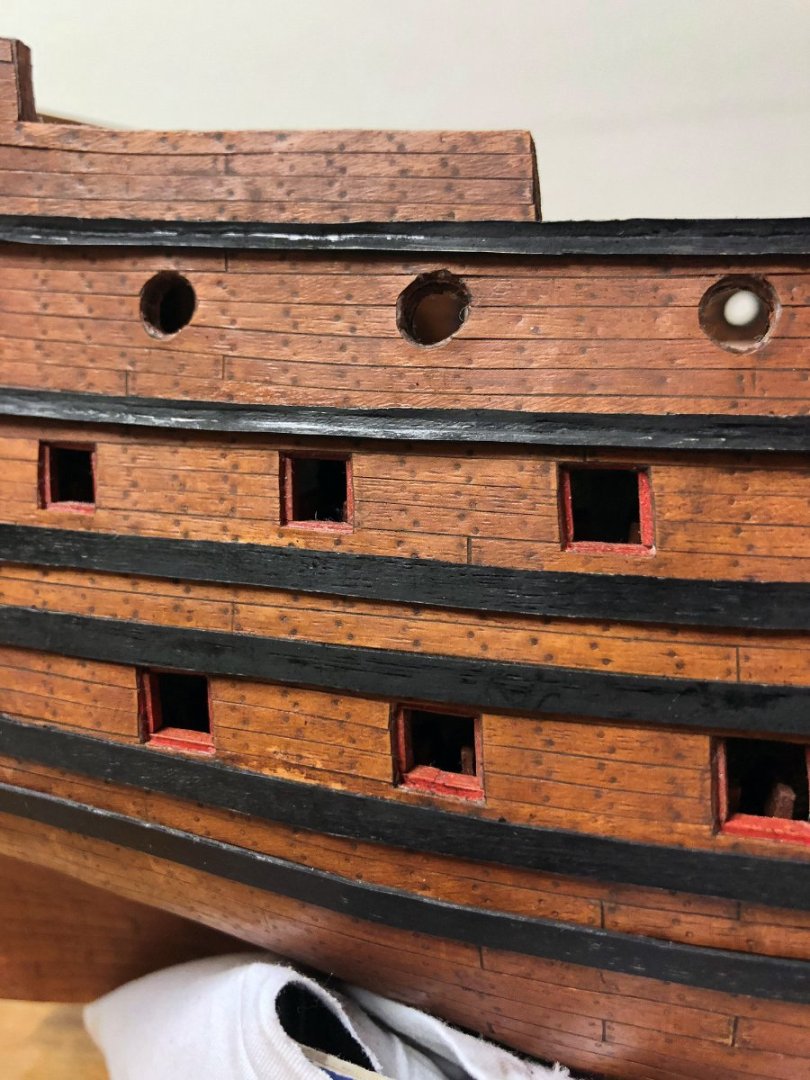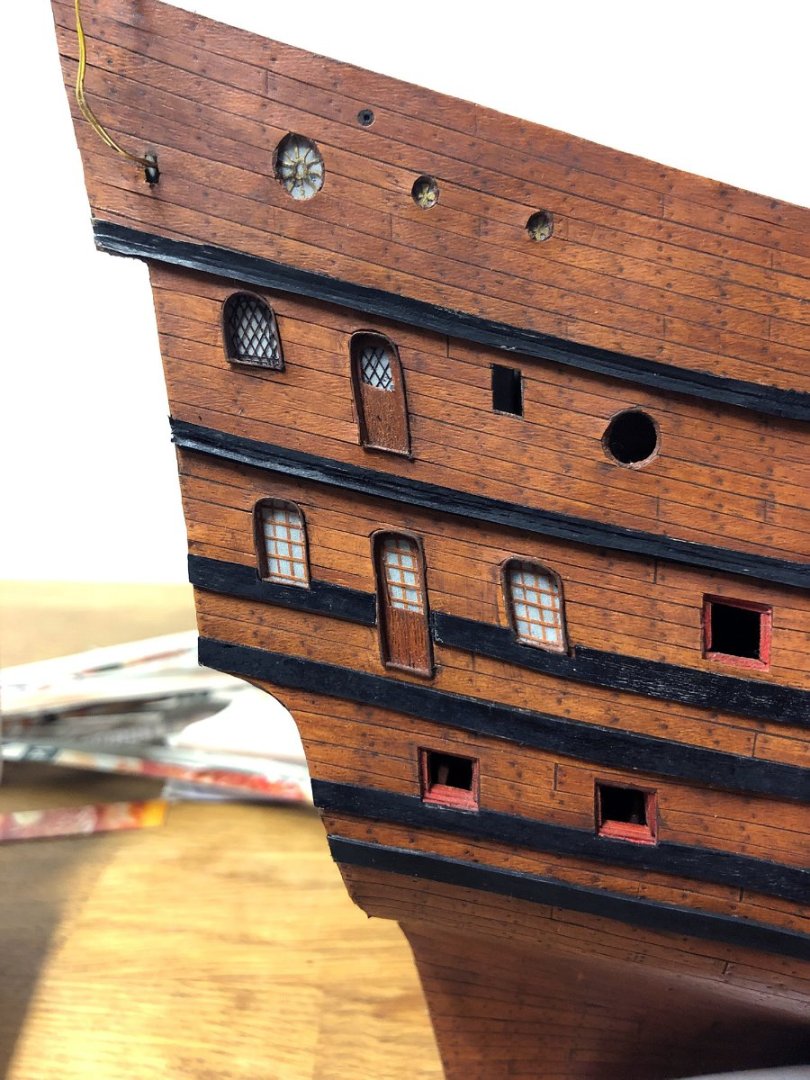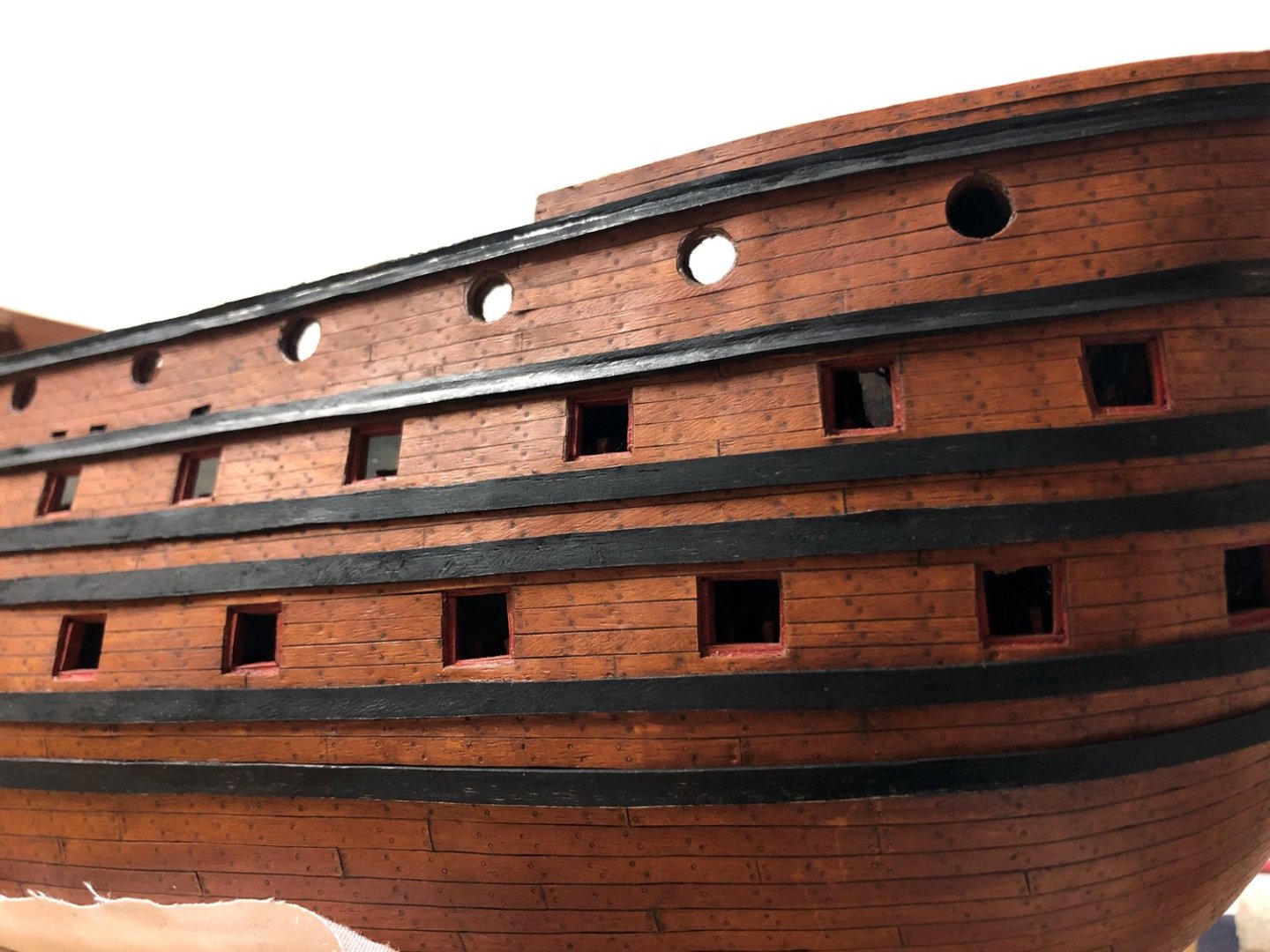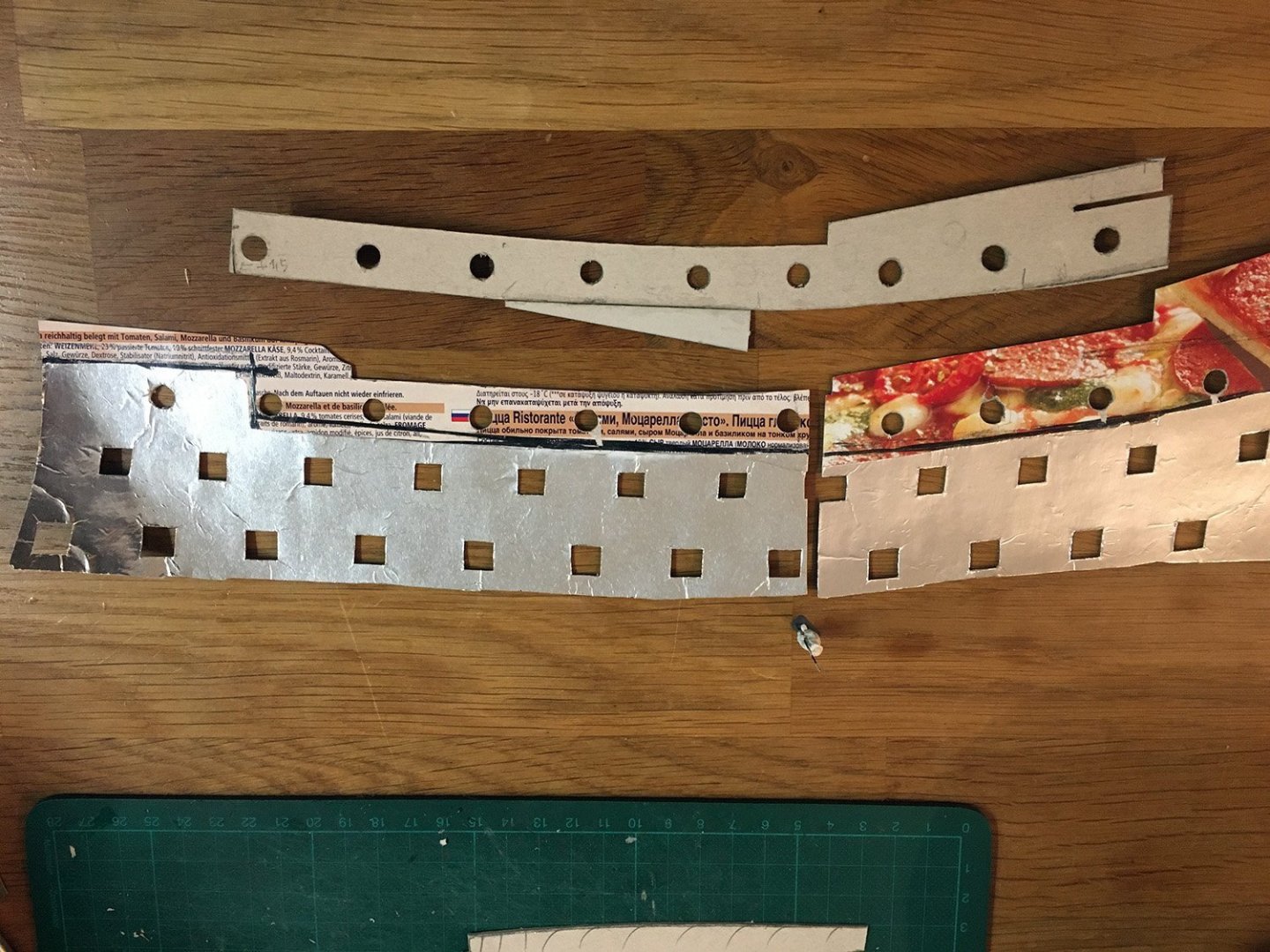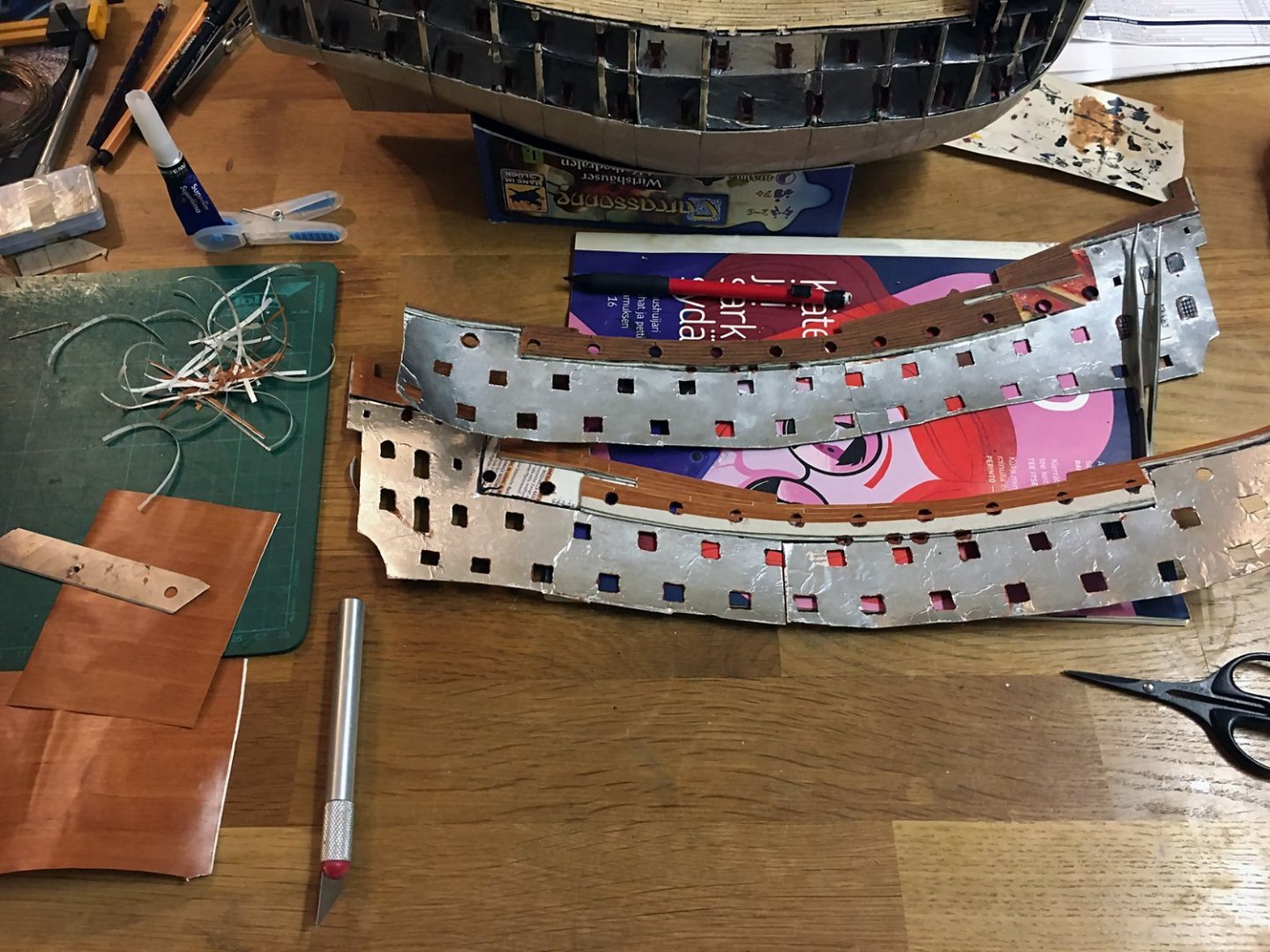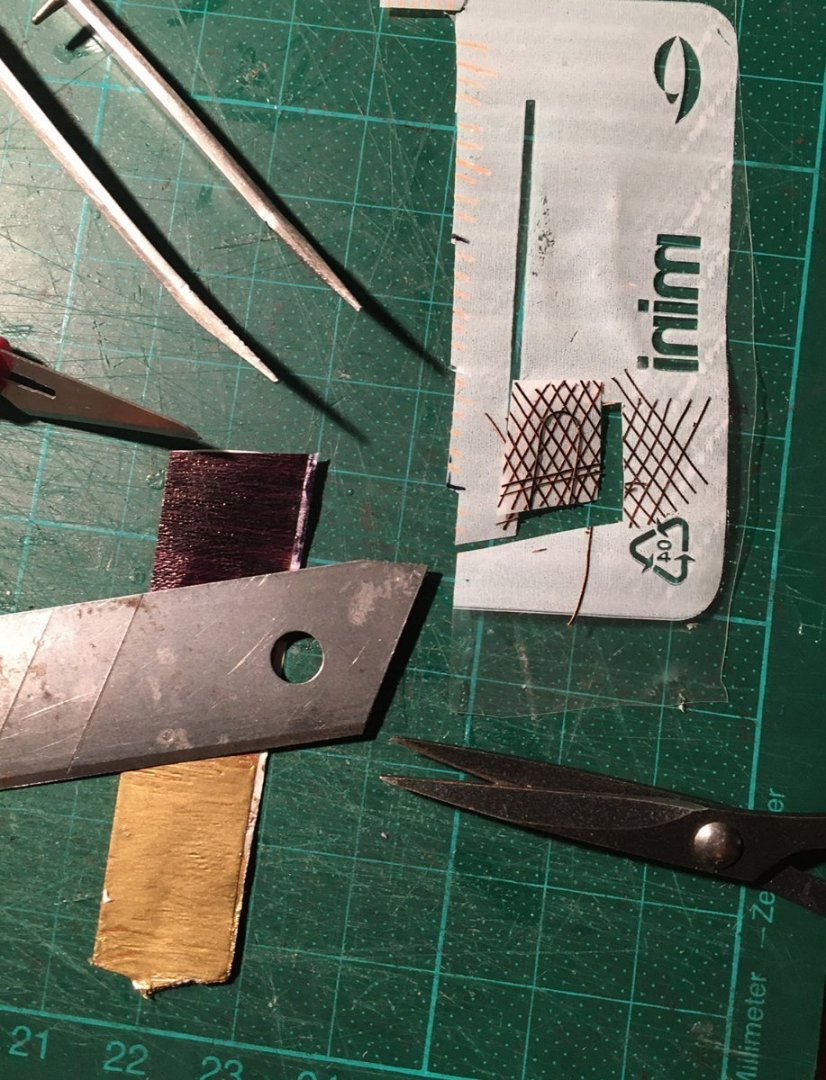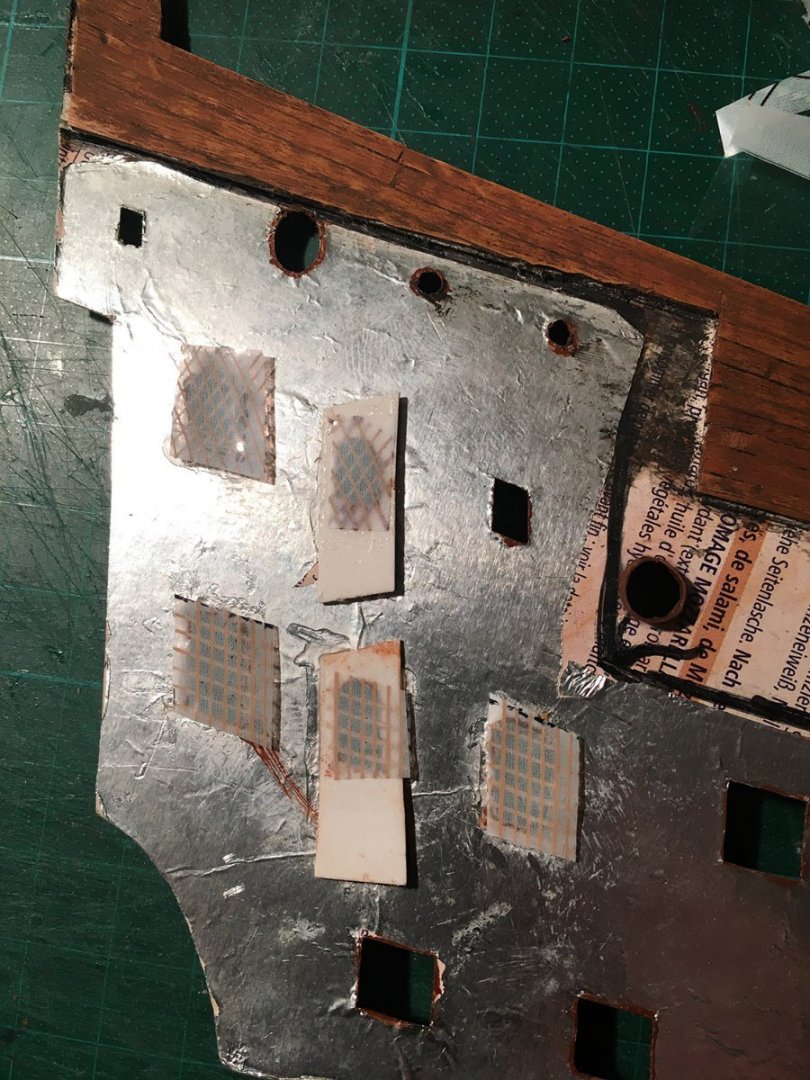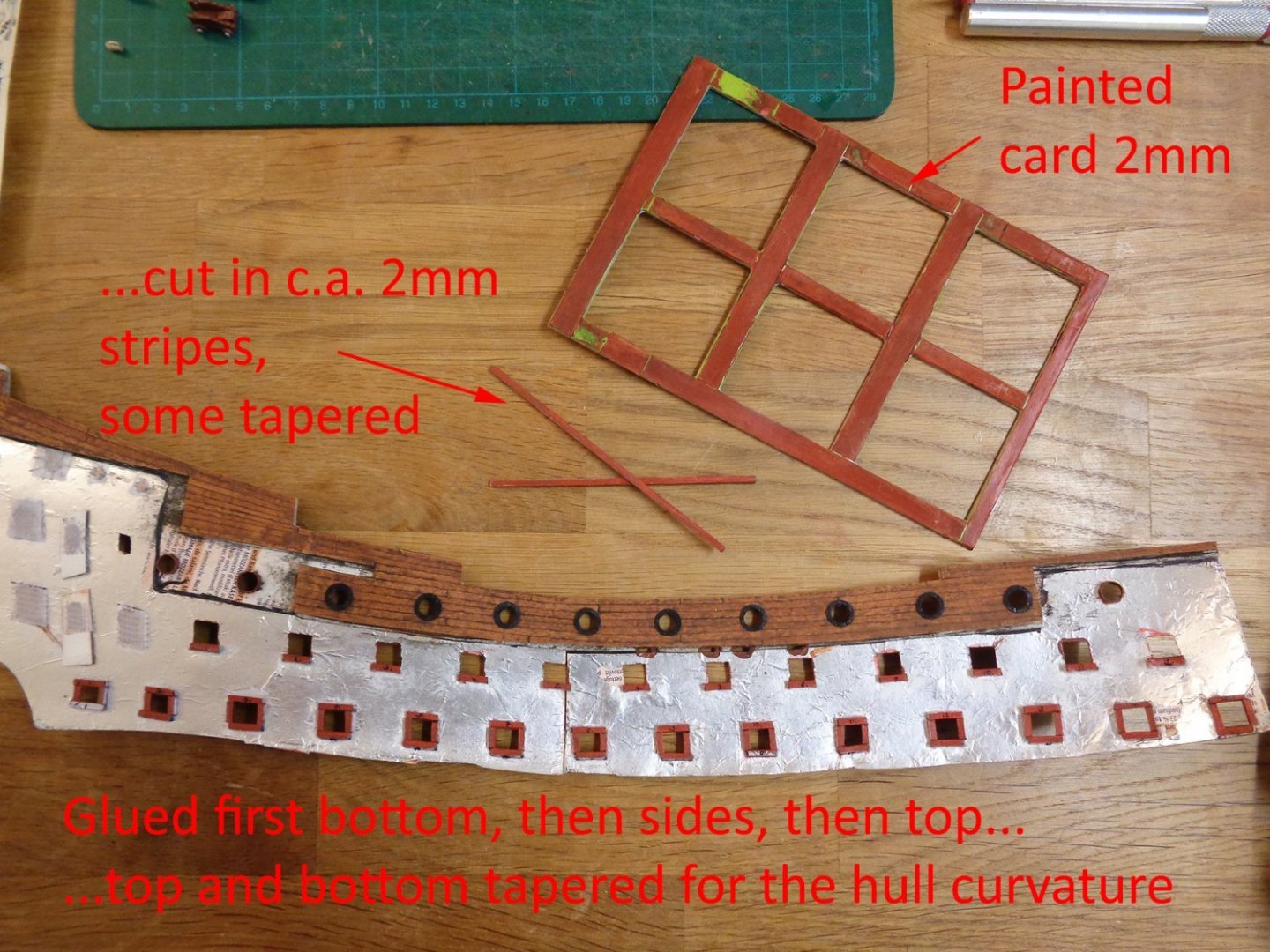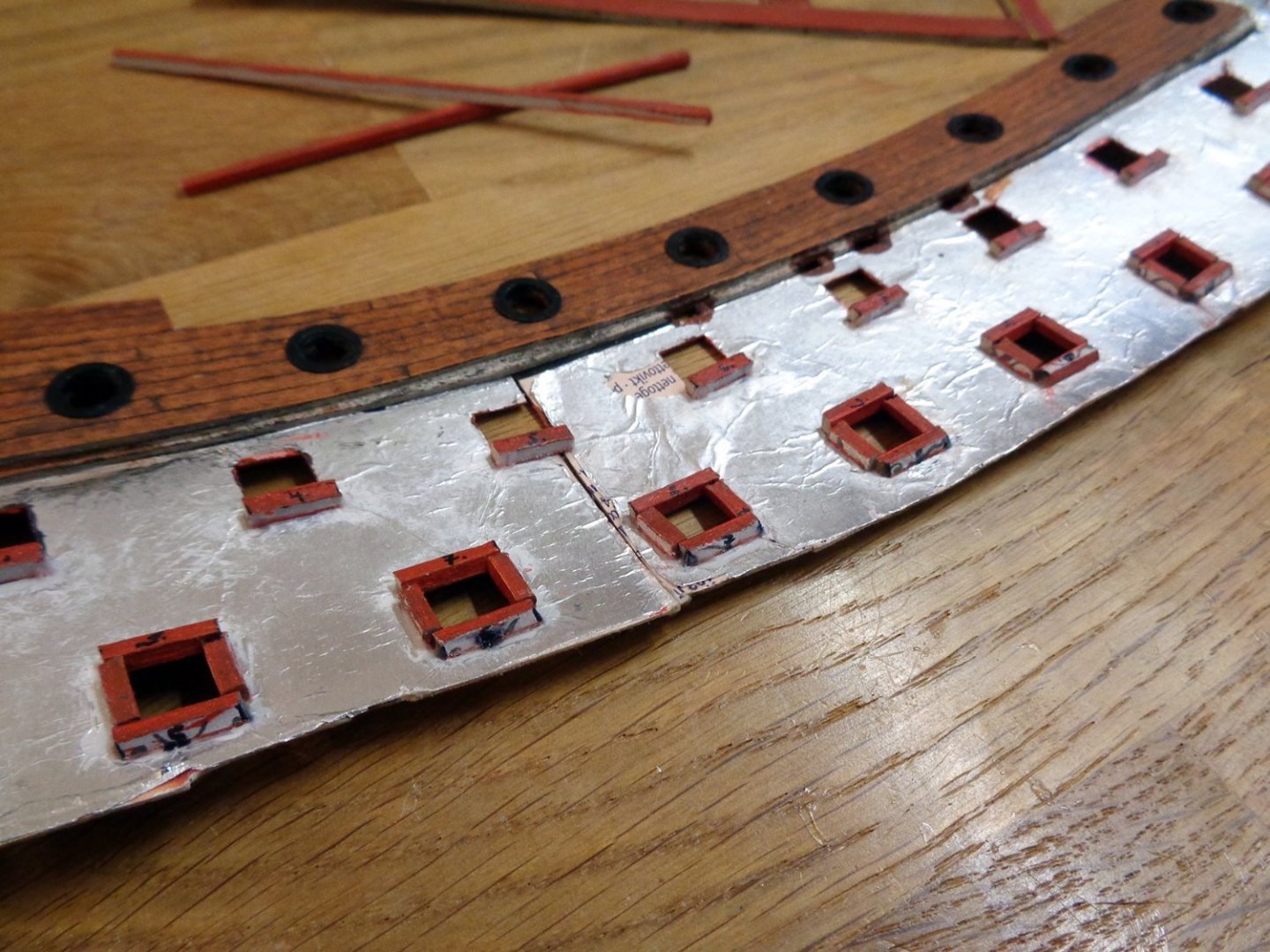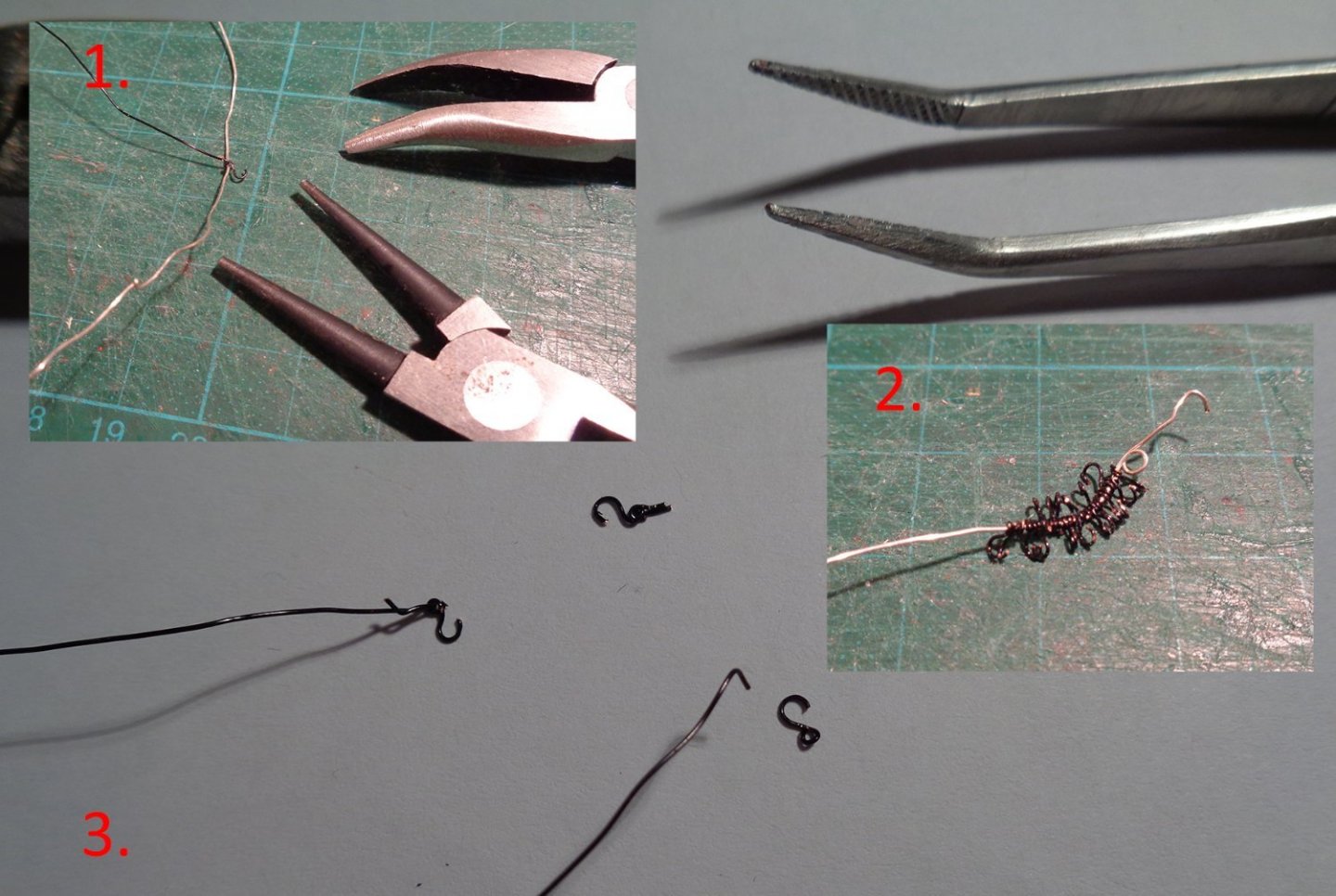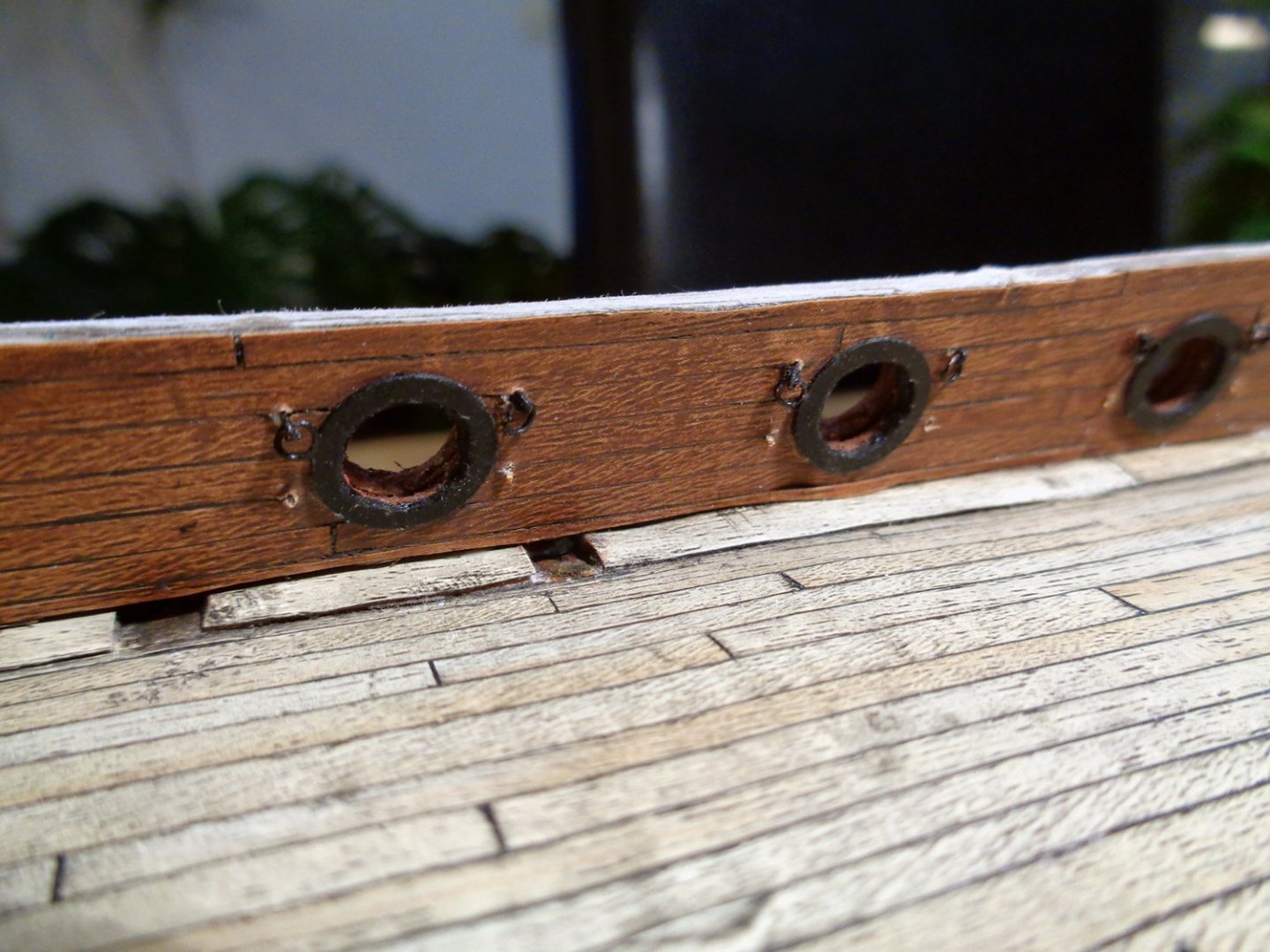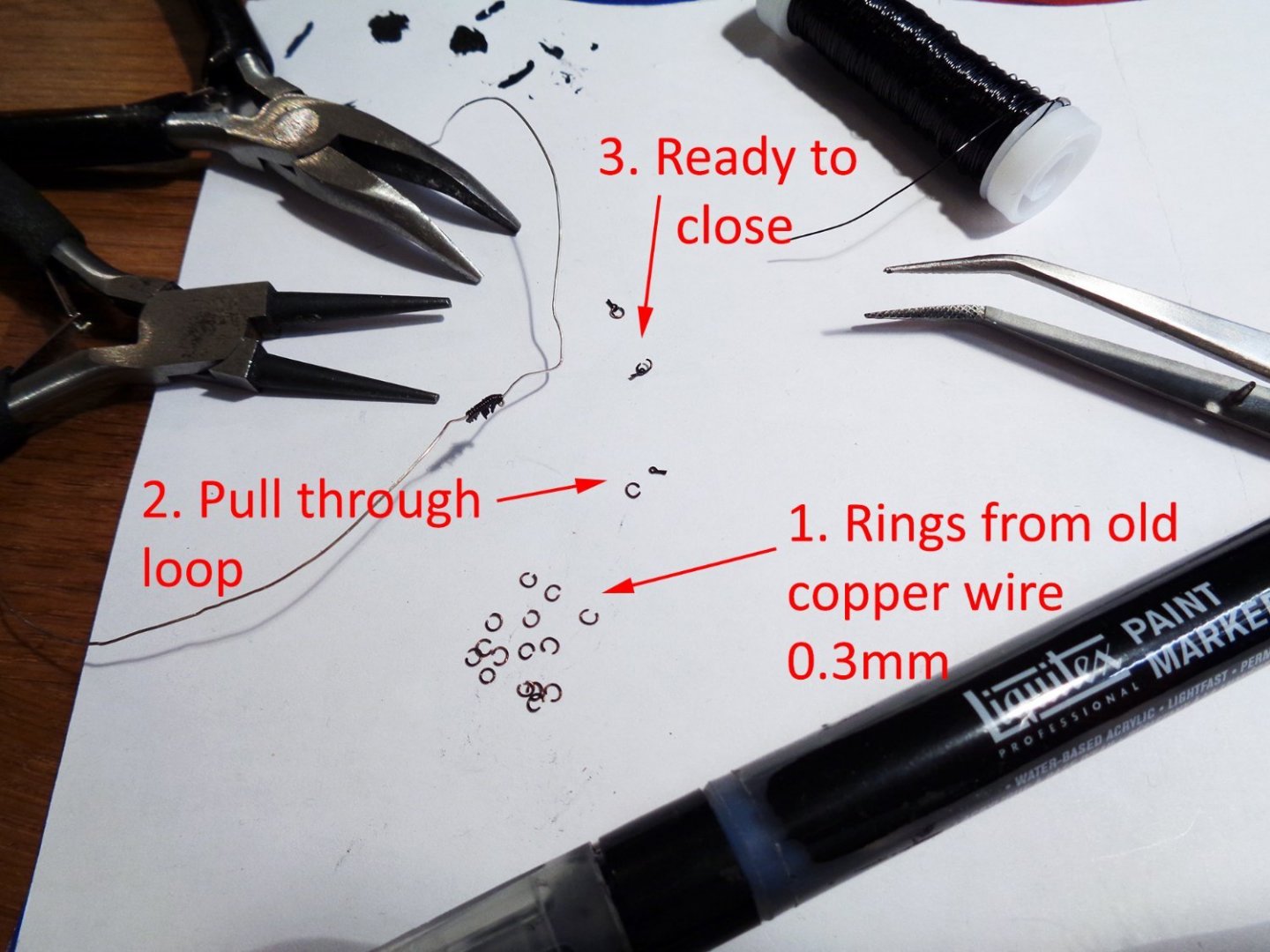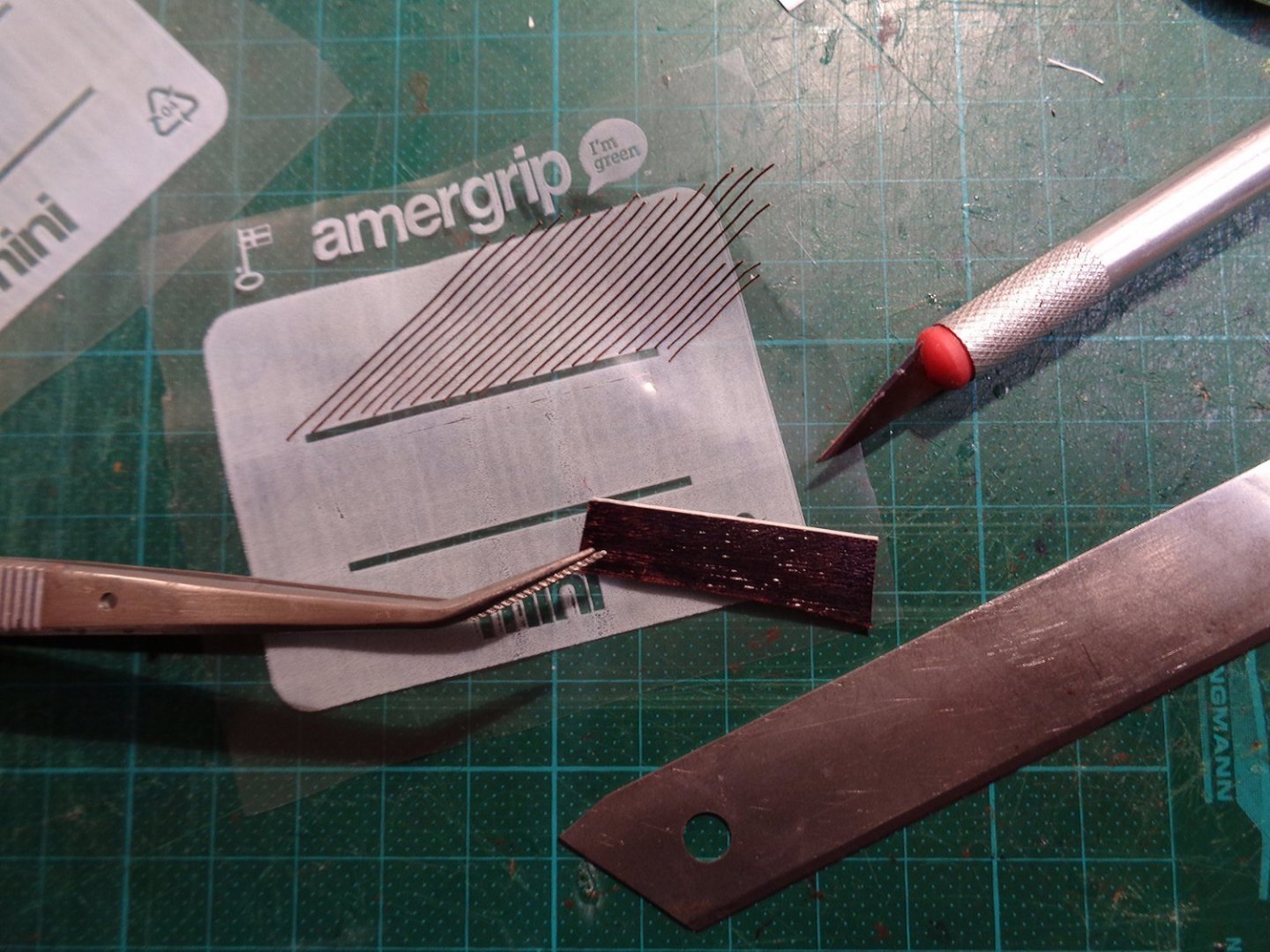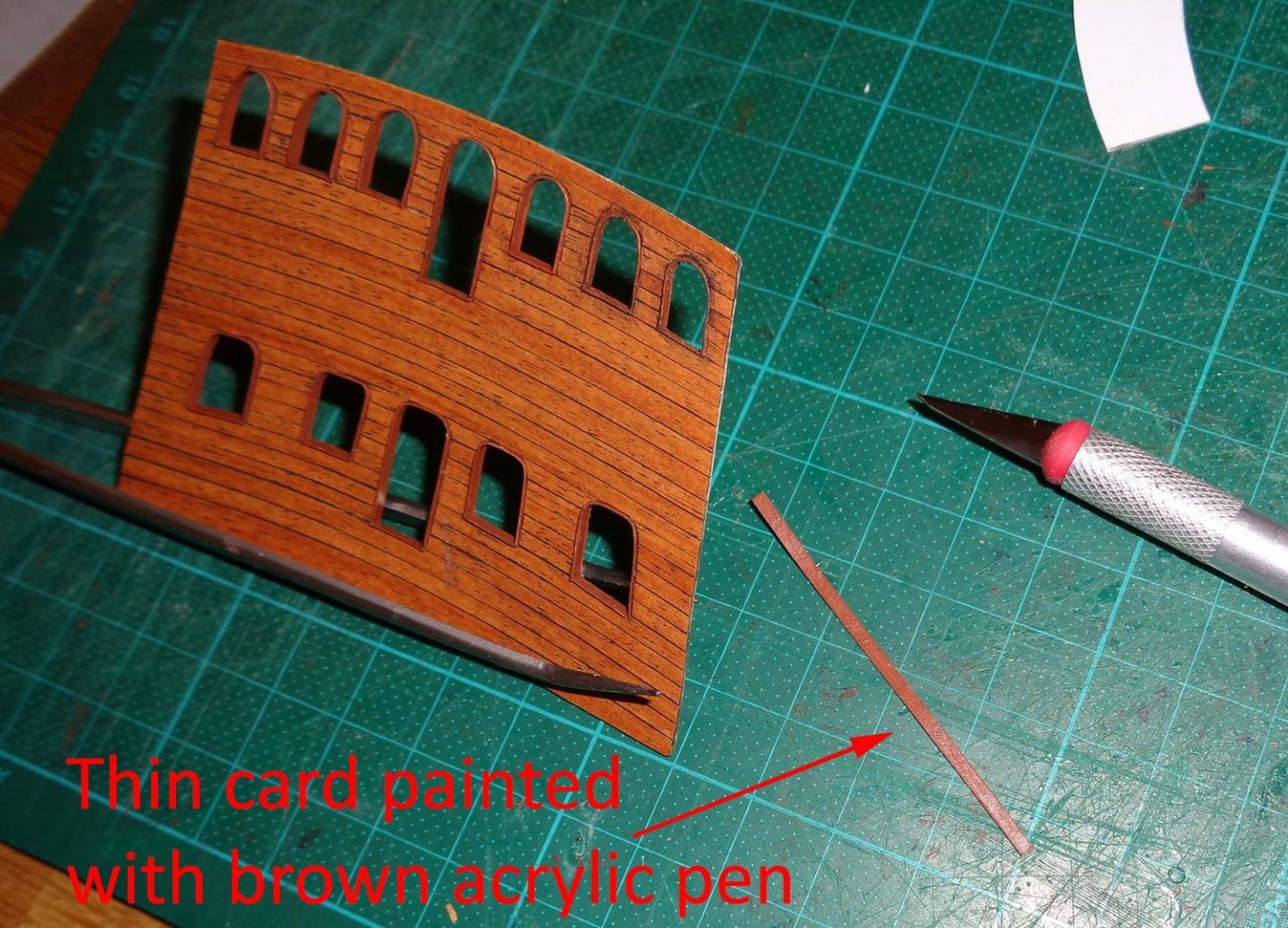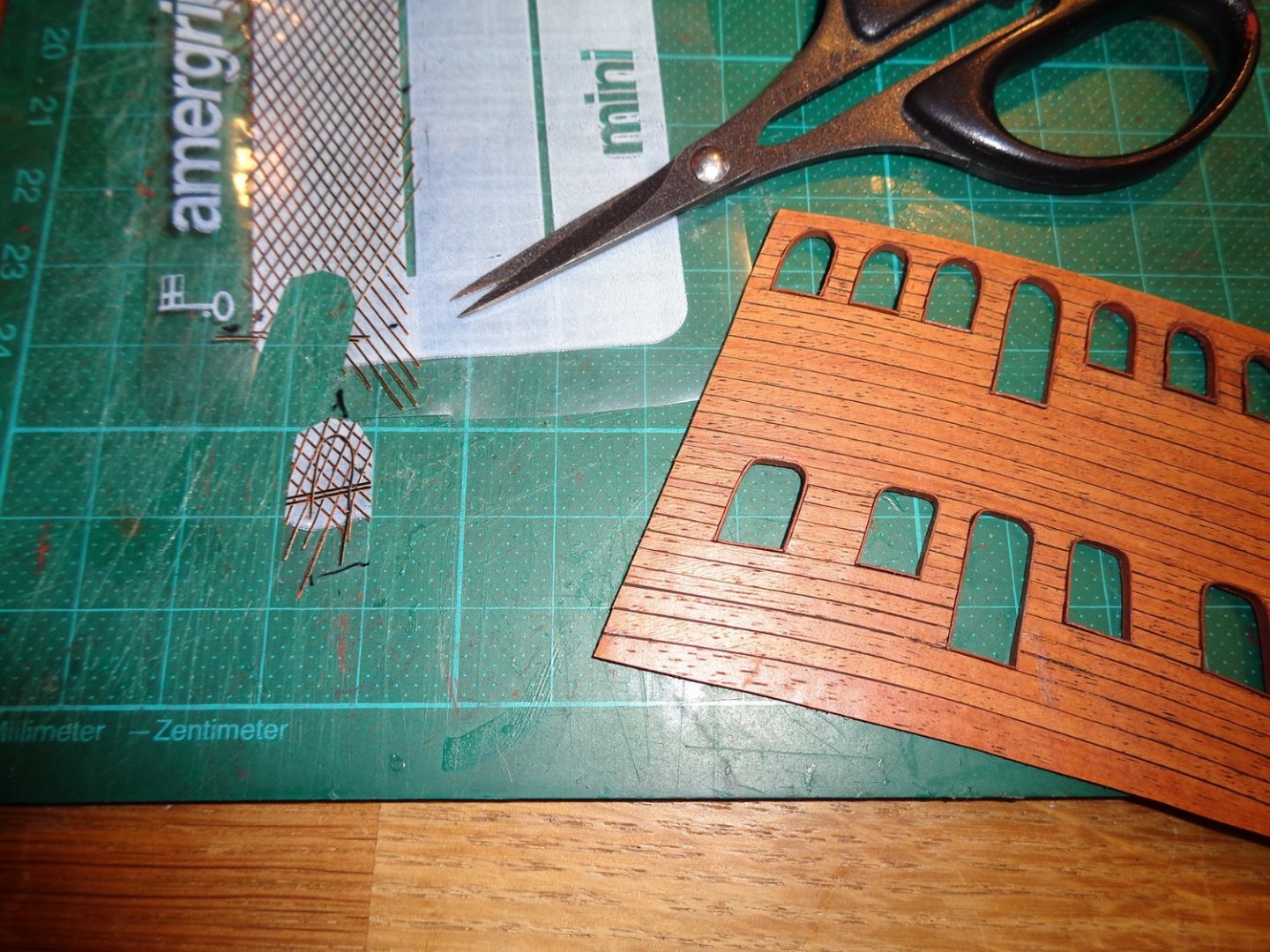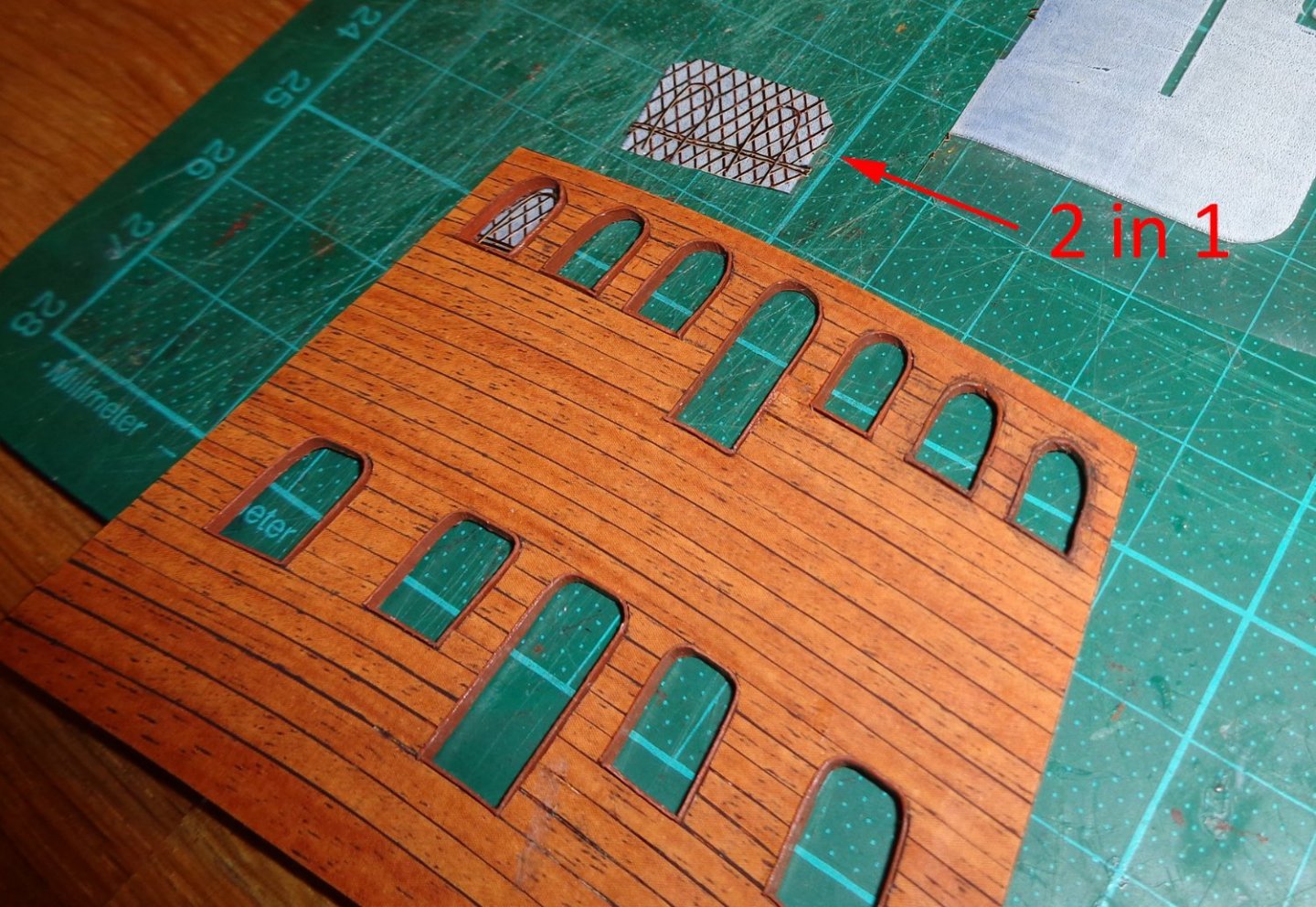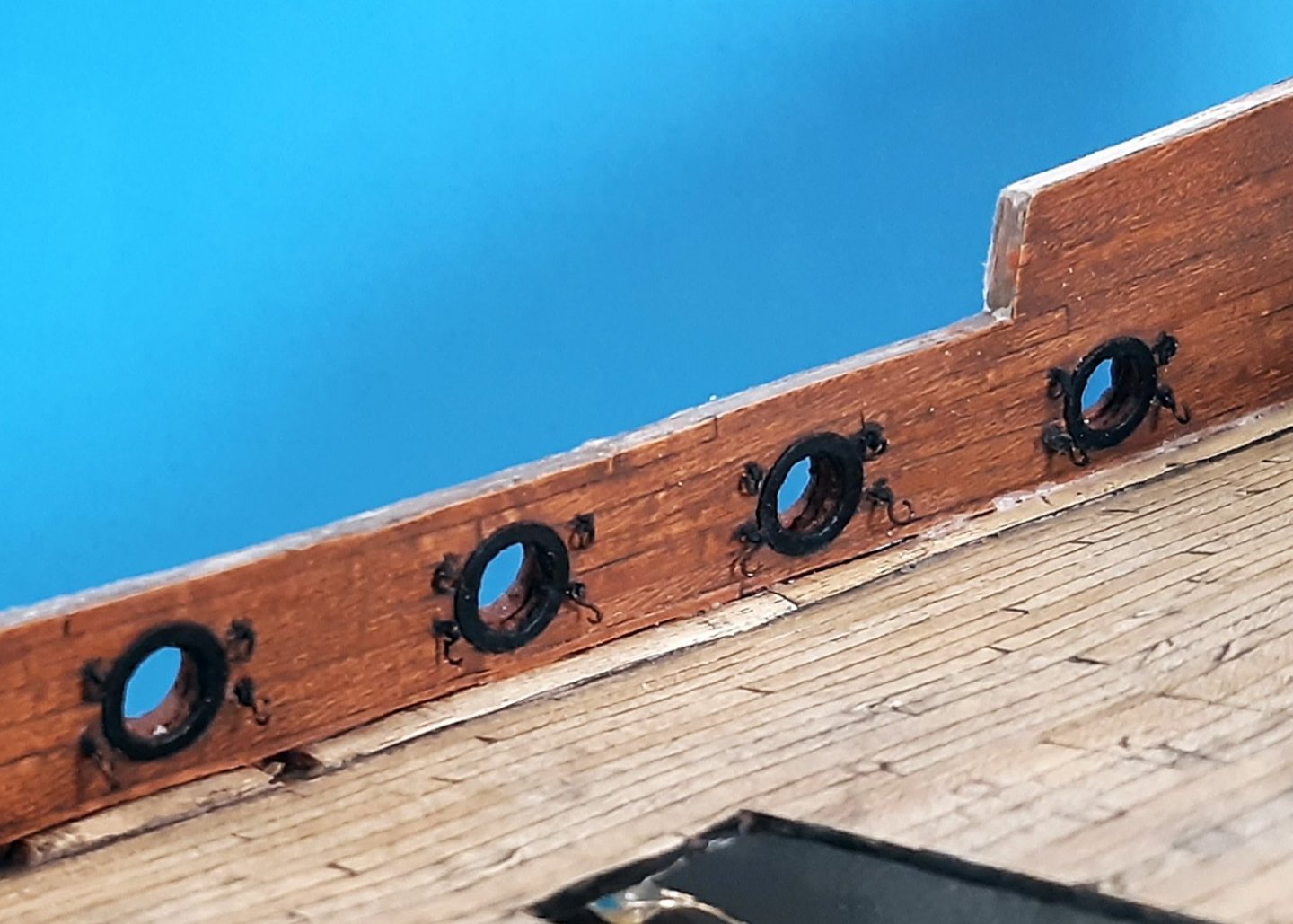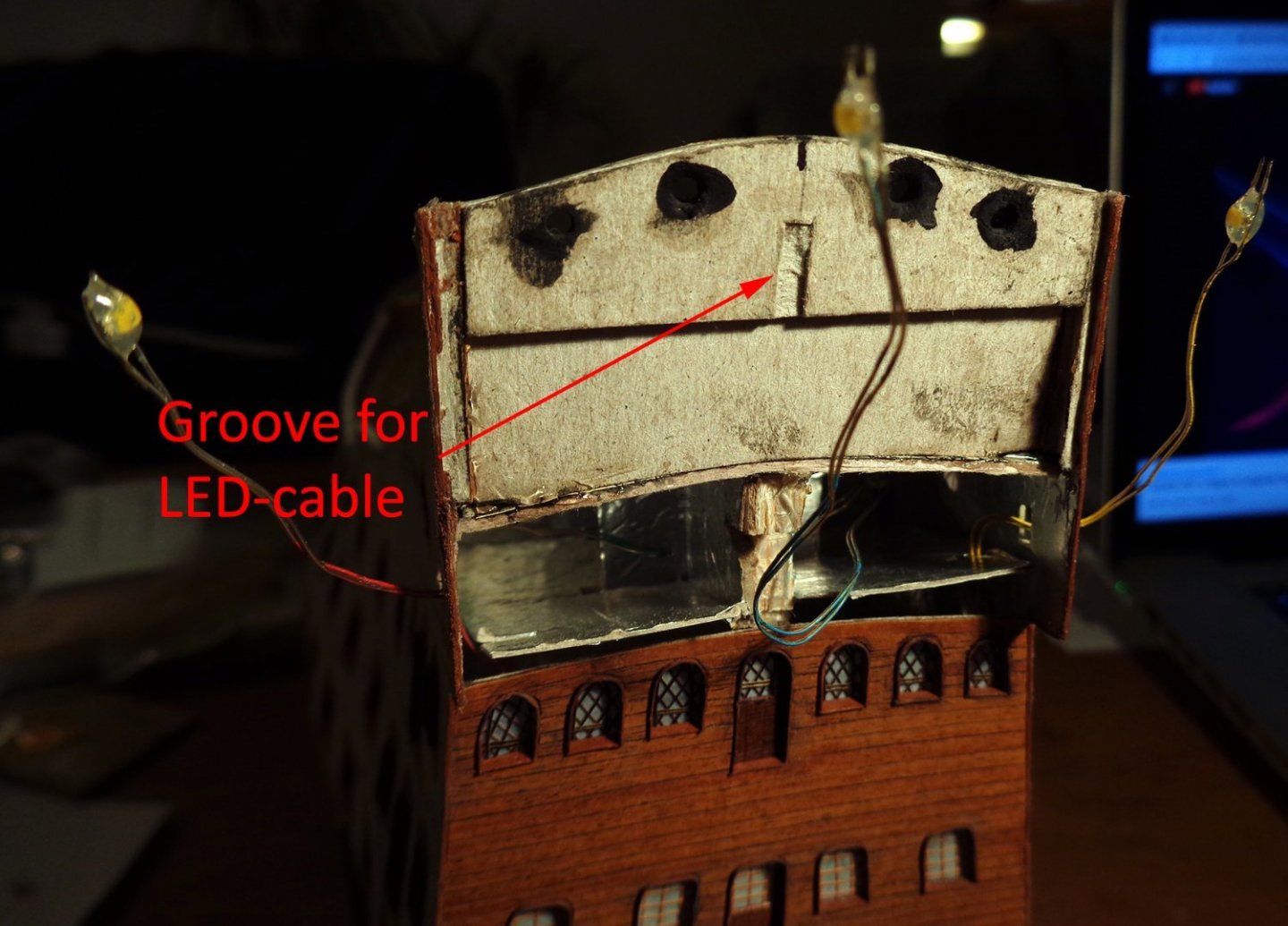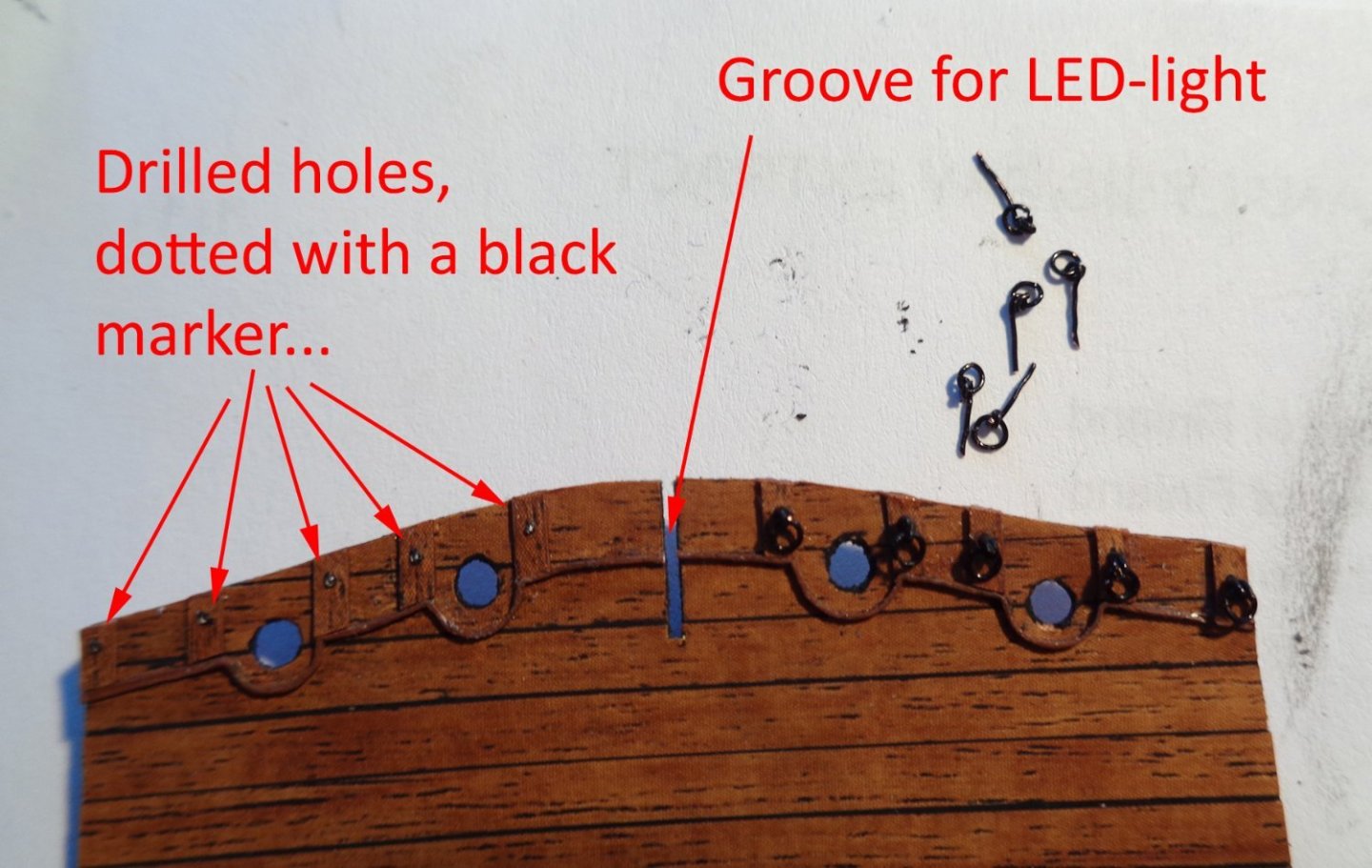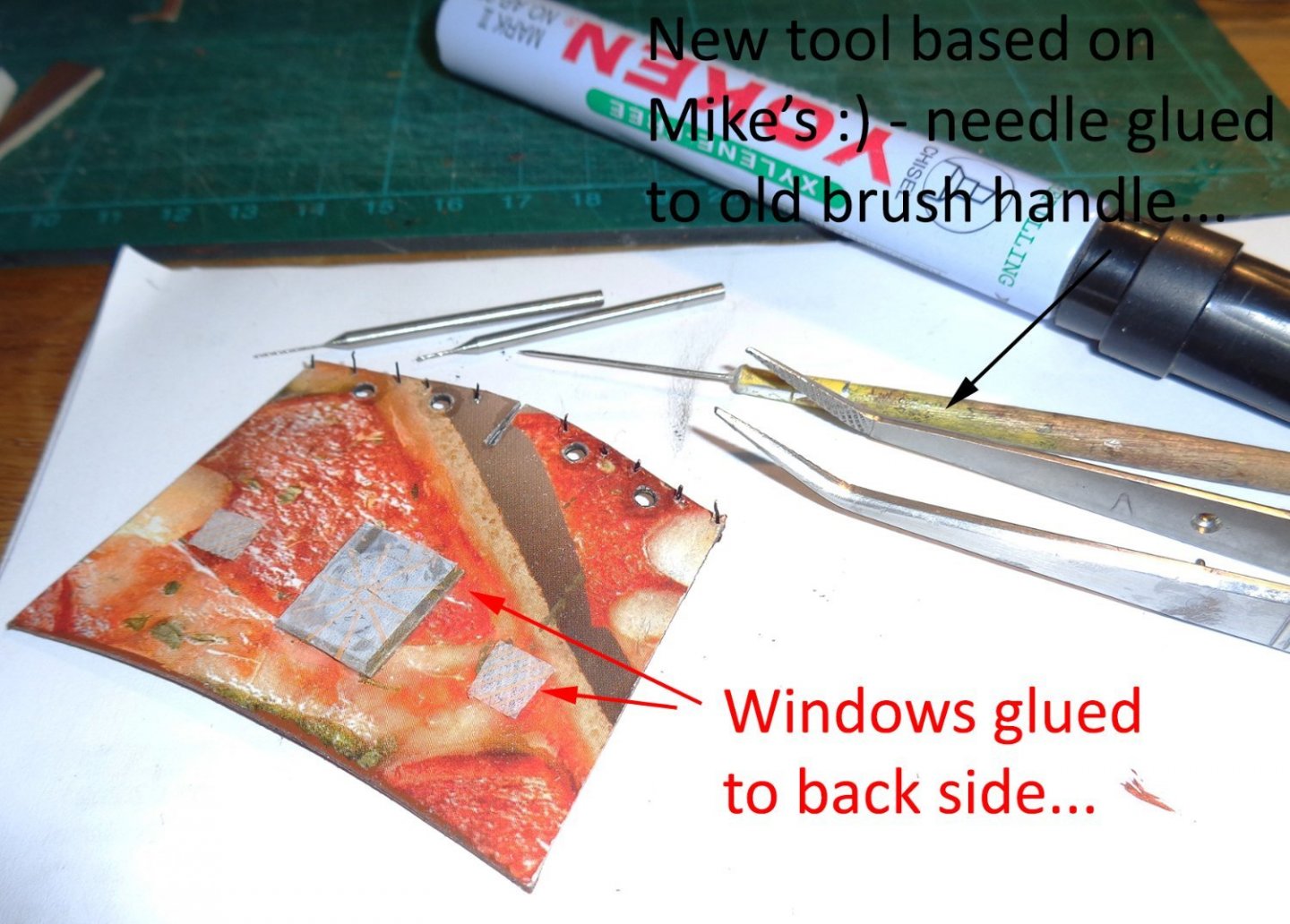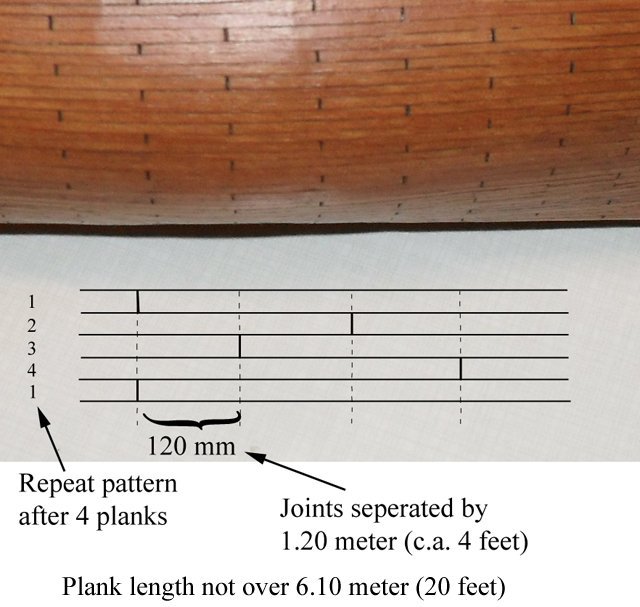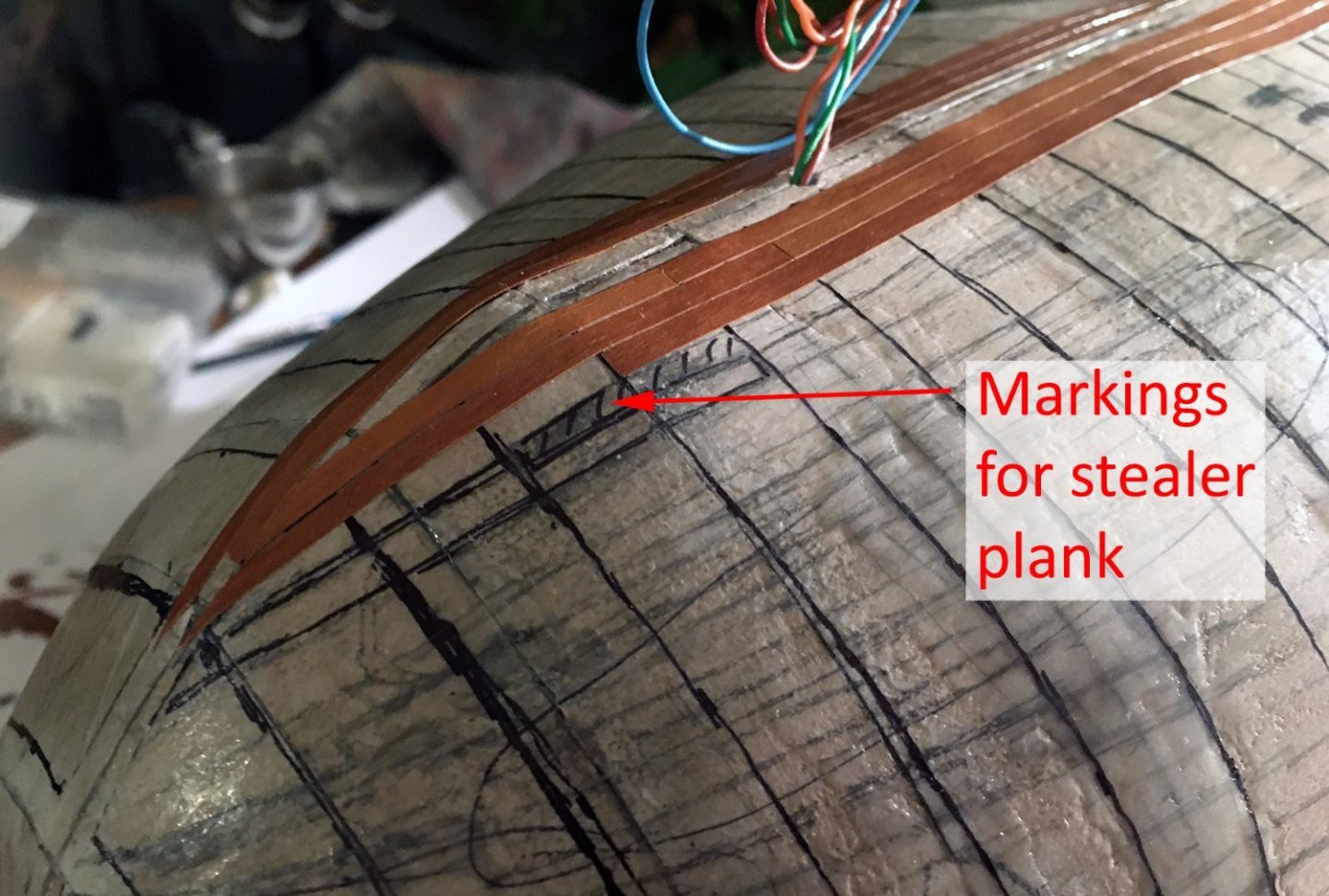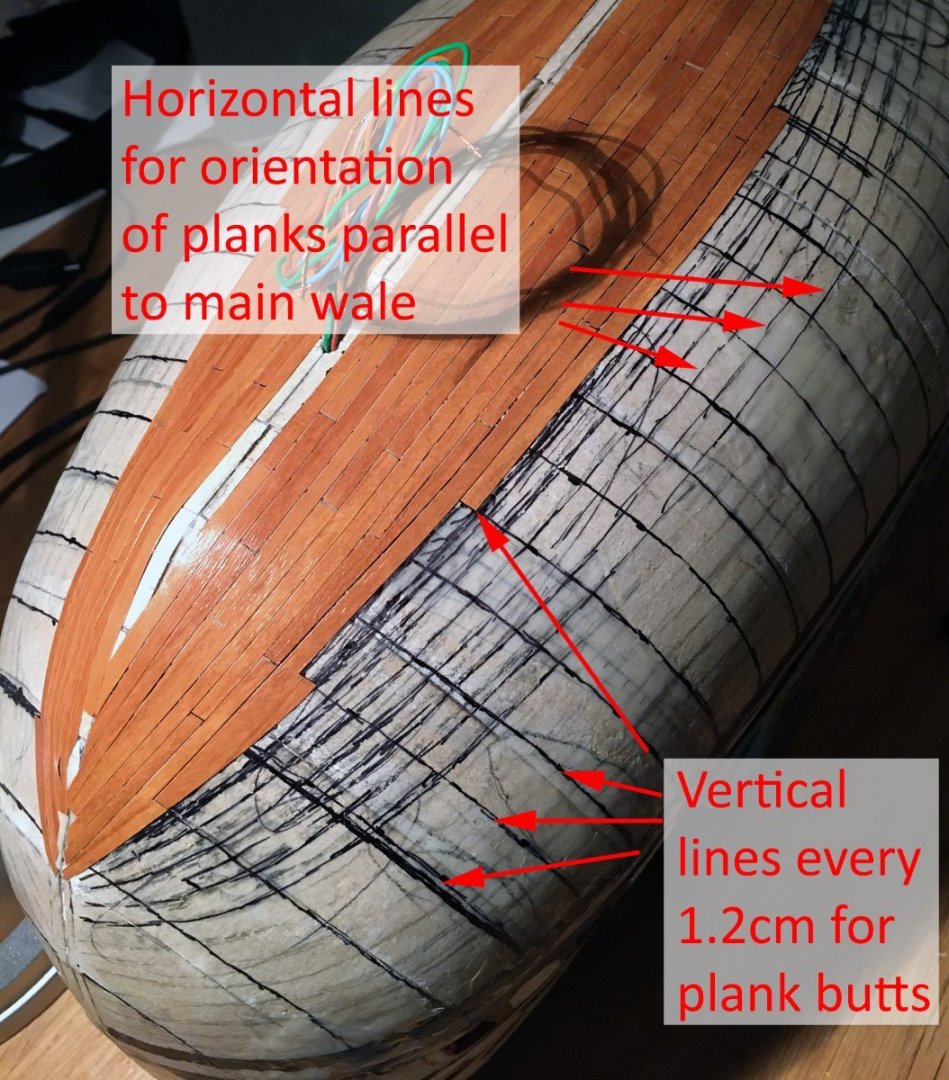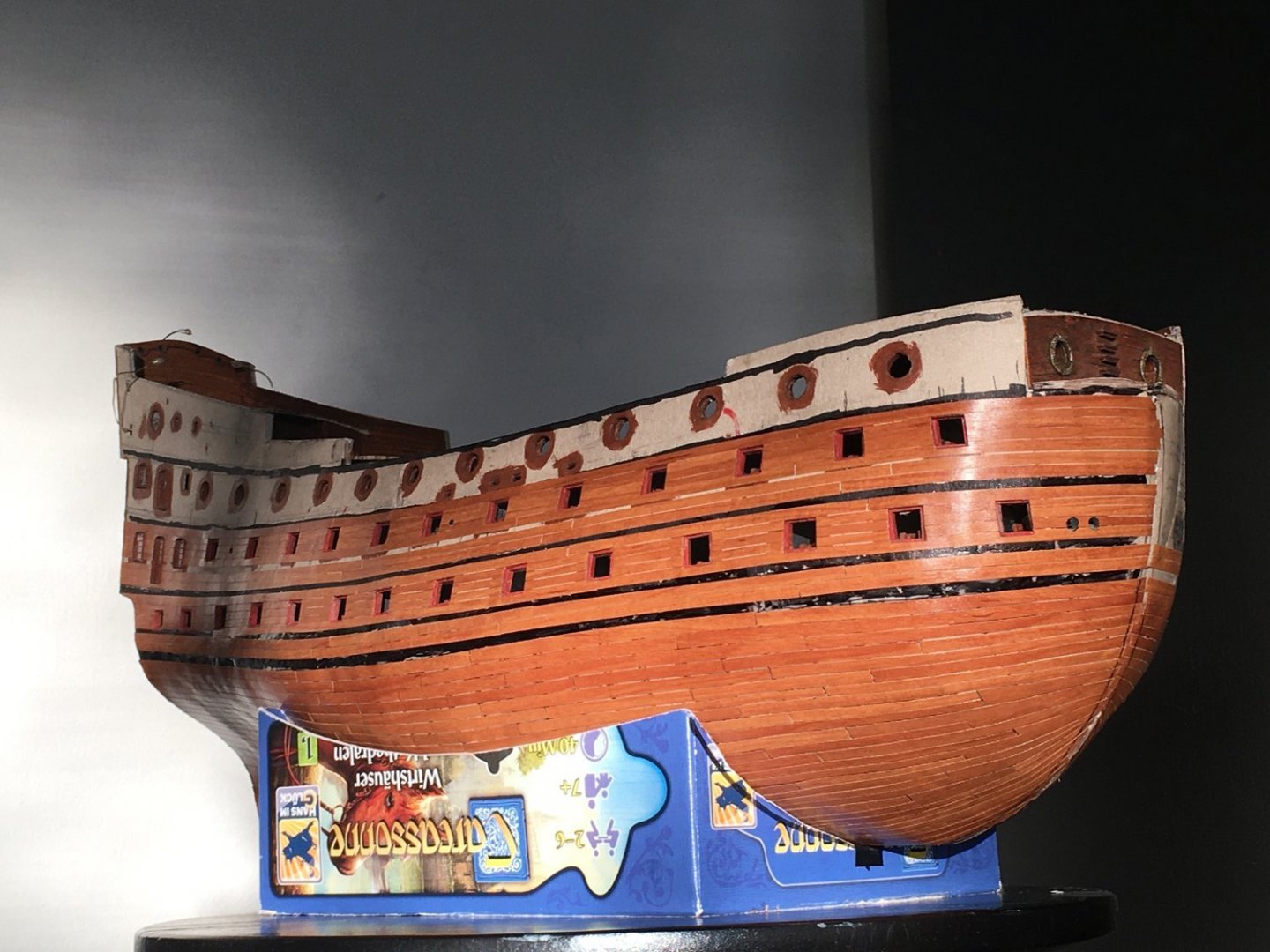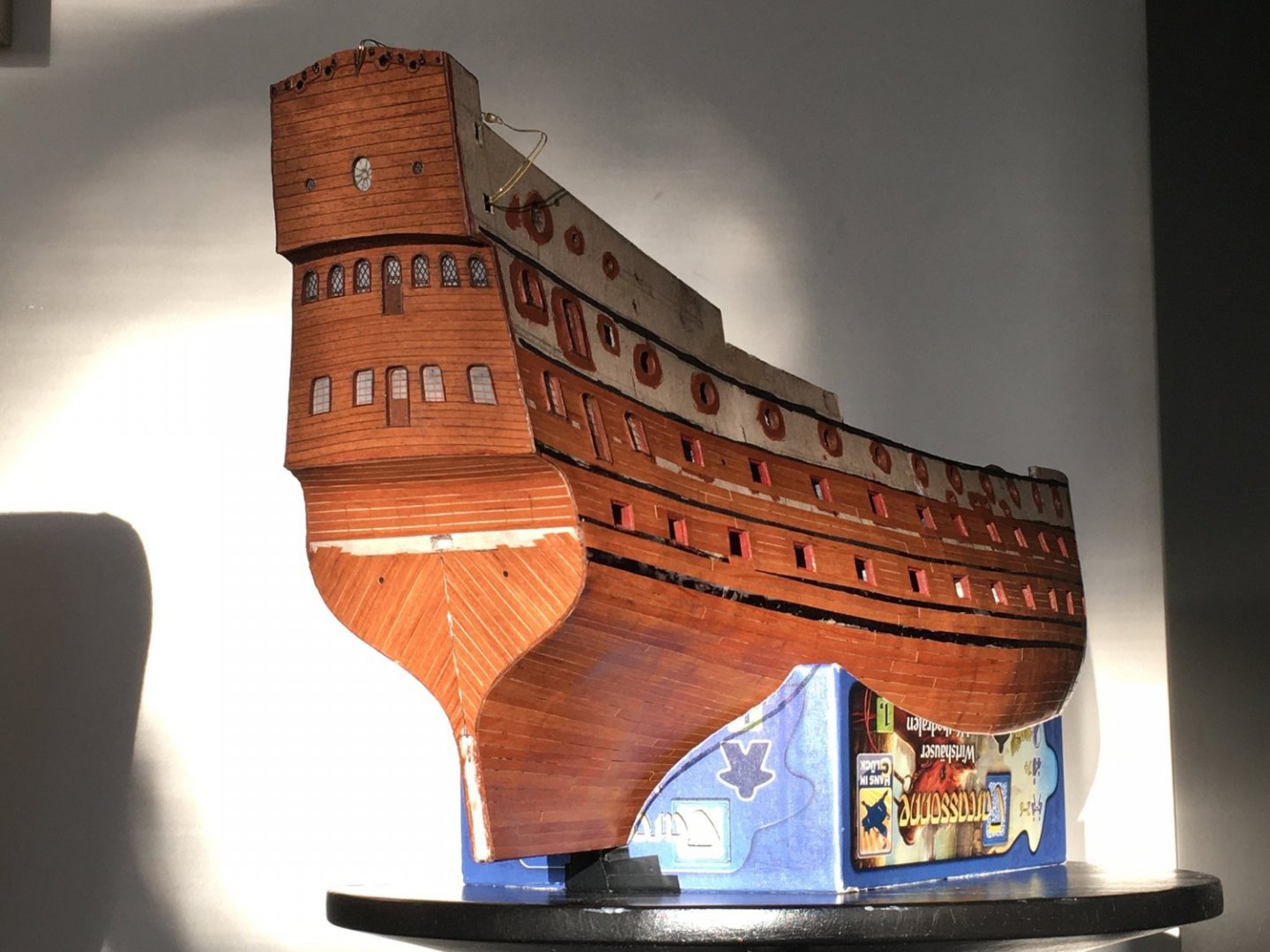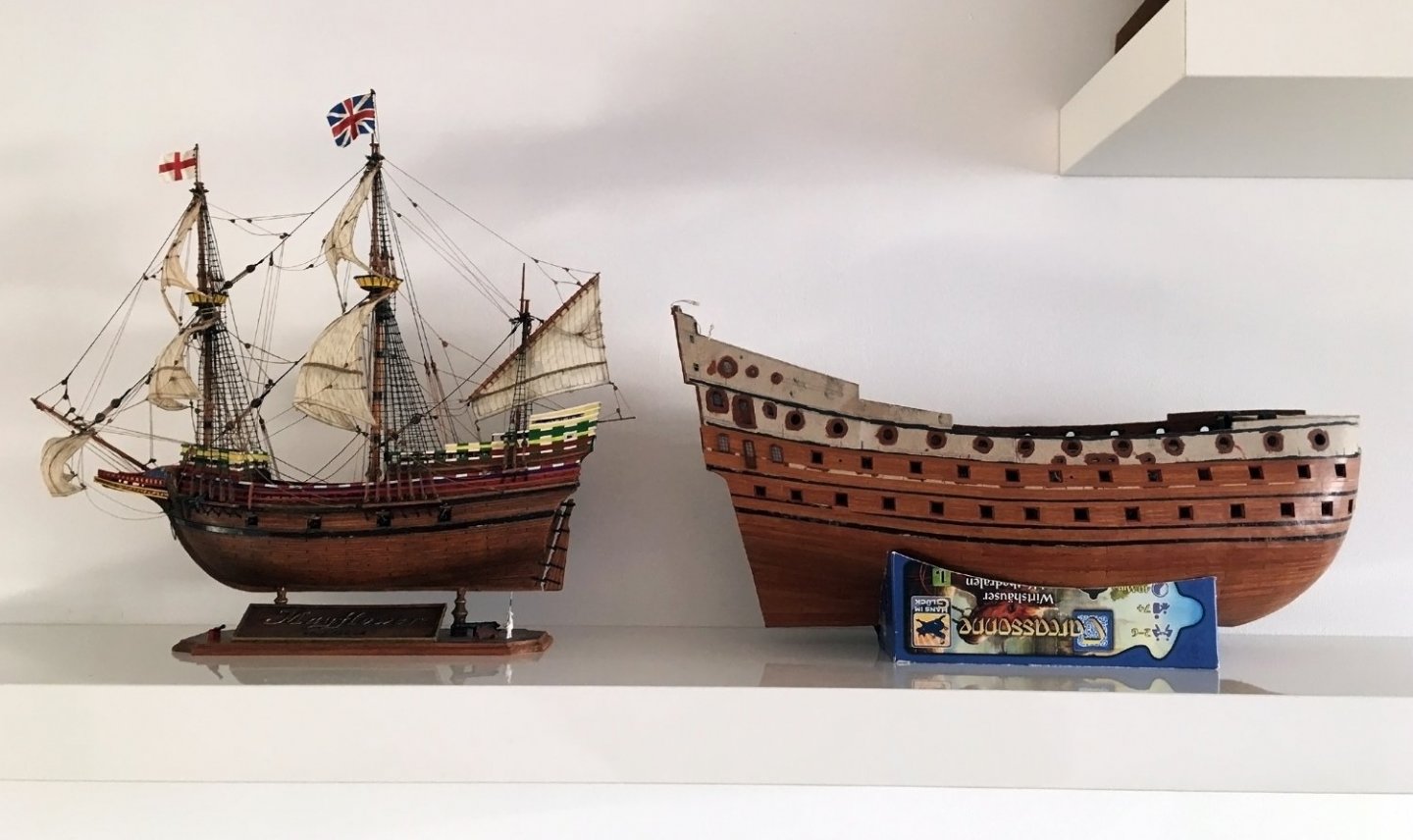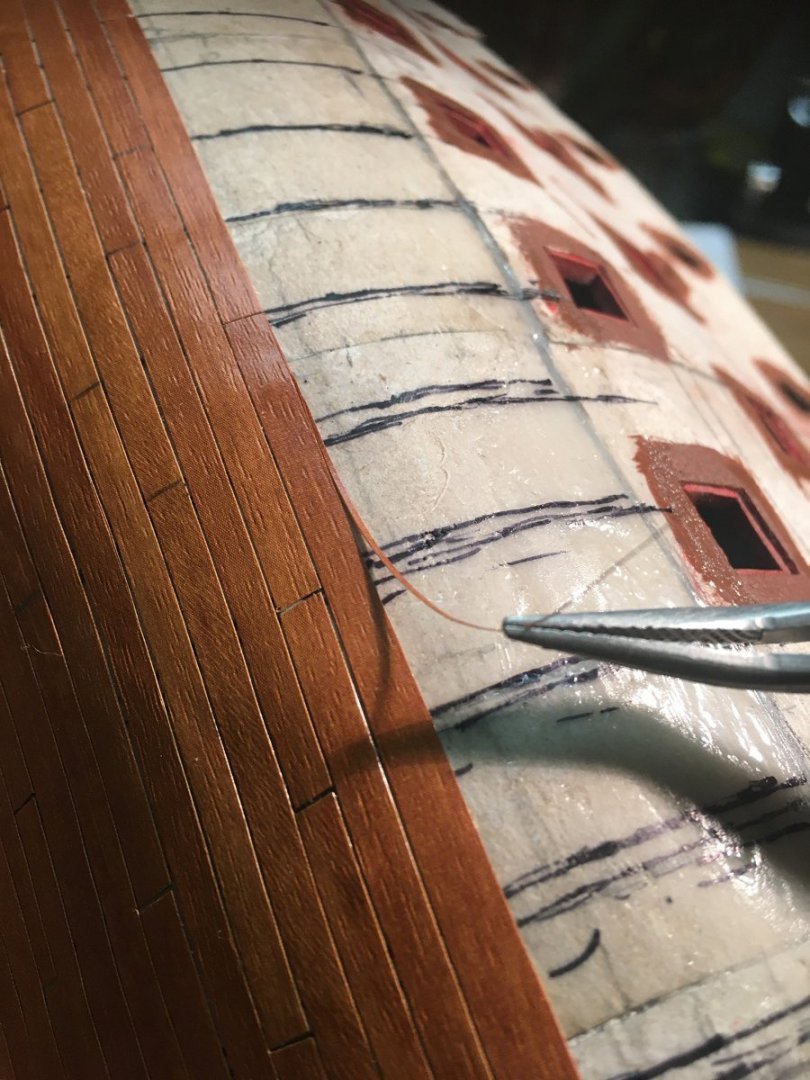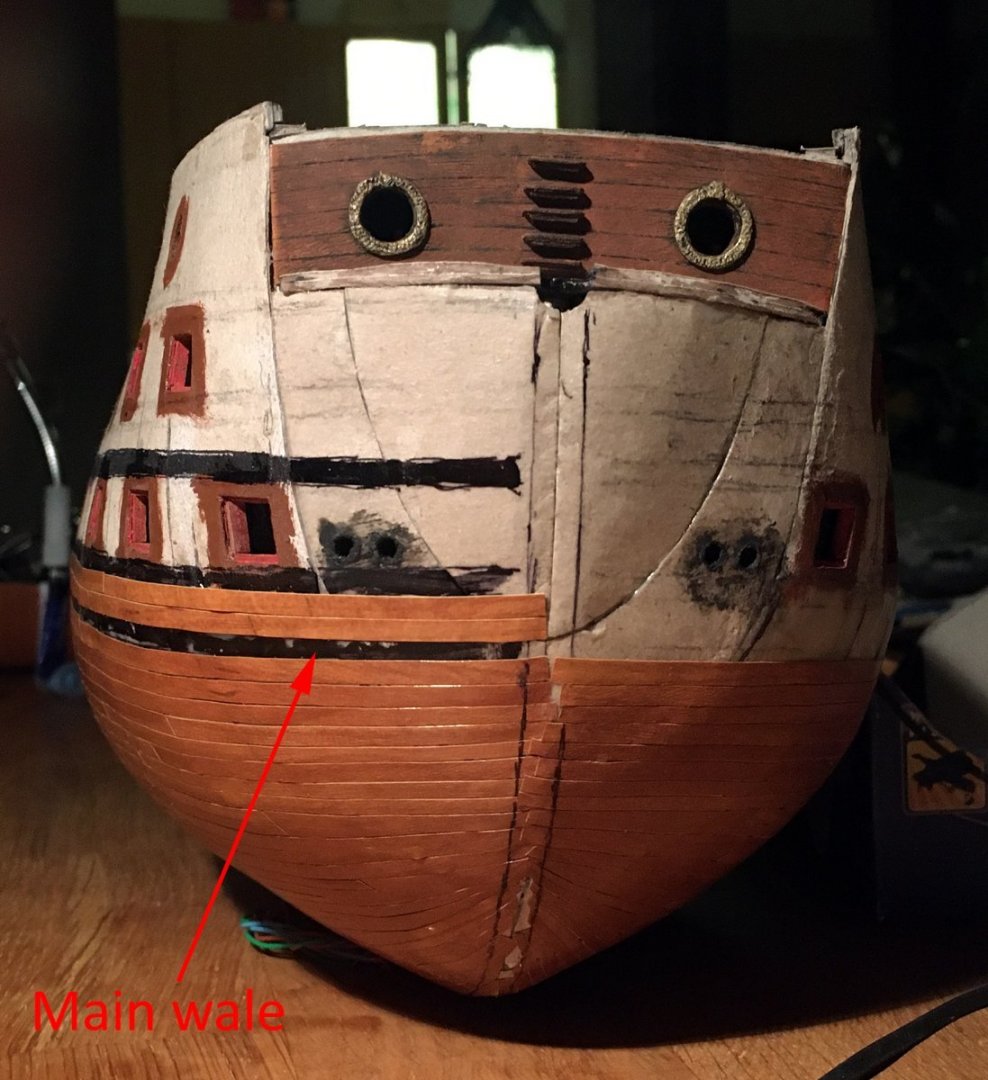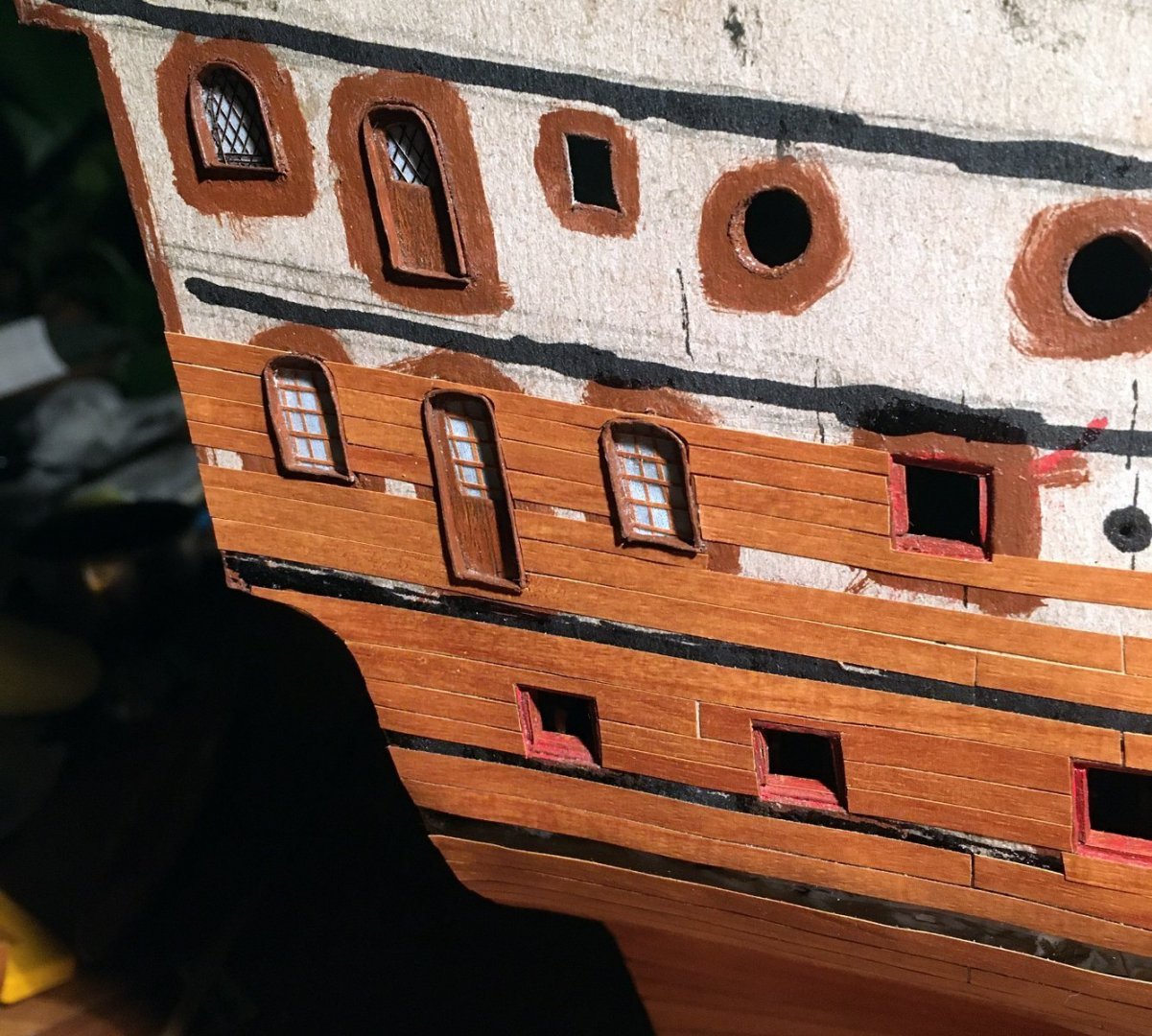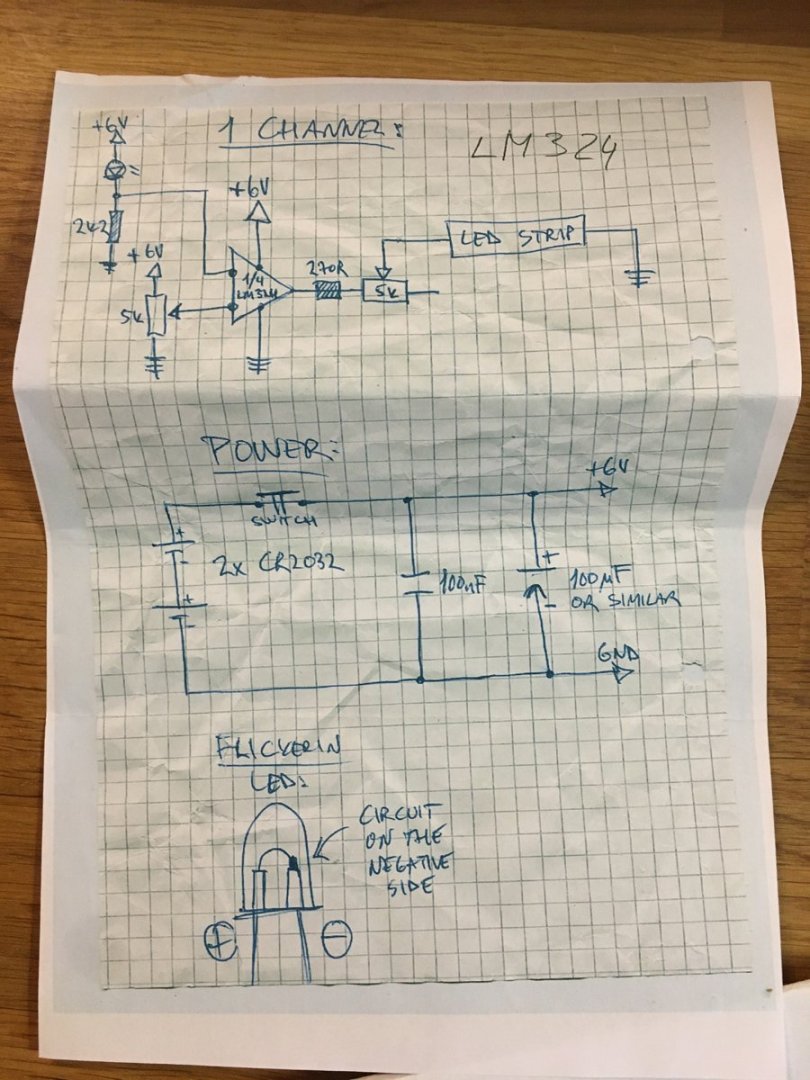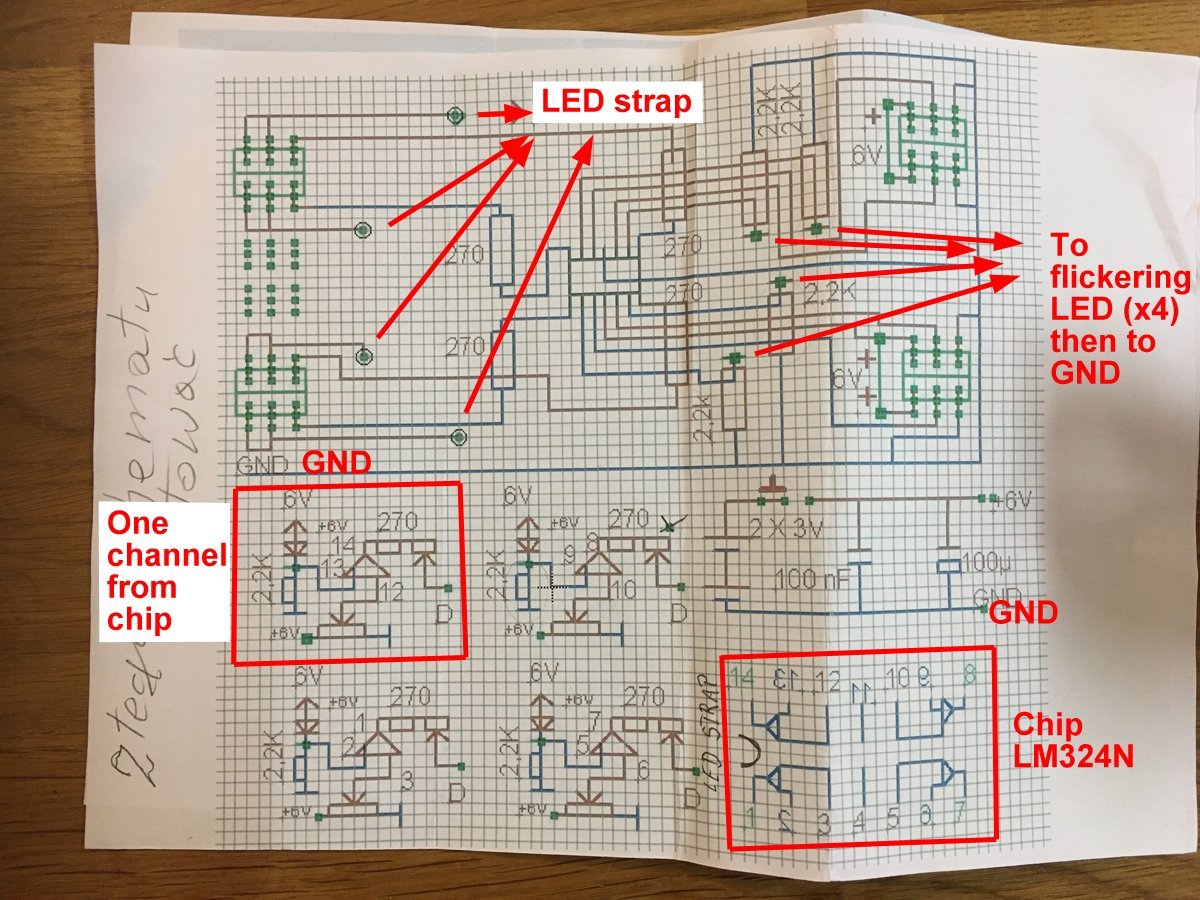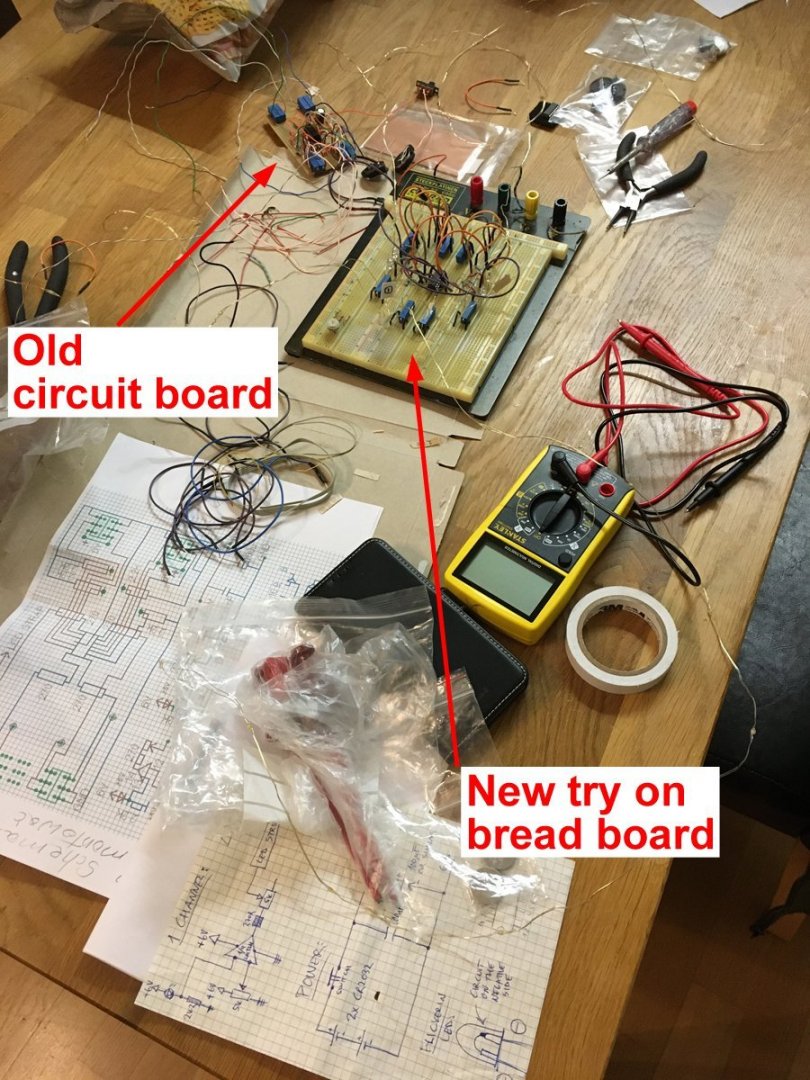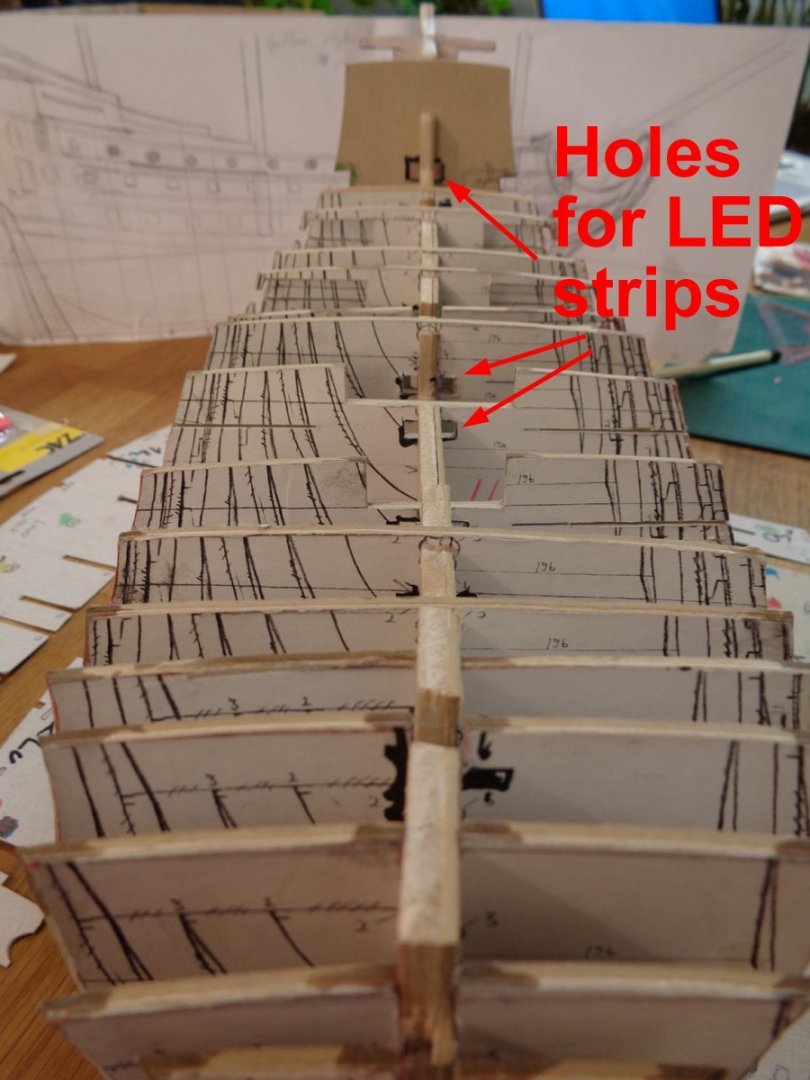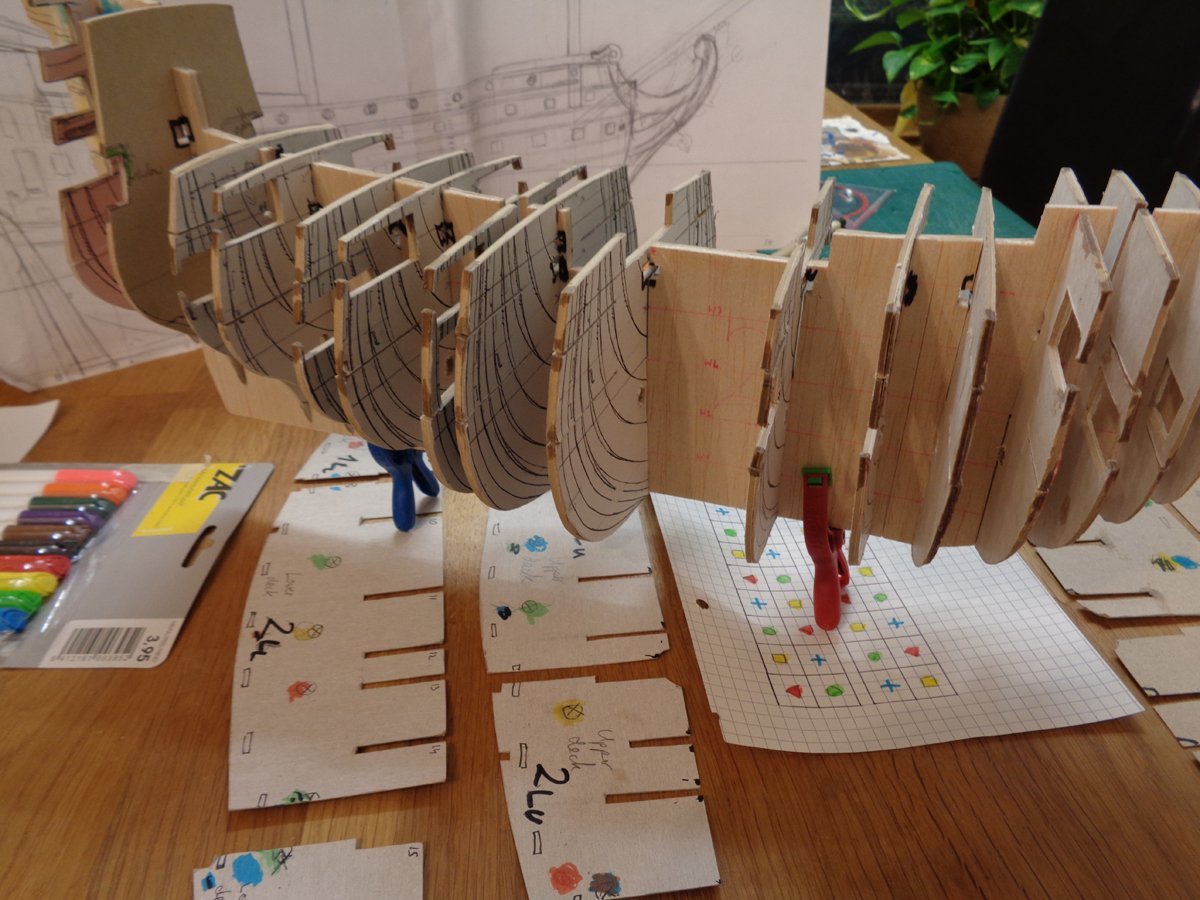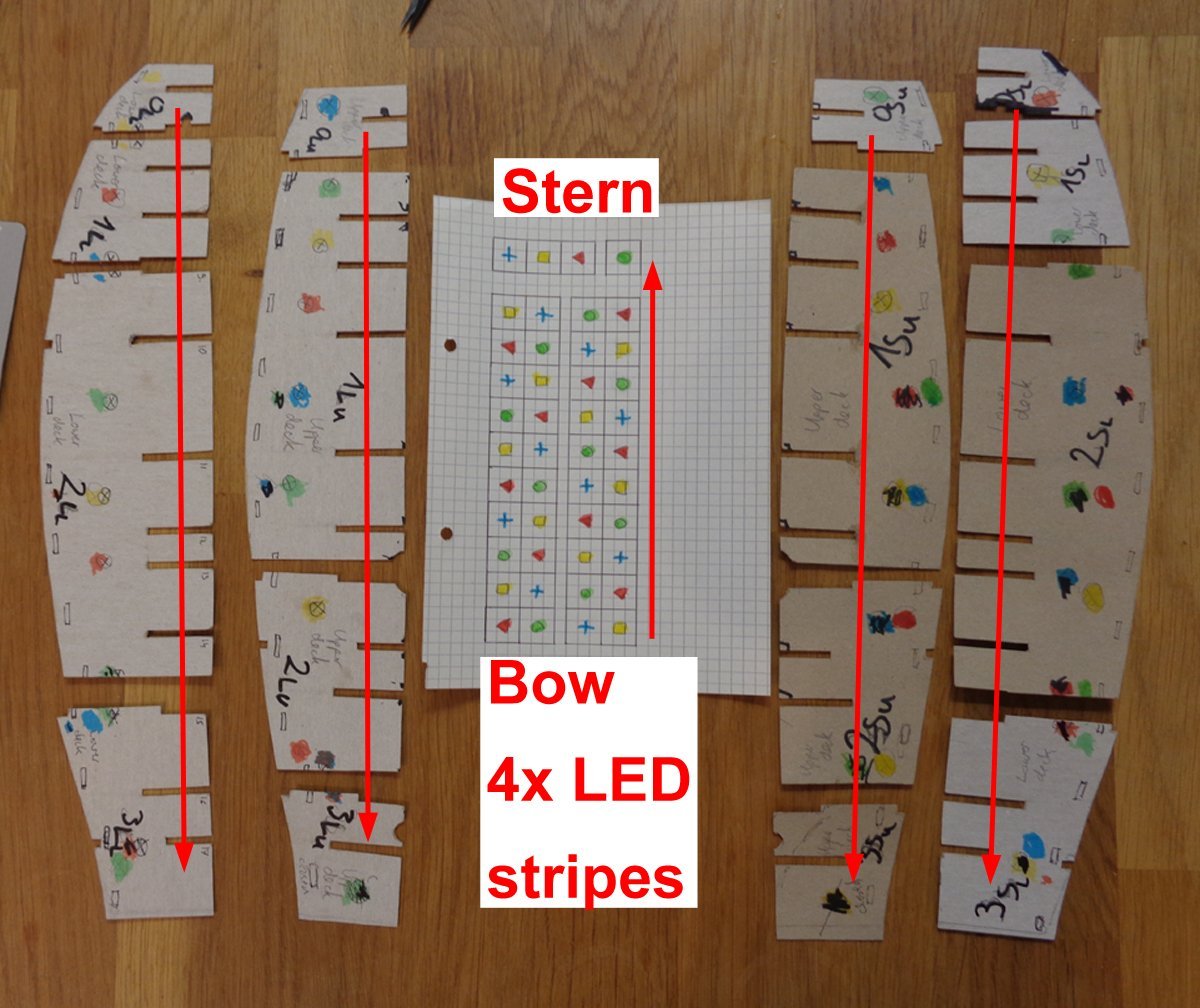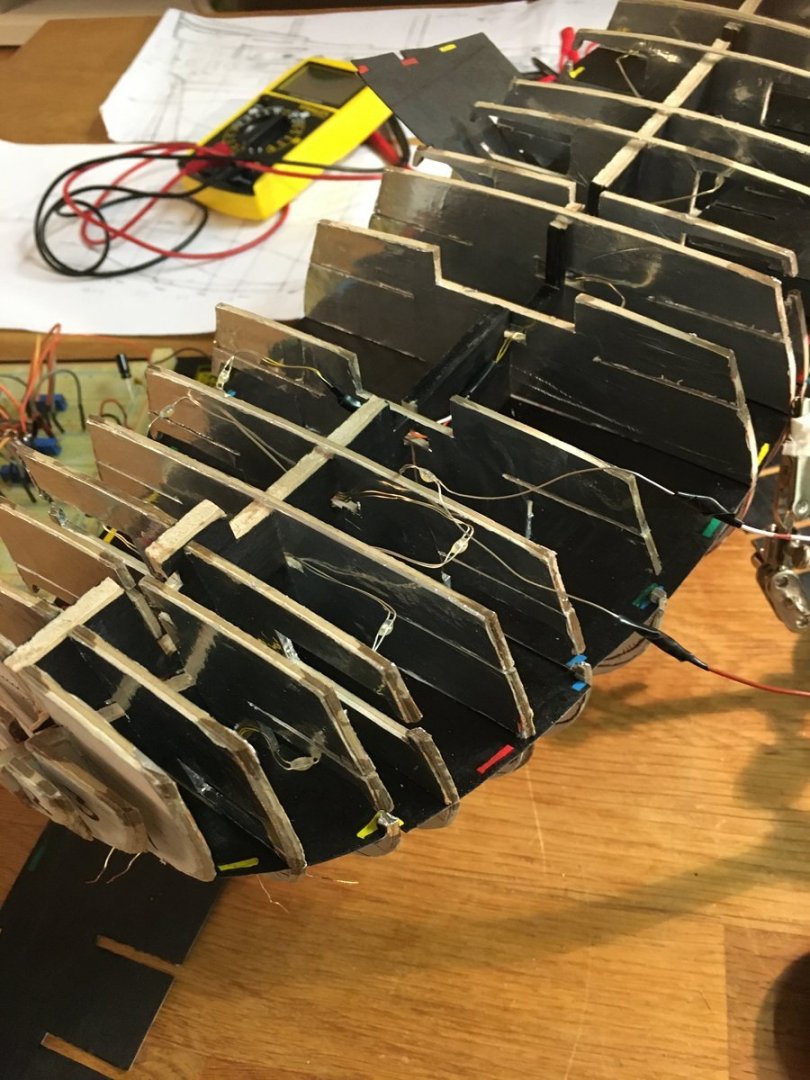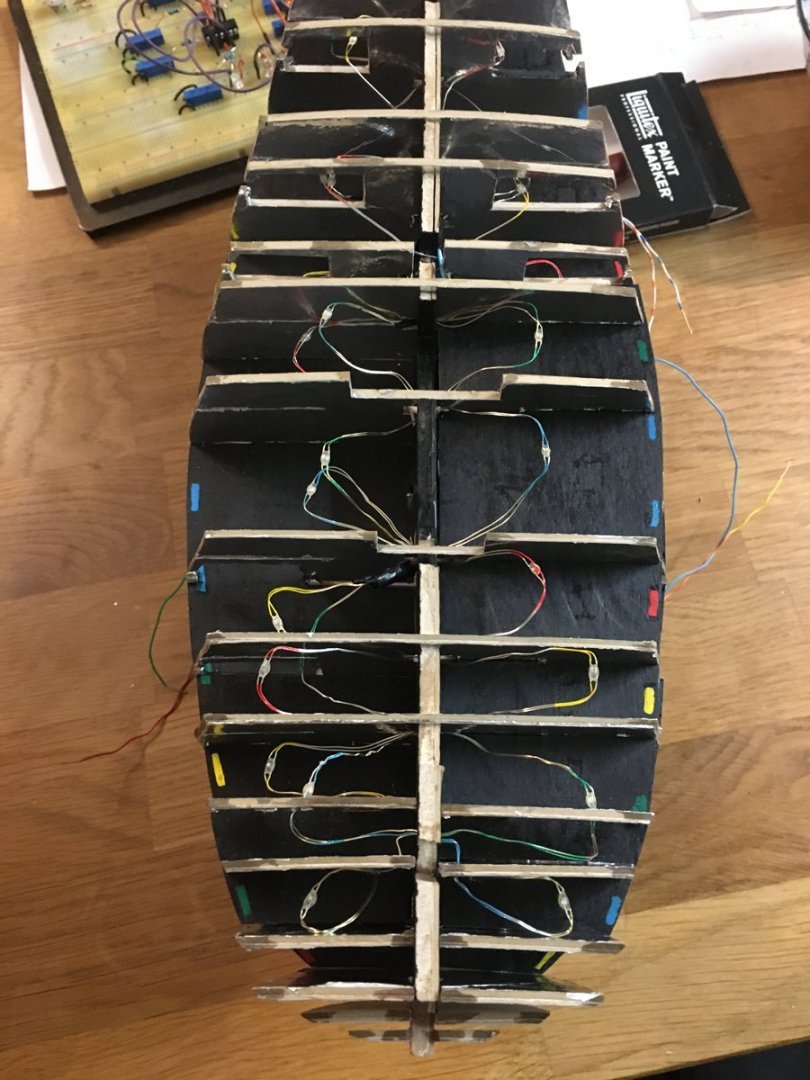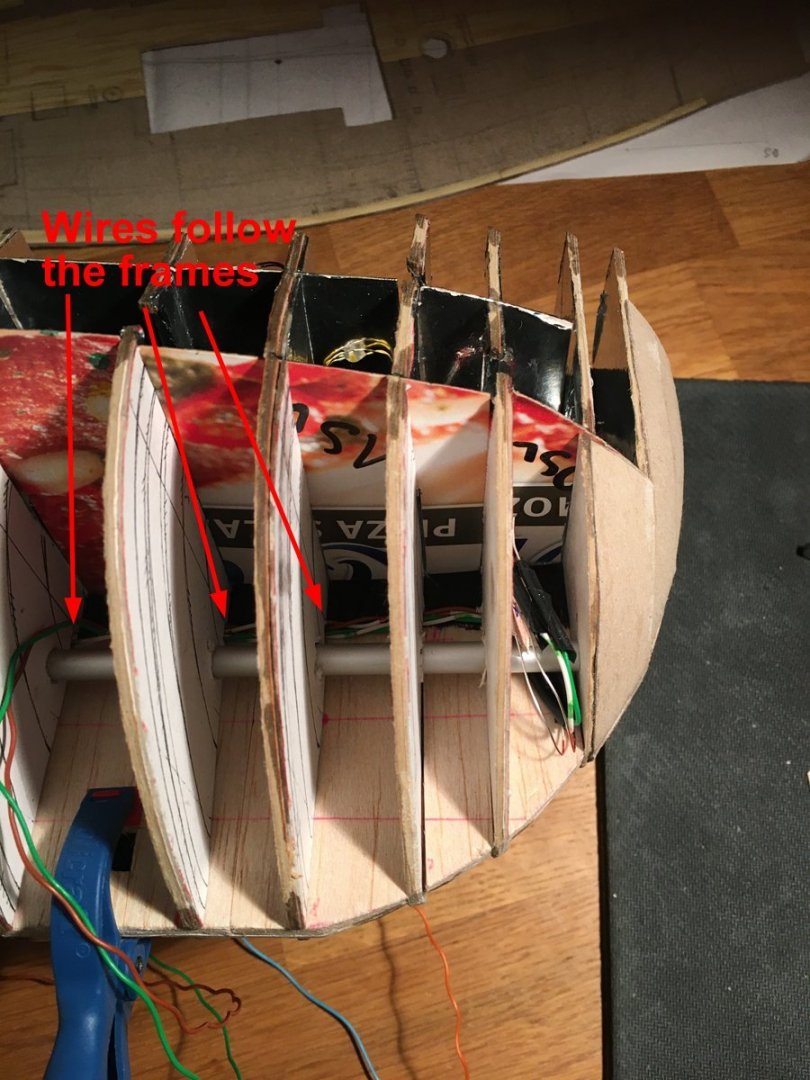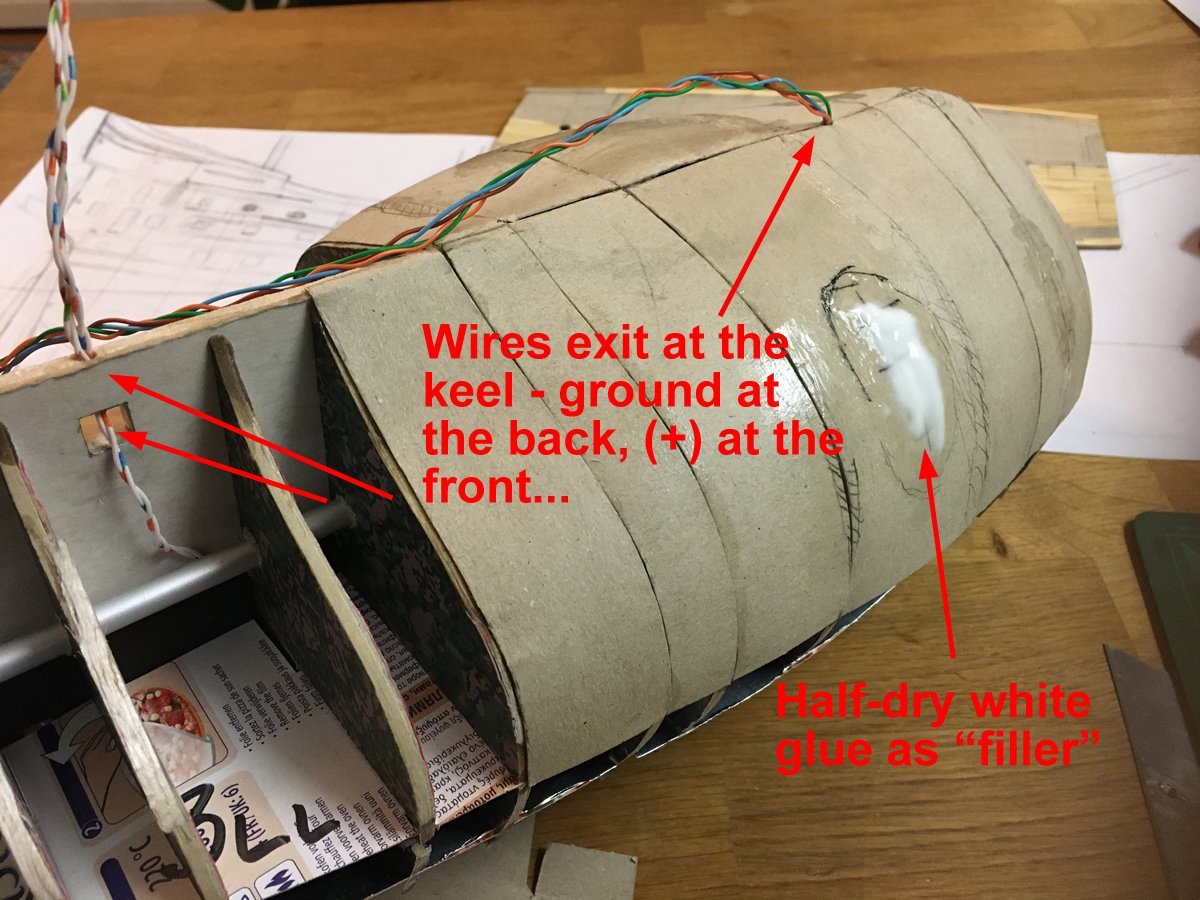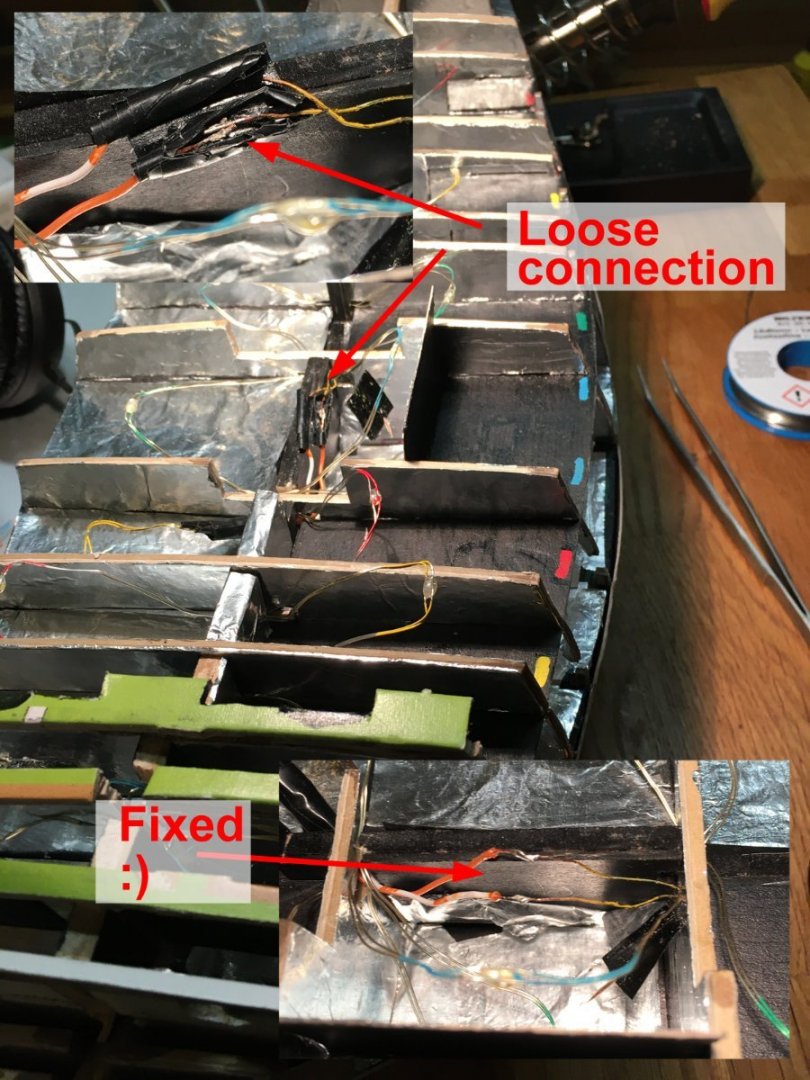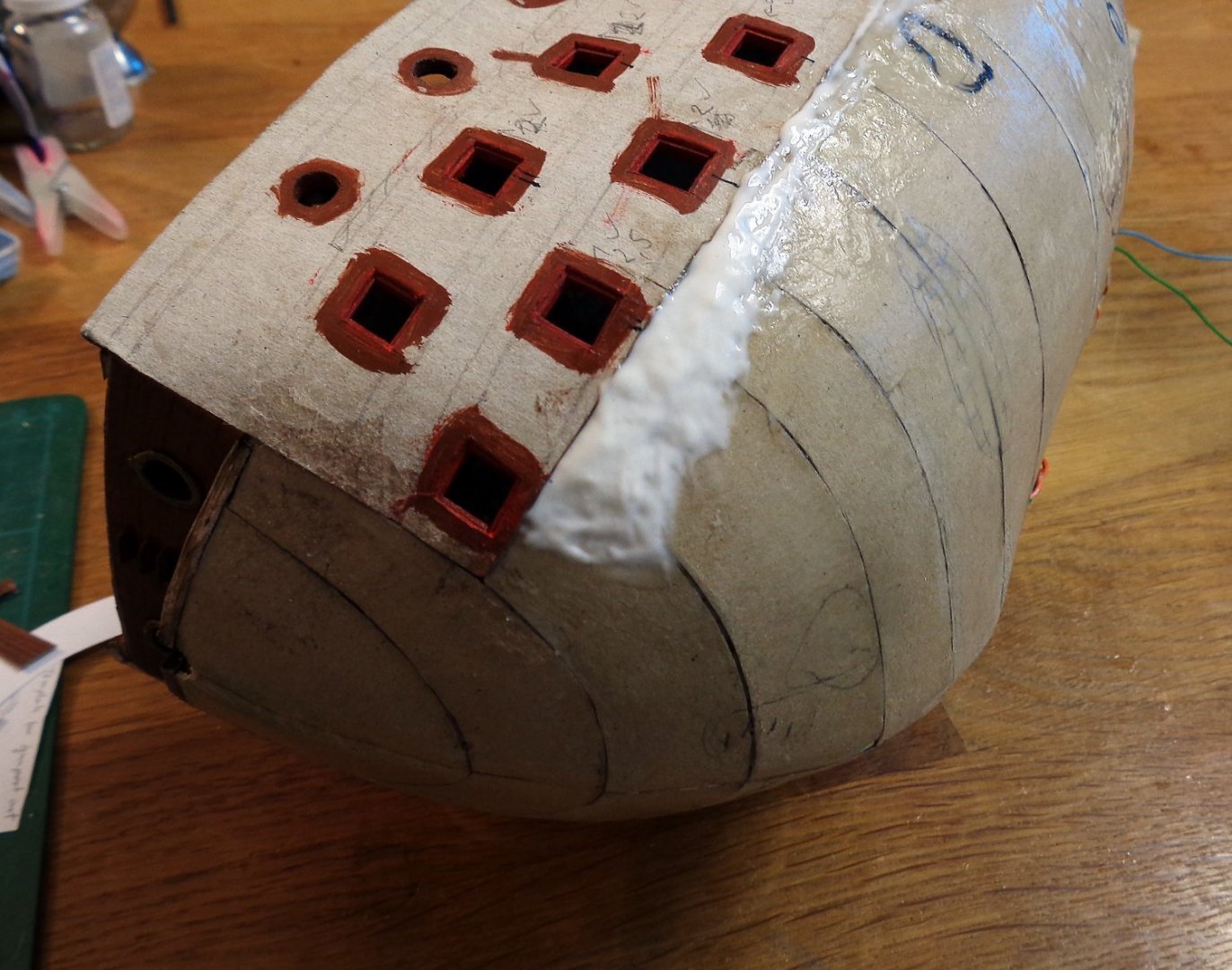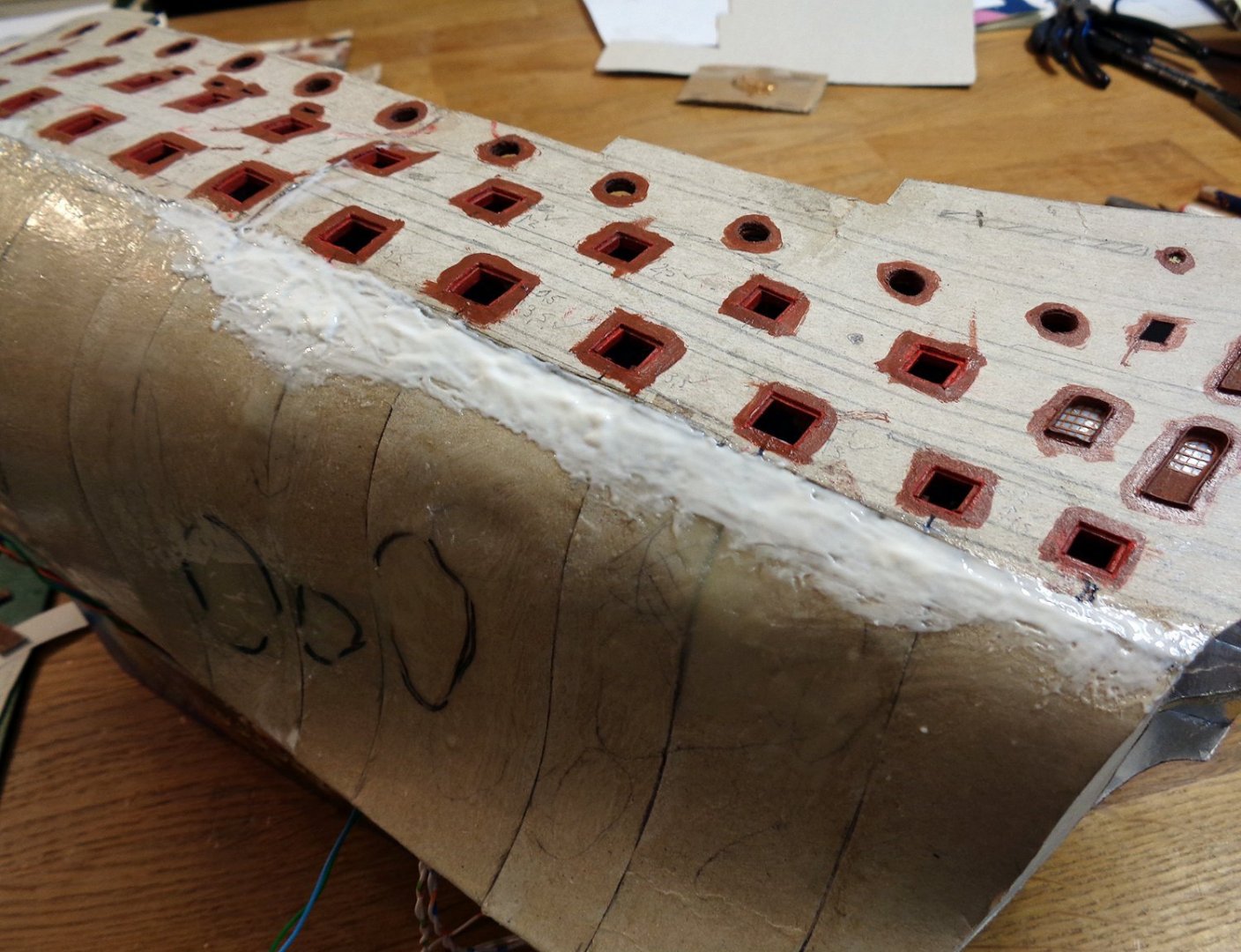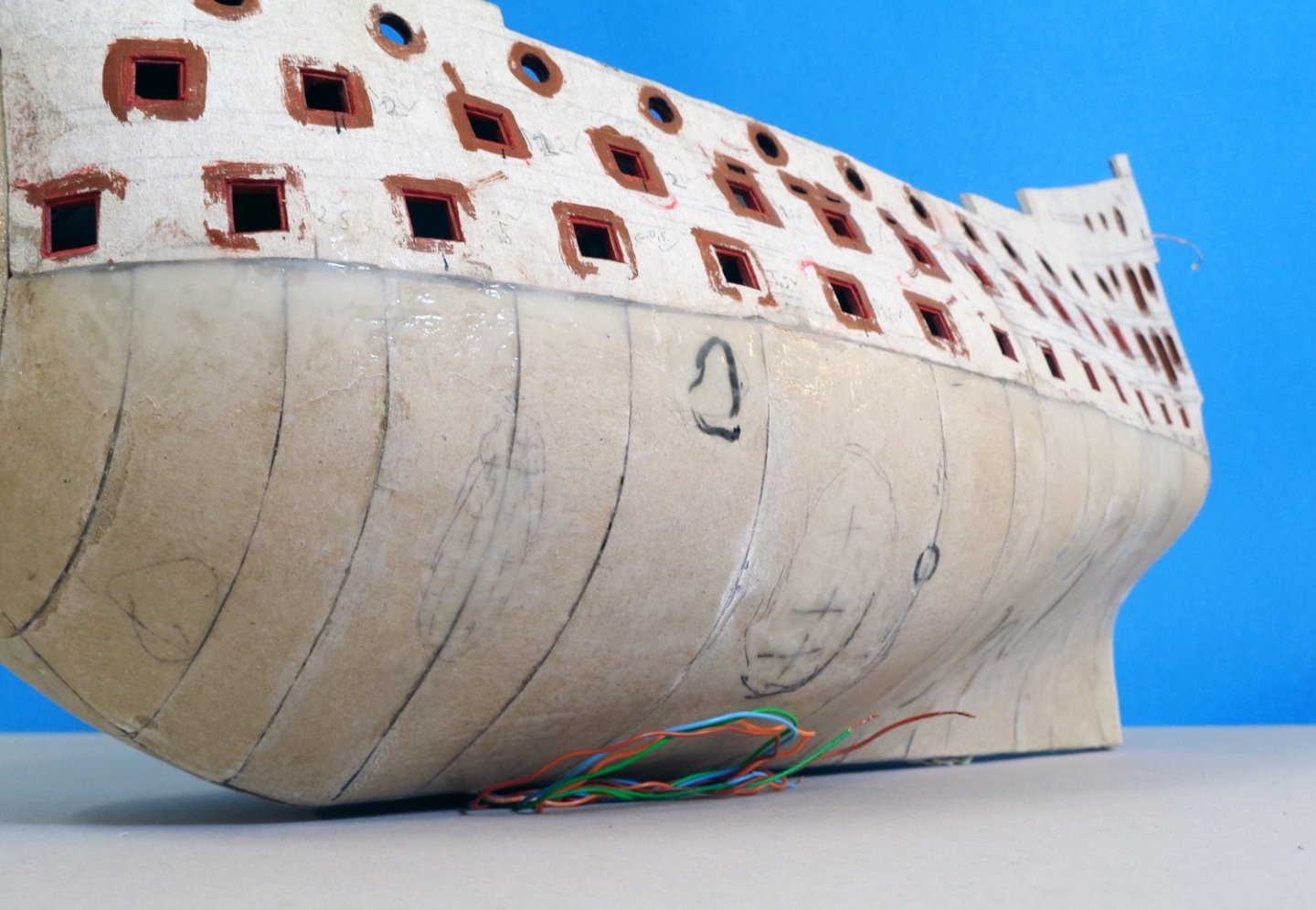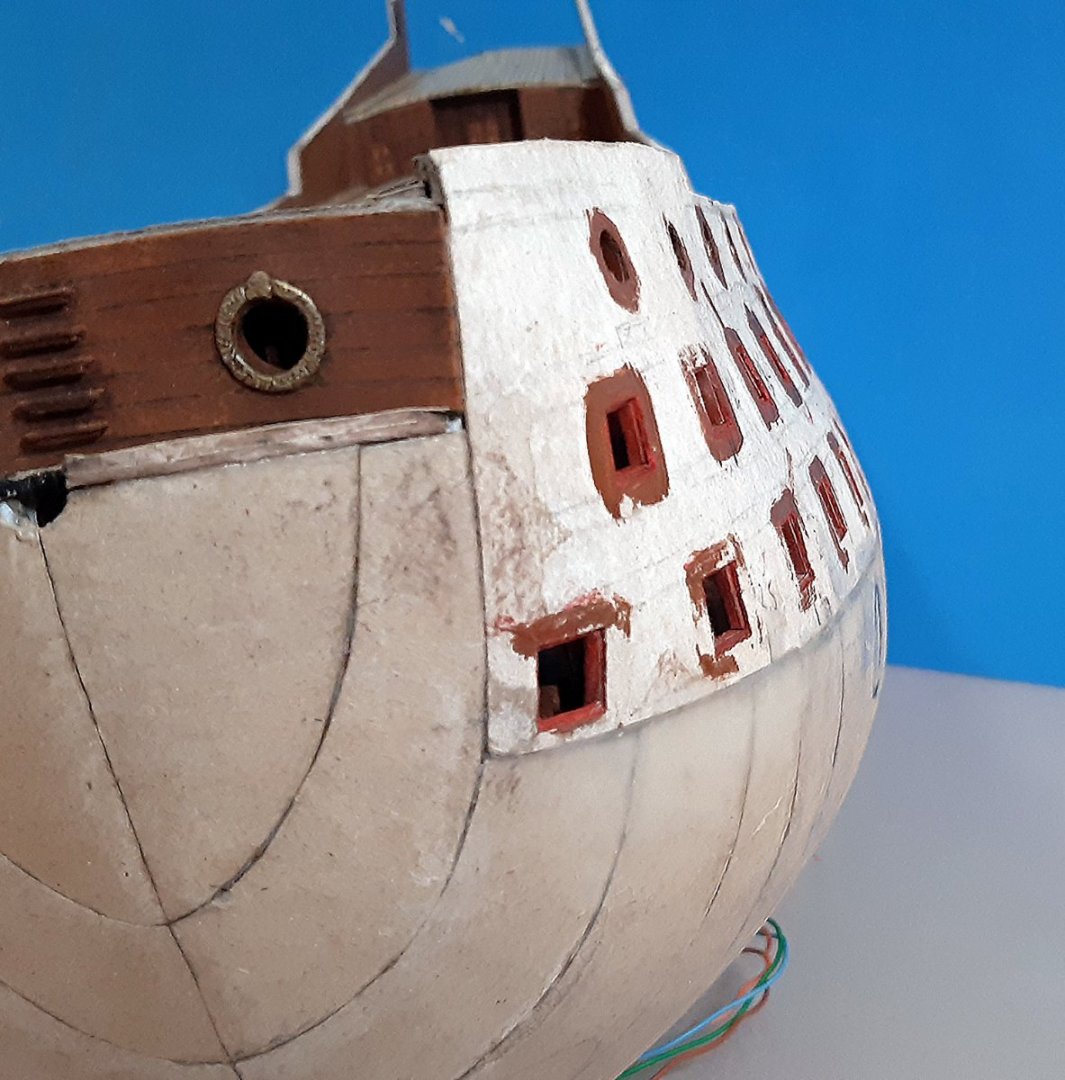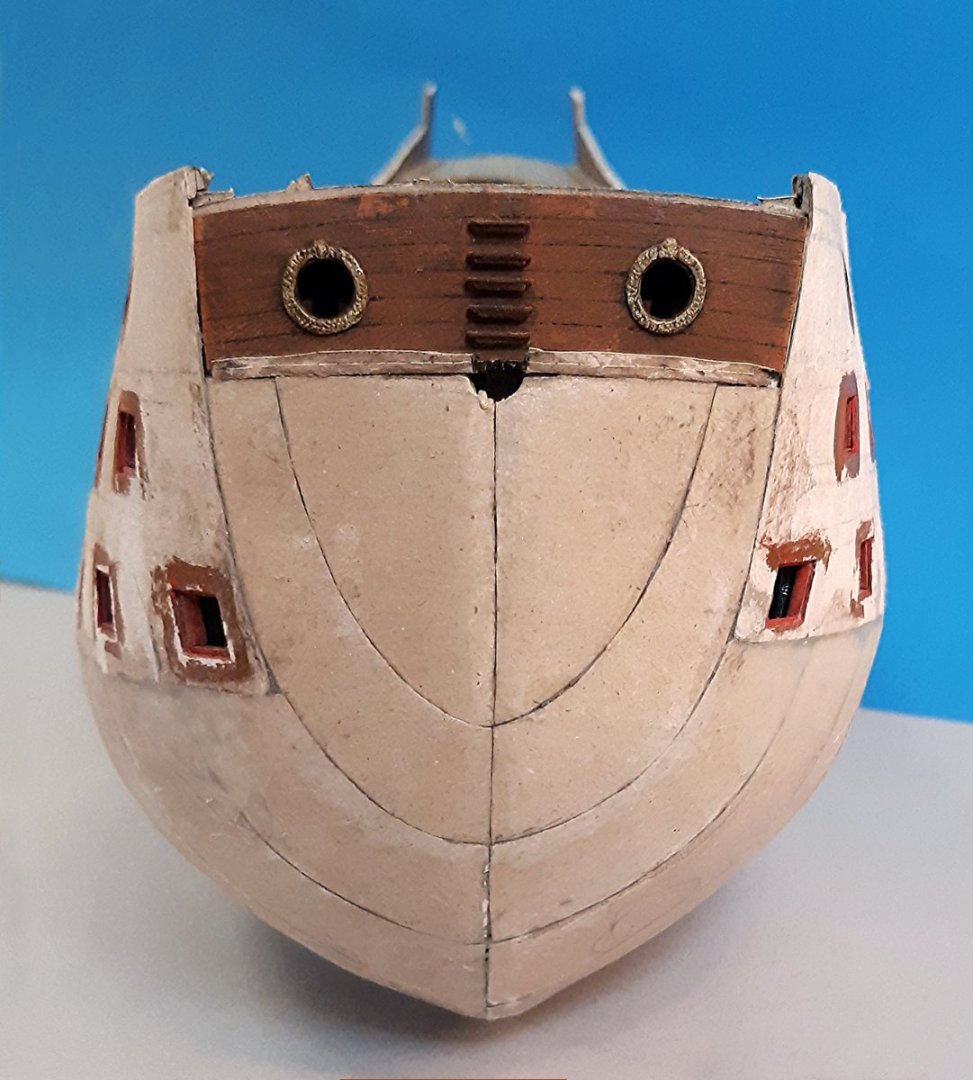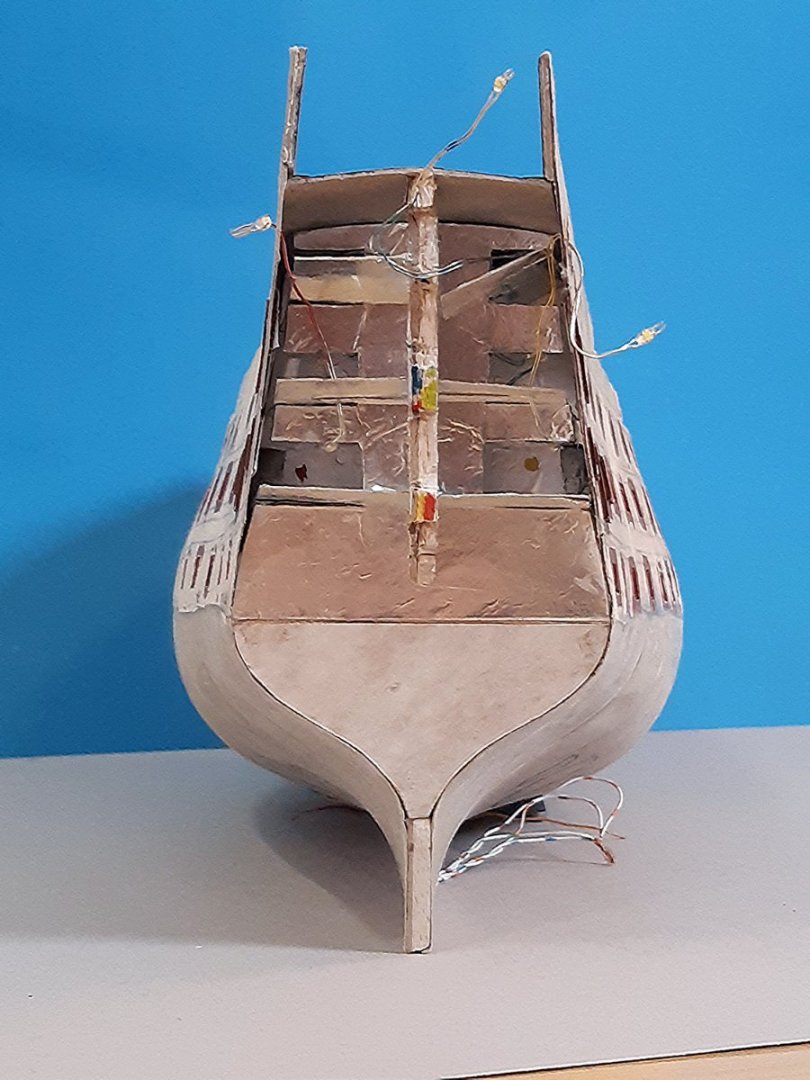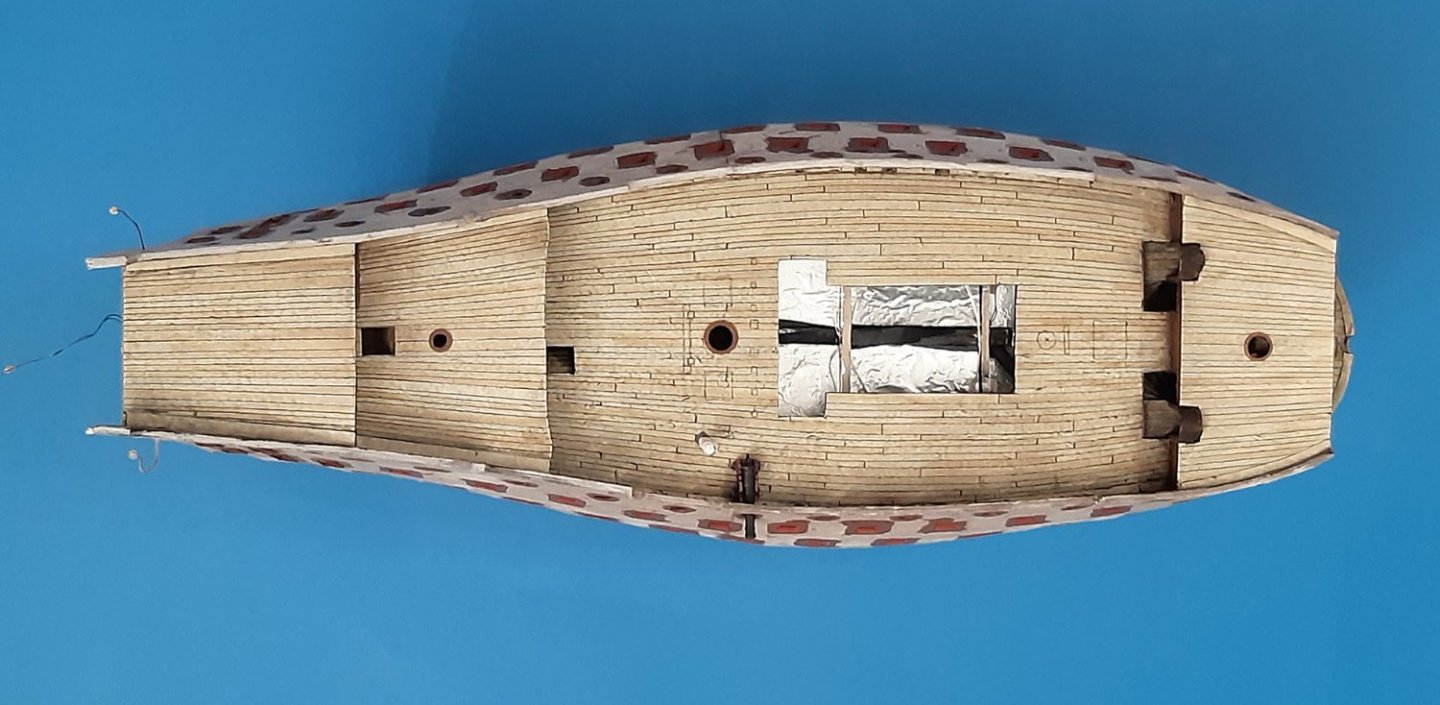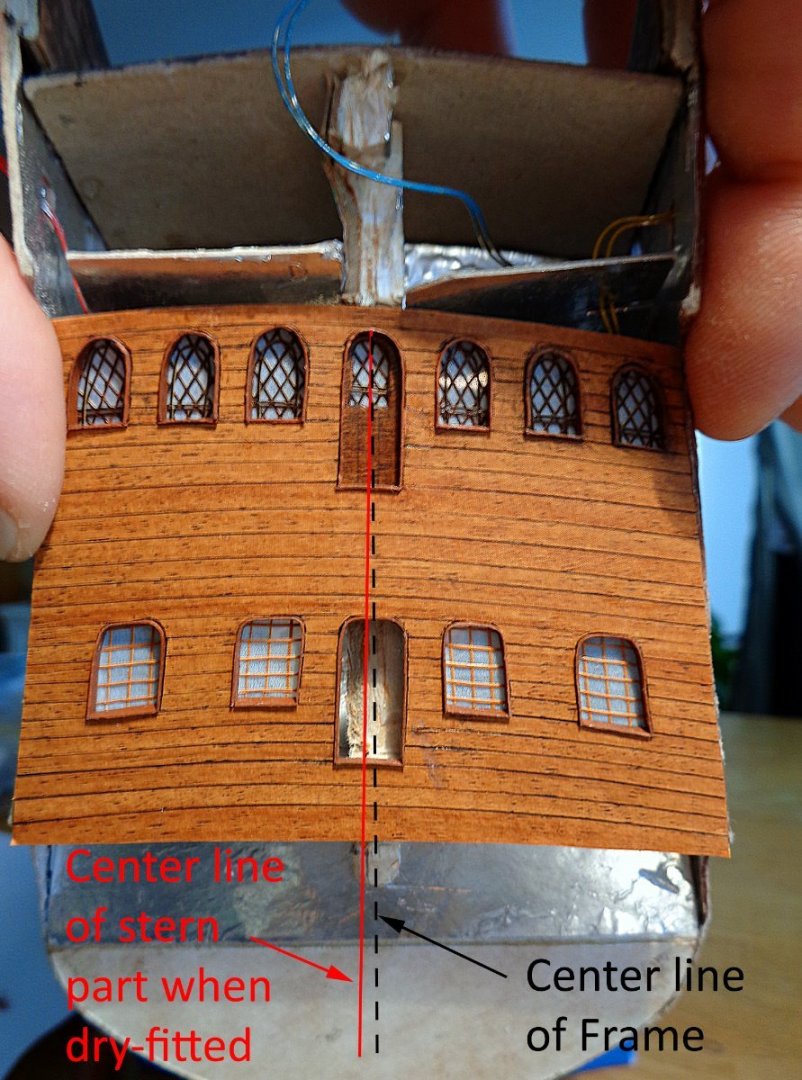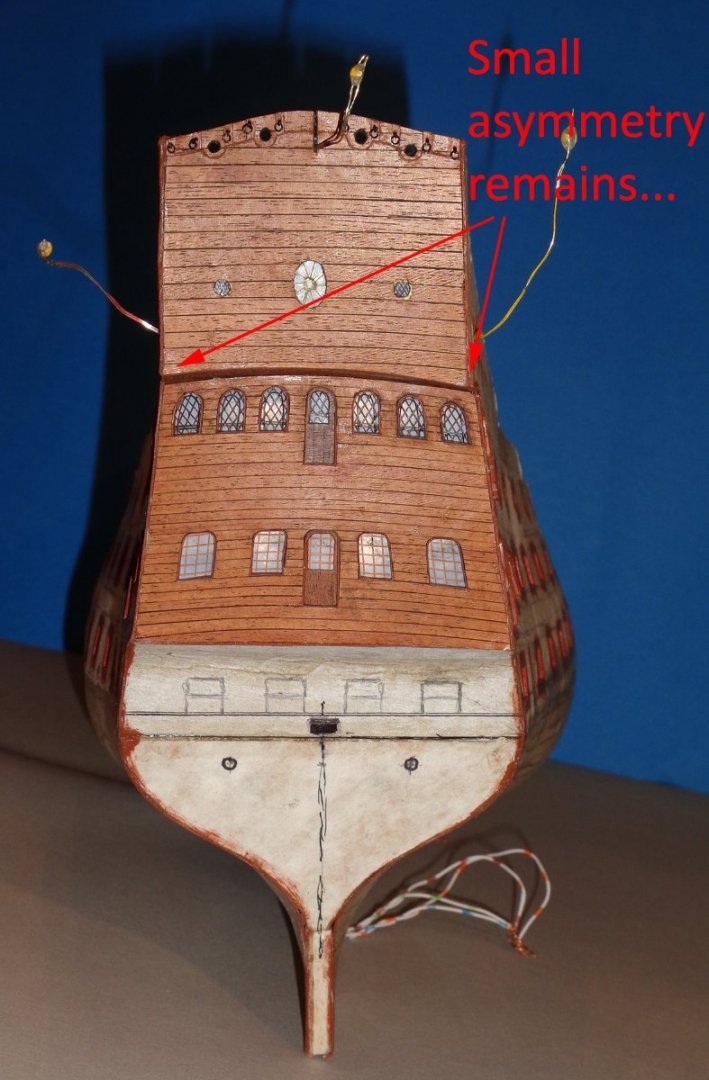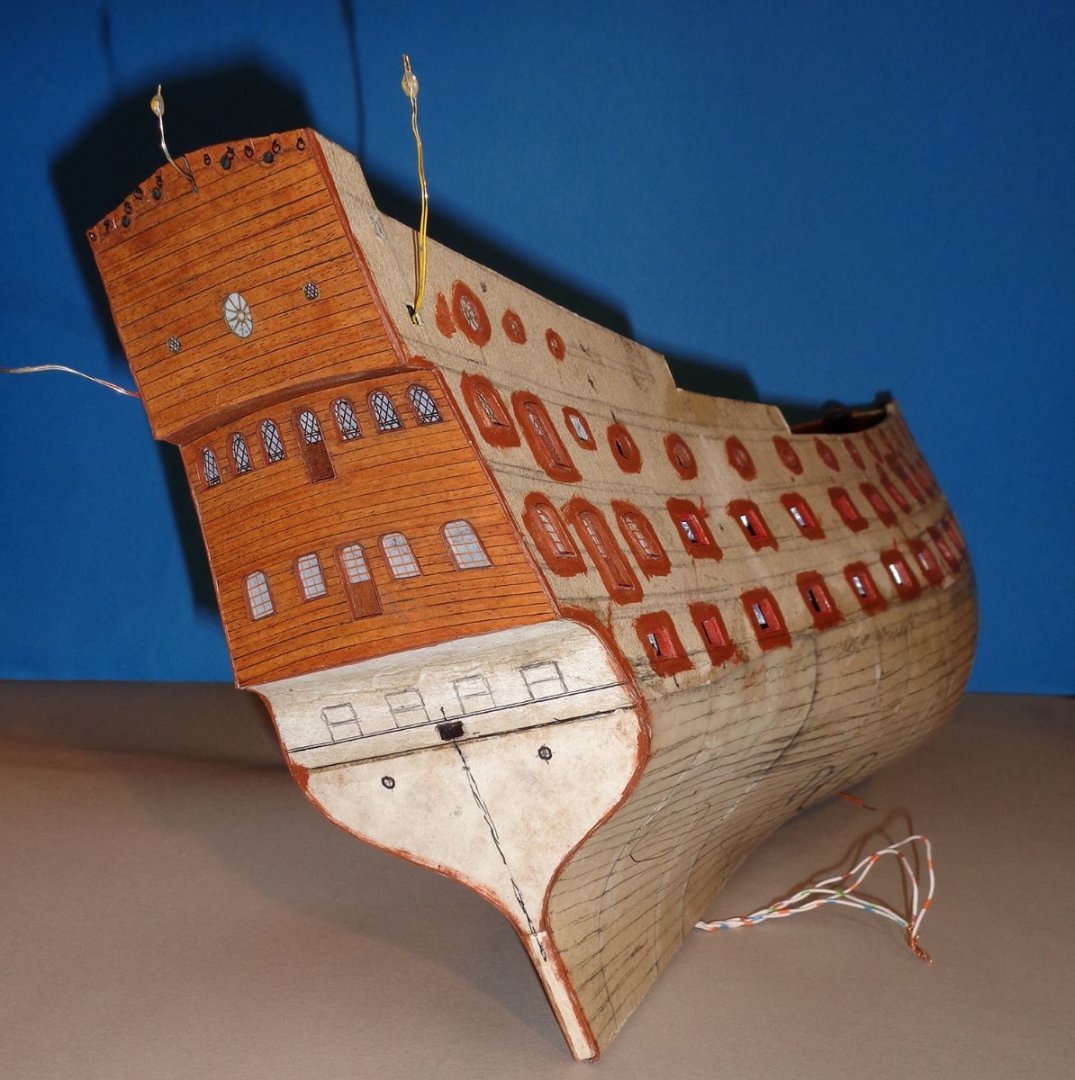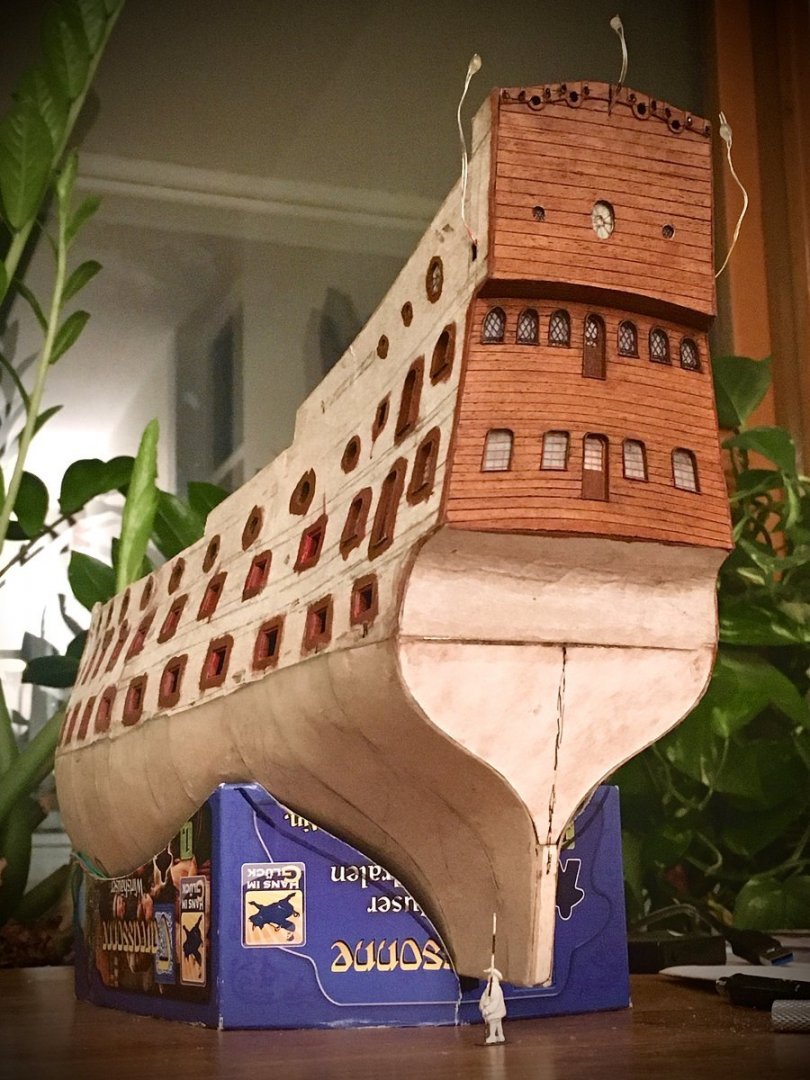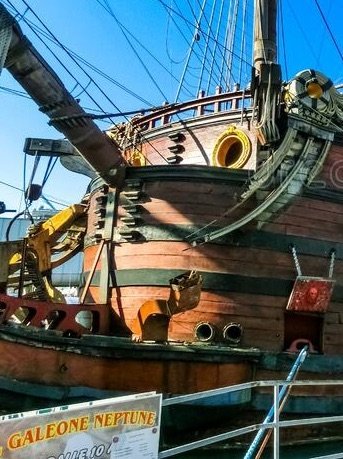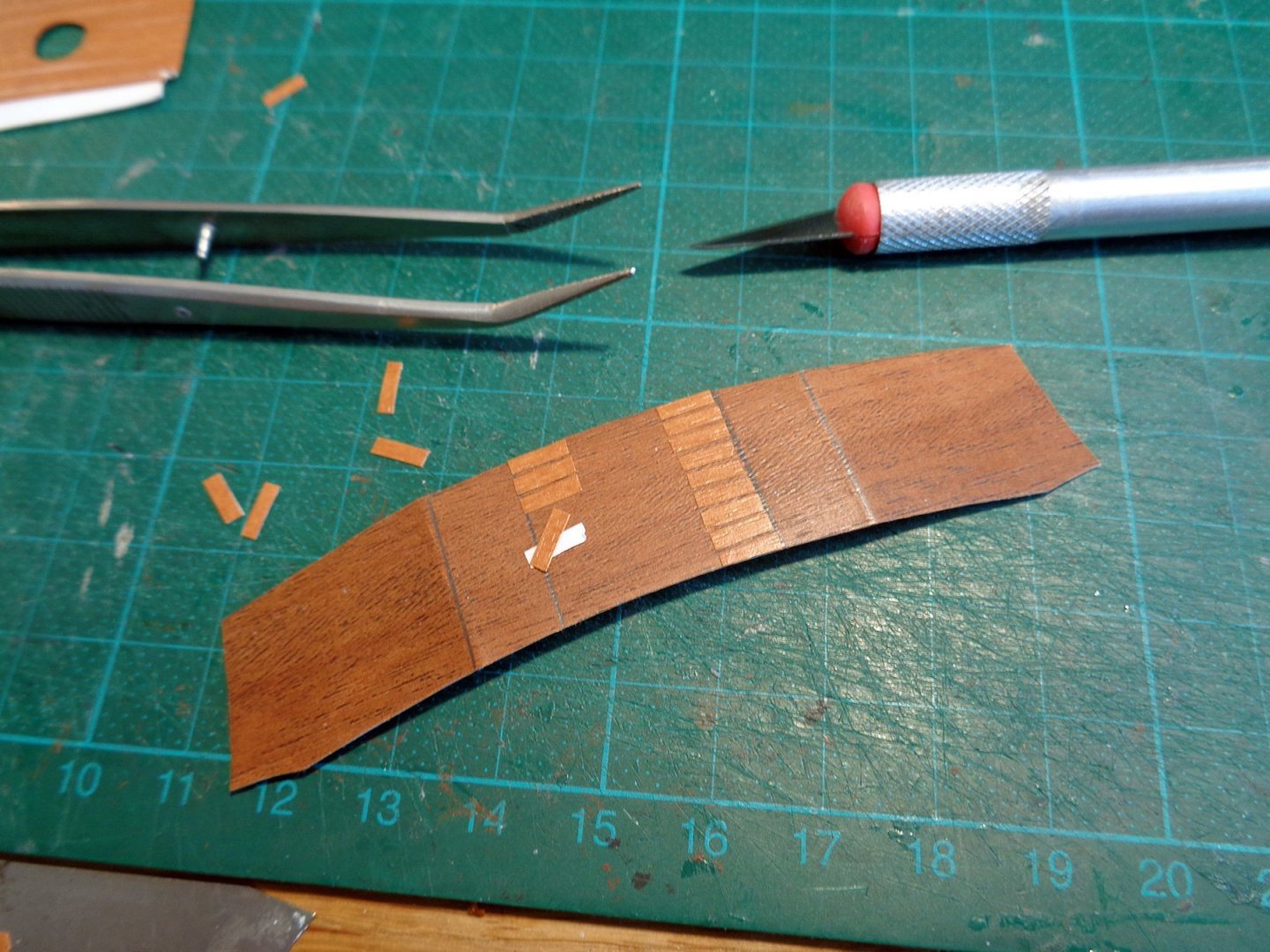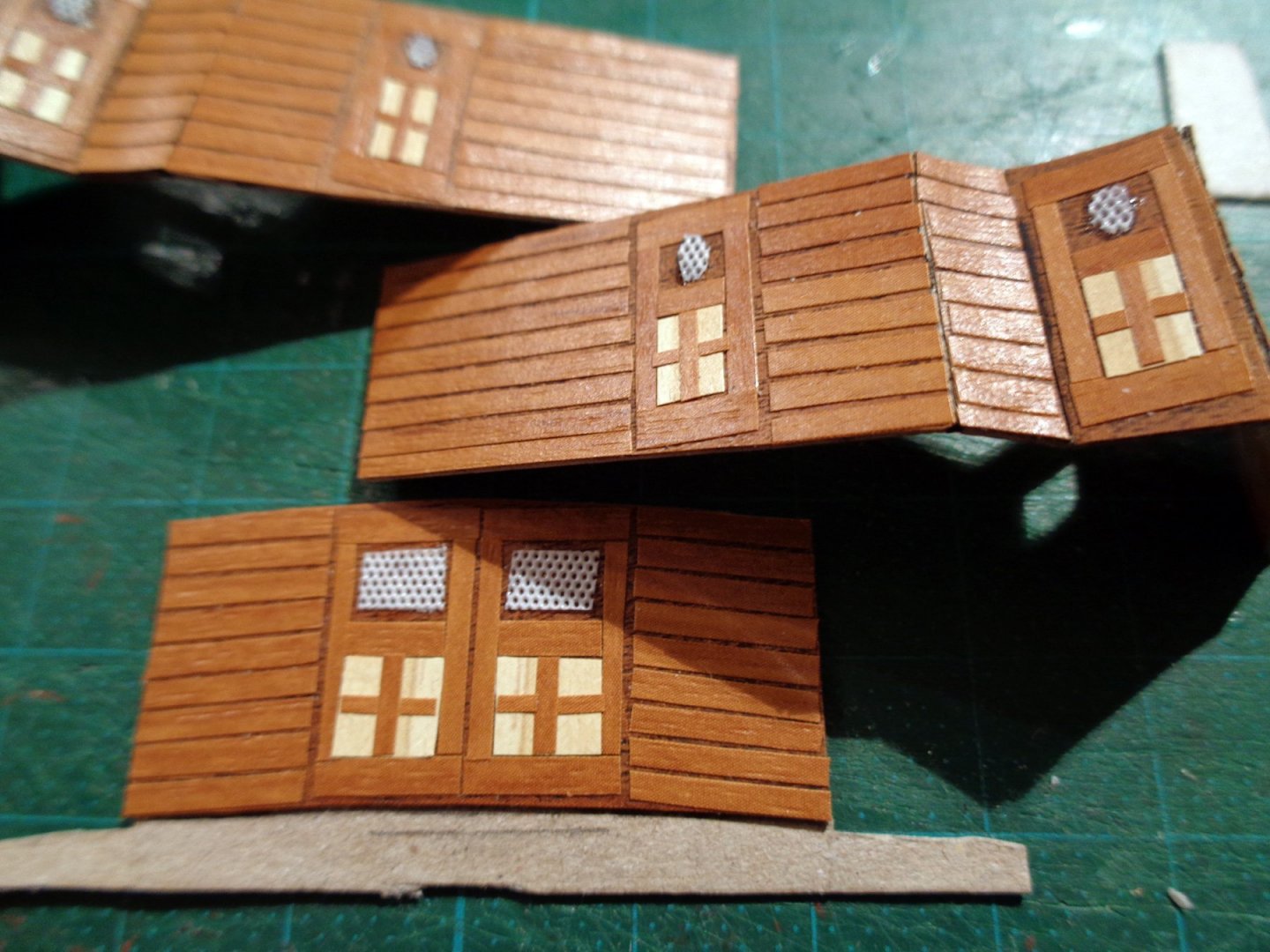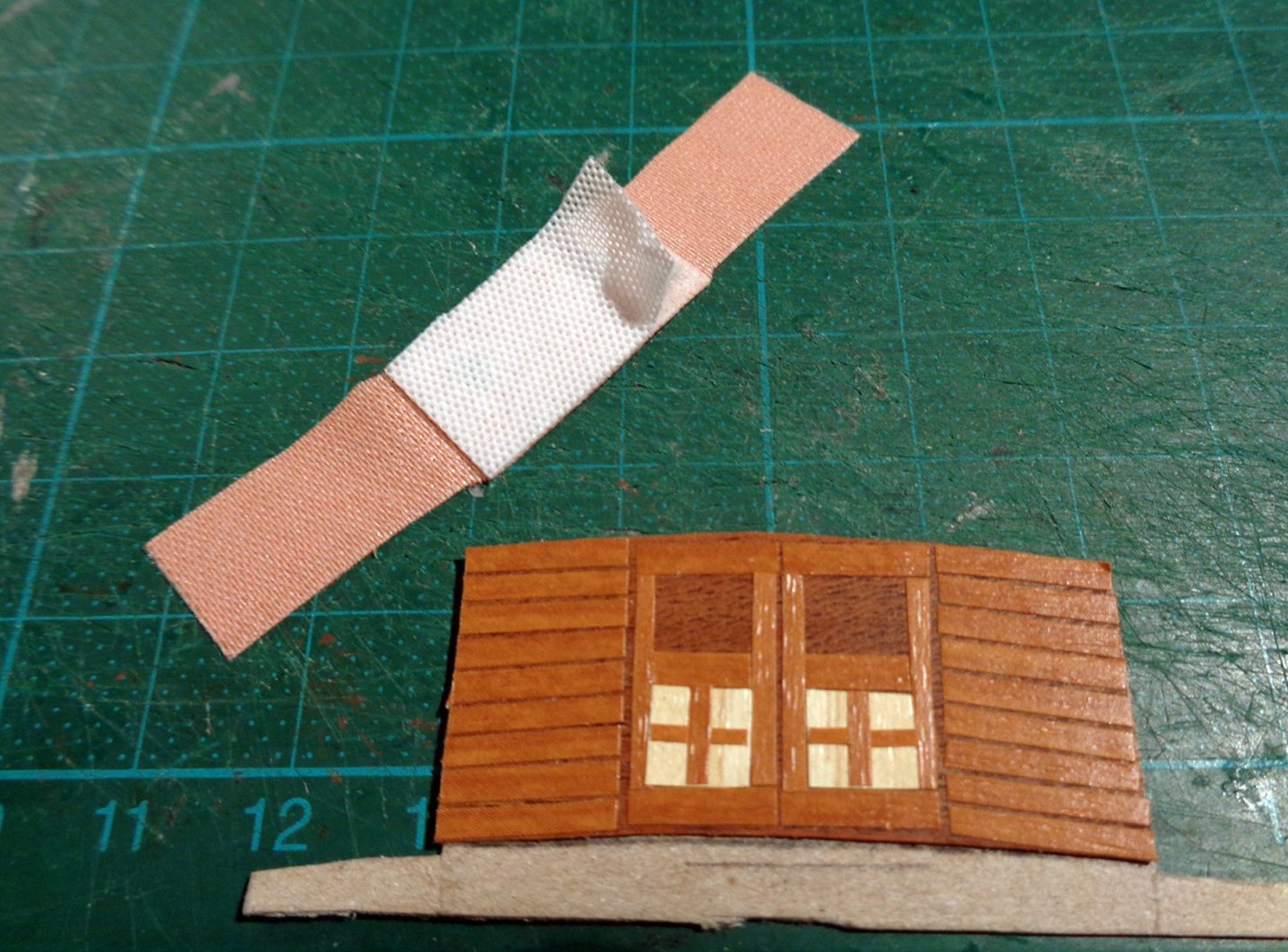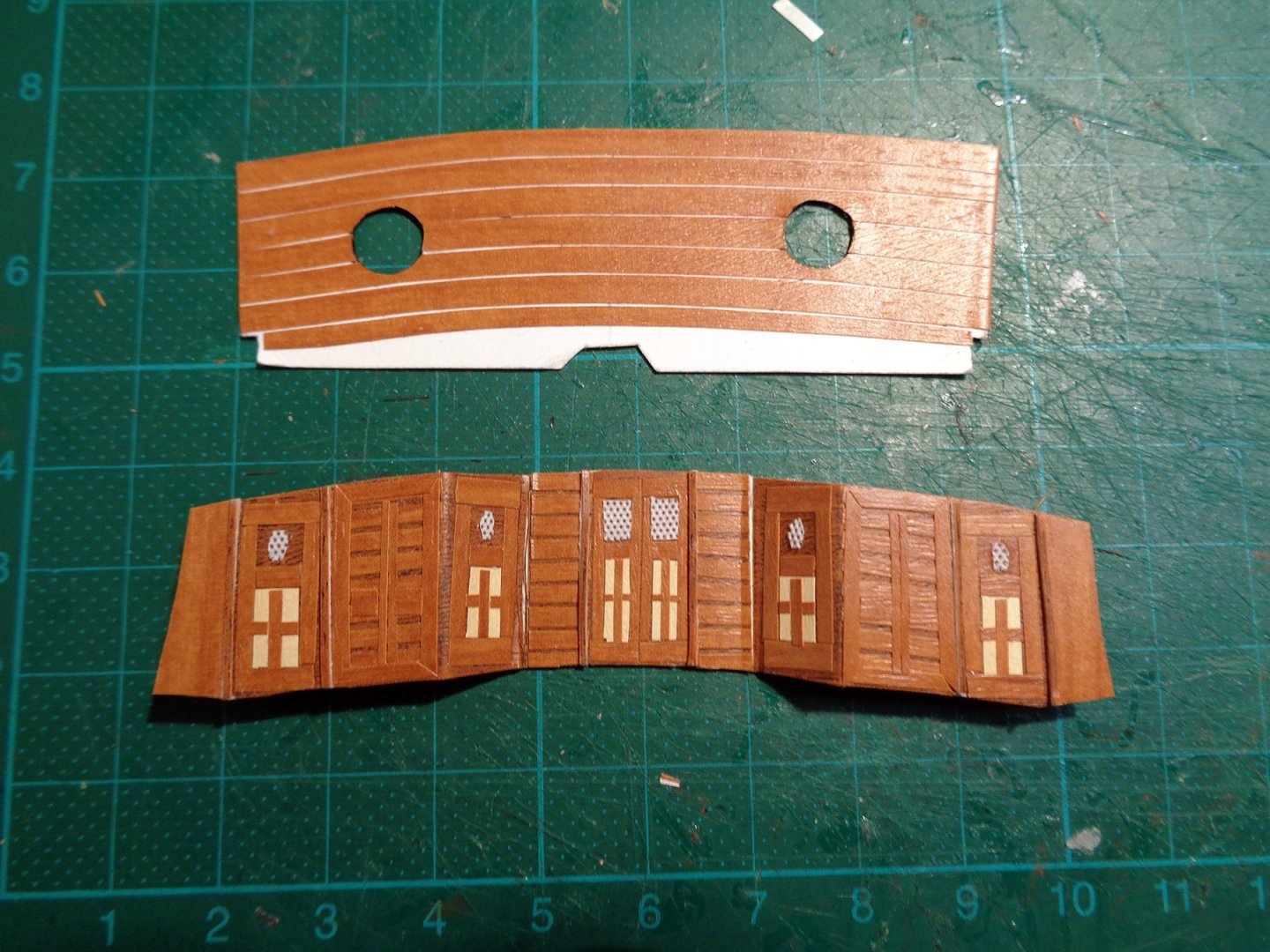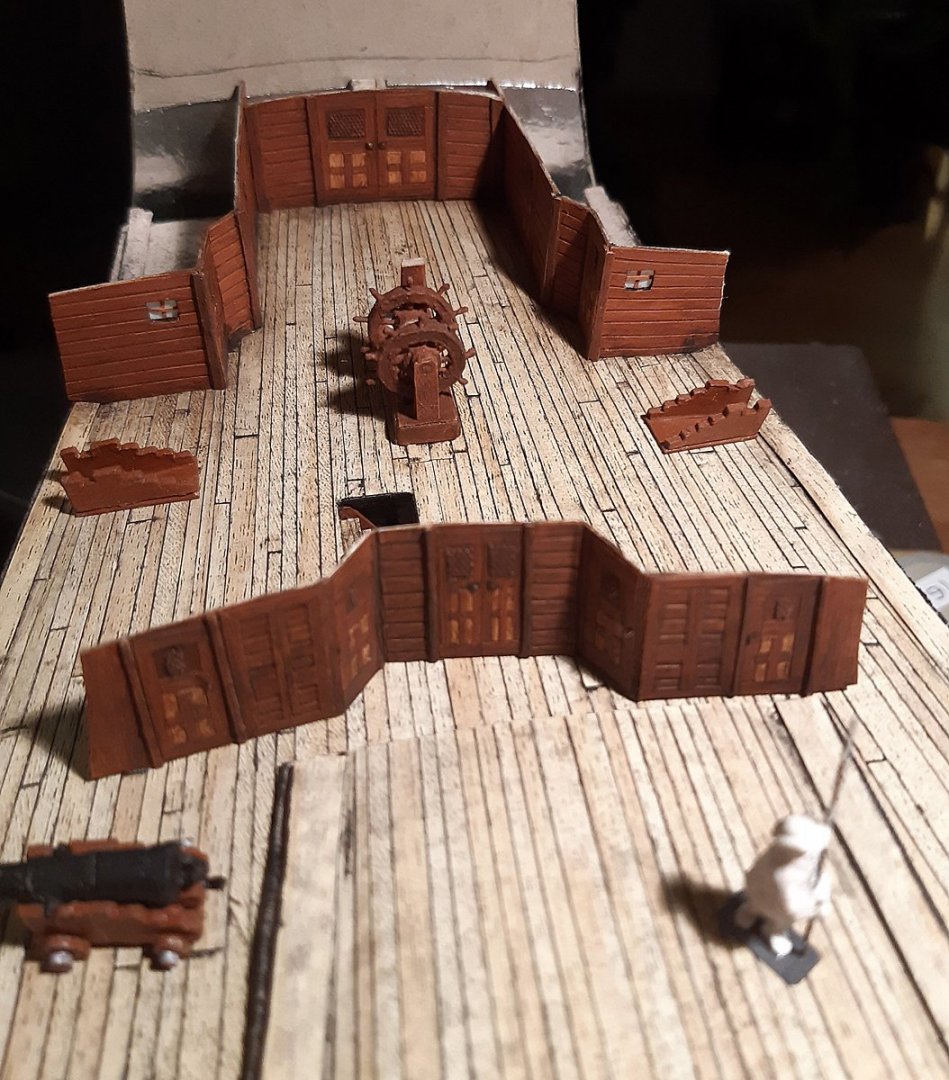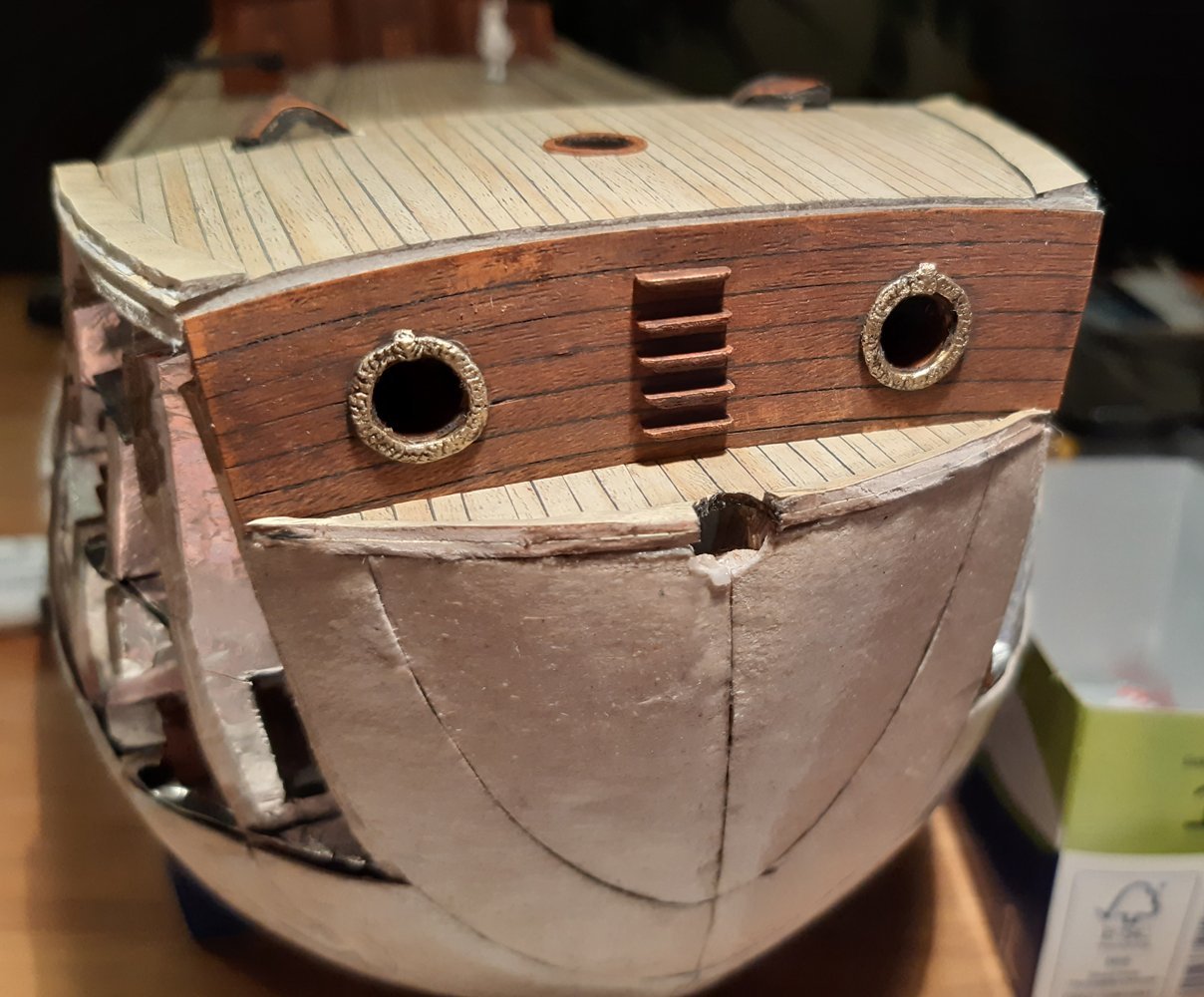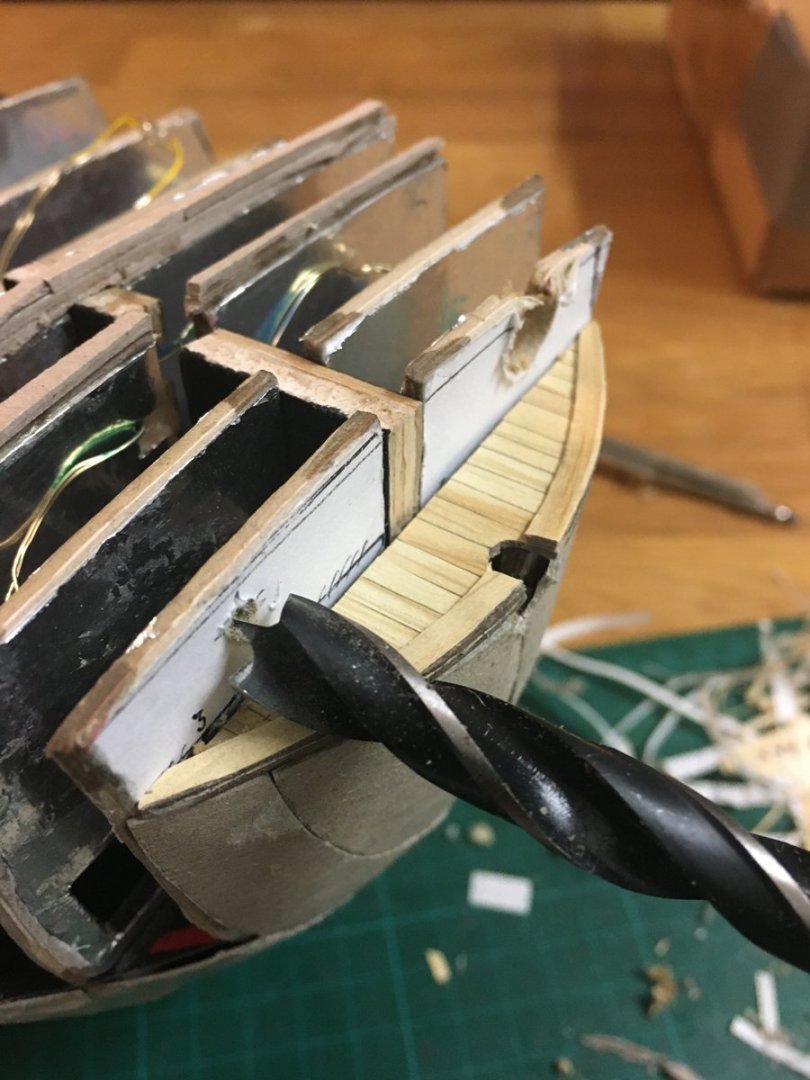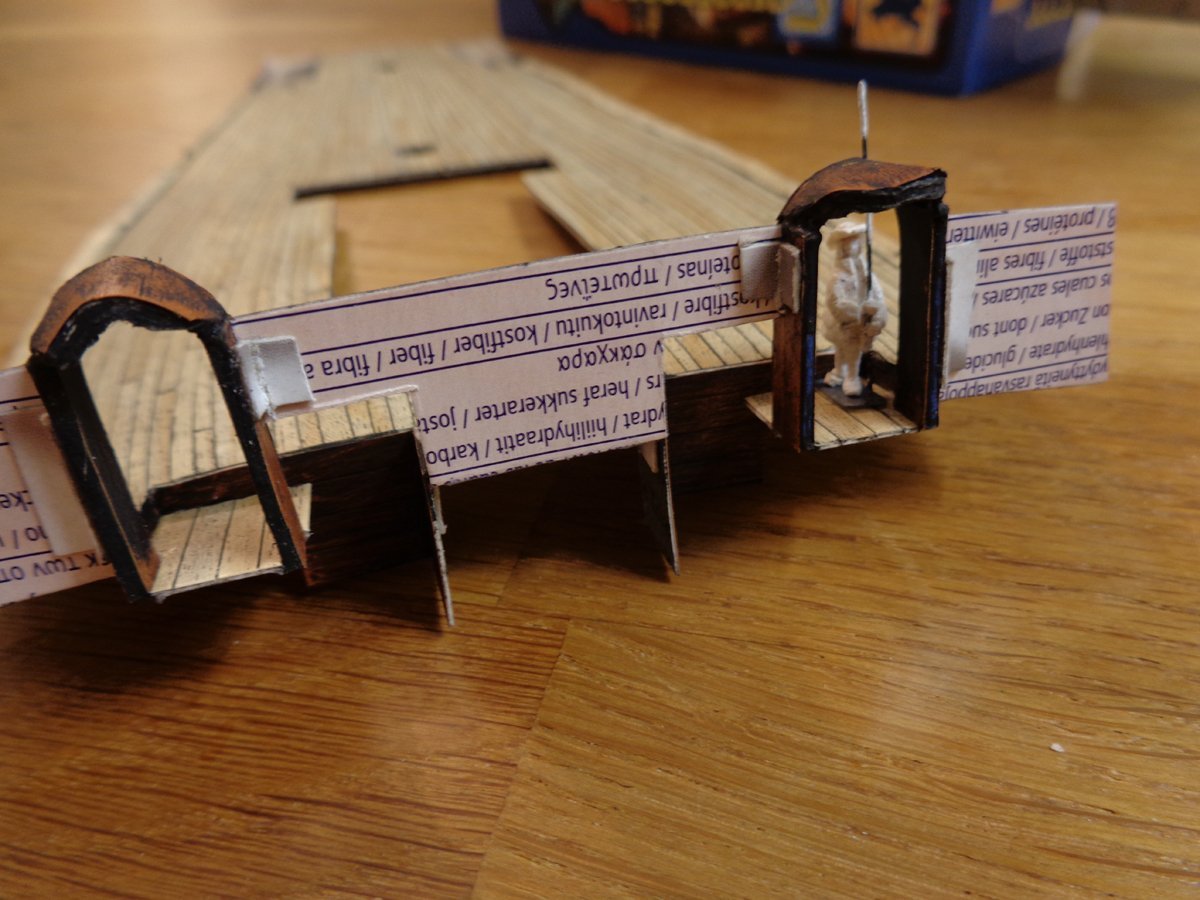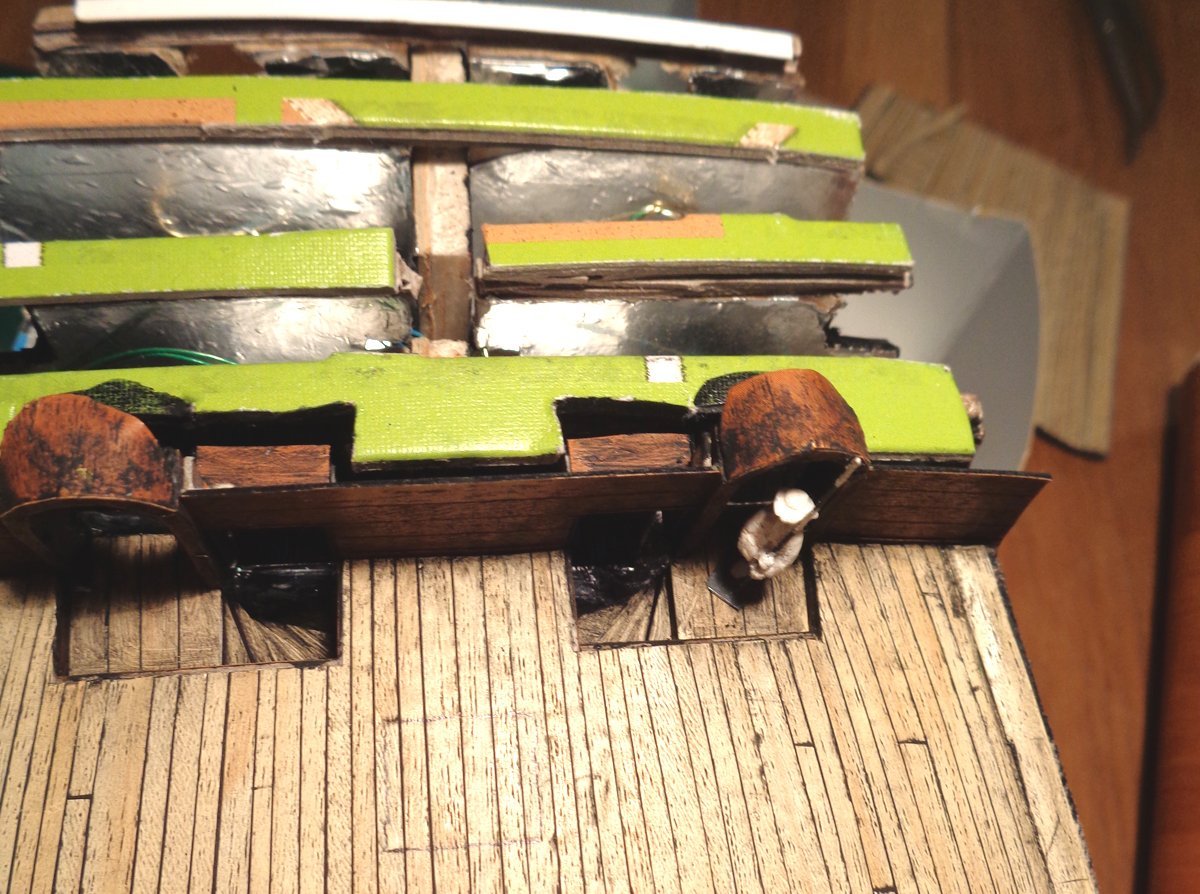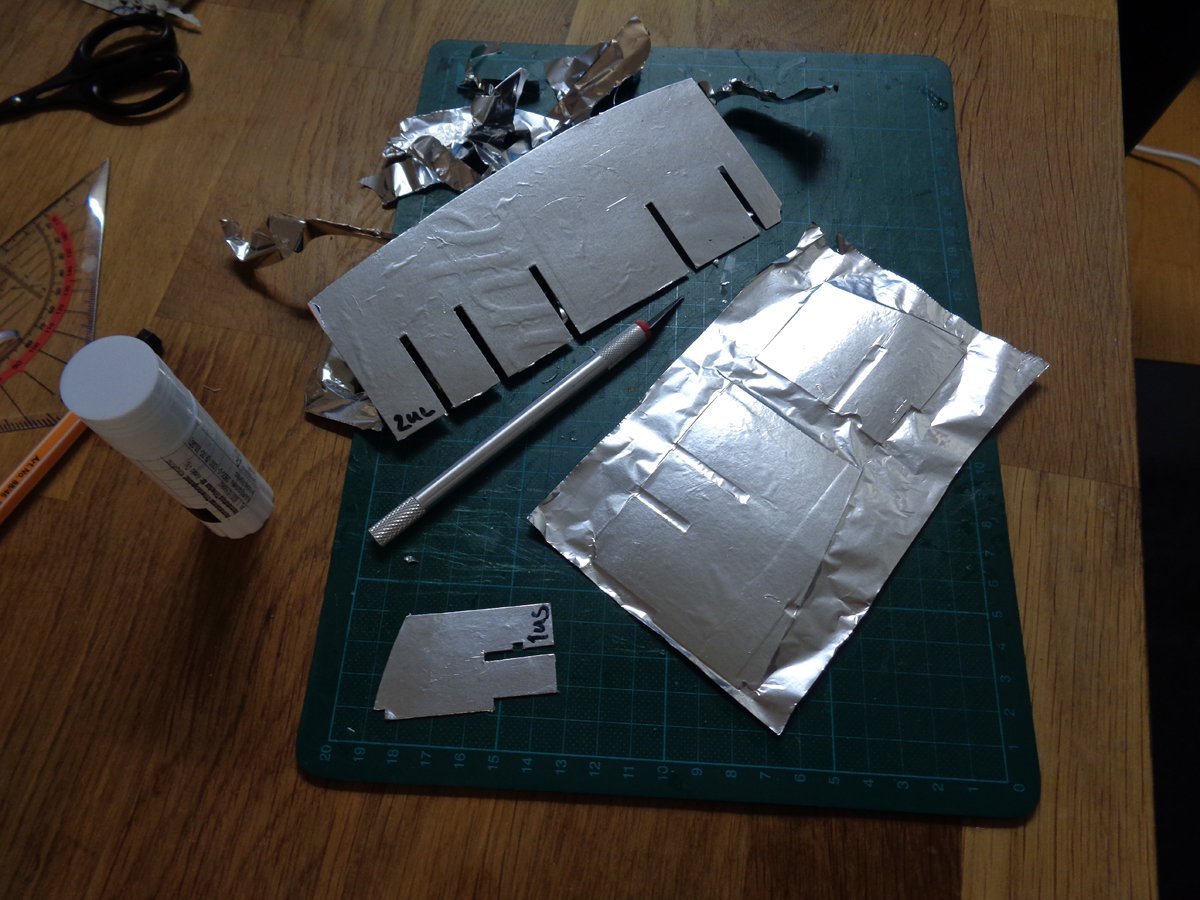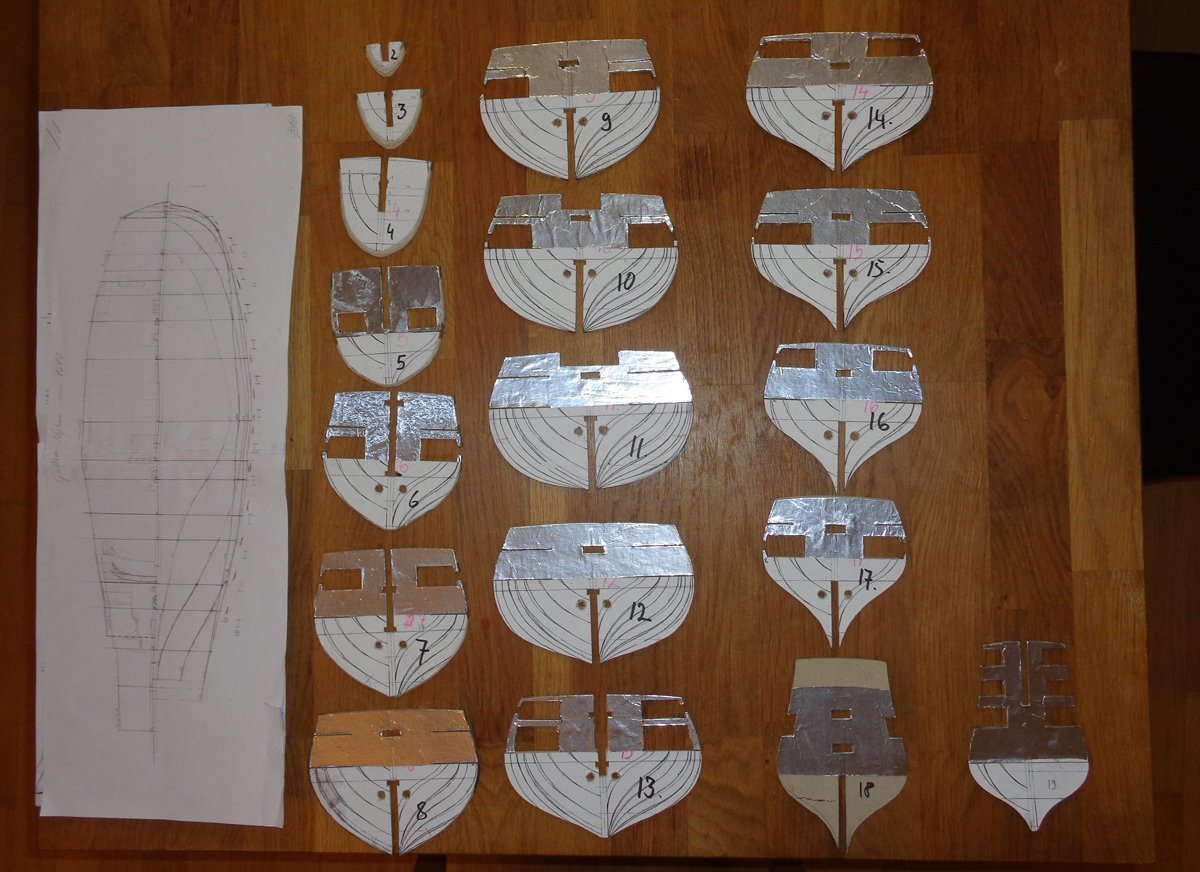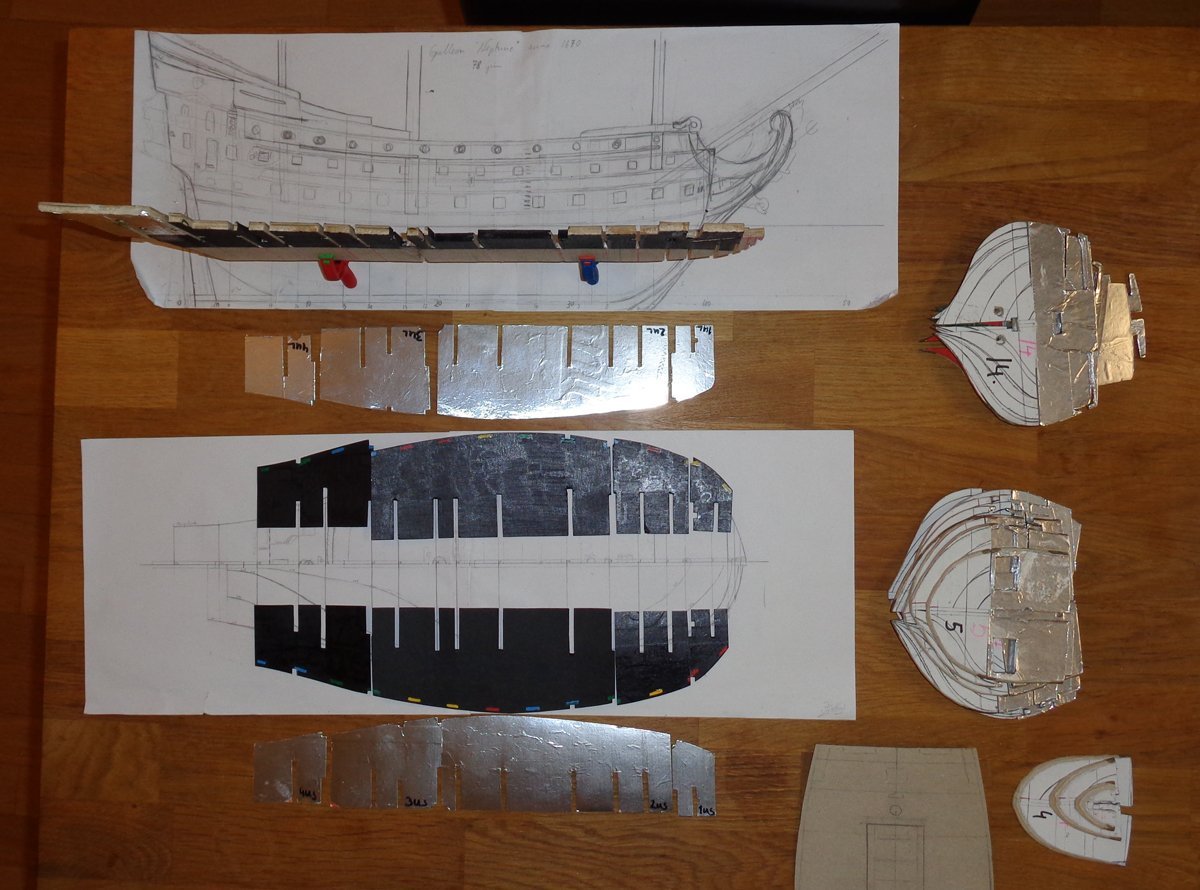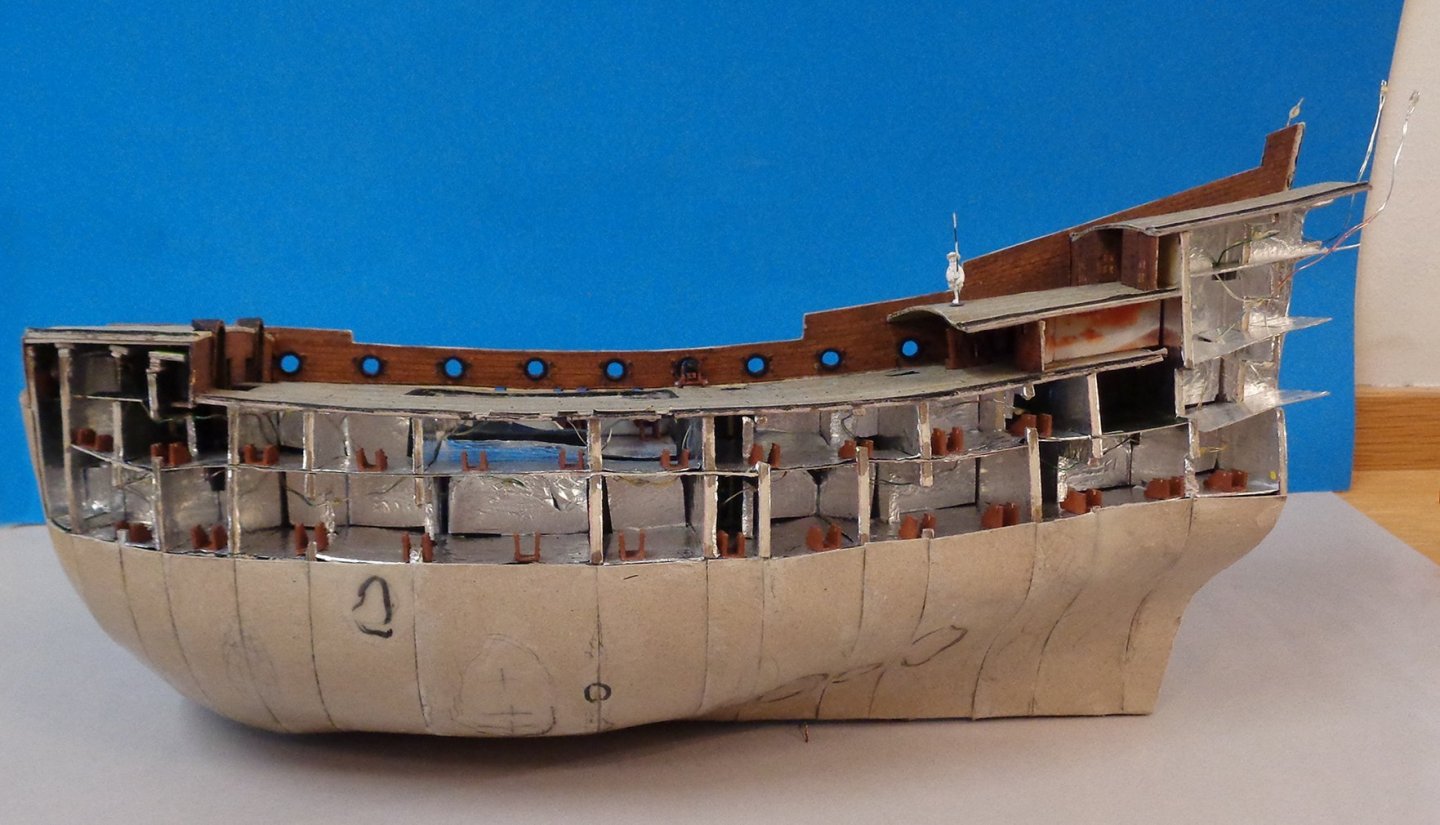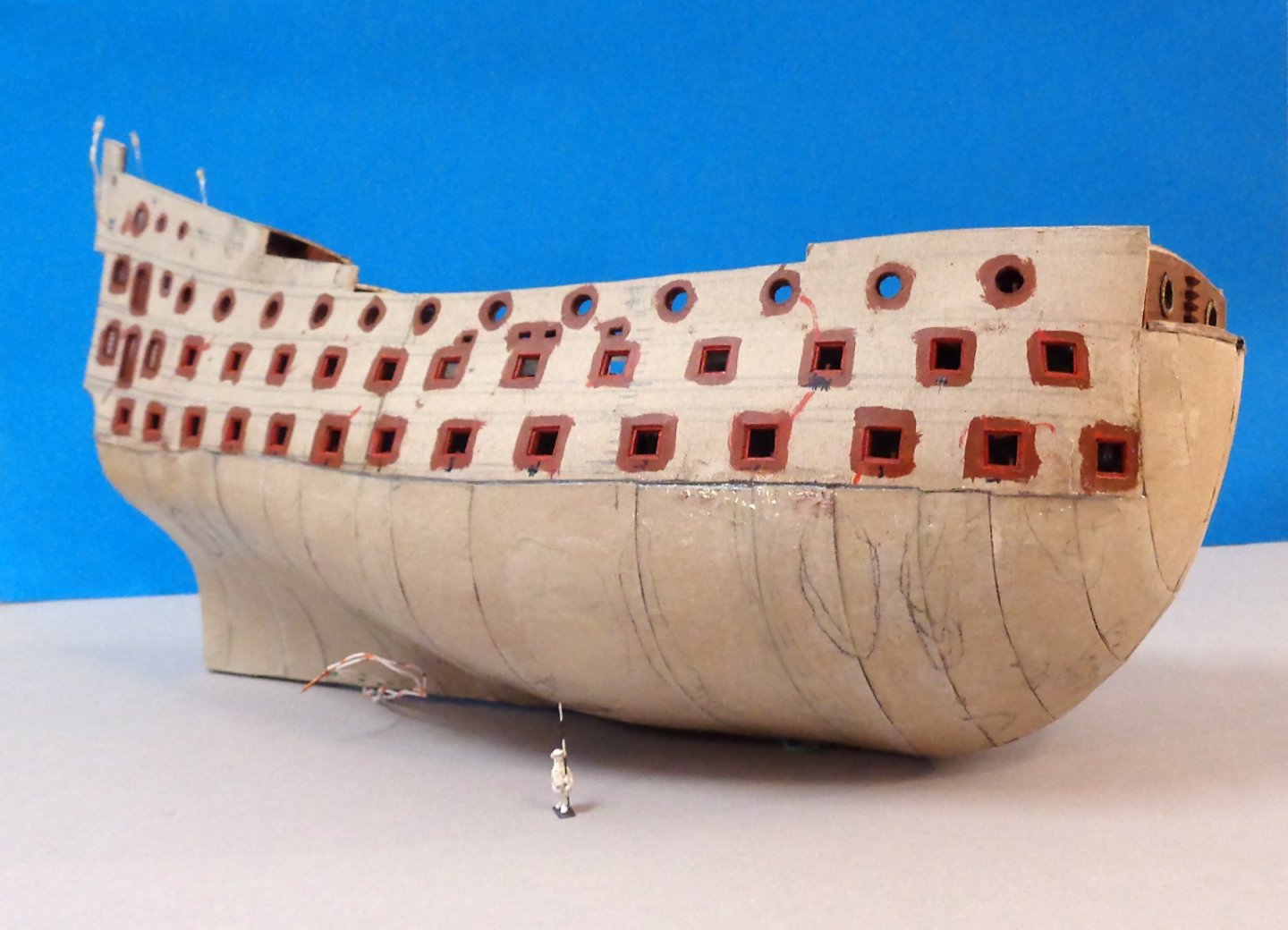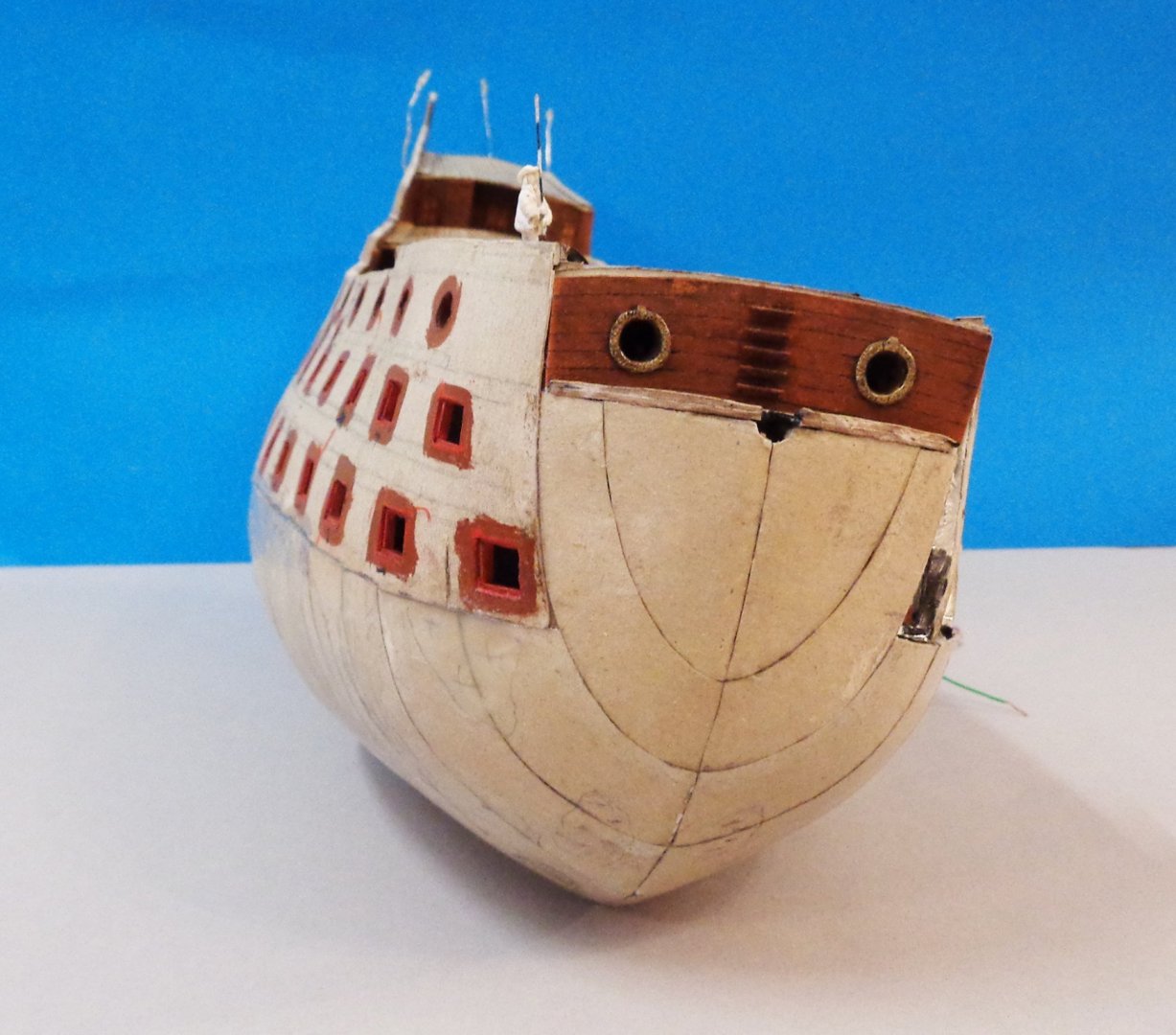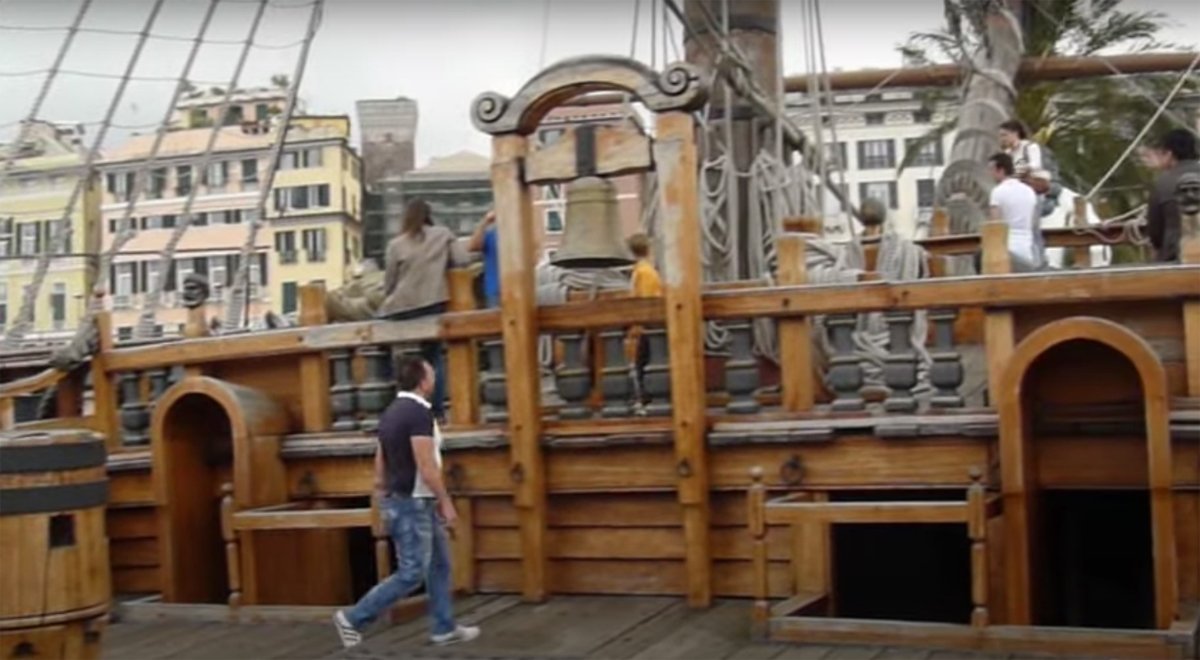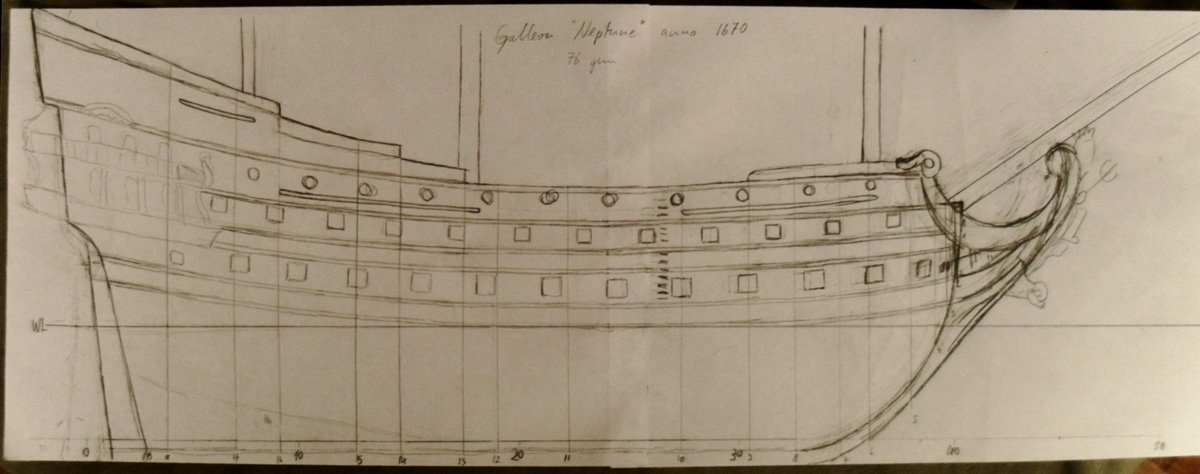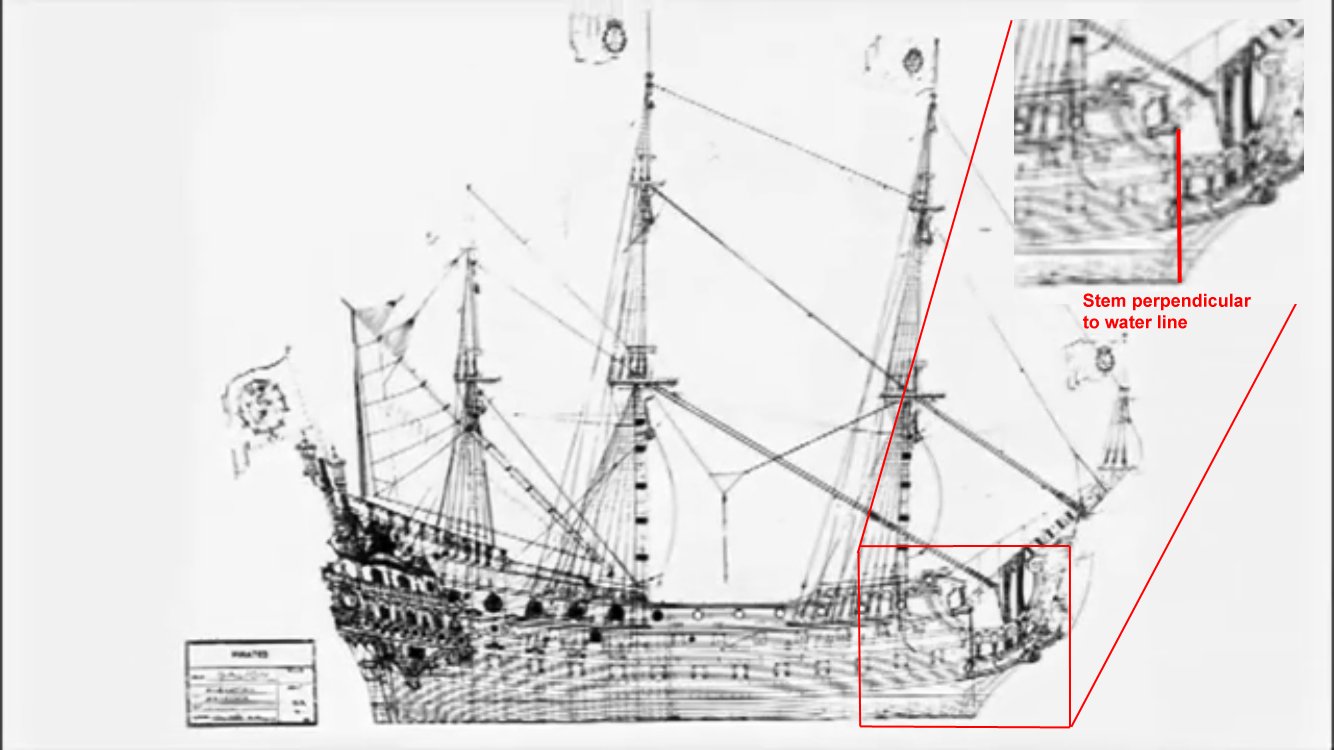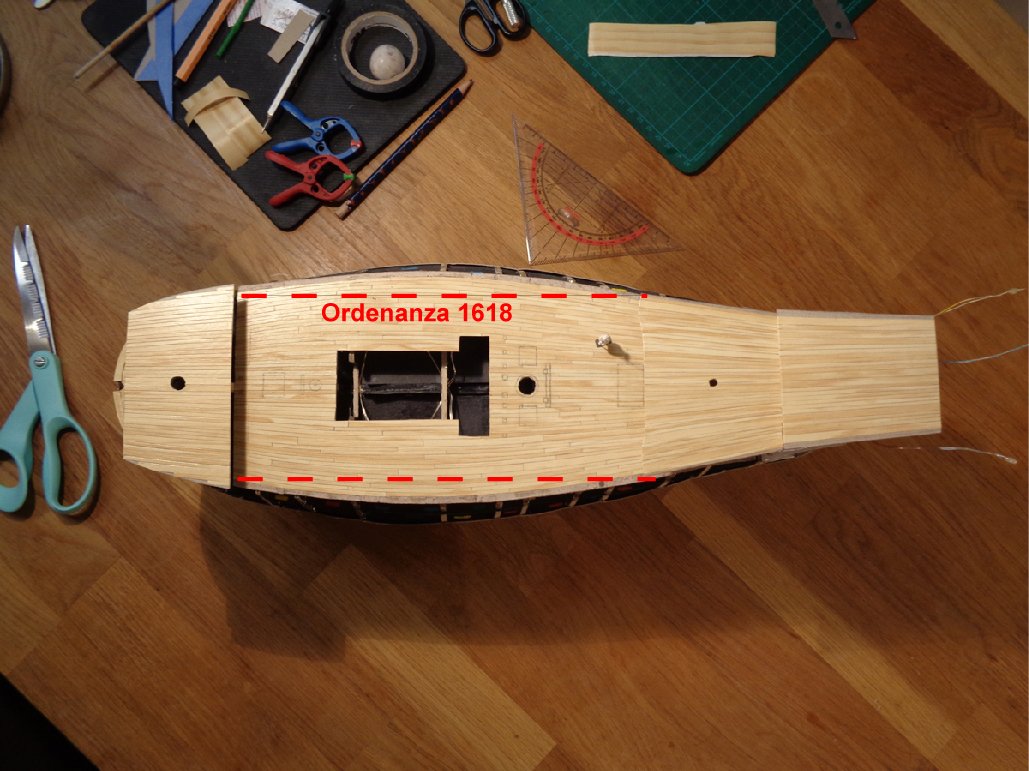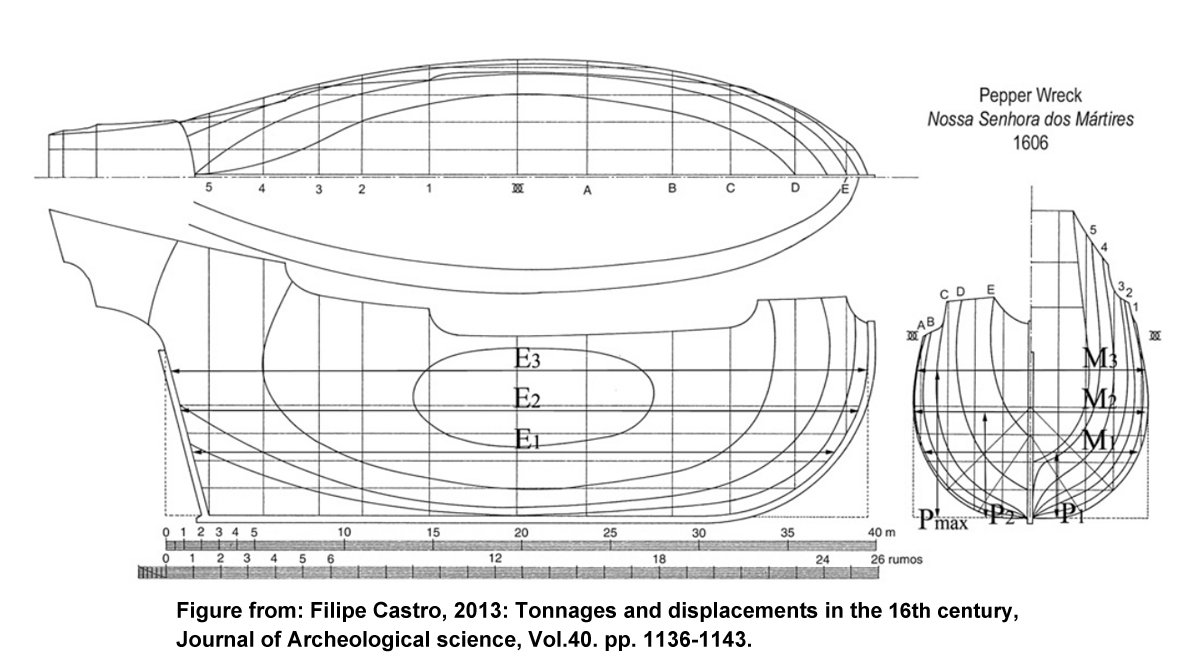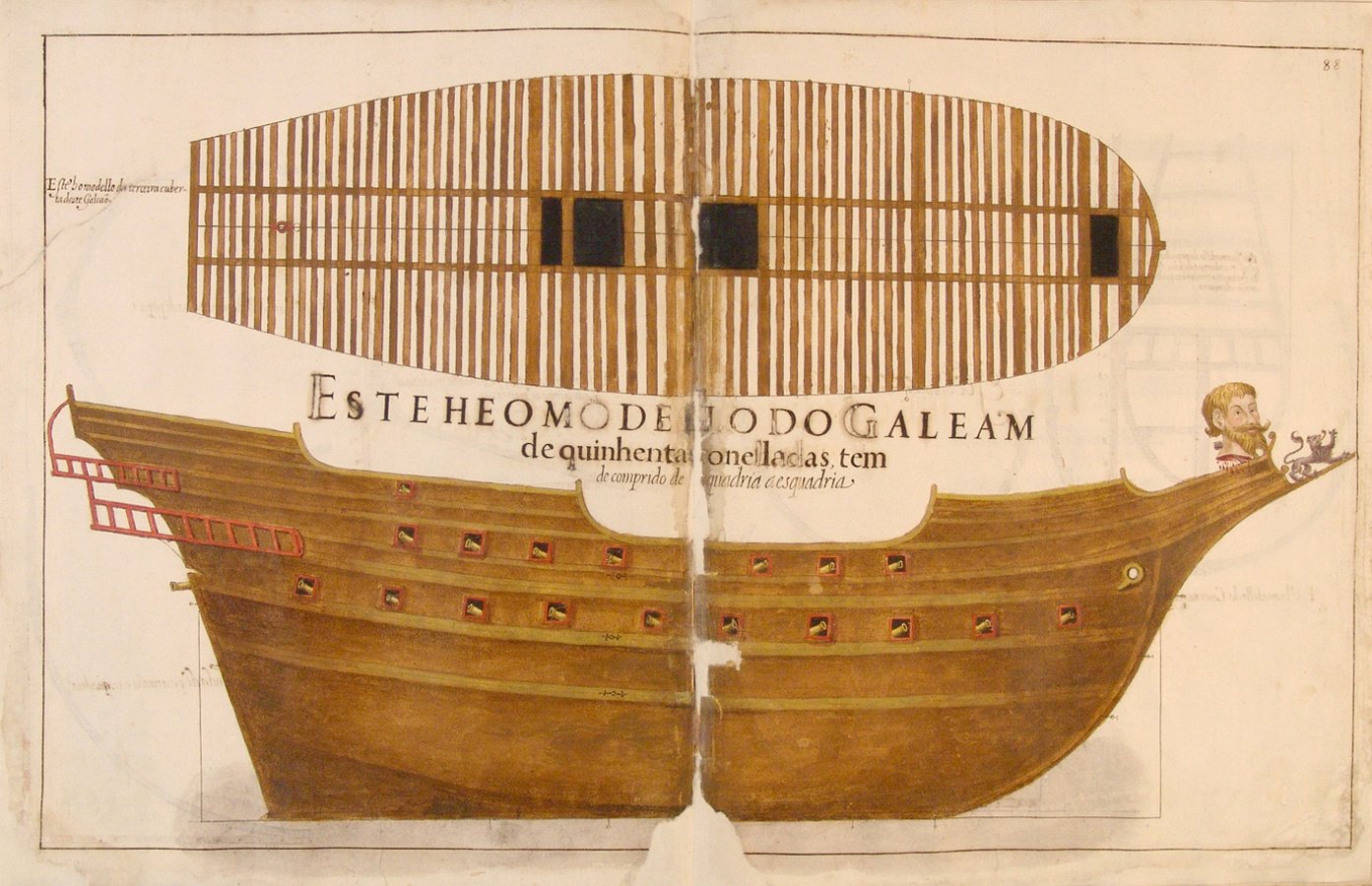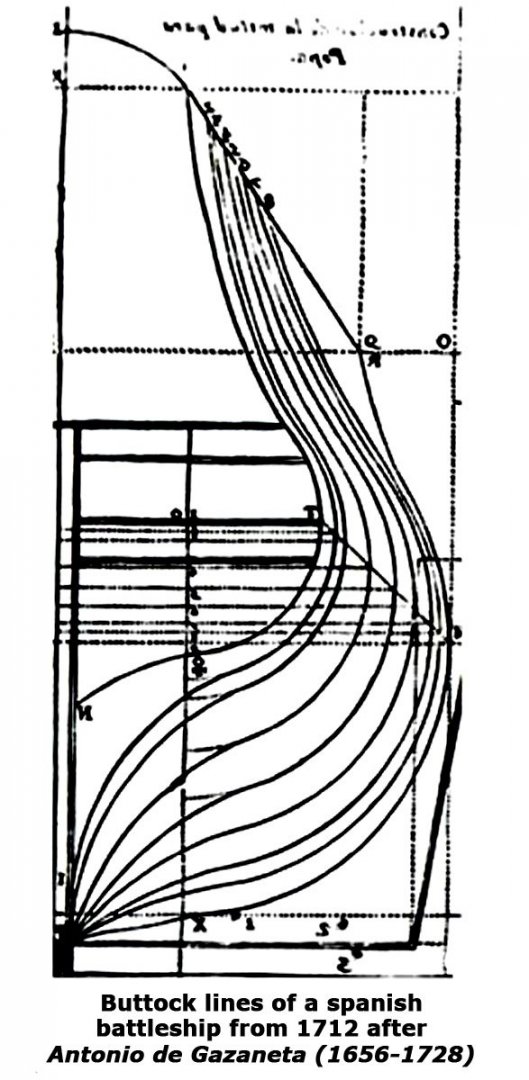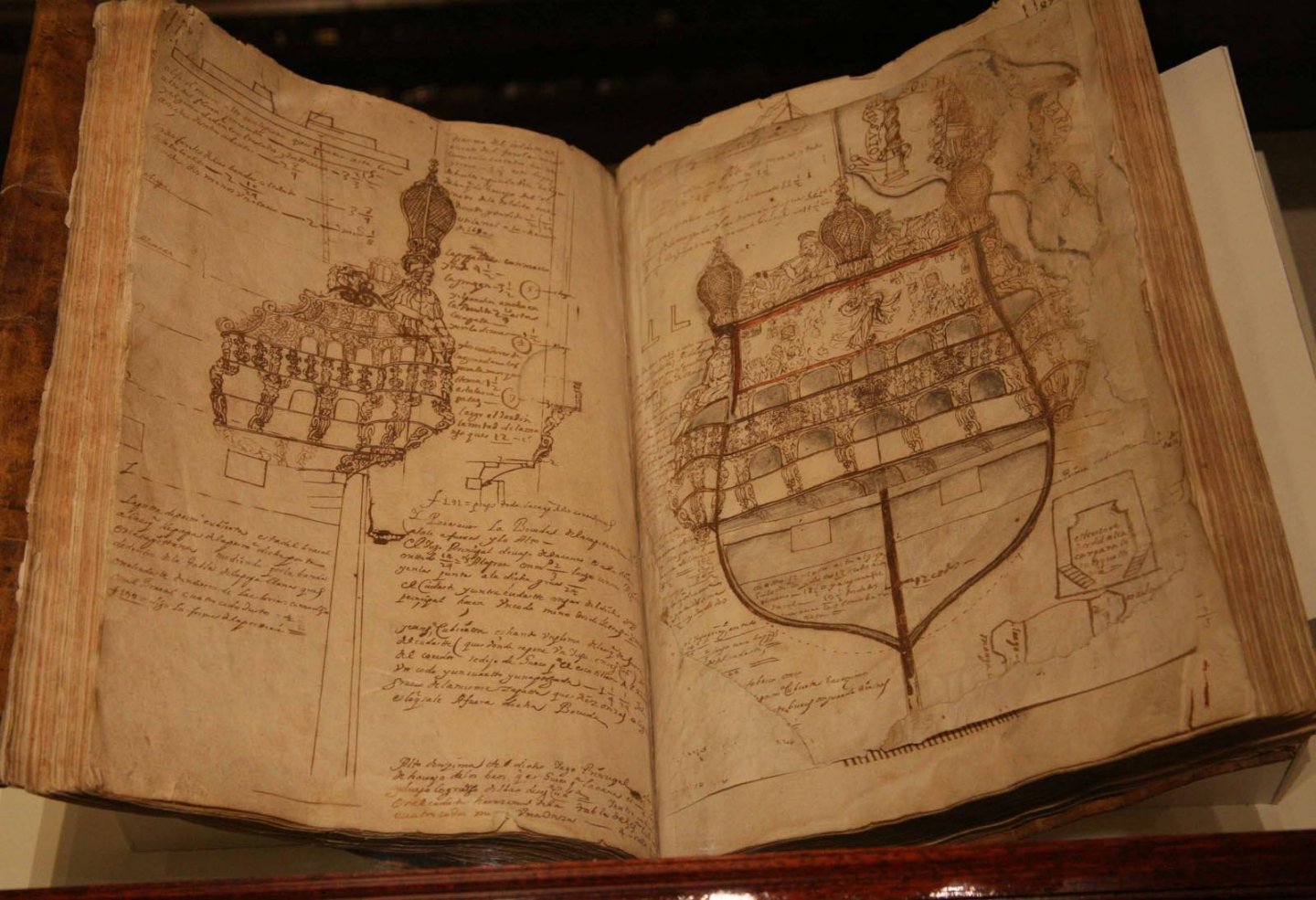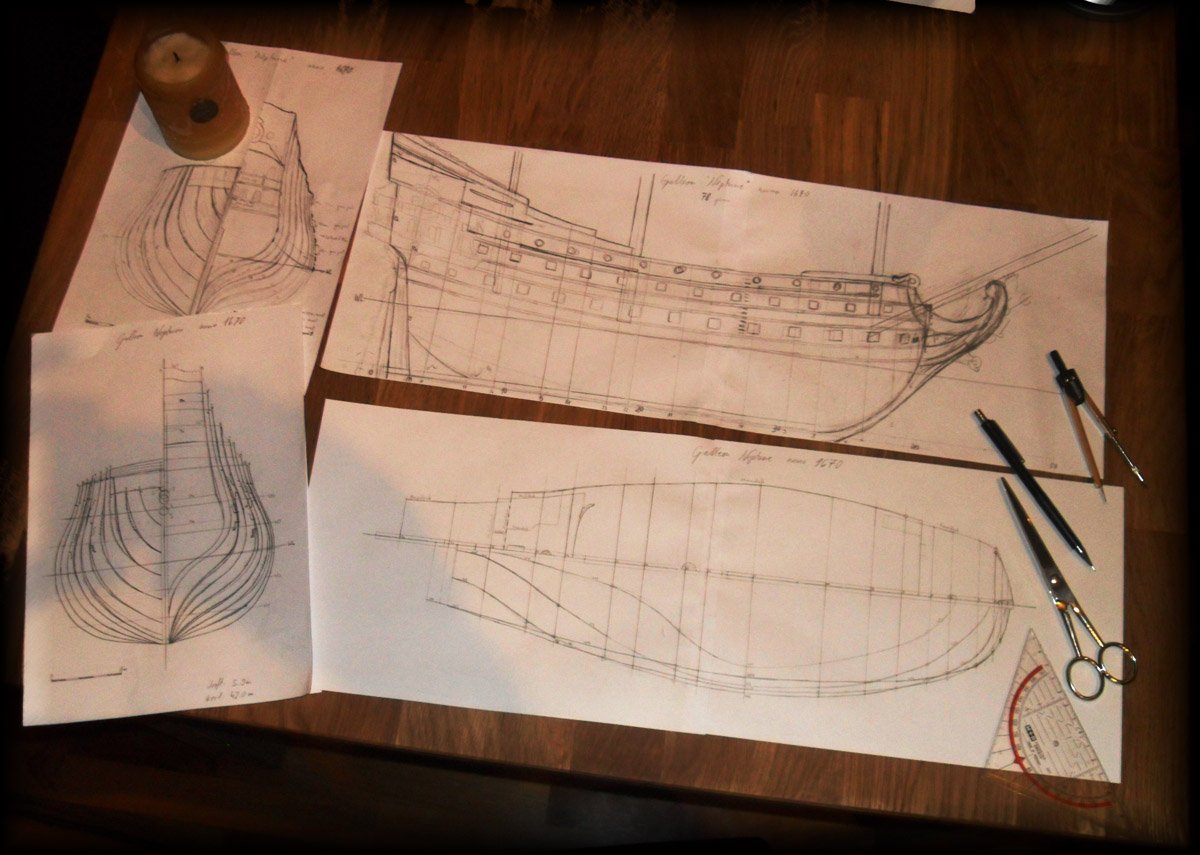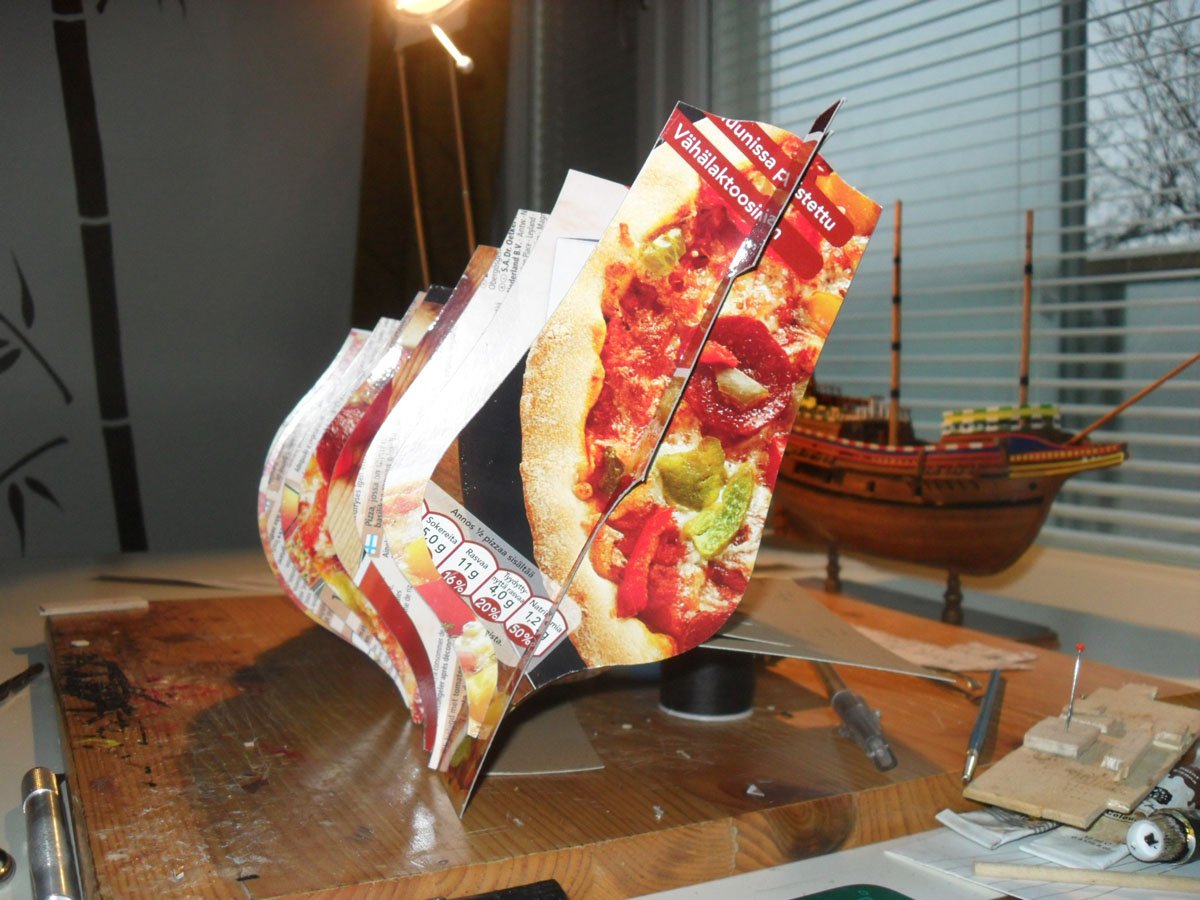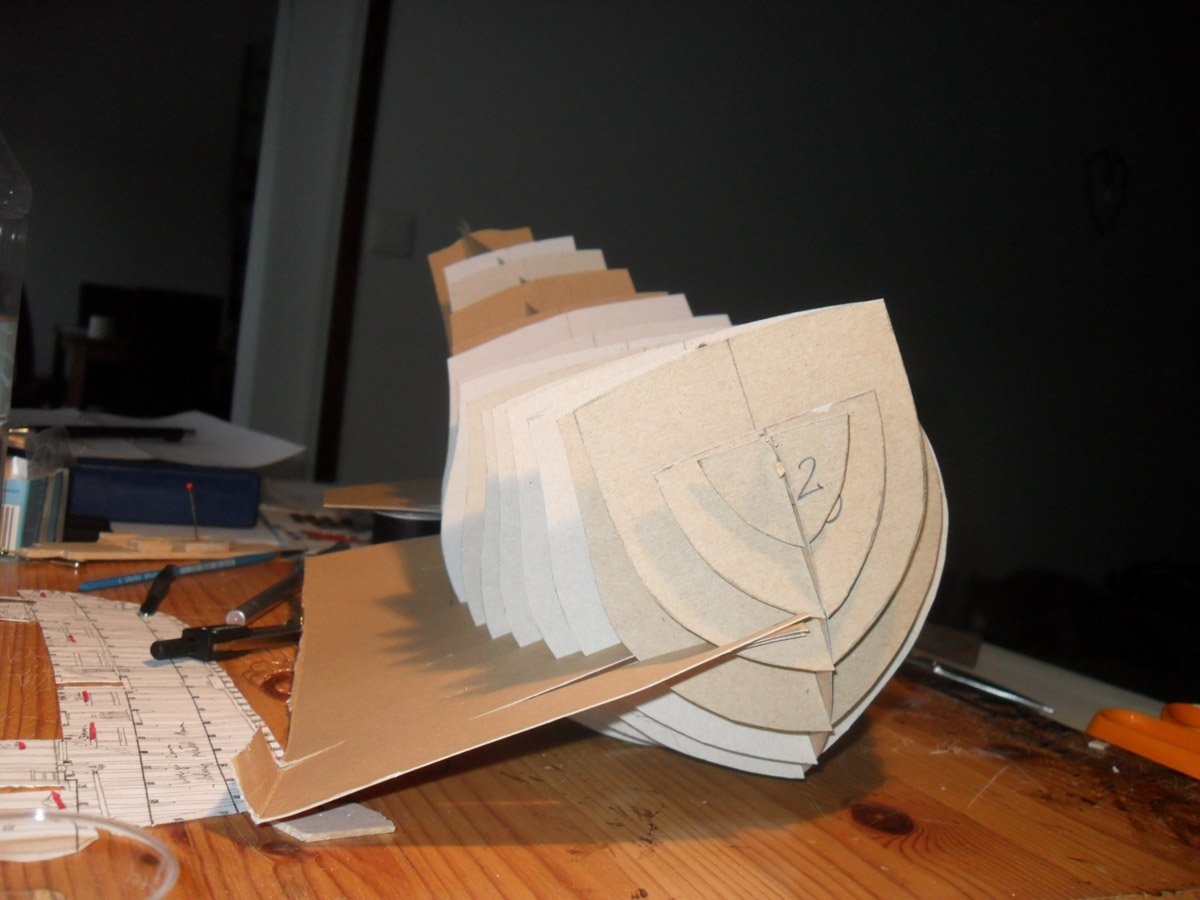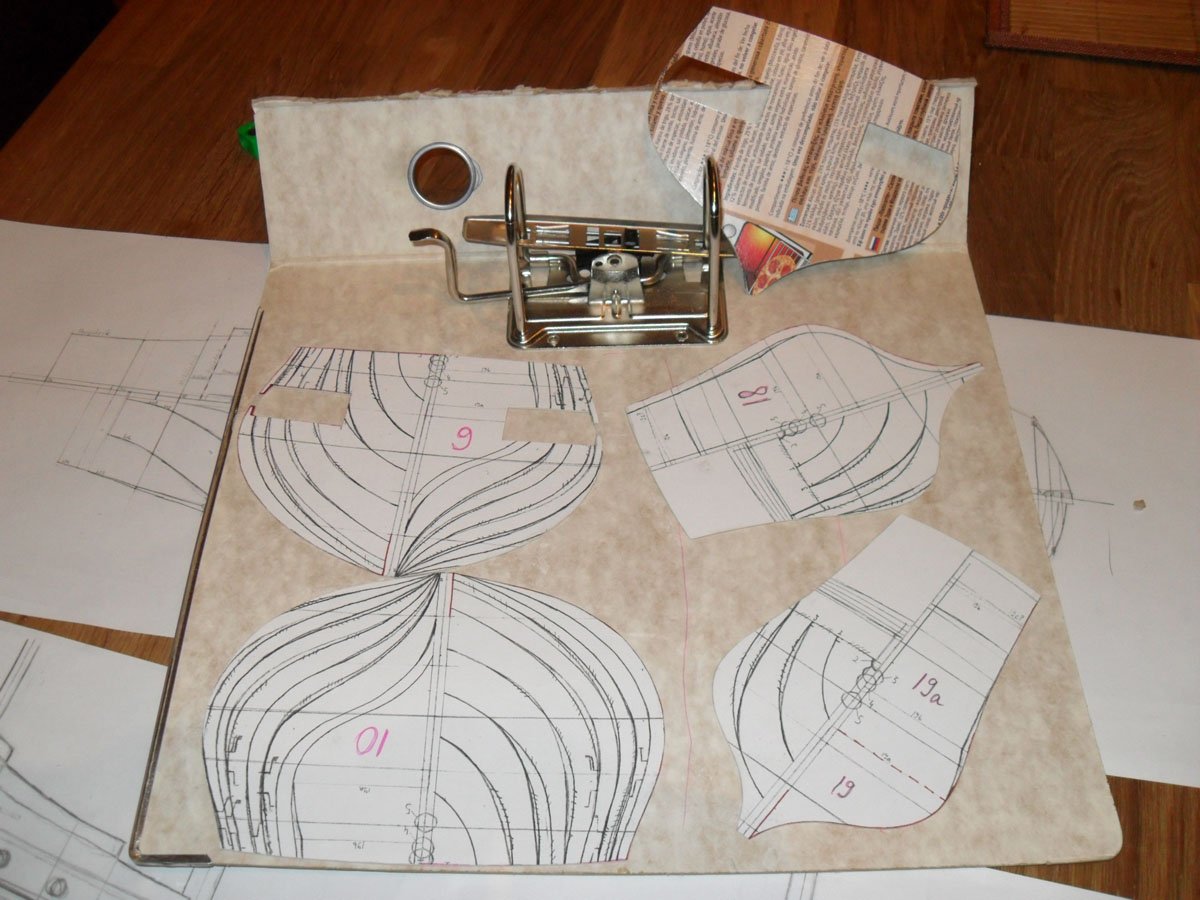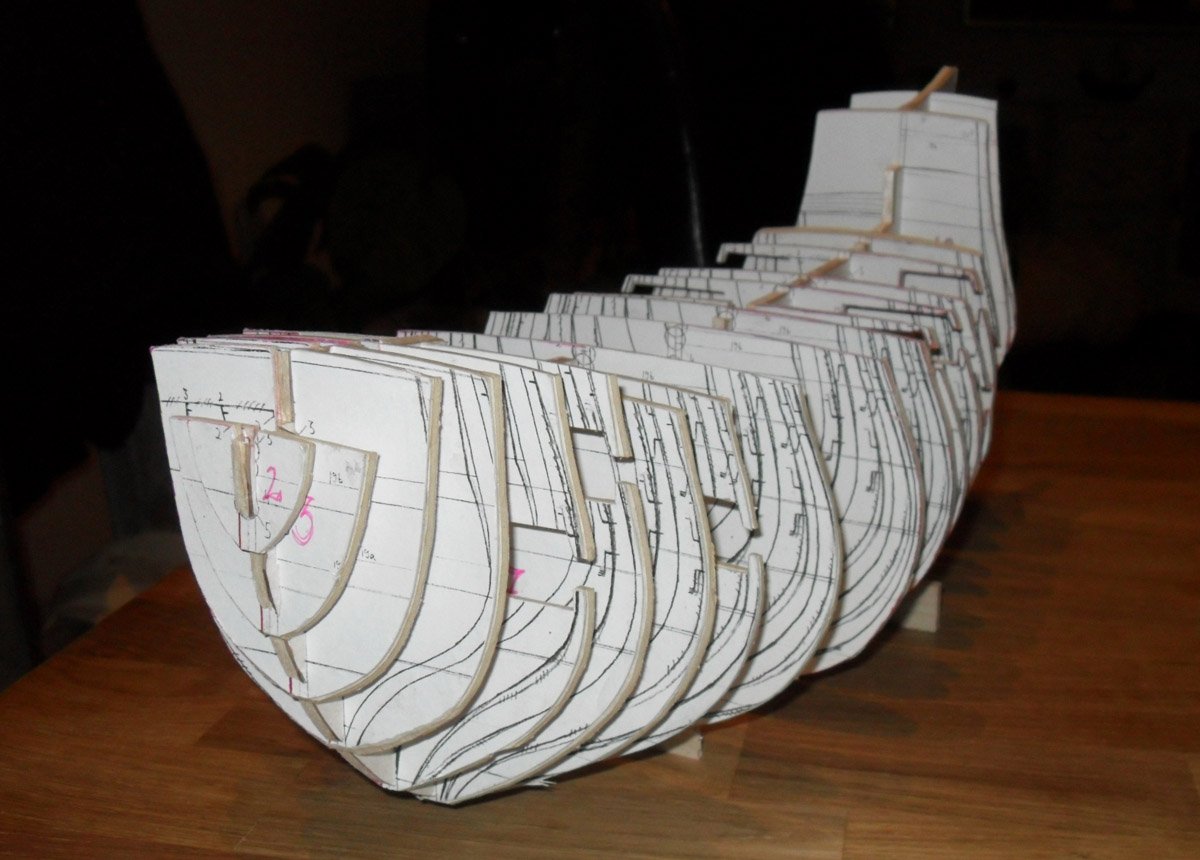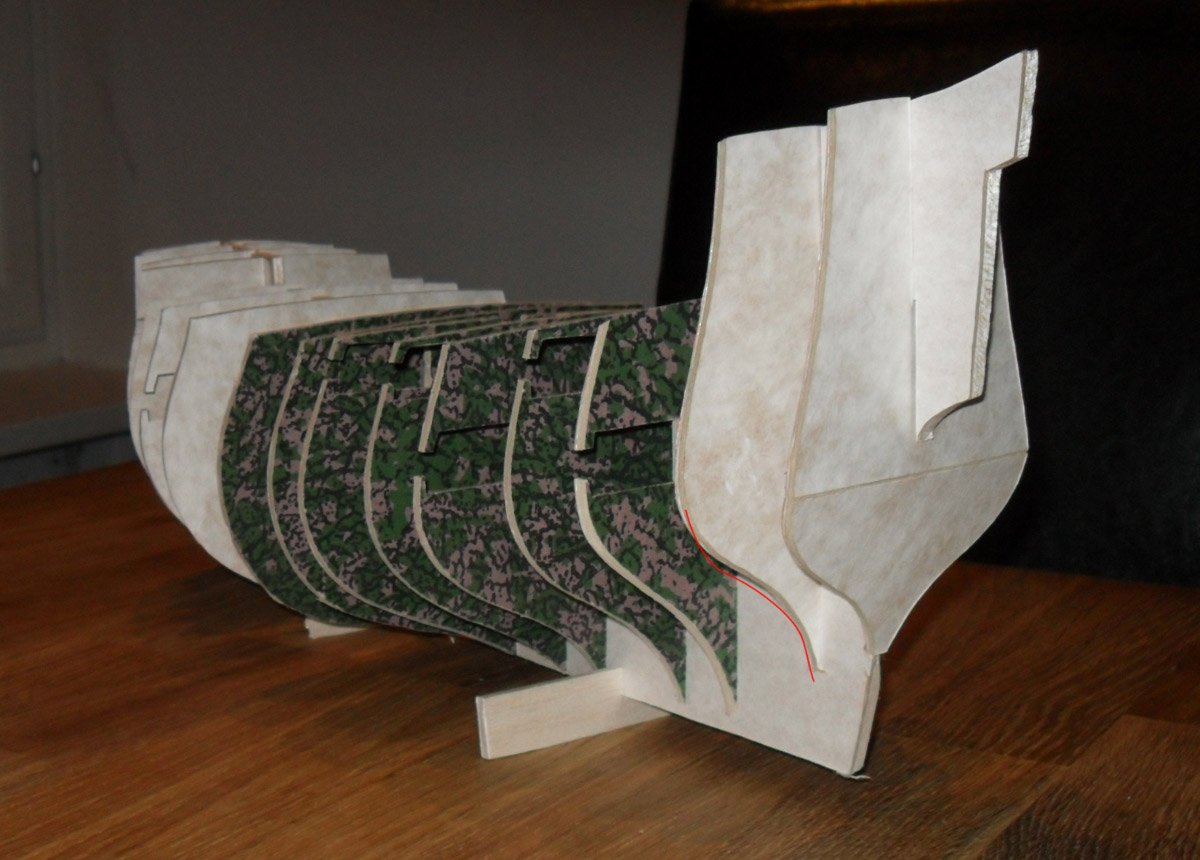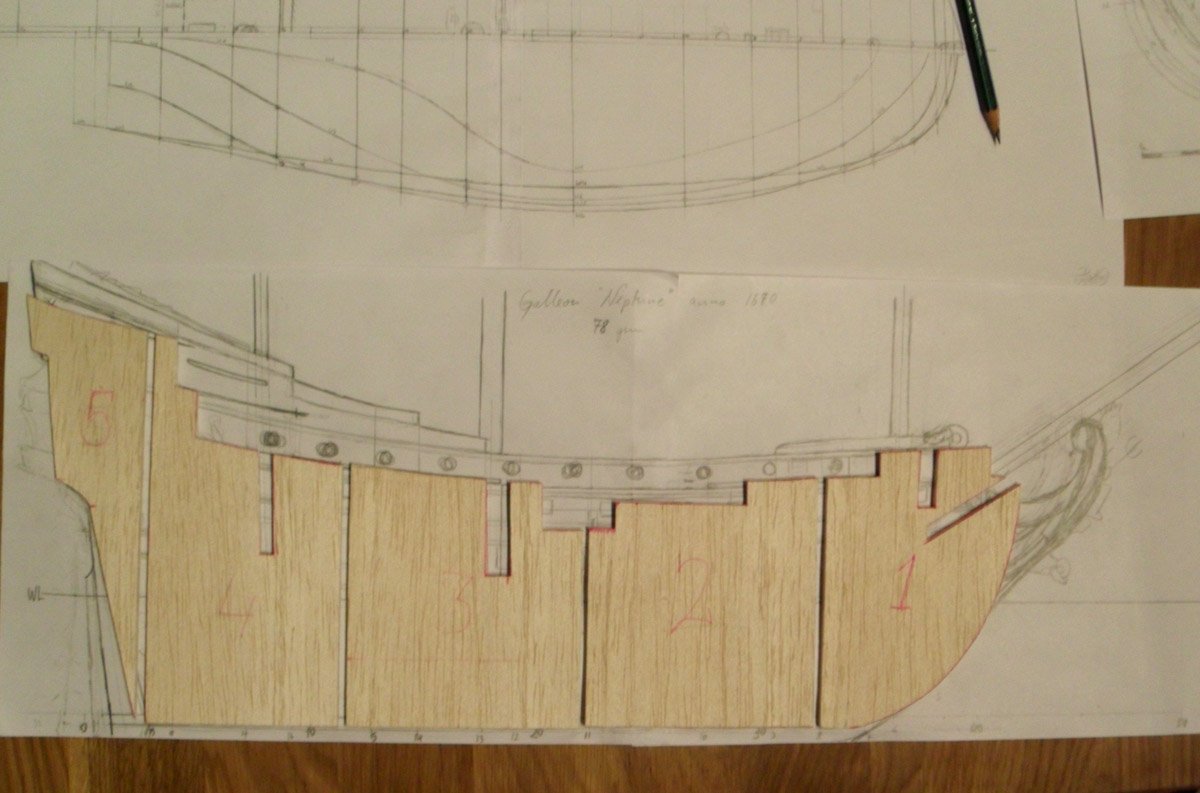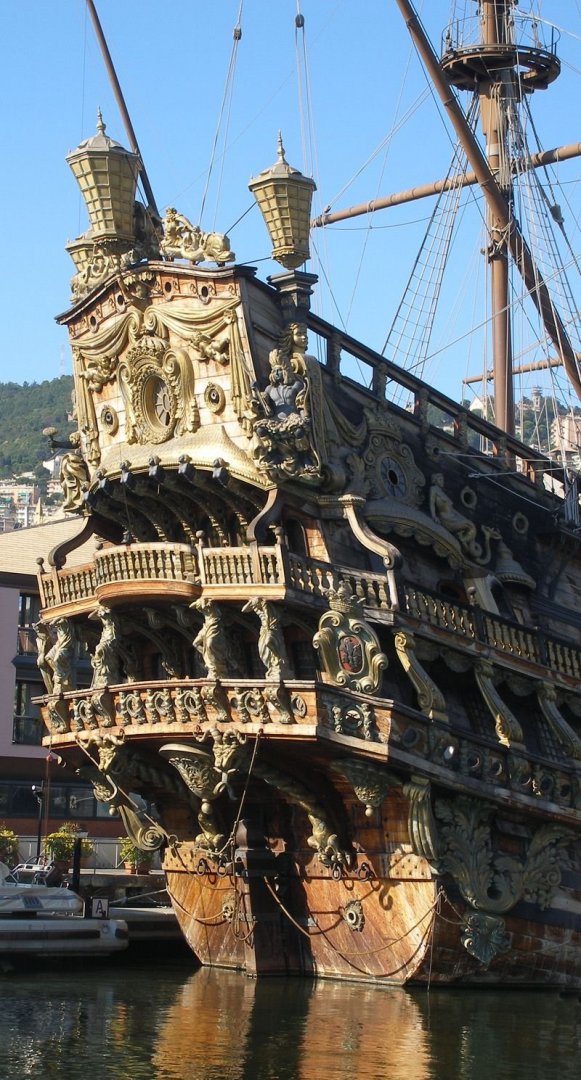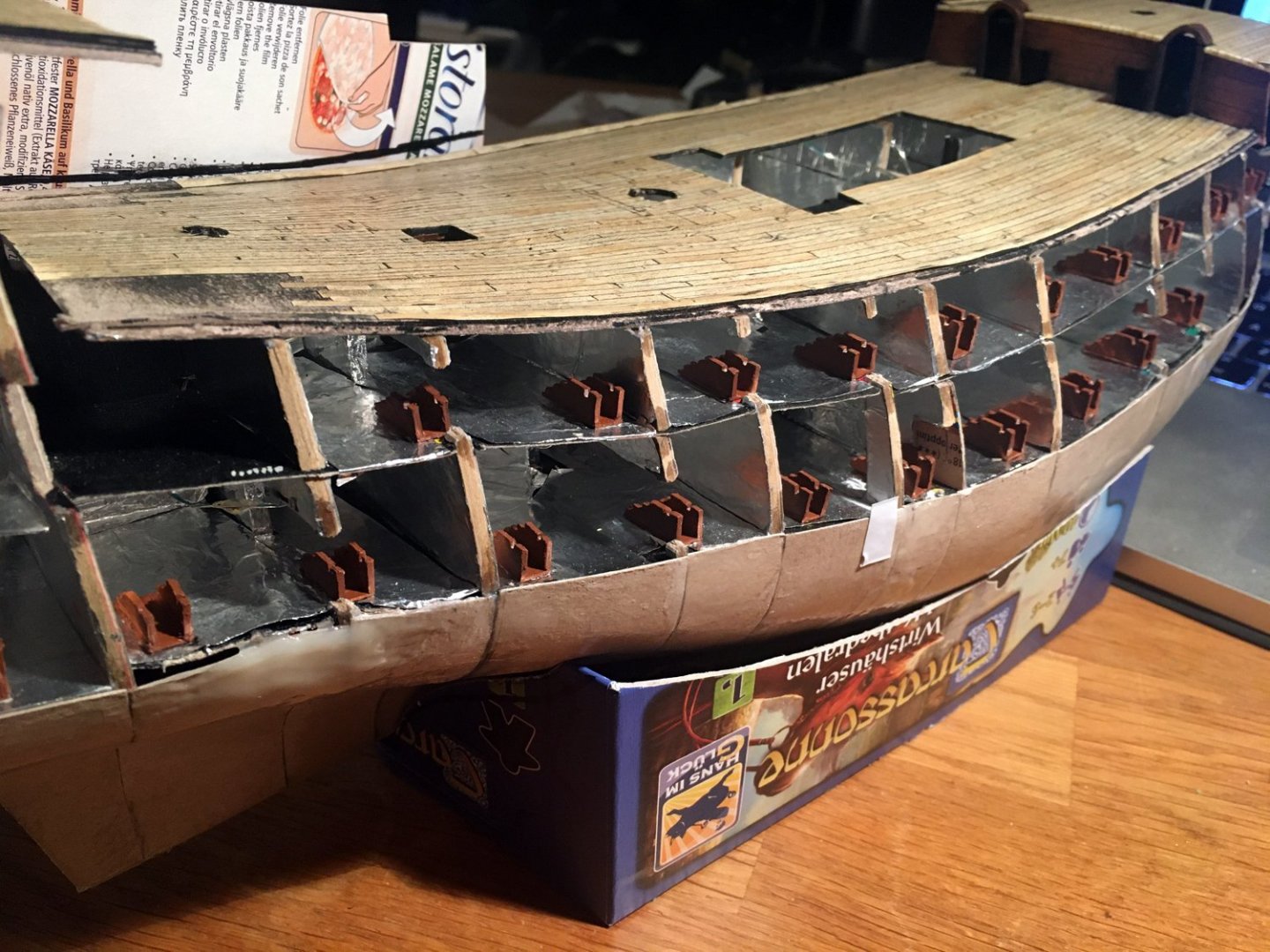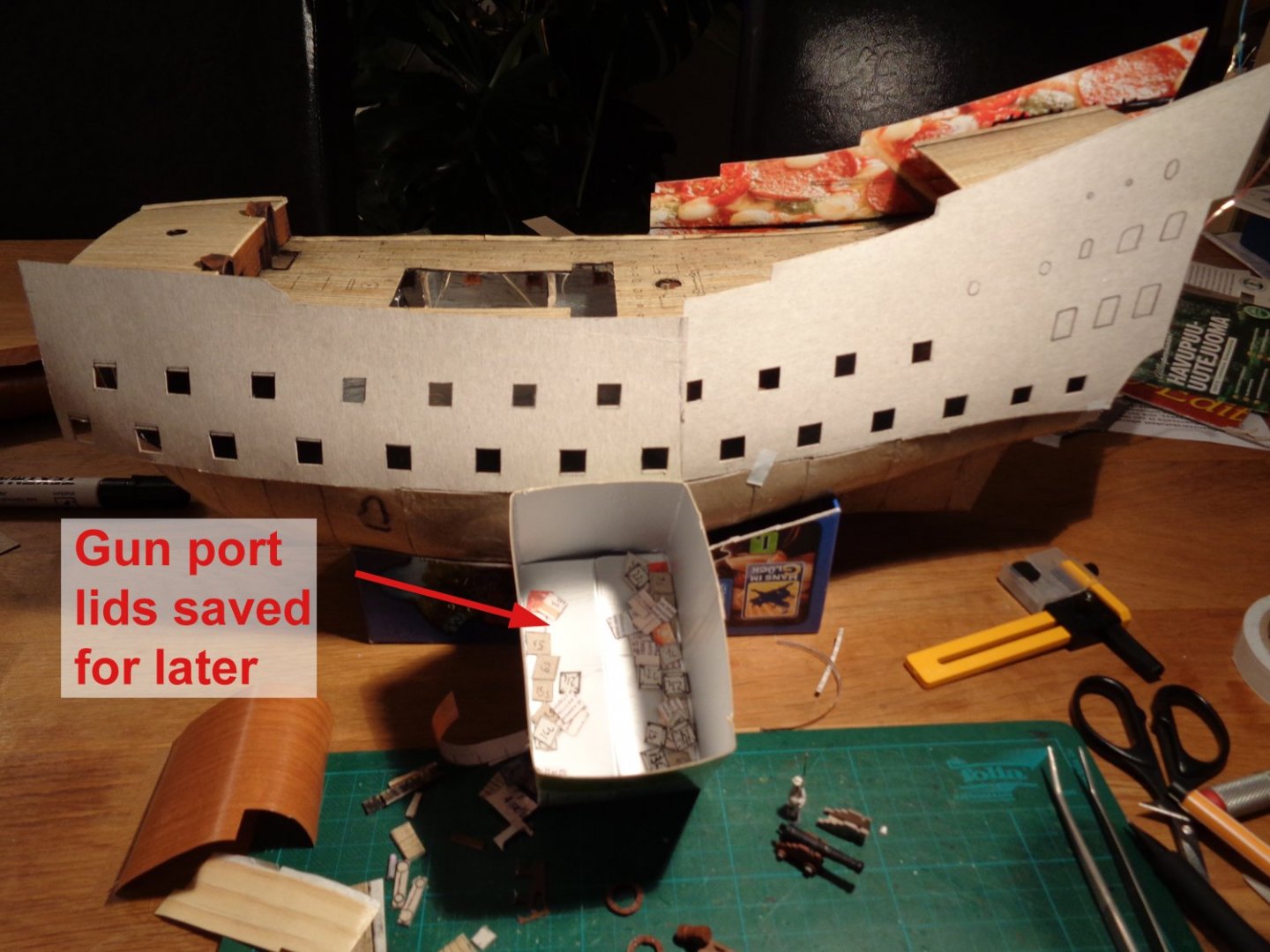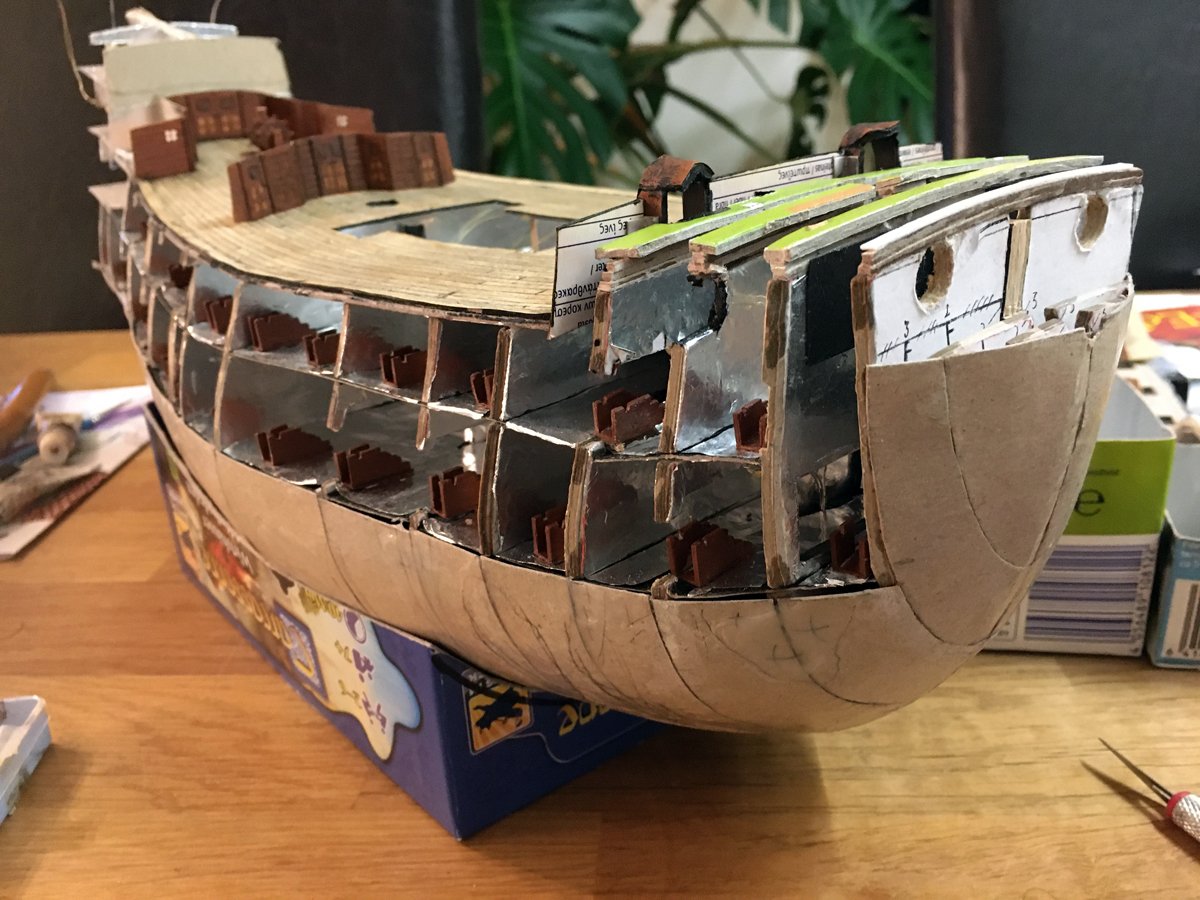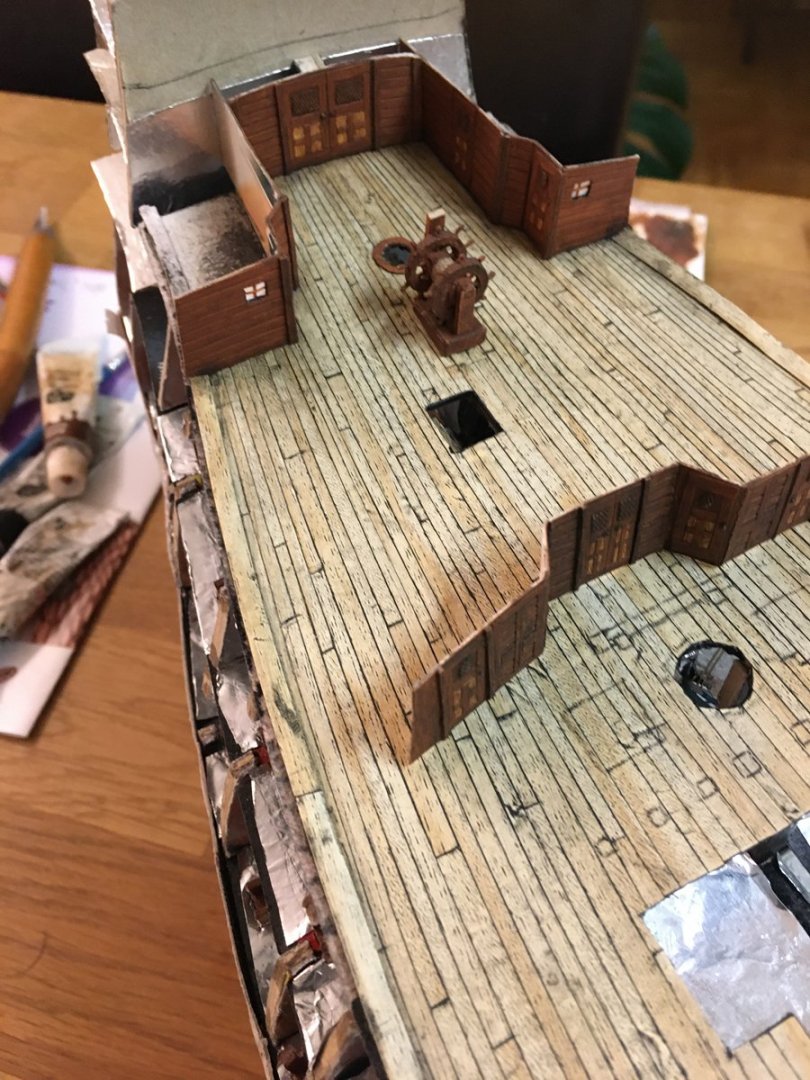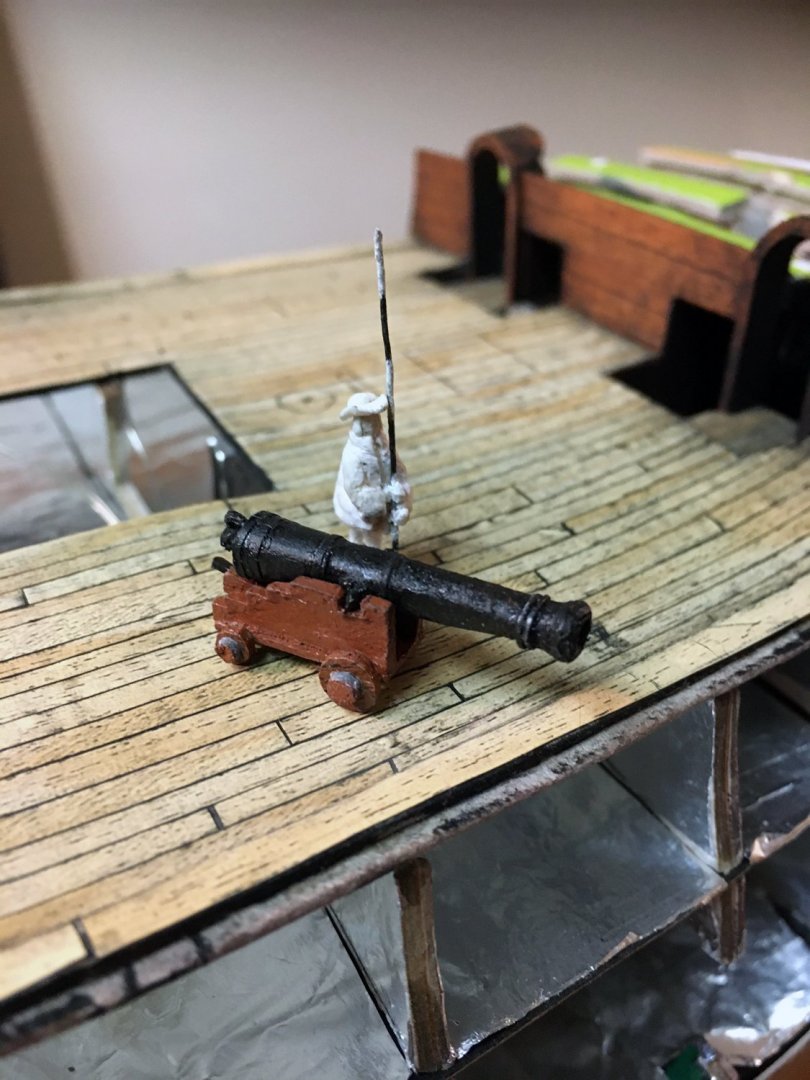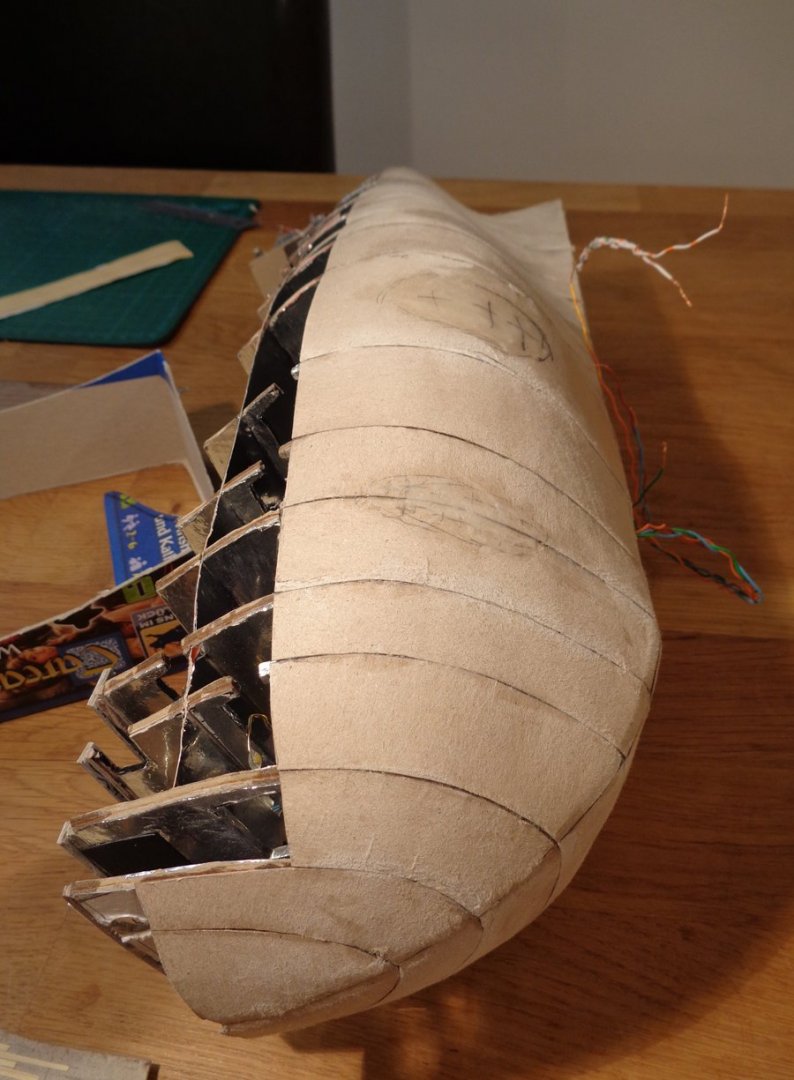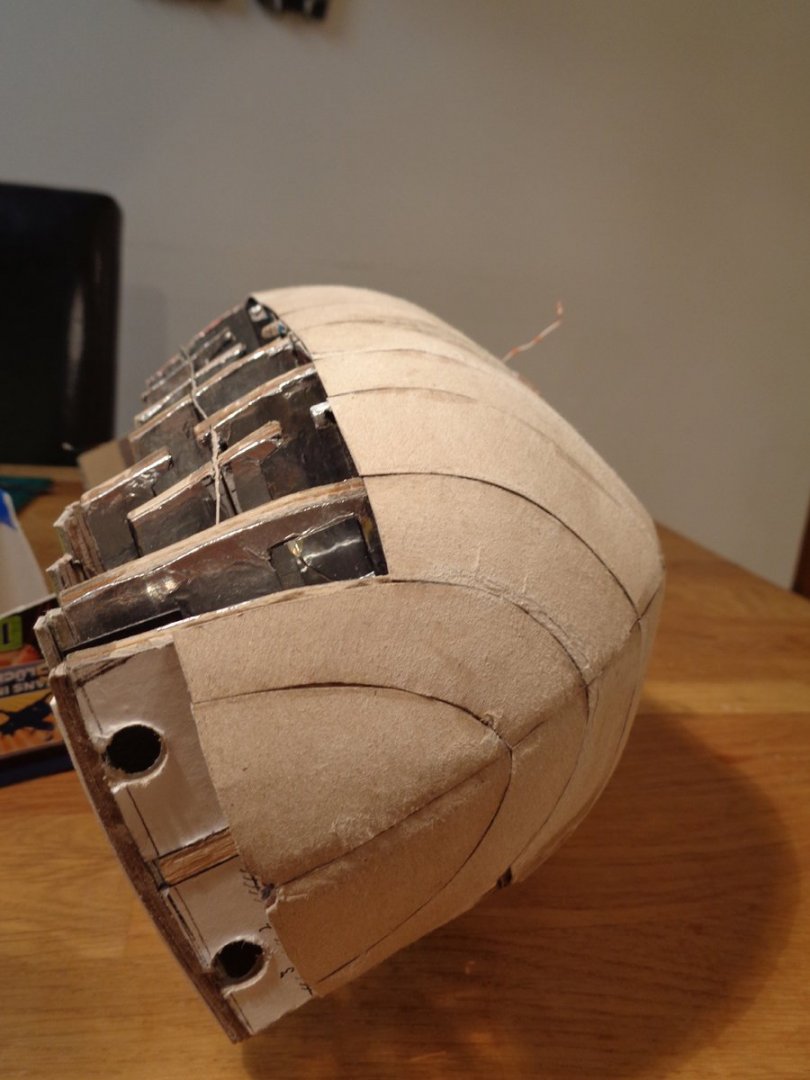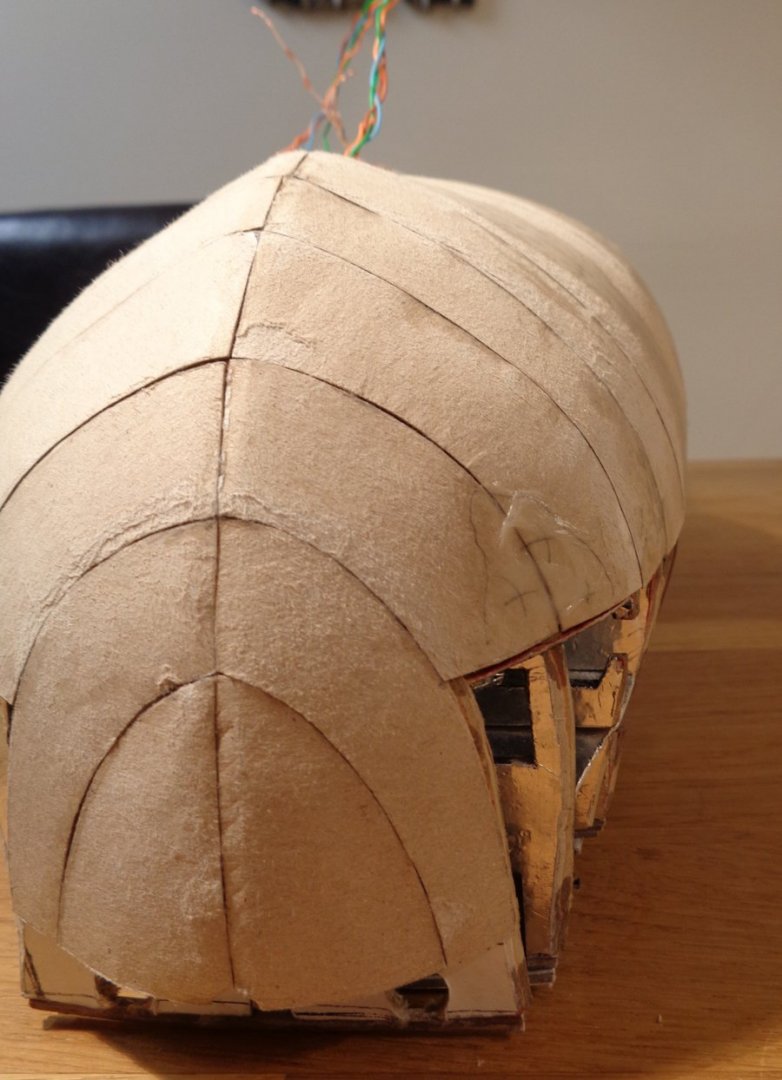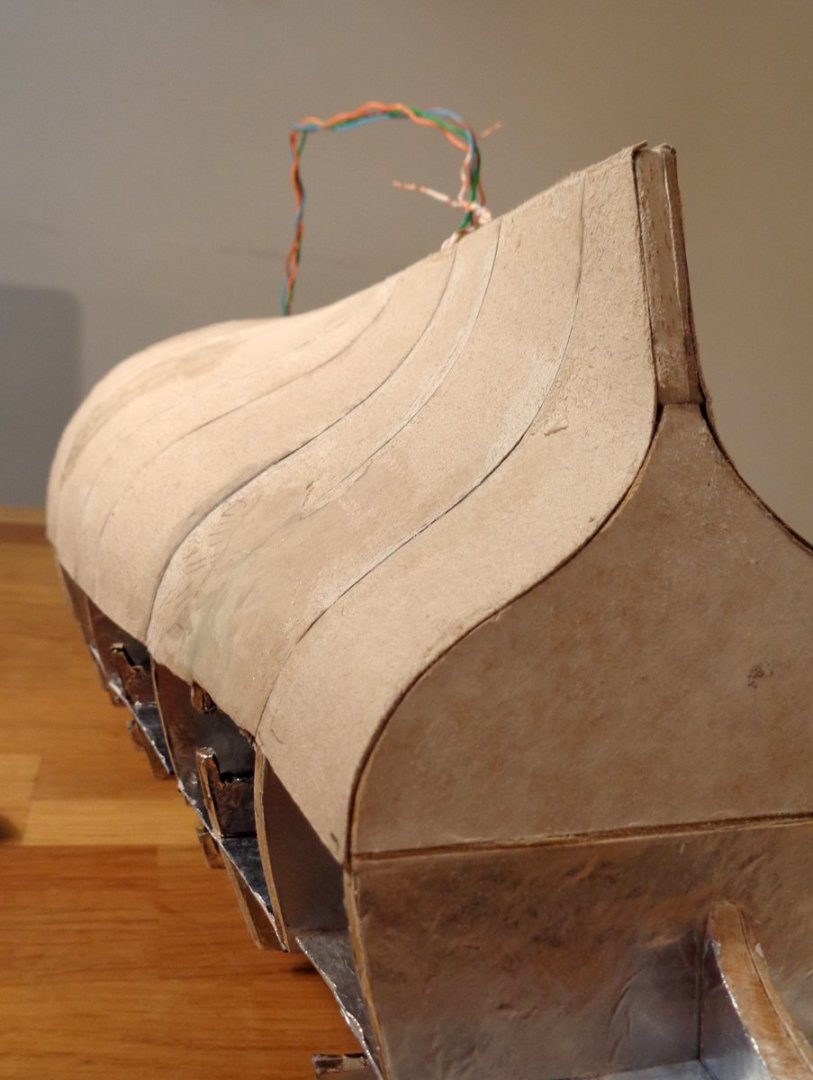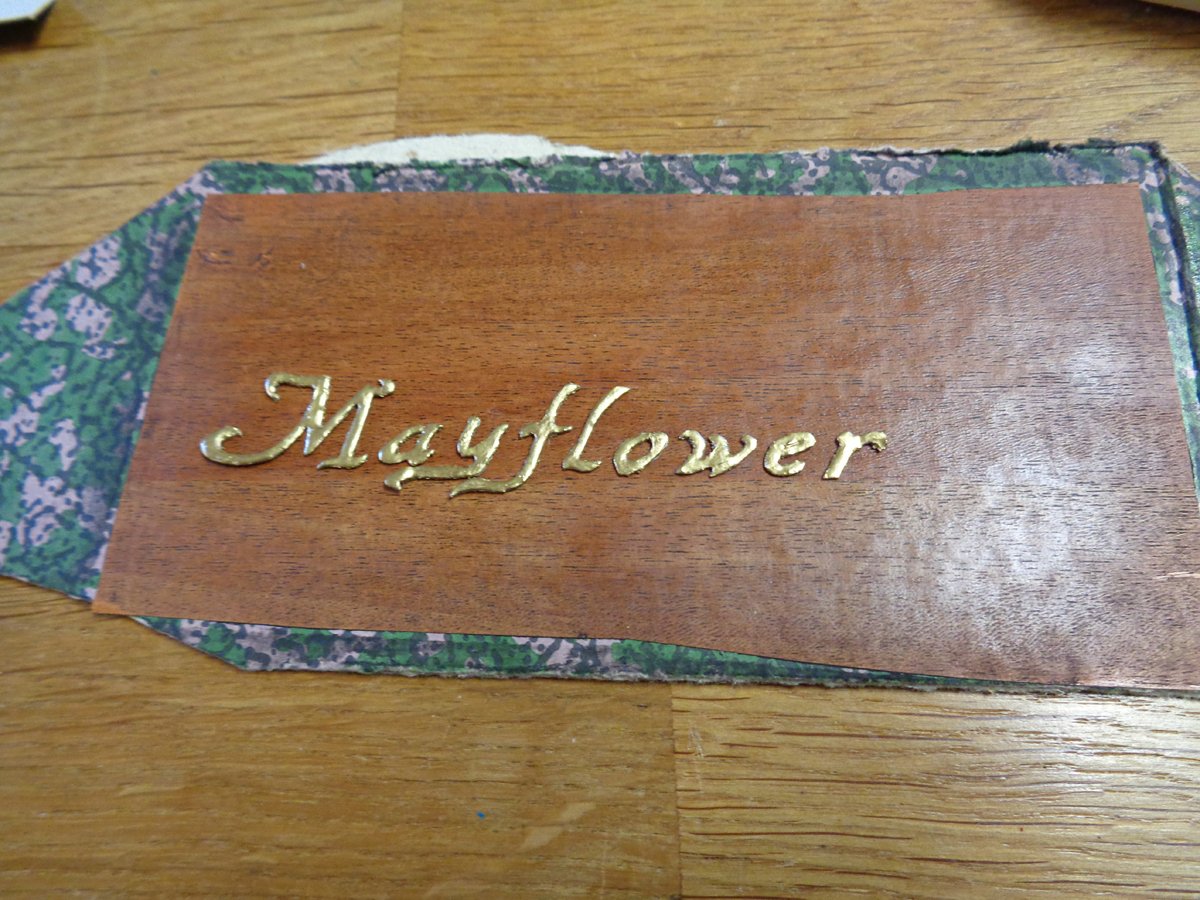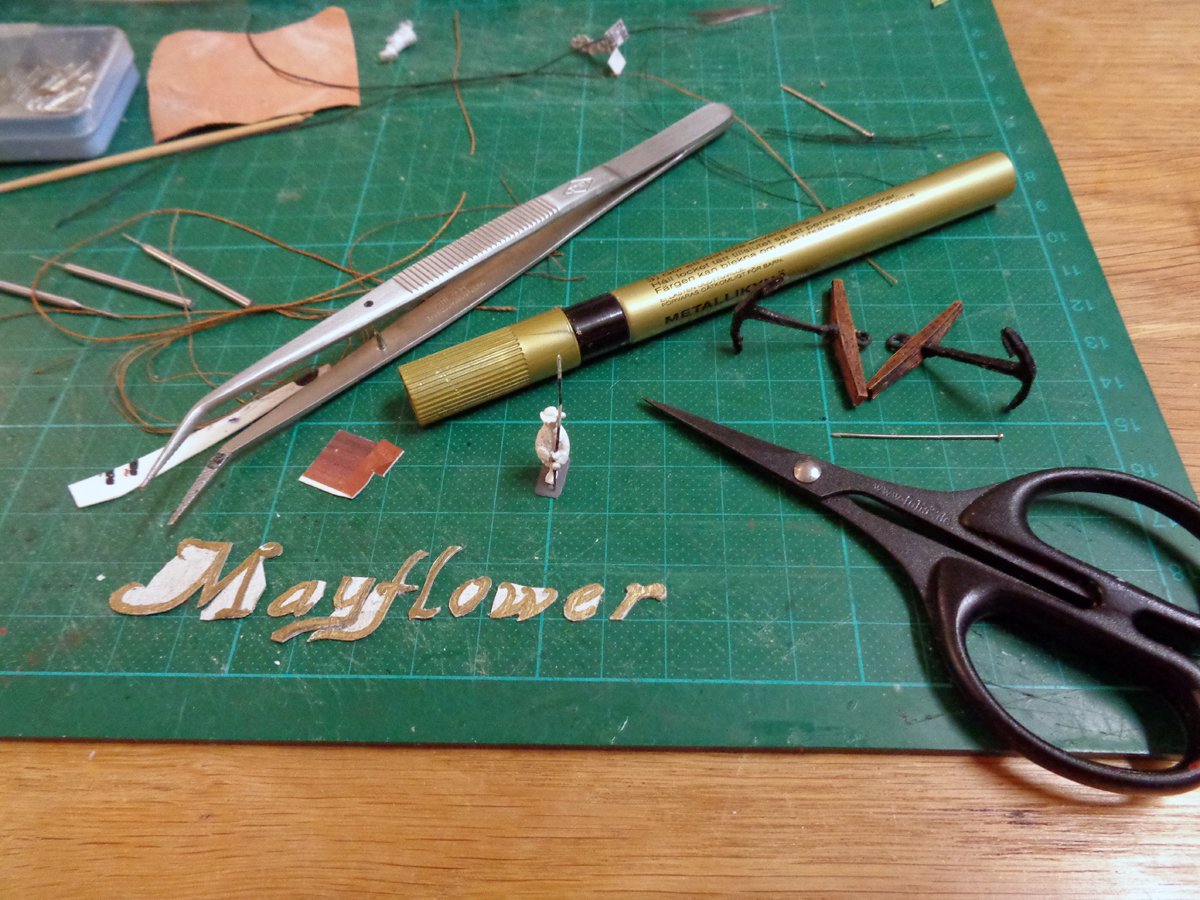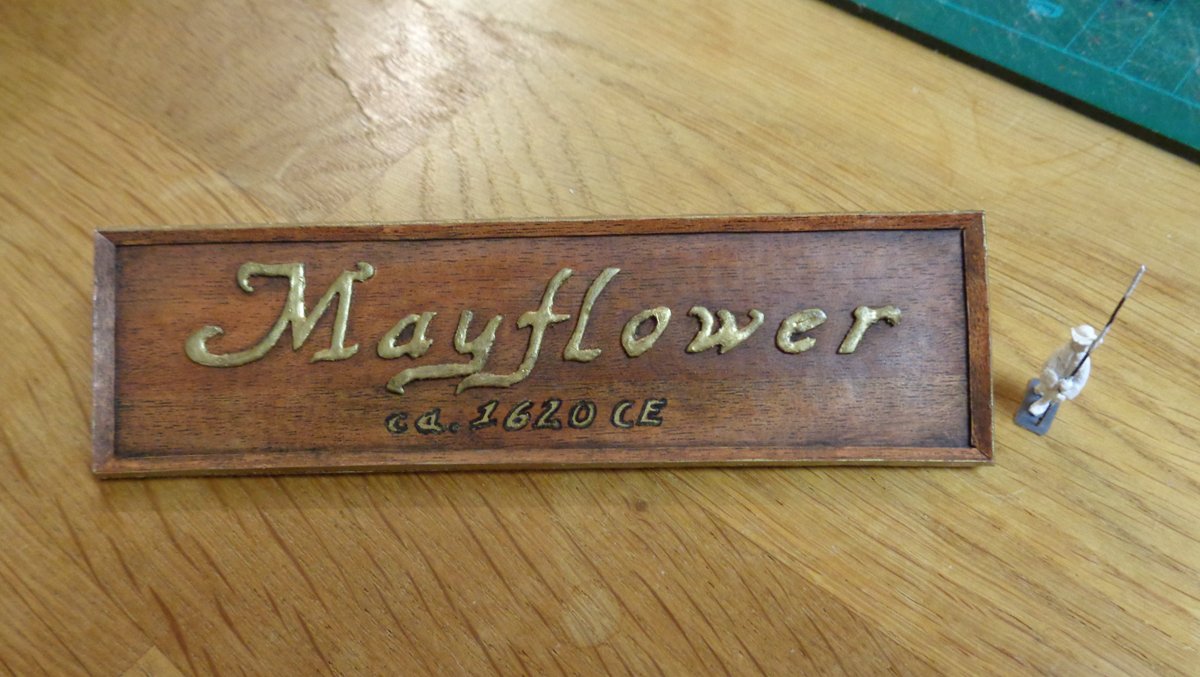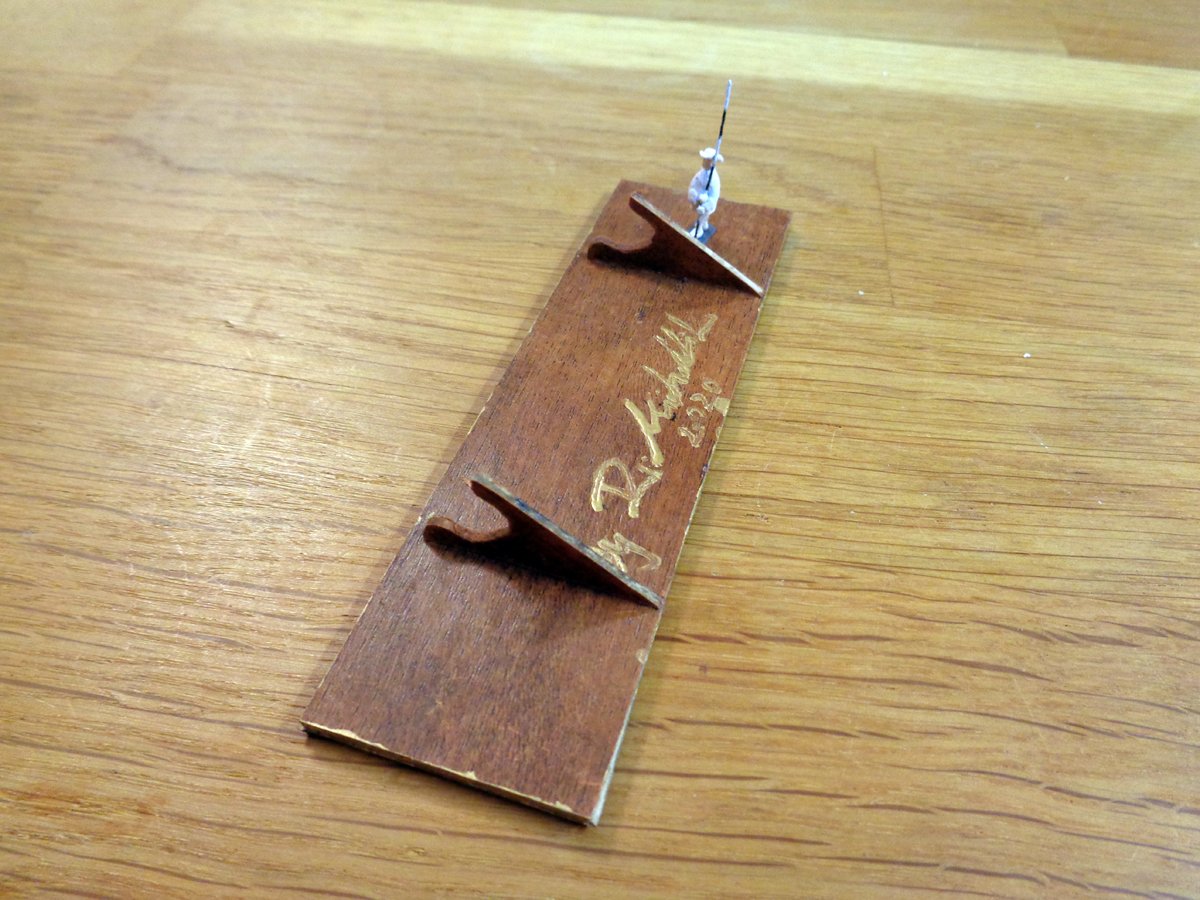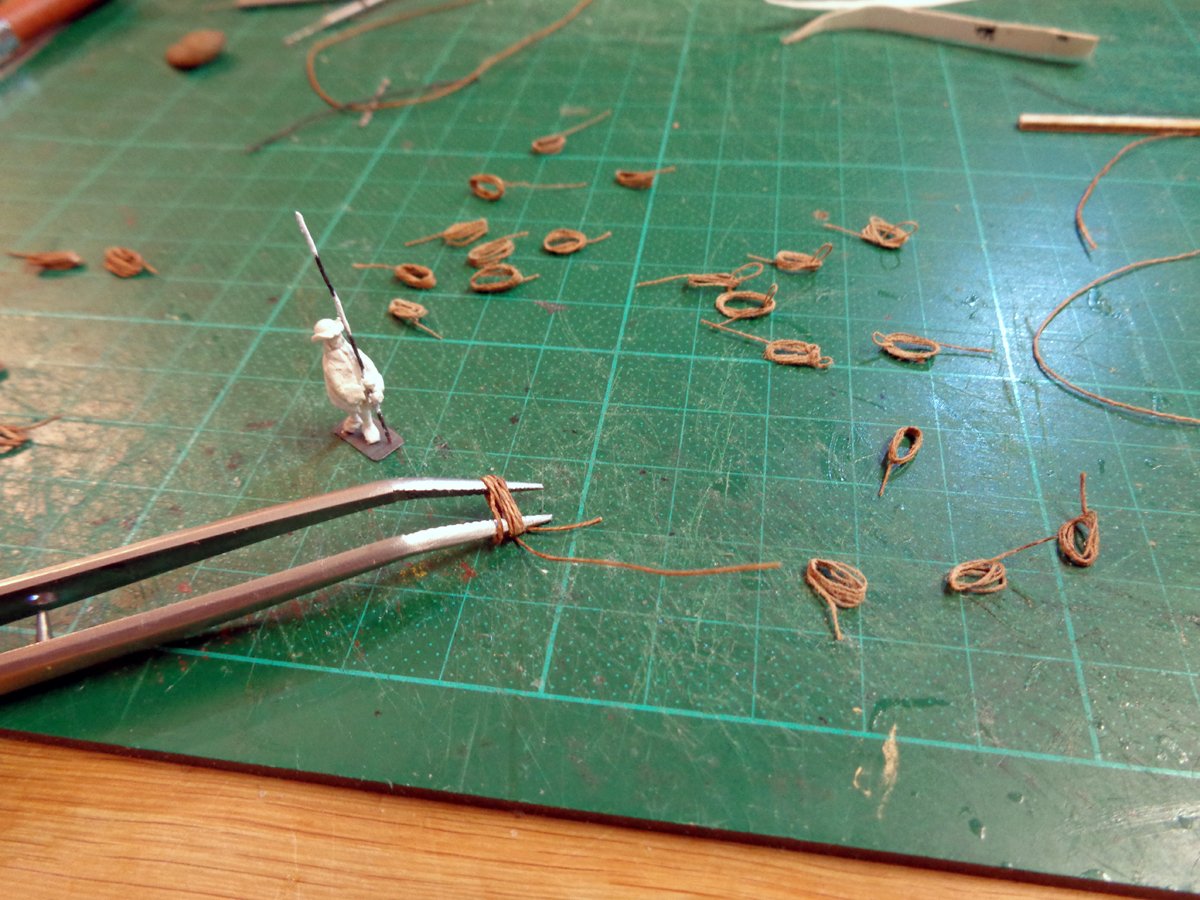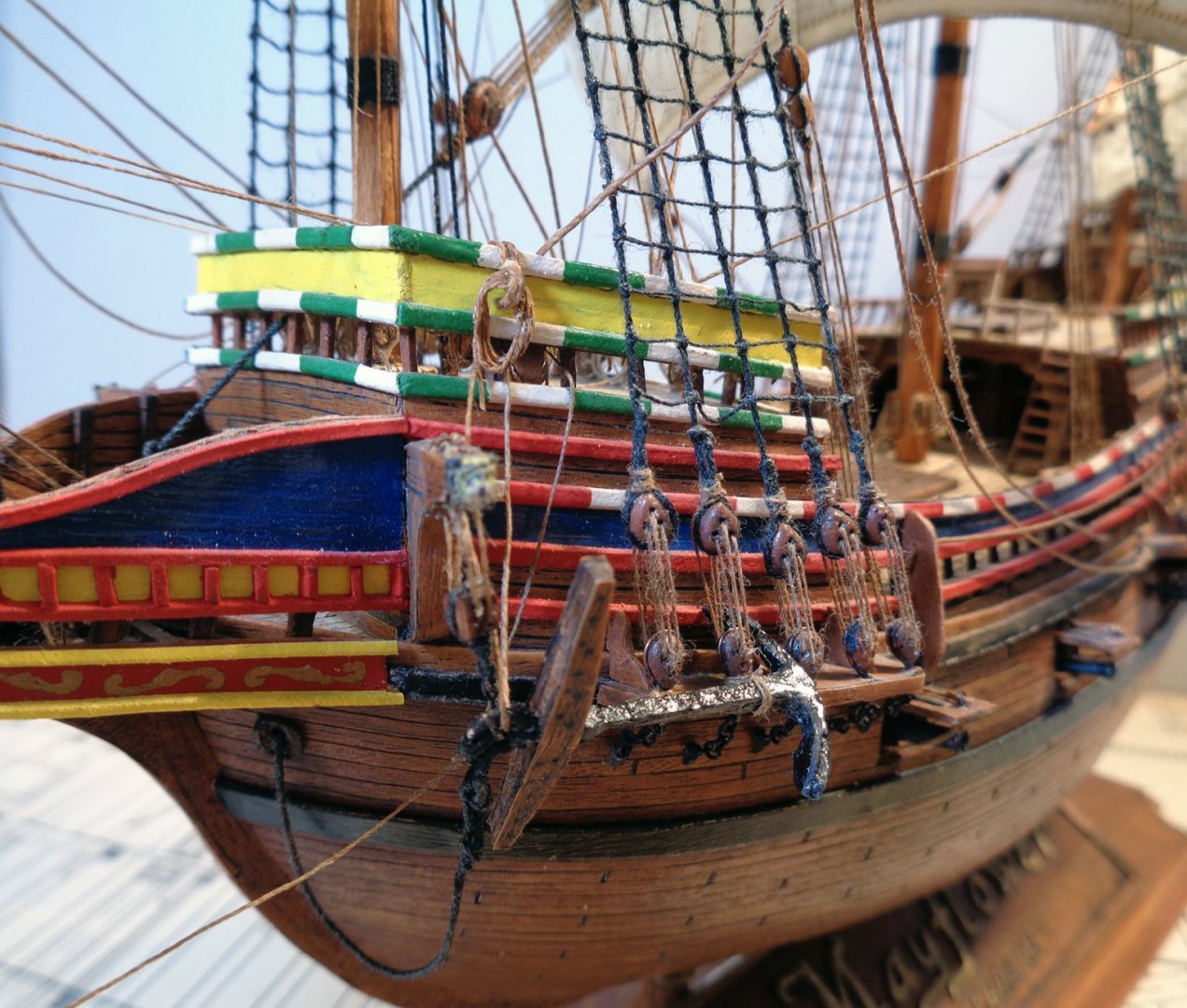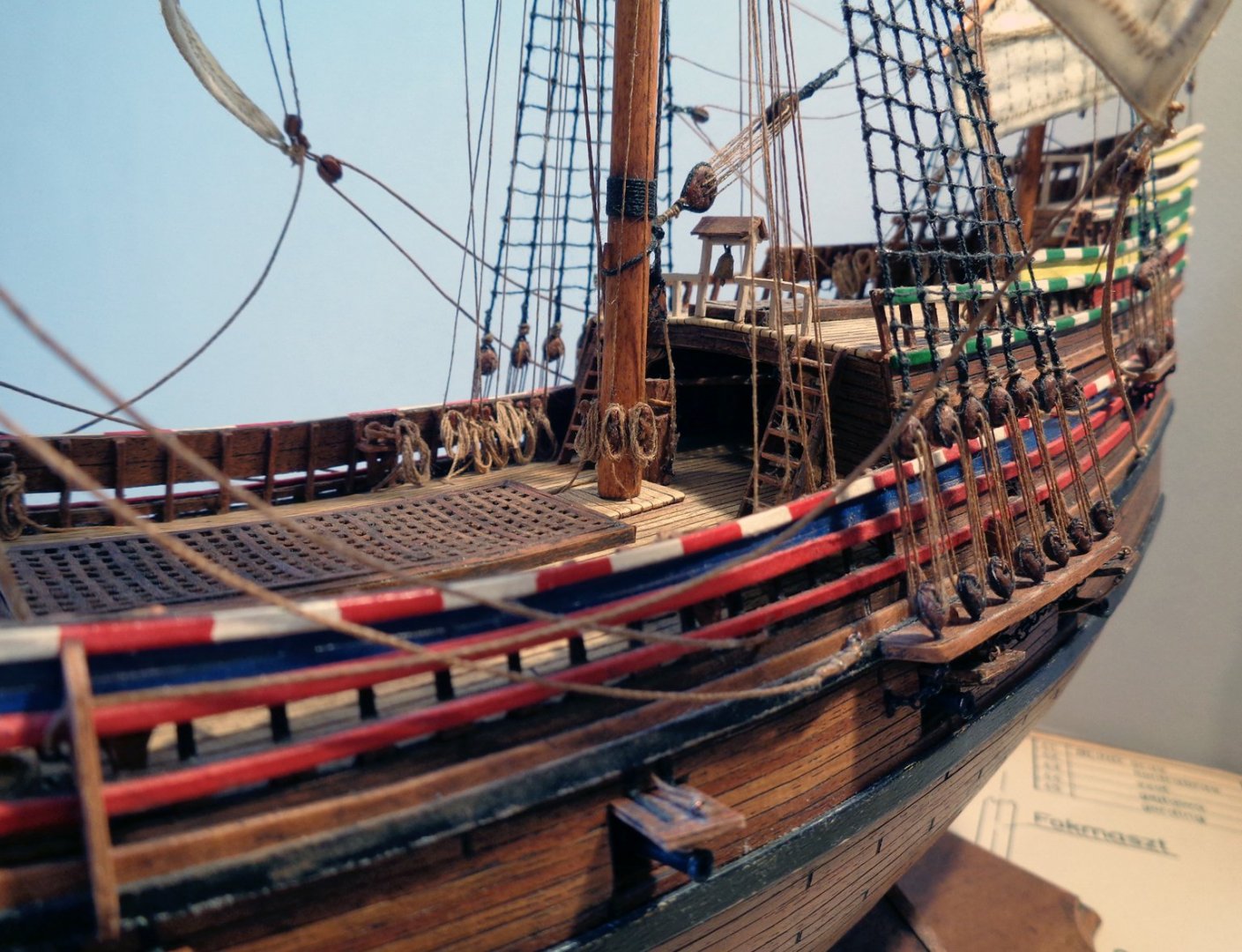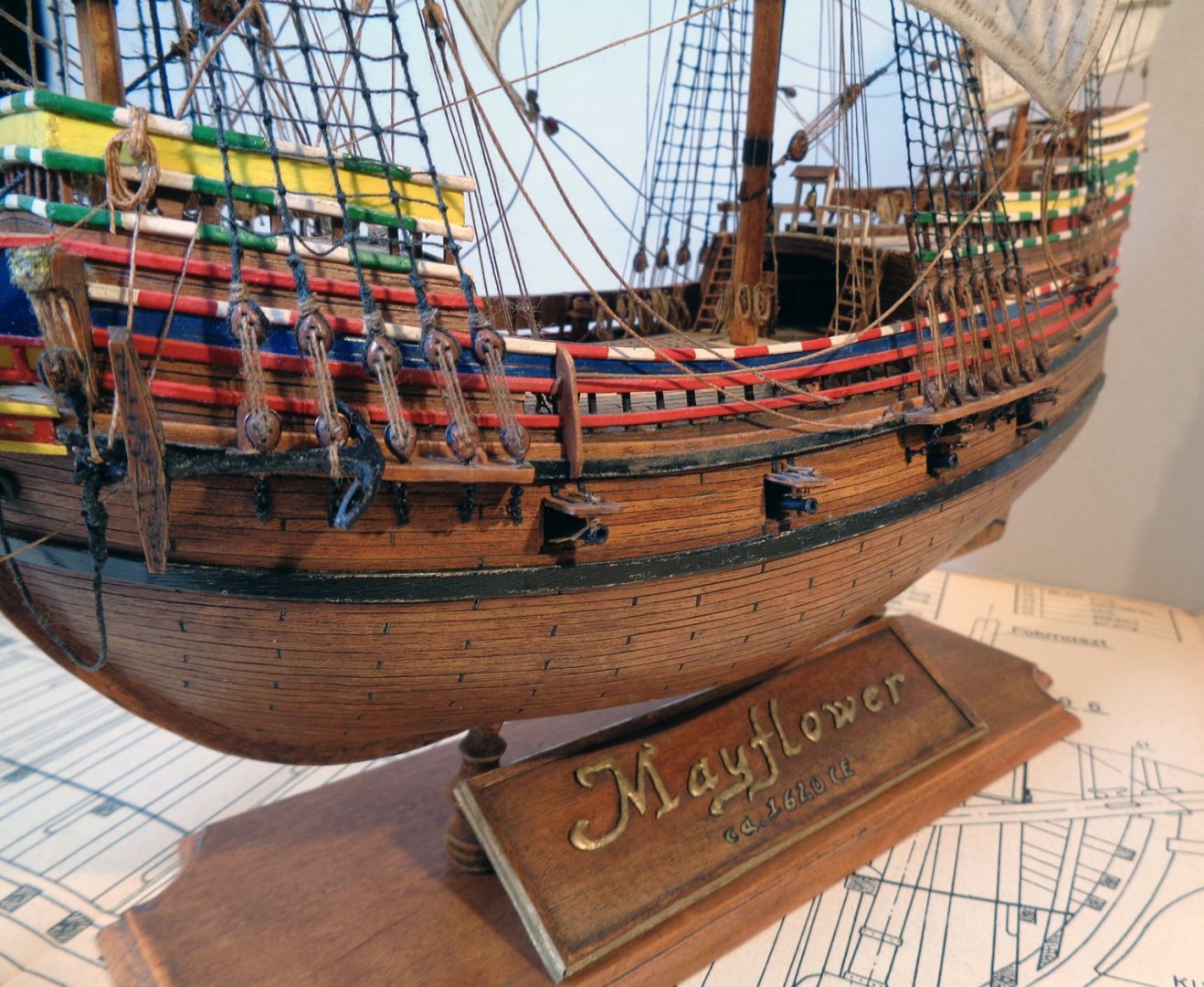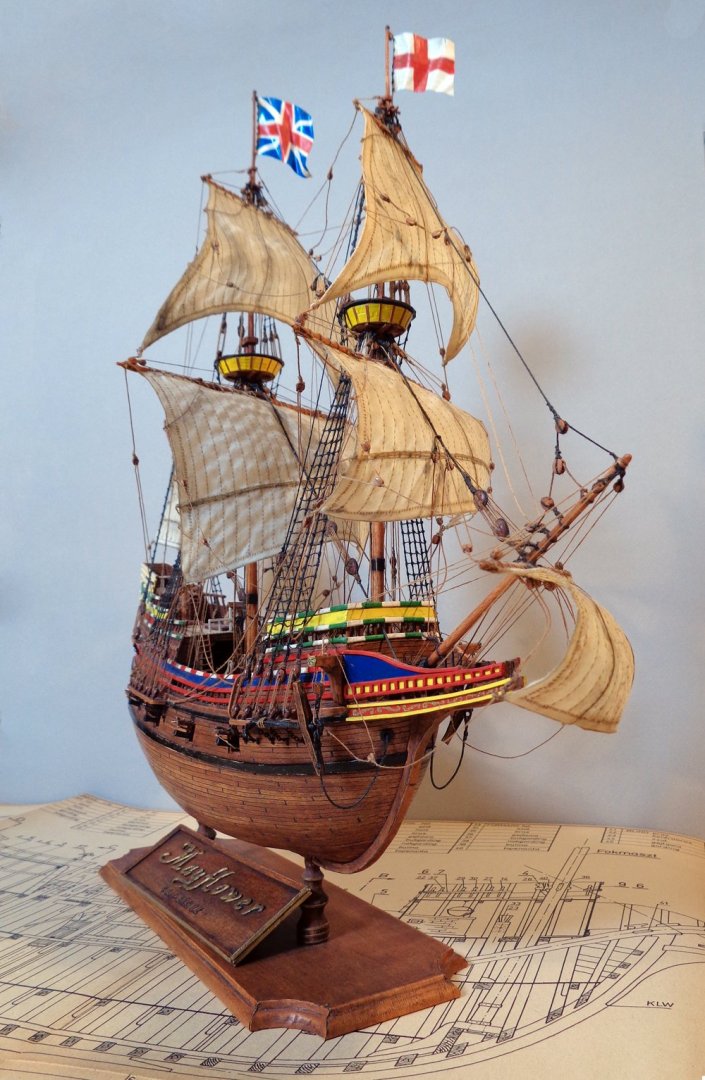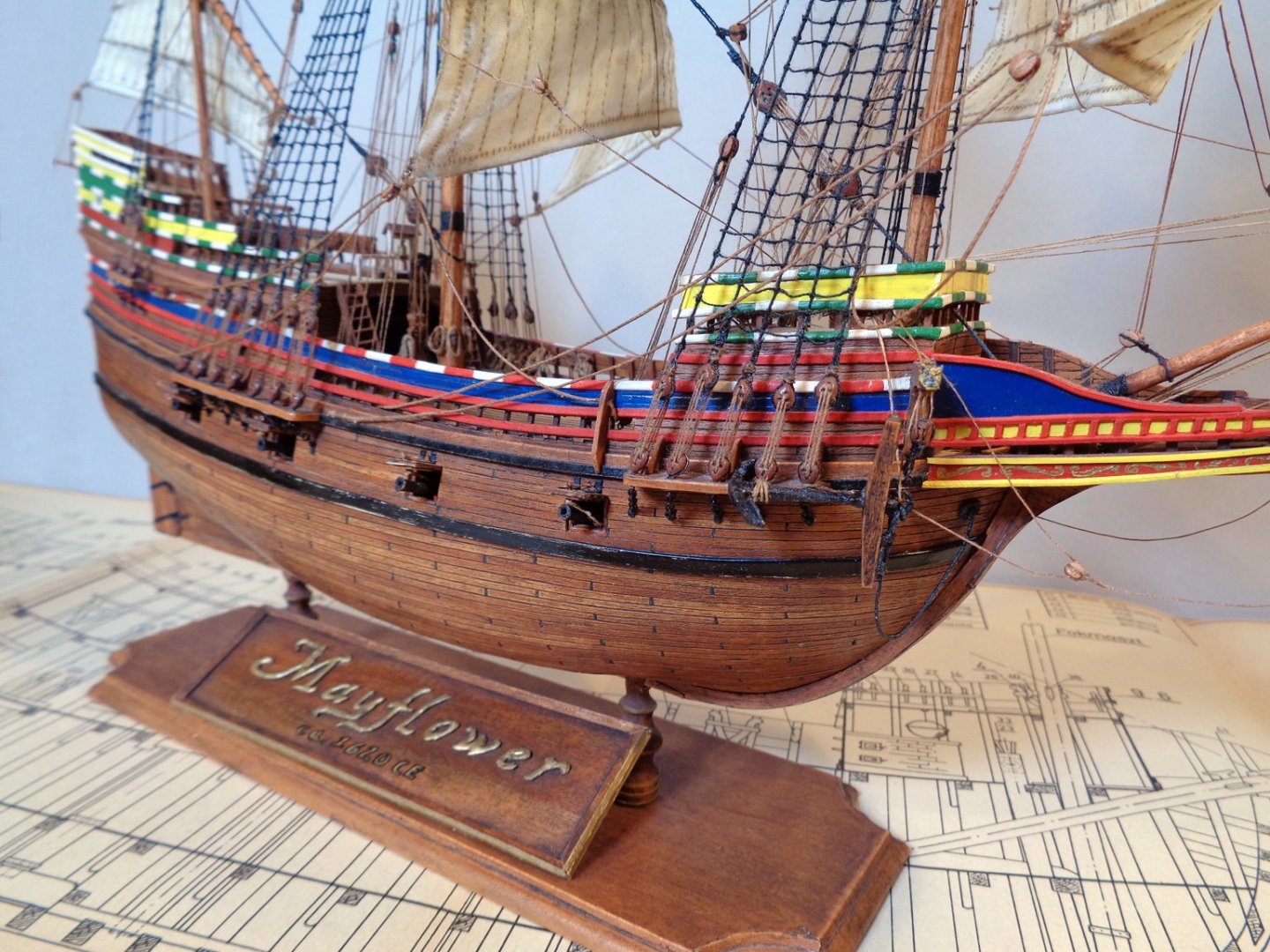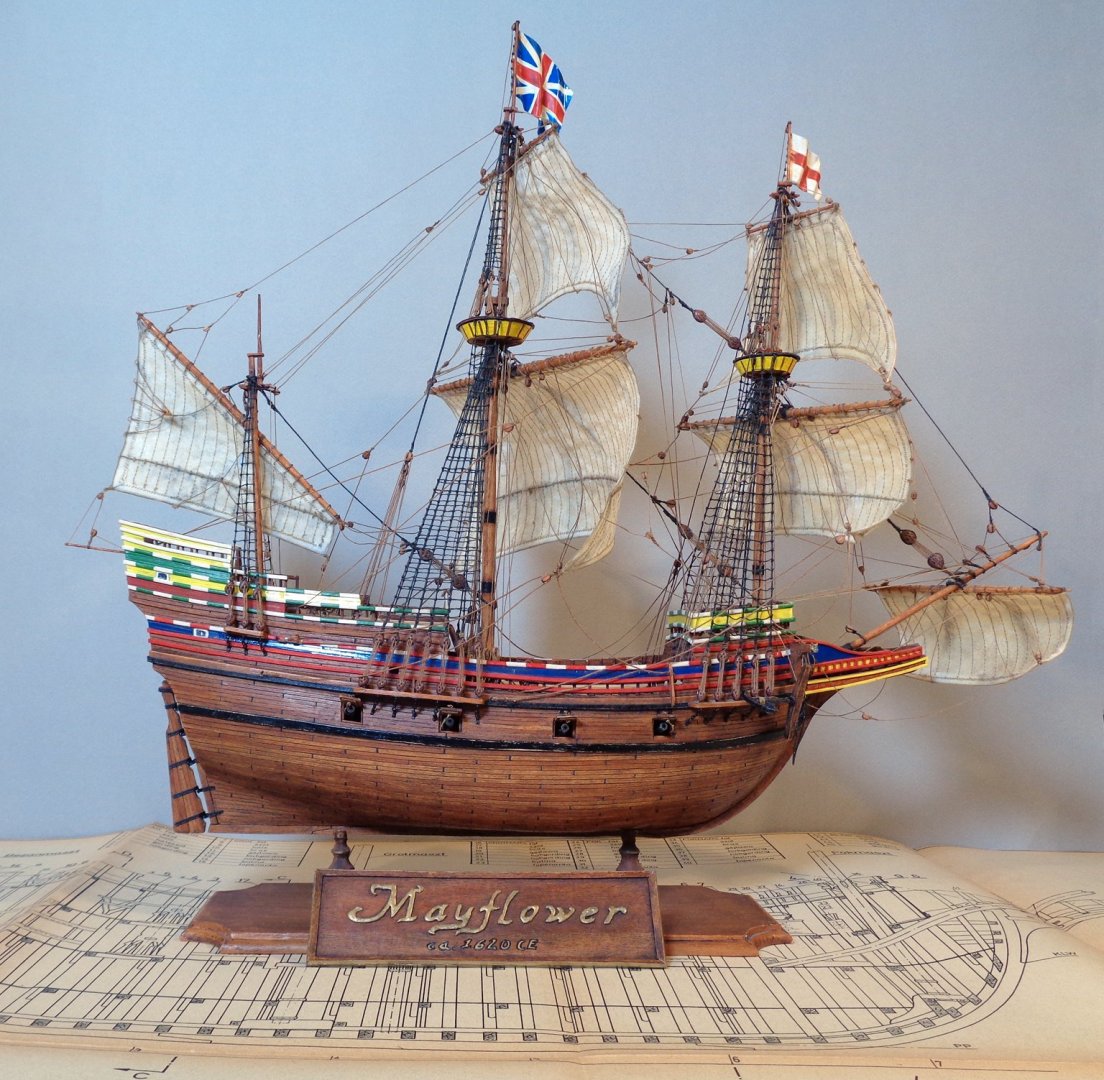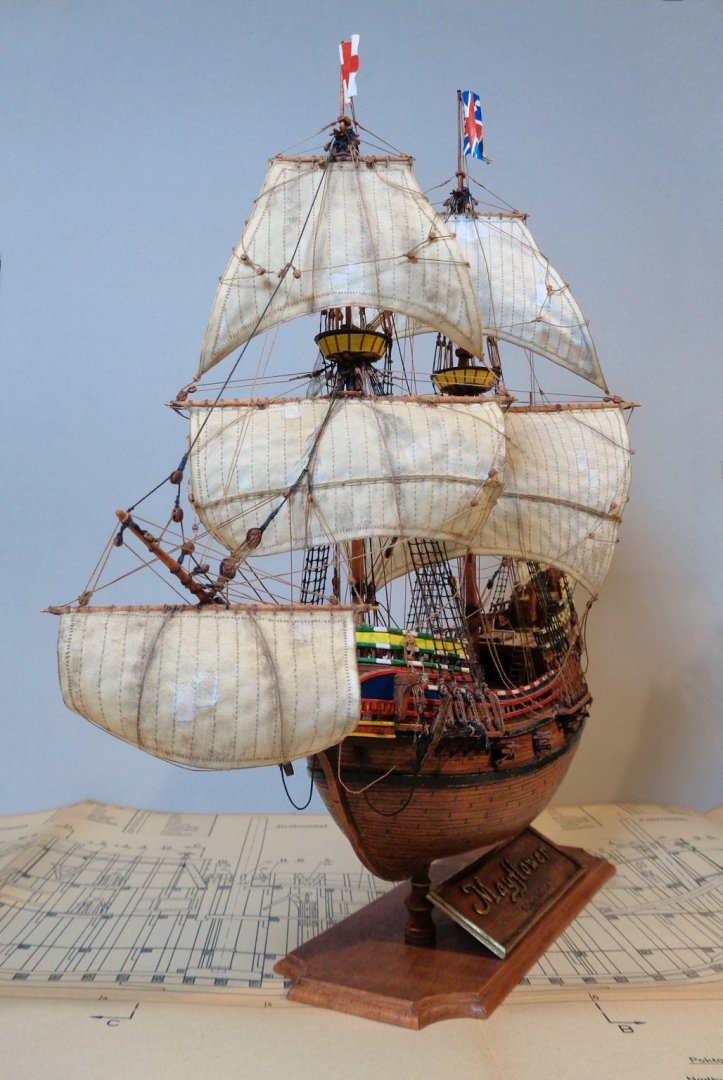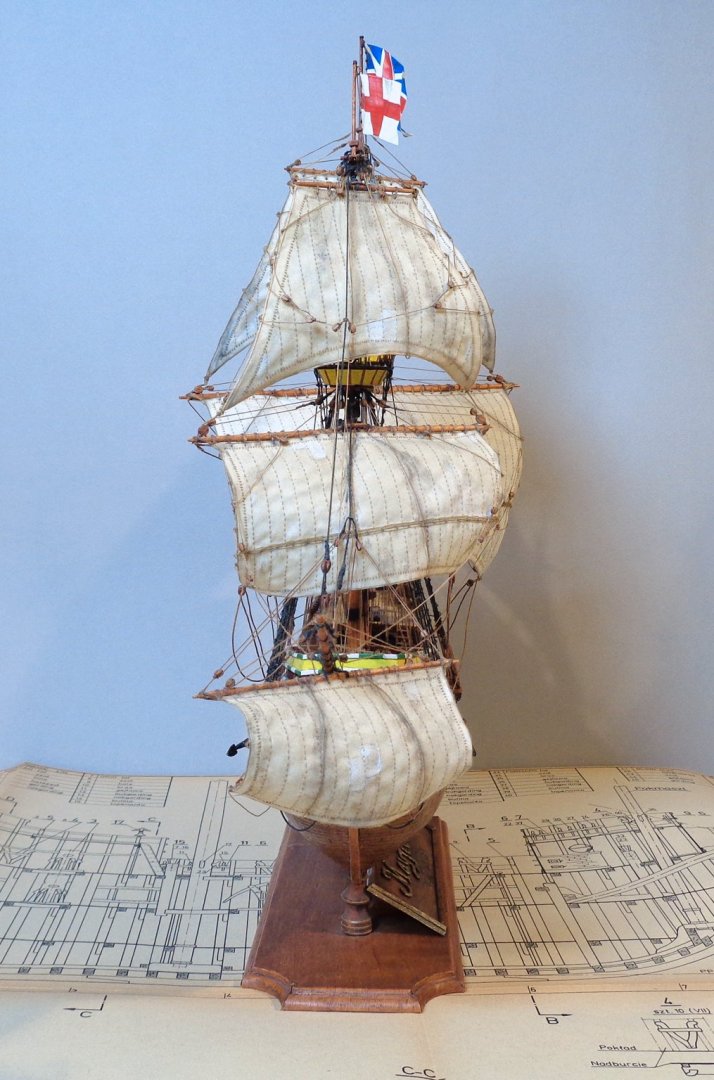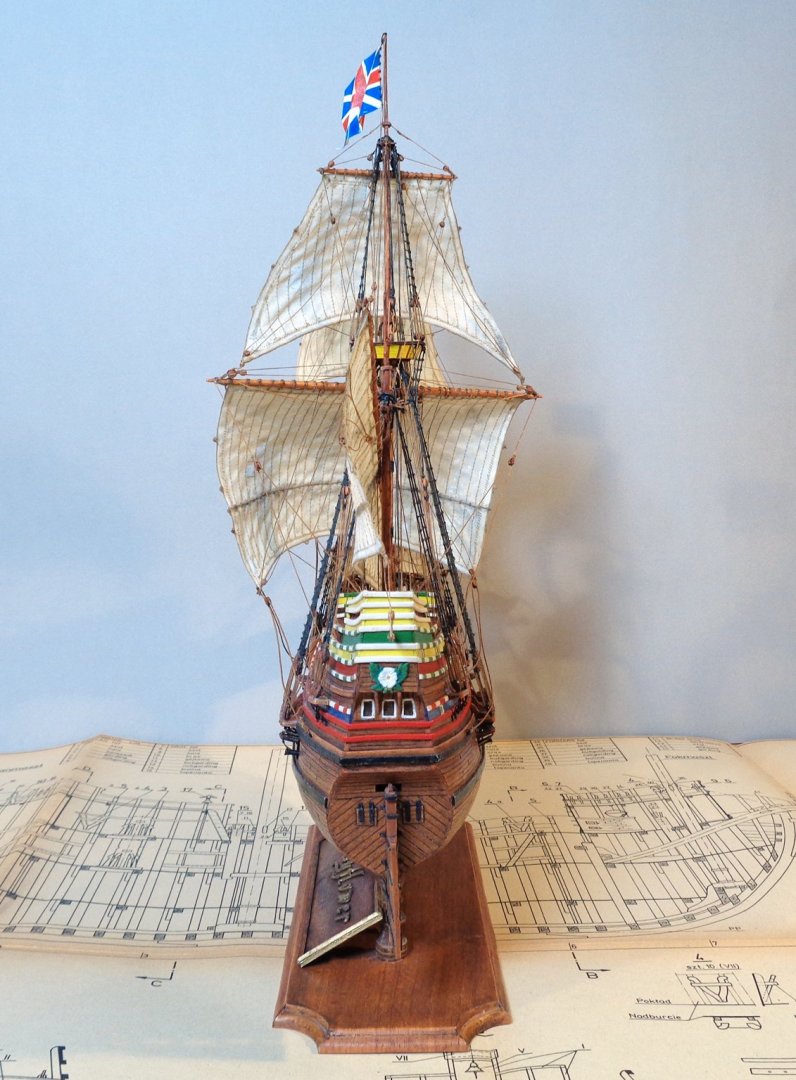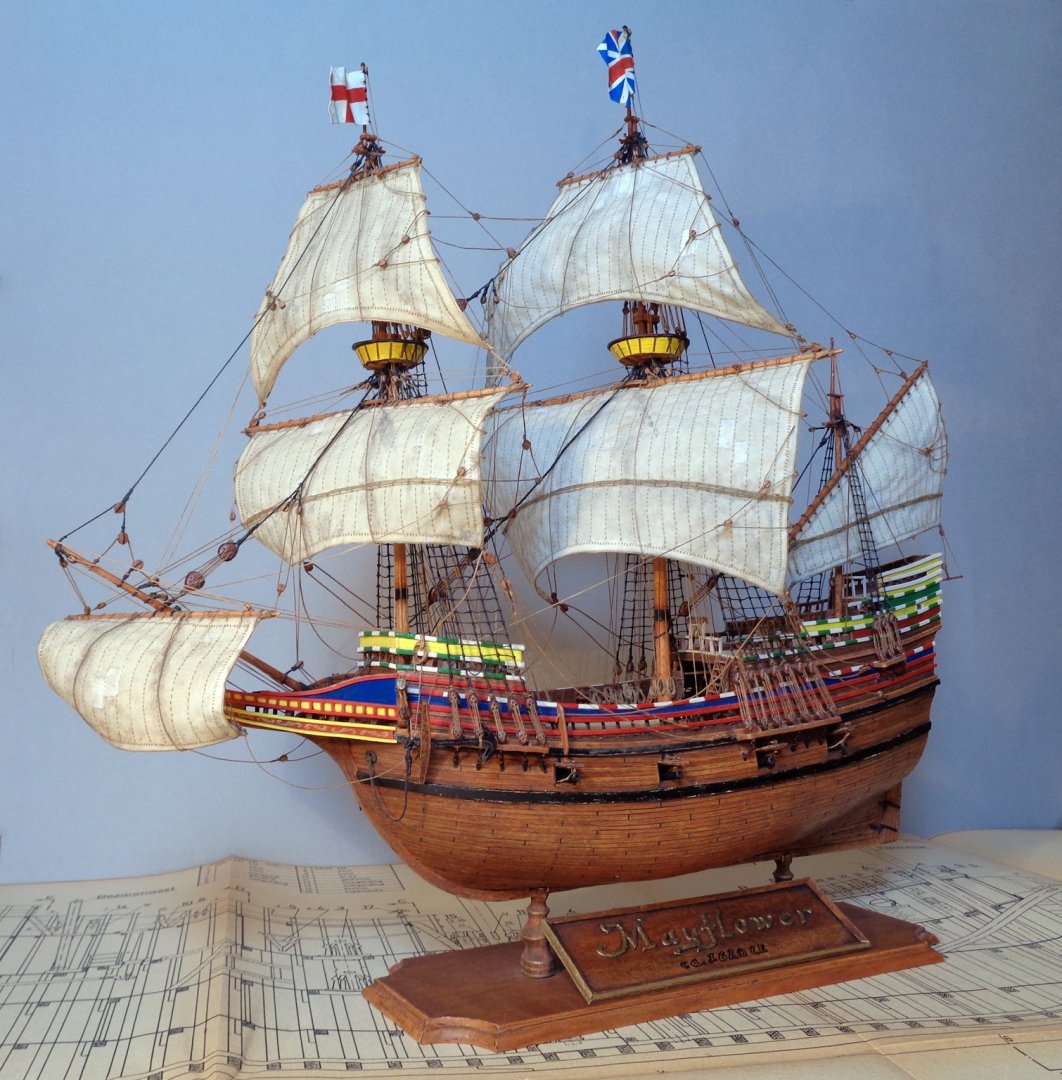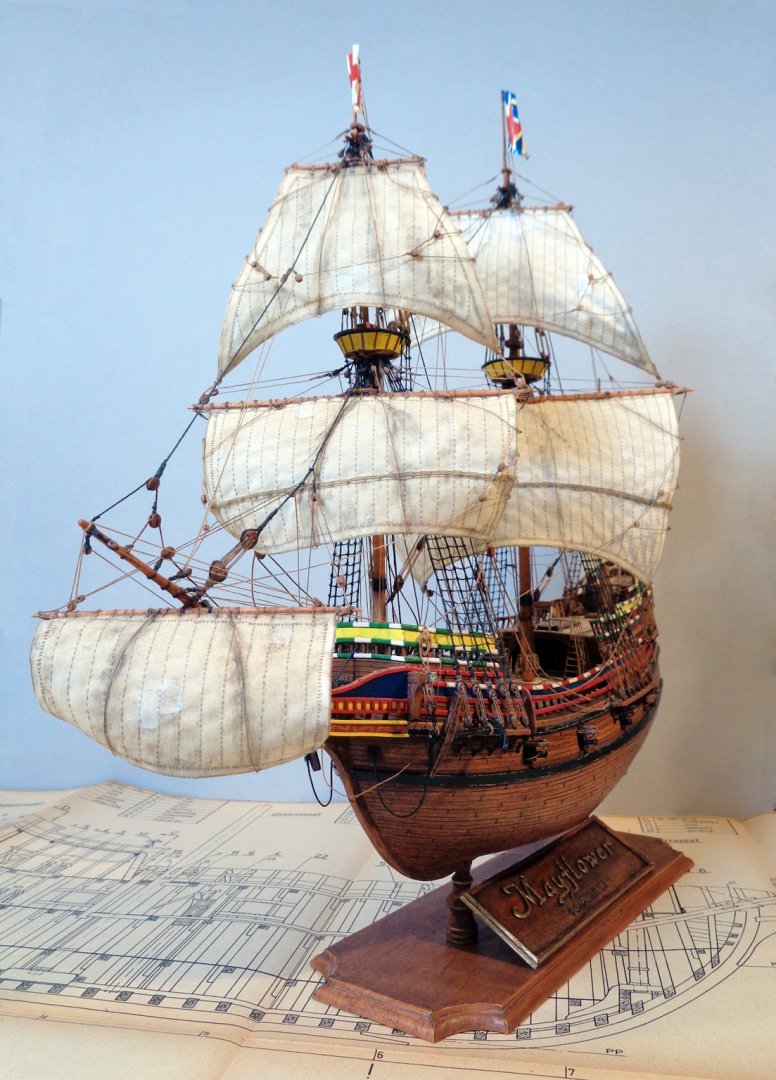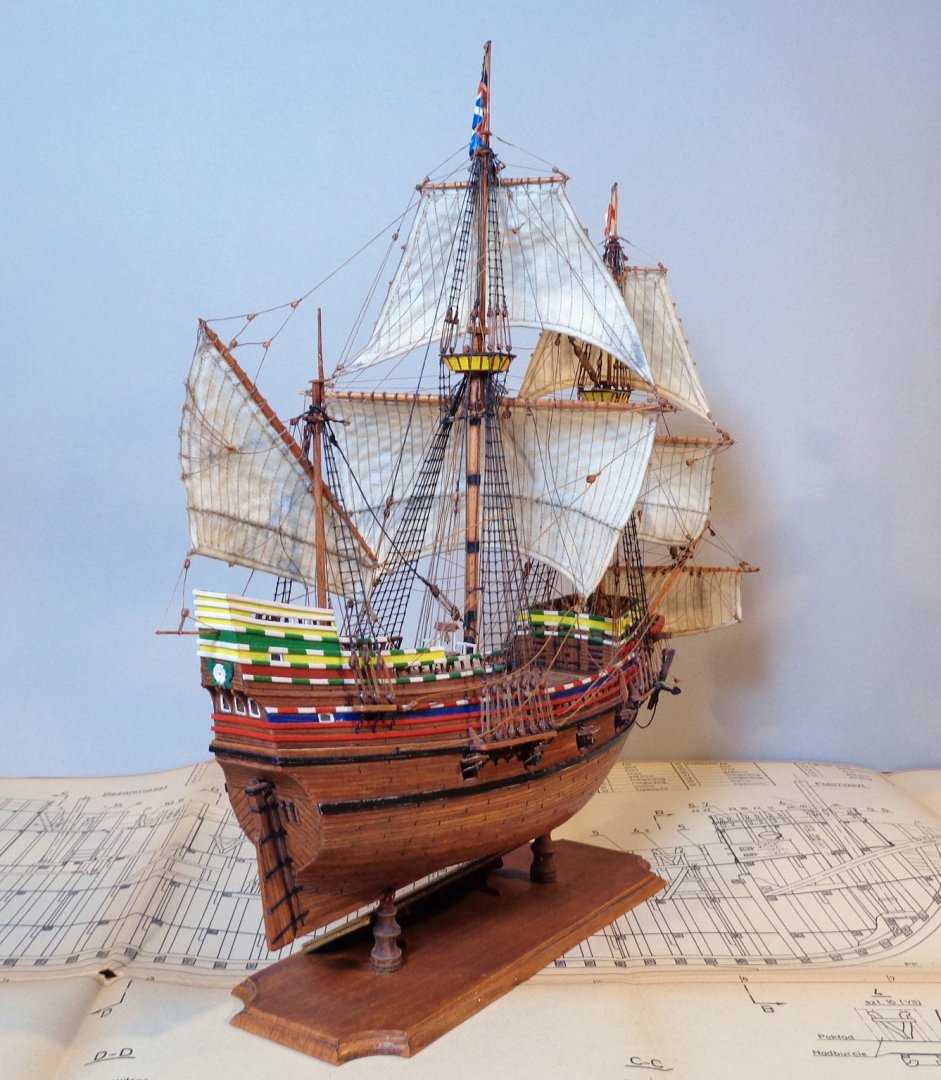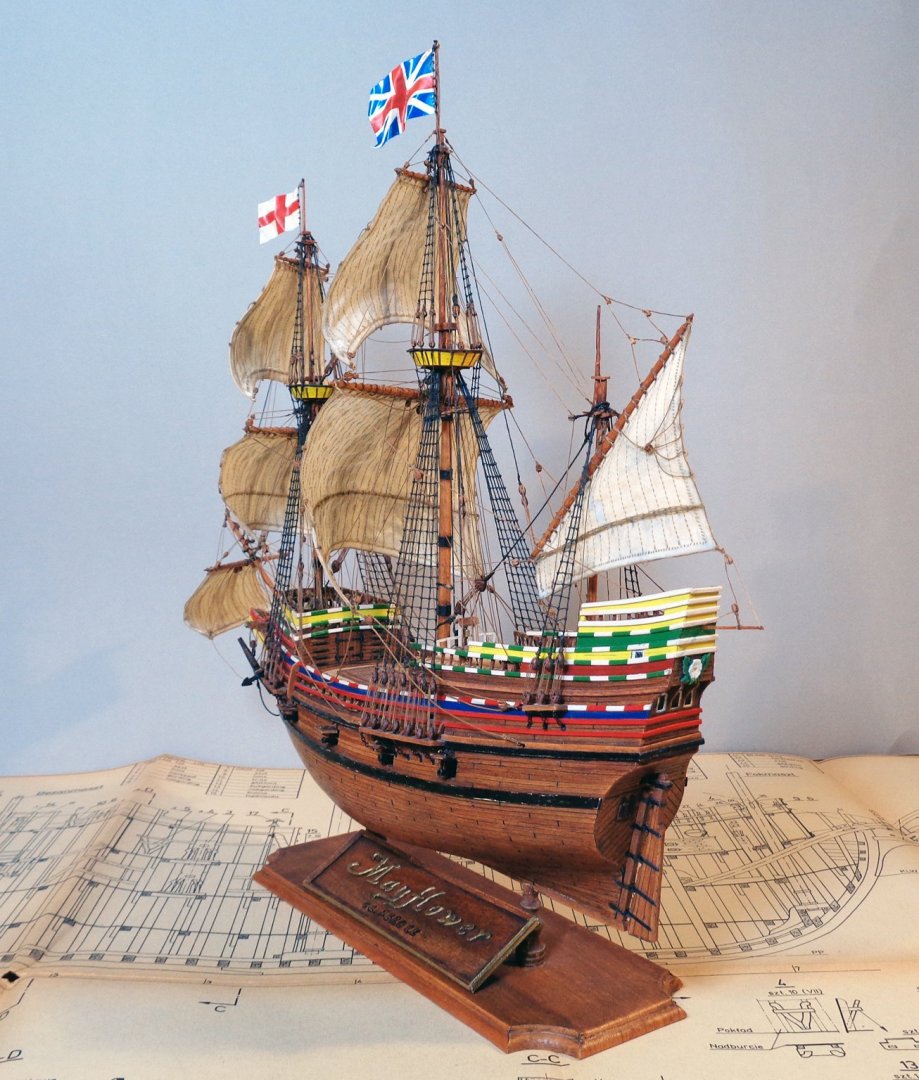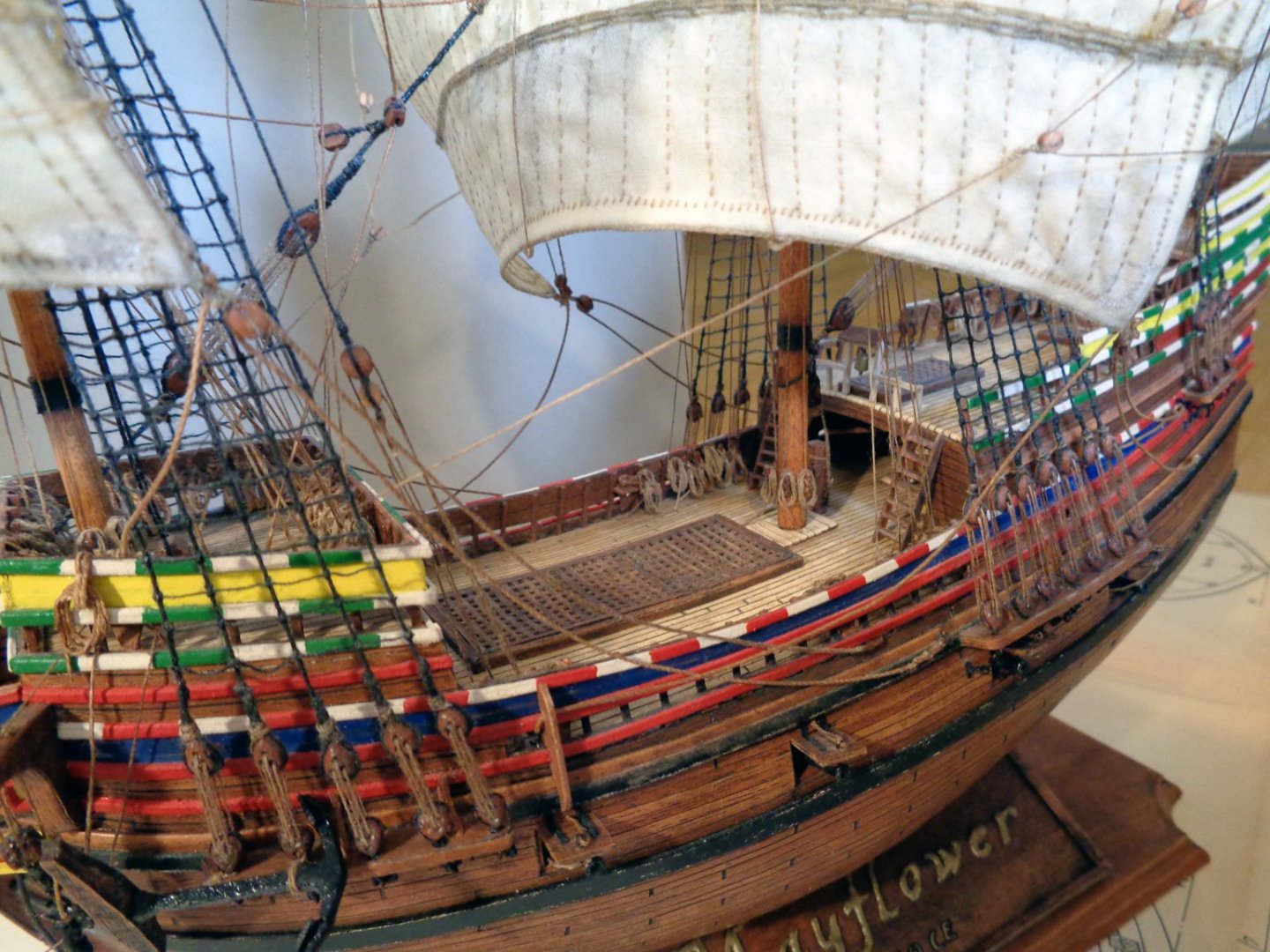-
Posts
113 -
Joined
-
Last visited
Content Type
Profiles
Forums
Gallery
Events
Everything posted by RdK
-
Hi there! Thank you Ab! And thank you all who follow this build and like it. Here a short description on the wales: First I traced the wales with a pencil on semi-transparent baking paper to get the curvature of each wale right. Then, after a few template tries I copied the right ones onto pizza cardboard, cut out, taped with the self-adhesive foil and painted black (first with a water-proof marker, but since that was too shiny I painted again with black oil paint) The two uppermost wales have a relief. I tried to imitate it by glueing a bit thinner and maybe half a millimeter wide stripes onto the 3mm wide wale after which I also taped it and painted. However, the foil did not go so well into the grooves as I imagined so maybe in future when making such relief wales, I will not use the foil anymore. The wale at the back of the ship has a lot of nails, which I imitated by using a bit more of the burned umber brown oil paint. In the next picture you also see a lot of pieces that are coming off at the edges. This will be all fixed and glued back in place, no worries... Then I tried to make the keel. For this I got inspired by the "Nuestra Senora de la Concepcion y de las Animas" as well as by the plans for the famous 17th century dutch two-decker model, of which I have a book from Ab. This will be also my next project, and the Neptune build is like kind of a tryout of different techniques so I do not screw it up when starting the two-decker... So after again making a few templates first (five until I got it right) to match the curvature of the bow, I made the keel from three times a 2mm thick card glued together with white glue, then taped with the self adhesive foil and altered with brown burned umber oil paint. For the long part of the keel I am currently waiting for some plugs for the cables so I will continue with that part soon. Meanwhile I was wondering how to make the ornaments around the gun ports on the upper deck. They have an inner diameter of about 6mm, so for me this is too small to model by hand from the clay. I tried with the two ones at the front of the ship, but I struggle to repeat that delicate work for the other 16 ones (or 24 including the eight larger ornaments). So I made a "rope" from tiny wires, remembering that some model makers did indeed use wire for imitating ropes for the rigging. The template is a "3 x 3 wires" shaped into a ring and some "leafs" made from paper glued on it, then hardened with super glue (CA). I used this ring as a template to create a "negative" form from the clay, which I used to do the ornaments. The clay is supposed to be baked at 150 degrees centigrade for half an hour. It can get a bit brown in the process and like DORIS described, you can actually bake it over and over again. I set my oven a bit too hot and noticed that it started to "bubble" if baked too hot. After baking the clay has a hard, but bendable consistency, almost like a hard rubber ring. This makes it easy to cut and still shape a bit if necessary, while glueing. Then I painted the ornaments with a "gold" marker pen and altered with turpentine diluted black oil paint. However, the turpentine also dissolves the golden paint again so it was a bit tricky. The following pictures show the result. For a scale of 1:100cm I am satisfied with the result, for me this is good enough. If made in a scale 1:75 or even 1:50 I would need to make a better job wih the ornaments. However, due to limited space at home I have to work in the scale 1:100cm. My apologies for the picture quality, I do not have a good camera and the light here is also not the best... So much for now. Next will be hopefully more on the keel and some more ornaments. Once the keel is in place I plan to start working on the balconies. Rgds, Radek
-
Hi there! Thanks for the likes! Here, where I live the days are again getting shorter, colder, and darker so it is time to continue this build. Afer planking the whole ship with the foil strips I decided to imitate treenails. For that I use the old technique used for wooden models, where one uses a punch tool, or a cut syringe, to simply punch the imitation of a treenail into the plank. all together I 'count-estimated' bit over about 10 000 treenails... In some of the planks that were made from longer stripes of the foil, I imitated the plank butt with the blunt ship model knife I once as a kid got from a neighbor (ship and building wood modeler). The reults look not so good prior to altering with oil paint: Where the plank butts were the actual end of the foil strip, the foil tended to go off after punching the treenails, so I had to glue them back on. Then I tested different oil paint colors for the altering. For the Mayflower I used black oil paint. But this time I decided to use brown burned umber instead. The oil paint is applied and then "smeared off" so it fills mainly the grooves. In the beginning it is all quite shiny, but gets more blunt when the oil paint dries. Currently I am glueing the wales in place. After gluing the starboard ones in place I realized they might be a little bit too wide , but, well, this is a fictive ship, so I am not correcting this anymore. Despite, if I'd try to take them off and redo, I will rip off the plank foil strips, so for this model I will leave it as is. This whole build is anyway more a "try and error" play for me trying out new (old) techniques and see what I can do and what not... Thus far, I am satisfied with the result. Imitating the treenails, which are in this model about 0.25mm, corresponding to a diameter of one inch in real size, I think the size is appropiate for such a big ship and planks of 3-3.5mm or 30-35cm width. The question was just if I "nail it" or "screw it" completely... Judge for yourself. So much for now. Next will be the keel and I will describe how I did the wales. Rgds, Radek
-
Hi there! I finished "planking" the ship, which is basically cutting out stripes of foil and glueing/attaching them onto the ship (then alter with oil paint - work in progress). But before I could do that, I had to make the sides of the ship and the stern parts. The side parts of the ship I made from my favorite frozen pizza box card (about half a mm thick) and glued some tin foil (aluminum foil) to the inner parts for better reflection of the (then still weak) LED light. The upper, visible inner part for the main deck was then added from two pieces, about 2mm thick card, each glued on top of each other. The next photo shows only one of these 2mm thick pieces. Then I used the foil for the "planking" of the inner part and altered with black oil paint. Unfortunately I was too keen on trying out brown oil paint on top of the already with black paint altered pieces before testing on some separate part and it got a bit of a dirty appearance in the end... The imitation of the thickness of the hull as visible in the gun ports I made with a thick card from excess parts for a tabletop game (Carcasonne ). I painted them first brown and then red (acrylic paint markers) by smearing the red paint off a bit to achieve a more "rusty" red instead of a clear shiny one. The results are satisfactory. In my next model I'll have to work on it a bit better, now I had quite some practice with this part of the build. Back to the top of the inner part I had to attach some black rings around the round gun ports as well as hooks and rings for the gun rigging later on. My apologies for the not so good pictures. I try to get better with it. The windows I made from some mini grip bags (because they are partly already covered with a semi-transparent white) and the foil painted black (and gold for some windows), cut in tiny strips. I remember DORIS once telling me they can be cut even as thin as a hair. So I tried my best to get them tiny enough for the windows. I did the windows fo the stern part in the same fashion, using a tiny card strip painted brown (acrylic paint marker - or pen) for the frames. Then, after all pieces were glued in place (with quite some struggle...) I could start with the planking. For that I used the foil with a width of about 2-3.5mm, representing planks of about 20 to 35cm width (or about 8 to 14 inches). The length of each plank should be about 4.8cm (or double that length where I later cut the plank butts with a knife) and a pattern every 4 planks with a distance of 1.2cm between plank butts (about 4 feet). I used the same pattern on my model of the Mayflower. This image is from the Mayflower build: I found this pattern somewhere here on Modelshipworld.com back then when building the Mayflower. This is an awesome forum to find a lot of information - Thanks everyone! Now, this is surely not a representative pattern from the 17th century, but for my eye it looks good on the model. Of course I struggled with the stealer planks to keep the pattern, and in the bow of the ship the length of the planks differ form the pattern. There the planks should be anyway a bit longer, to achieve a stronger hull against the forces of the water. Also, looking at the planking as documented from the Swedish Vasa ship (although we should not base our whole interpretation on only one wreck), there was not really any beautiful planking pattern. And even the symmetry is rather fiction than reality, as Fred Hocker wrote in "Interpreting Shipwrecks. Maritime Archeological Possibilities" (2013, Södertörn Academic Studies 56, Southhampton Archeology Monographs, NewSeries No. 4) in his sub-chapter "The myths of symmetry and regularity". I tried to be as symmetrical as possible, starting to plank from the keel upwards (contrary to the common way of planking from the main wale down in addition), but somehow ended one plank more on the larboard side... Sometimes I had to taper the planks after I attached them to the model. Tricky, but not impossible... Size comparison with the Mayflower, both models in scale 1:100 (in cm). The part around the windows was especially tricky for me... So much for now. Next post then about the altering of the planks with oil paint. This time I used brown burned umber instead of black and decided to imitate tree nails on this model, just to practice and see if I "screw it" completely or "nail it"! I am satisfied with the tree nail experiment (to me it looks more like nailed rather than screwed ), but more on it in the next post. Right now I am finishing doing them and altering with the oil paint, before glueing the wales in place. See you around! -RdK
-
Hi there! Tomasz, this certainly does not look like your first. Really enjoyable thread about your progress! Great work! I also had a bit of trouble with rigging my Mayflower (gallery here) and Anderson was the way to go. I really like the sails you made. Bravo! And Kirill, thanks for sharing your knowledge and the useful links! Rgds, Radek
-
Hi there! Thanks for your likes and comment! Much appreciated and encouraging! Yes, making a scratch build without any plans whatsoever available makes many steps feel like steps backwards... A lot of corrections because I was not thinking far enough ahead. But I am not such an experienced ship modeler and this is all valuable experience I collect. The LEDs that flicker like candles were made with the help of a colleague at work, who is experienced in electronic schematics. My idea was to take those single flickering candle-LED lights, four of them, and use their flickering circuit to distribute the flickering to an LED-strip of 10-12 LEDs. These strips are easily available especially during the winter time. The idea to use only four different flickering frequencies along four LED strips came because in scale 1:100 (centimetre) there is not much room to install a resistor in front of every LED in the model and in addition I did not want to have a lot of soldered parts inside the model itself (it is card and paper after all...). My colleague at work came up with the schematics by using a chip with four channels to distribute the 4 candle-LED circuits onto the four LED-strips. I asked my father to help me put this plan onto a circuit board. And after my initial attempts to solder the circuit board with cold solder and everything possible going wrong, my father (who is an electrical engineer) suggested I try it out first on a bread board. The parts needed for the circuitry are: -4x LED with in-built random flickering circuit -1x long LED stripe with 40-50 LEDs (during Christmas time everywhere available... ) -1x LM324N chip or ic (and a socket for it, makes soldering life easier) -8x 5 kilo-ohm potentiometers -4x 2.2 kilo-ohm resistors -4x 270 ohm resistors -1x 100 nano-Farad capacitor -1x 100 microFarad electrolytic capacitor -1x ON-OFF switch -2x 3V batteries and battery-holder I replaced the battery with a 9V battery, becuase 6V were not enough and the flickering stopped after 10 minutes. Since the weakest capacitor goes up to 12V, I could also attach 12V but 9V are sufficient. I figured that out only much later in the process. I ended up using 3x 11 LEDs and 1x 10 LEDs on the strips. I wanted to have one going all the way up the mast for a lantern there, but somehow during the building break I totally forgot about it and did not pursued that idea anymore. Maybe another time... I also had to change the frames by cutting holes where the LED-strip would go through. I also wanted to set up the four strips so that no same frequency LED-strip would be next to each other visible through the gun ports and the individual compartments between the bulkheads. Then I had to pull the strips through the holes somehow. It was not as easy as I imagined, but it worked. I did not pay much attention to align them nicely, because they won't be so visible afterwards, Just tried to make sure they are about centered in the compartments and not directly visible when looking directly through the gun ports. In the next photo you can see the wires for the ground (white-colored) and plus (colored) going through the frames underneath what is the lower (pizza-) gun deck. Also you can see that I stabilized the frames with an aluminum rod next to the center frame (on both sides). These wires exit the hull through two holes and will be later connected to the stand: And next time I will not use any half-dried white glue as "filler", but will buy a proper one (although not for model making). I had to extend the LED strip in one part of the ship, which led to a shortcut that I had to fix later on again. So far all LEDs are lit and my surgery seems to have been successful... I will try to make a better video of the lit model and post a link here. Here's the half-dried "filler-replacement" glue in action: And after quite some sanding it turned out good enough... ..."Smiling faces"... Then I closed the hull by making the stern part, which was quite asymmetric to begin with. I tried to even it out a bit. At the moment I am planking the ship with the self-adhesive foil (the one DORIS is using for her models). But more on the stern windows and the planking in the next post. So much for now. Stay safe everyone! Rgds, Radek
-
Hi there, Indeed, my keel length seems to fit well after all. The straight keel and the shallow underwater hull resembling rather a raft than a real ship is the product of a steel hull underneath all the wood. One can see the steel frame in the following picture of the head of the galleon, especially the knee of the head. On the internet there are also some pictures of the interior, where one can see the red steel hull. So there will be a lot for me to change with this knee and the whole head construction including the keel, gammoning knee, etc... But back to the build... Here are some pictures about the walls on the deck and how I made them, using the self adhesive foil and some oil paint for alteration. I cut stripes to imitate the planking and attached them on the walls, which in turn were also prepared with the self adhesive foil. For the window grating I used the inside of a wound plaster, or band-aid. Then it was all altered with black oil paint and I think I also used a bit of brown "burned sienna" and "burned umber", at least to imitate the door handles. I also made a tryout with the clay and baked two ornaments for the chaser gun ports in the fore castle. But as I was preparing the frame I forgot to make the holes for them in the bulkhead... And realized my mistake after I glued the frame together...Had to drill it gently with a drill for wood by hand, so as to not shred the whole frame into paper-maché... The entrance to the fore castle had to be changed from the original. The real Neptune has an entrance that goes a few steps down and the fore castle is only about a meter higher than the main deck. However, the gun ports in the fore castle are at the same height as the ones from the main deck. This makes no sense so I had to raise the fore castle a bit and still stay somewhat truthful to the shape of the ship, introducing only one step down to the fore castle. Next to the entrance to the fore castle are also stairs leading down to the gun deck. The green stripes in the last image are additional "extensions" of the bulk heads to make the fore castle higher... When I decided to include the LED lights, I had to use aluminium foil on the inside, because the LEDs were not as bright as I hoped for. Later it turned out that I had to glue some aluminium foil also to the bottom of the gun decks, which was quite difficult because I had already glued all bulkheads in place...It turned out, after consulting a friend, that all was so dark because I did not use enough voltage. But I will explain my LED plan in the next post. And this is the current state of the model, I have attached one side to the hull and am currently working on the other one and the stern windows. My apologies for the bad quality of the photos, there is currently not much daylight here in Finland... So much for now. I will post soon again about the LEDs. Rgds, Radek
-
Ahoj Mirku! Sorry but my czech is terrible! So I will answer in english: I have the movie. It is not easy to find, but sometimes amazon has some copies to sell. I think there is also a free copy somewhere on youtube? Although this is a pirate ship thread and we talk about a pirate movie, I do not encourage pirate copies! There is plenty of photographs of the NEPTUNE in the internet and even some nice videos of the replica on youtube, if you wish to do your own model. It would be nice to see others doing it a s well. If you want, pm me an I can send you scans of my "plans" as a starting point for the hull. Nice that you could see the replica in real life! Unfortunately when I was there we did only pass through Genova. Currently the build is on hold until autumn, as I like to enjoy summer mostly outdoors. The current state of my model is that the side of the hull with inner planking is almost finished. However, the lighting I installed seems a bit dark so I'd like to see if I can change the potentiometer settings to make it brighter (not so easy to see during summer here in Finland when the nights are almost as bright as the day ). Please be patient with me. I willl continue with the NEPTUNE soon! All the best and stay save! -Radek
-

Papegojan 1627 by mati - FINISHED - 1/48
RdK replied to mati's topic in - Build logs for subjects built 1501 - 1750
Hi, No może byda poczebowoć pomoc bo jo żych jest ze ślaska... ”yes maybe I need help because I am from silesia...” Thank you for the info!I will look it up! Rgds, Radek -

Papegojan 1627 by mati - FINISHED - 1/48
RdK replied to mati's topic in - Build logs for subjects built 1501 - 1750
Hi Matt, Which shop from are you buying the polyester threads? Next time I'm in Poland I'll by some for myself. Your ropes look so fantastic, I'm inspired to build a proper rope walk. (I have only some laughable hand-twisted rope-walk, because I don't wanted to spend any money on making one...) Also the whole build looks very professional. Thanks for sharing! Rgds, Radek -
Hi and thanks. But to be honest, my lines are not that good. The model I make is too short for this lines. I borrowed them from Gaztañeta from a ship from 1712, which was already the new period of the eighteen century navíos, or ships, as published by Gaztañeta in 1713 and 1720: Medidas arregladas a la construcción de un bajel de guerra de sesenta codos de quilla, in a memorial of Bernardo Tinajero (1713) to the King: De lo que se ha de observar, y regla con que se ha de hacer la fábrica de diez bajeles y dos pataches que S.M. ha resuelto se construyan en el puerto de La Habana. Proporciones de las medidas más esenciales para la fábrica de navíos y fragatas de guerra, que puedan montar desde 80 cañones hasta 100, con la explicación de la construcción de la barenga maestra, plano y perfil particular de un navío de 70 cañones, con los largos, gruesos y anchos de los materiales, escrito de orden del Rey, Madrid, en el año de 1720. This was the end of the treasure galleon era of the Spanish armada, of which the Concepcion was the last galleon build based on the Ordenanzas from 1666 and 1667 (modified from the Ordenanzas from 1608, 1613 and 1617). Please correct me here if I am wrong with my research... I modified these lines a bit according to the photographs of the Neptune and tried to stick to the about 60m total length of the replica. My plans got it a little bit shorter, having a keel length of about 32 meters, instead of the 40m of the replica. But then again, on the other hand... I am not sure, but the keel of the Neptune replica goes all the way to where the stem begins, as it in turn goes in a straight line perpendicular to the water line down, resulting in the 40 meters. Just recently I found a picture of a plan of the replica in a youtube video about the 'making of' the movie (I wish I had found it back in 2012), sorry for the bad quality... (Original plans of the prop for the film - note the very shallow underwater hull! It has a draft of only 2.2 meters according to Wikipedia) (My plans from 2012) ...So because of being too short for these lines, the shape of the ship is not as elongated as it should, but rather round like an egg. The Spanish ships in the 17th century were often build slim (one might think about the race galleons of the 16/17th century), with a length/beam ratio of about 3, give or take. And before the Ordenanza 1608 even close to 4. In comparison, the Neptune has a ratio of 2.6! I found measurements for a galleon build after the Ordenanzas from 1618, close to the dimensions of the Neptune, with a deck length of almost 42 meters, a clean keel length of 30 meters, but a width of only almost 13 meters compared to the 16 meters of the Neptune. This converts to about 1.5cm wider on each side of the model. The calculated tonneladas are also similar, with the original one at 1186 tonneladas compared to the calculated 1312 of the Neptune (based on the formula I found in the research). However, the Spanish were not exactly famous for their mathematical skills and some researchers point that out in their publications, when comparing the capacities of the ships in tonnes and tonneladas. Again, the form of the ships back then was thus more straight compared to my model, which resembles more the form of a smaller vessel, such as the Portuguese-built pepper-wreck Nossa Senhora dos Mártires, which sunk 1606 near Lissabon. Interestingly it is not really smaller, but remarkably almost of equal dimensions (except it is not that wide)... (Figure taken from the depths of internet depicting a 500 tonne galleon by Manuel Fernandez.) So because of the Neptune being just a prop for a movie, I have to compromise a bit on historical facts. This is also true for the wheel, especially the 2 separate wheels, which did not appear before 1740! ...But it is a part of the replica so I included it. No one knows really when the wheel was invented to replace the staff, and some also debate if it was invented by the British Royal Navy or rather by some 'common dock hands and artisans'. As you correctly mention, the wheel appeared around 1700s and shortly after. However, if it was around in 1700s, it might have been in use already many years before and it just needed some time to become accepted. 1670 might be a bit far off from 1700s, but there's no limit to imagination... So much for now. Rgds, Radek
-
Hi! Wow! I am speechless. Such a great work on restoring this model! The lower hull looks amazingly well done! And the stain will surely go away smoothly. If not, CA is soluble in acetone (and alcohol to some degree) but I don't know if that would stain the wood even more. Maybe modellers with experience can tell better? I work only with card an paper (and balsa wood now and then), but mainly with rocks...(geologist ). I particularly like the difference in appearance between the lower hull and the upper parts. The underwater hull is nicely smooth compared to the planks above the waterline. But I like the look of it! Give it that authenticity of a very old (40 years was it?) model! Quite antique looking. I am sure the original stained sails would fit nicely! Rgds, Radek
- 739 replies
-
- Tudor
- restoration
-
(and 4 more)
Tagged with:
-
Hi Stephen, Yes, that's what I meant. After you sanded down the hull I can see from some of the photos you posted that it came out really smooth and beautiful! Rgds, Radek
- 739 replies
-
- Tudor
- restoration
-
(and 4 more)
Tagged with:
-
I wonder what is easier, sculpturing it from model clay or carving it out of wood? I plan to use sculpturing model clay for my Neptune build, but am ver afraid to produce "monsters"... Looking forward to seeing your next attempt! And if you could also let us know how you did it? Rgds, Radek
- 318 replies
-
- fluit
- abel tasman
-
(and 2 more)
Tagged with:
-
Hi! I was following along silently but now I have to say it: This is an amazing undertaking! Somewhat...masochistic...And I thought scale 1:100 is already enough "pain in the neck". You do a great job here. I am truly amazed! For my Mayflower I also needed 2mm triangle deadeyes, but I went a short cut and bought 3mm round ones and filed them into shape... I also like what you did to the underwater hull. Great work! Can you share more pictures? Rgds, Radek
- 739 replies
-
- Tudor
- restoration
-
(and 4 more)
Tagged with:
-

Roter Löwe 1597 by Ondras71
RdK replied to Ondras71's topic in - Build logs for subjects built 1501 - 1750
Hi! Great work on the railing! How wide are the rails on the main deck in real? That is something I can never really figure out? Rgds, Radek -

Berlin 1674 by Strelok - 1:100
RdK replied to Strelok's topic in - Build logs for subjects built 1501 - 1750
Hi, Very interesting preparation and research. Since it was a dutch-built ship, did you consider to check the beam width to keel ratios of dutch vessels of that time and compare them to the different plans you have? I would be glad to see you building that model from card and paper! Scale 1:100 is surely not easy from wood. I have never really build a ship from wood except my Elbing Cog (balsa wood, if that counts) but I can imagine that the wood starts to splice easily when making parts that small and tiny? Looking forward to seeing your progress! Rgds, Radek -
Hi, Thanks for your interest in this build and the likes. The Neptune was apparently a "well researched" replica of a Spanish treasure galleon from that time, but it obviously is just a fictive imagination, although a very beautiful one, of a real ship from that era. Of course the ship was build wide enough for the camera team to operate smoothly on the decks, but I will get to the width of this ship in a later post... Back in 2012, looking at all the photographs I could find on the internet, I decided the ship must be the size of an HMS Prince. Having no plans, water line drawings or buttock lines, I decided to borrow some from the famous Vice-Admiral and shipwright José Antonio de Gaztañeta. I also ordered some books about Spanish galleons and from the maritime museum in Madrid the plans for the "Nuestra Señora de la Concepción y de las Ánimas (1687)", also by Antonio de Gaztañeta. Gaztañeta's buttock lines were a bit younger, but they gave me a good starting point for my own ones, which, after tedious studying of photographs of the Neptune in wikipedia and other sources (mainly comparing ratios of lengths) led me to the following result: So from here I made a "preliminary pizza-box" frame to see if the lines were adding up nicely. Of course they did not and I had to fix the one or another bulkhead. This fixing continued even until the point when I started to cover the bulkheads with the side panels (also made from pizza box). After being satisfied with the pizza-box version I started to make the middle frame from balsa wood and a thick (2mm) layer of card and the bulkheads from a thick (3mm) card from some very old file folders that I found in the storage at my workplace. They wanted to throw them away so I collected as much as I could carry (in my IKEA-bags). The good thing about these old folders is that they are thick, but not laminated card. Ideal for heavy ship modelling! At this point I had to take a break from the build and got shortly back to it in 2018, when I saw the flickering candle light on Instagram. This motivated me to get back to this build but it took me still 2 more years, before I could really continue. So much for now. More on the development of the LEDs in the next post. Rgds, Radek
-
Hi everyone! This is my next build after finishing The Mayflower, which you can see in the Gallery here. I started this build already a while ago, back in 2012. Life circumstances caused me to give it a break in an early stage. However, with my life in order (more or less) and no other project going on (I put my Renommee idea on hold for now and next in line is then anyway the Hollandsee Zweedekker). The ship is the replica of a Spanish treasure galleon, ´The Neptune´ for the 1984 movie "Pirates" by Roman Polanski. This built is an excursion into LED lights and model clay sculpturing. Ever since I saw this replica on the internet, I always wanted to build it, mainly due to the rich decoration of the stern. I have never really tried to sculpture such details from the clay, my only experience with it being the deadeyes, catheads and a small shipwright when I made the Mayflower. But you'll never know if you are good at something (or not) if you do not try! So here I go... Another experiment in this built is the LED lights, that flicker like candles. If I am not mistaken, dantist905's Soleil Royale was the first model I've seen with LEDs like that. So here I try to make my own version of it, partly successful so far. Since this is a fictive ship, a prop (theatrical property), it is not historically accurate and gives me a bit of creative space... But the drawback of it is that I have no plans and background on this ship so I have to make it up, including the history of the ship. I created a story around this ship over at papermodelers.com but it develops based on the comments there and what happens during the build. Without previous knowledge I set the construction of my version into 1670 and later I saw a plate from the interior of the replica that has the fictive date of 1672 on it, so I was not that far away with my interpretation of the stem and stern... The only other model of this replica I know of was beautifully made by a Russian modeler named Vitaly Maslov. My version is not an exact 1:1 copy of the replica that is now in the port of Genoa in Italy, but I try to make some research on Spanish galleons of that era and whatever does not fit into the historical facts, becomes part of my fictive story. Also, my version is made again from card and paper mainly. Now I do not know if you guys here would be interested in the fictive story. I could only copy it here from the papermodelers-forum as it kind of develops there. So far I managed to set up all the LEDs in the structure, the main deck, and the underwater hull card-layer. Work is progressing slowly but steady and here are some pictures from the progress so far. Please let me know if you'd be interested in the story "...anno dei 1669...The shipwright Radék de la Sol de la Santa Cruz de Brazíl" and I can update it here. If not, I'll just post here my research results and the progress of the build. So much for now. Rgds, Radek
-
Hi Jan! Sorry I did not look correctly, you have brails on the mizzen, so no need for the martnet... -Radek
-
Ab, I was thinking the same...😄 And how about mizzen top-sail bow-lines and 'martnet and brails' on the mizzen? Were they on the Anna Maria? Beautiful model, Jan! Makes me more and more want to do the "Hollandse Tweedekker" I have on my list! 👍 -Radek
-
Hi there and privjet! Since I have seen your lightning on instagram I wanted to build a model with lights as well. I think it was your model, but it was 2 years ago or more. I am happy to see your build here on modelshipworld!😃 I use four strings of serial LEDs with 11 LEDs on each string. The circuit board to distribute a flickering effect (to imitate candle light) will be in a small box on the stand under the ship. That way I do not need to buy 44 resistors... I use also only 6V battery (2 x 3V). Four LEDs with random flickering serve as the circuit for the flicker-effect and are distributed via a chip to the four serial strings. So I have four random flickering effects, which I distribute through the model. I will explain soon here when I will start to post my progress on the ship. As a ship I chose the fictive Spanish Galleon Neptune from the movie "Pirates" by Roman Polanski. So far I have found only one model of it, that has been made by a Russian Modeler named Vitaly Maslov. I could not find much information about his build, only a few photos. My model, like my previous one, is being made from paper and cardboard...😊 Here's a video of my trial: Neptune-Candles.MOV
-

Stitching sails with sewing machine
RdK replied to Jorge Hedges's topic in Masting, rigging and sails
Hi! Thanks Nils for the nice tutorial! While I also agree that stitches are always way out of scale, sometimes it adds to the charm of the model. I wanted stitched sails on my Mayflower, scale 1:100, which seems ridiculous, but I am very pleased with the result. However, the catch is that I stitched it all by hand... 😅 -Radek -
Hi, Thank you for the likes and congratulations. I asked my friend to make better photographs of the model, which I now present in the Gallery. See you around the forum! -Radek
-
Name tag for the stand and the finished Mayflower... Thank you all for the likes and comments! 😊 ...So I finally finished the model this week, after a journey of 10 years with ups and downs, the survival of the harsh, cold north and a completed study in geochemistry... Here are some pictures about the name tag, which is of course made entirely from card. I used some thicker card with the self adhesive foil with wooden patterns on both sides and altered it with oil paints. The letters were drawn and then cut from a pizza box. Then I used a golden waterproof marker to give the letters a bit of a 3D-appearance. Worked out to my satisfaction. The edges were also painted golden. After glueing all parts in place, I "signed" it on the back side and still altered the edges around the letters and the sign a bit more with black oil paint. The rope coils for the deck were at the beginning a complete mess because the CA-glue soaked in them totally, making them look like chewed and spit out again... 😕 I changed then to the CA-gel, which was much better to apply, but still I made some mess in the one place or another... And here some pictures of the finished model: The MAYFLOWER , based on the plans from Waldemar Nowy (1976) from "Plany modelarskie, Vol. 78, Nr. 2, 1977" Waldemar Novy in turn based his plans on the plans for the Mayflower II, by William A. Baker (1958). I will try to make some better pictures and post them in the Gallery as soon as I have borrowed a better camera with a tripod. Kind regards, RdK
About us
Modelshipworld - Advancing Ship Modeling through Research
SSL Secured
Your security is important for us so this Website is SSL-Secured
NRG Mailing Address
Nautical Research Guild
237 South Lincoln Street
Westmont IL, 60559-1917
Model Ship World ® and the MSW logo are Registered Trademarks, and belong to the Nautical Research Guild (United States Patent and Trademark Office: No. 6,929,264 & No. 6,929,274, registered Dec. 20, 2022)
Helpful Links
About the NRG
If you enjoy building ship models that are historically accurate as well as beautiful, then The Nautical Research Guild (NRG) is just right for you.
The Guild is a non-profit educational organization whose mission is to “Advance Ship Modeling Through Research”. We provide support to our members in their efforts to raise the quality of their model ships.
The Nautical Research Guild has published our world-renowned quarterly magazine, The Nautical Research Journal, since 1955. The pages of the Journal are full of articles by accomplished ship modelers who show you how they create those exquisite details on their models, and by maritime historians who show you the correct details to build. The Journal is available in both print and digital editions. Go to the NRG web site (www.thenrg.org) to download a complimentary digital copy of the Journal. The NRG also publishes plan sets, books and compilations of back issues of the Journal and the former Ships in Scale and Model Ship Builder magazines.


